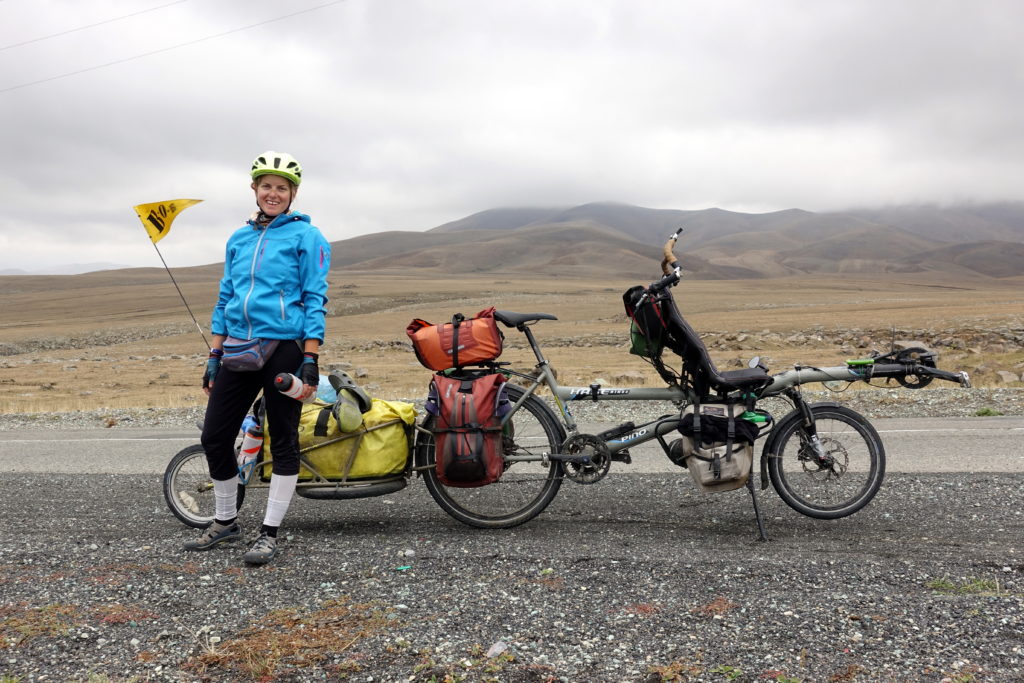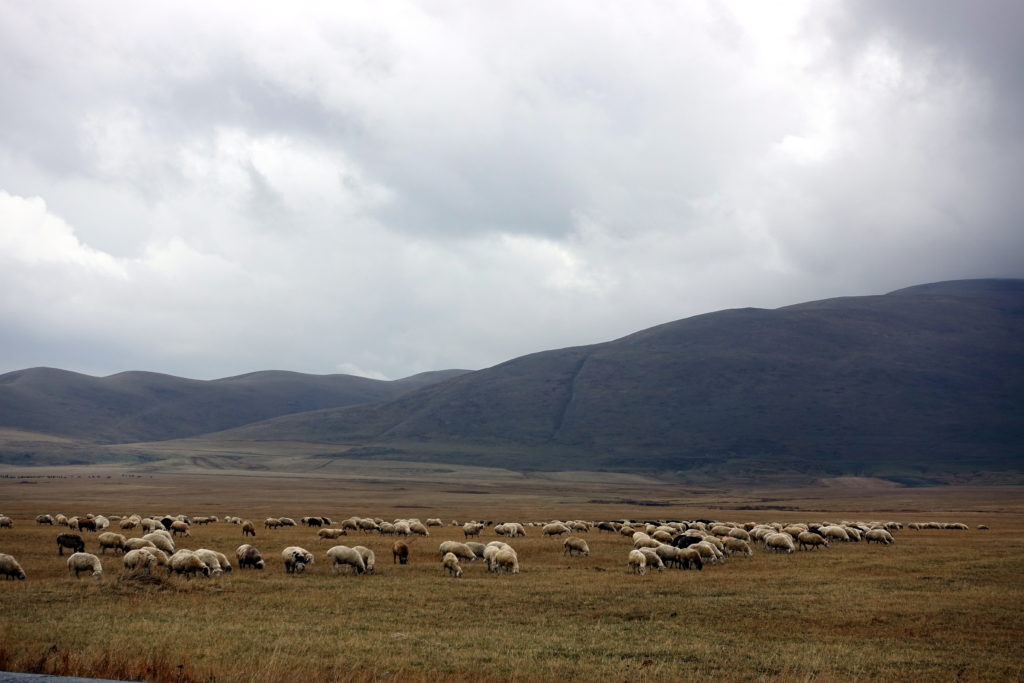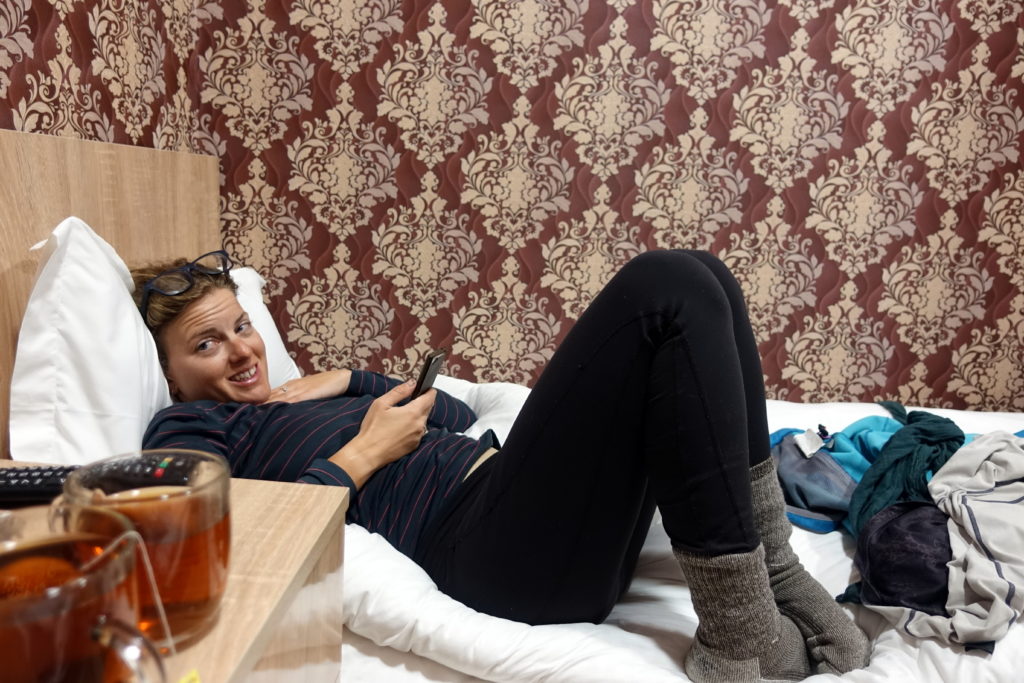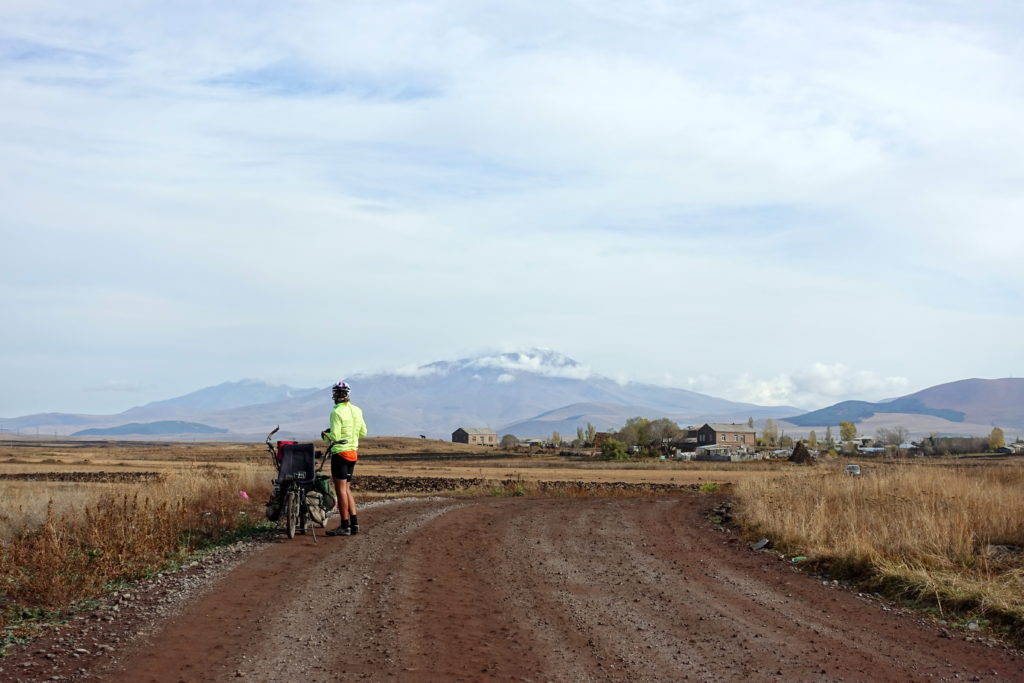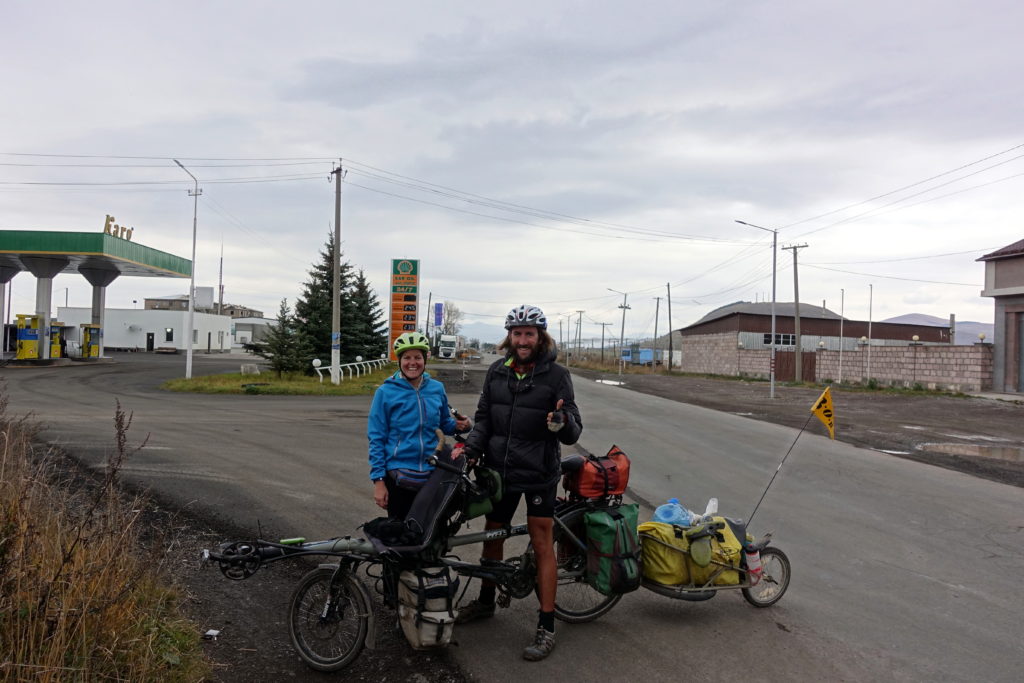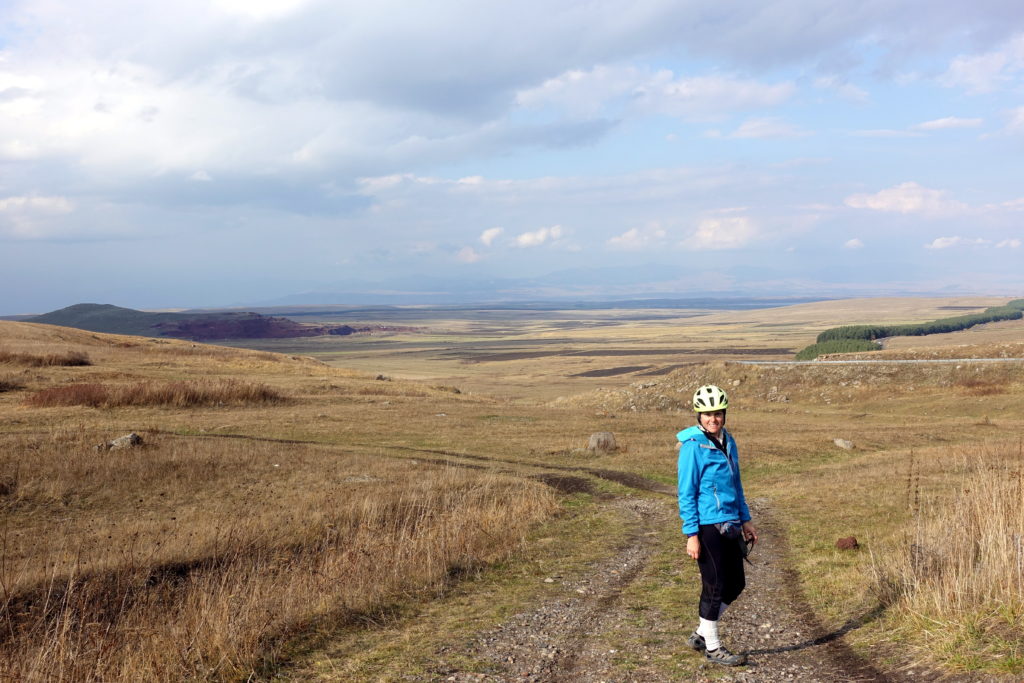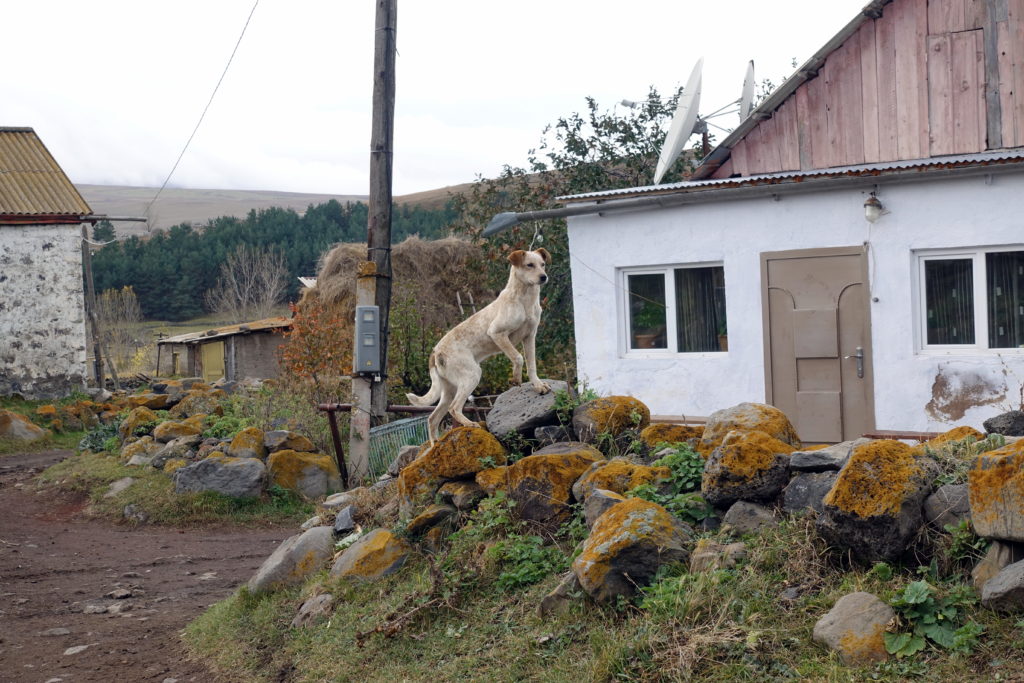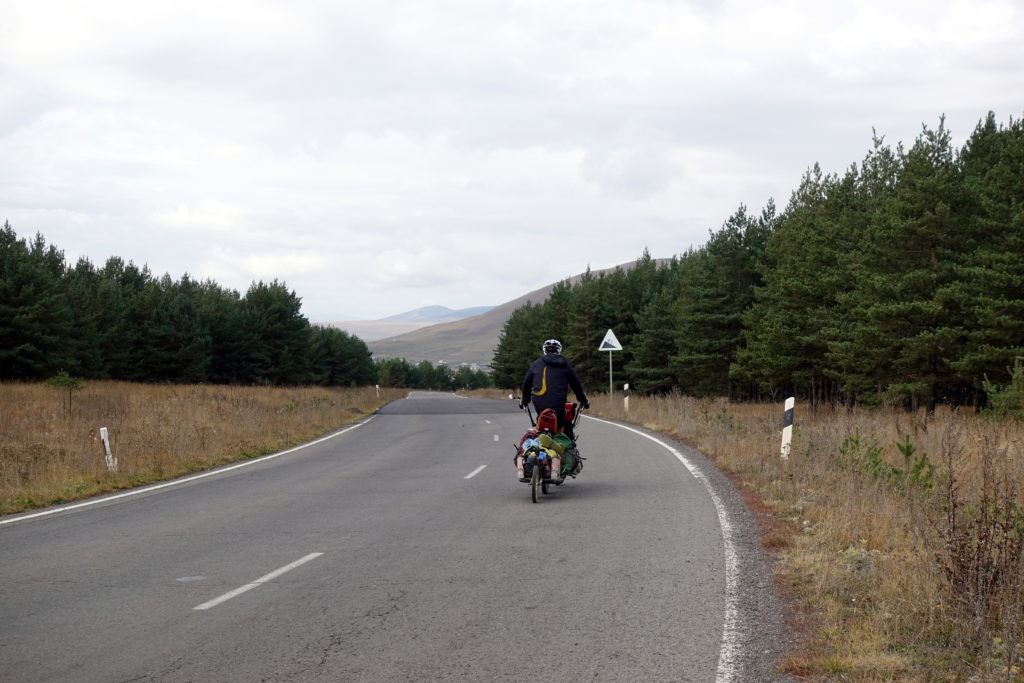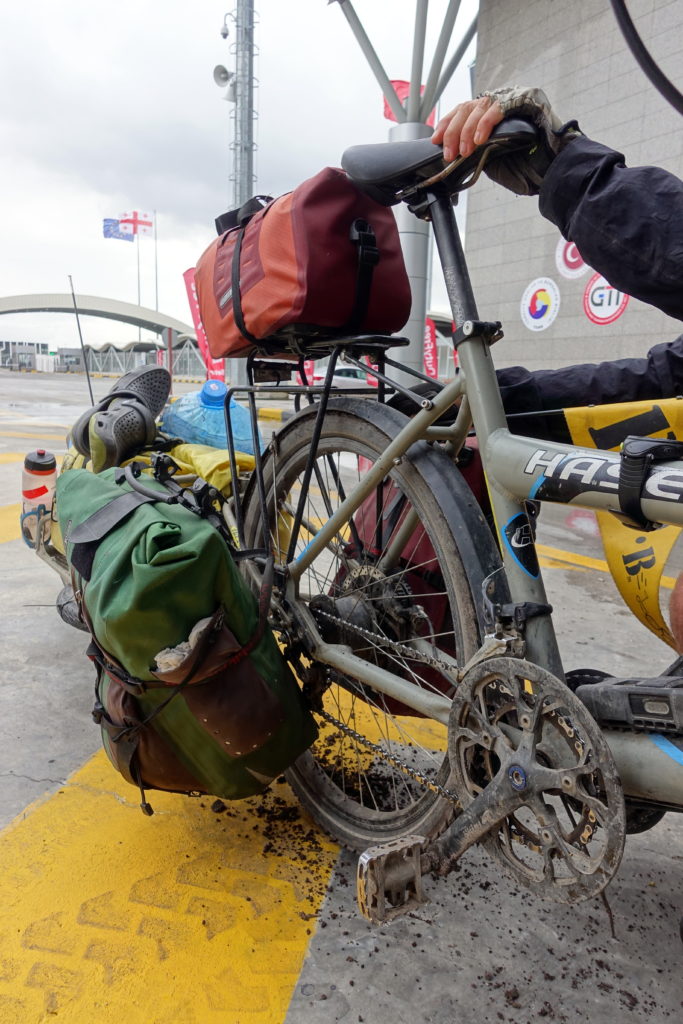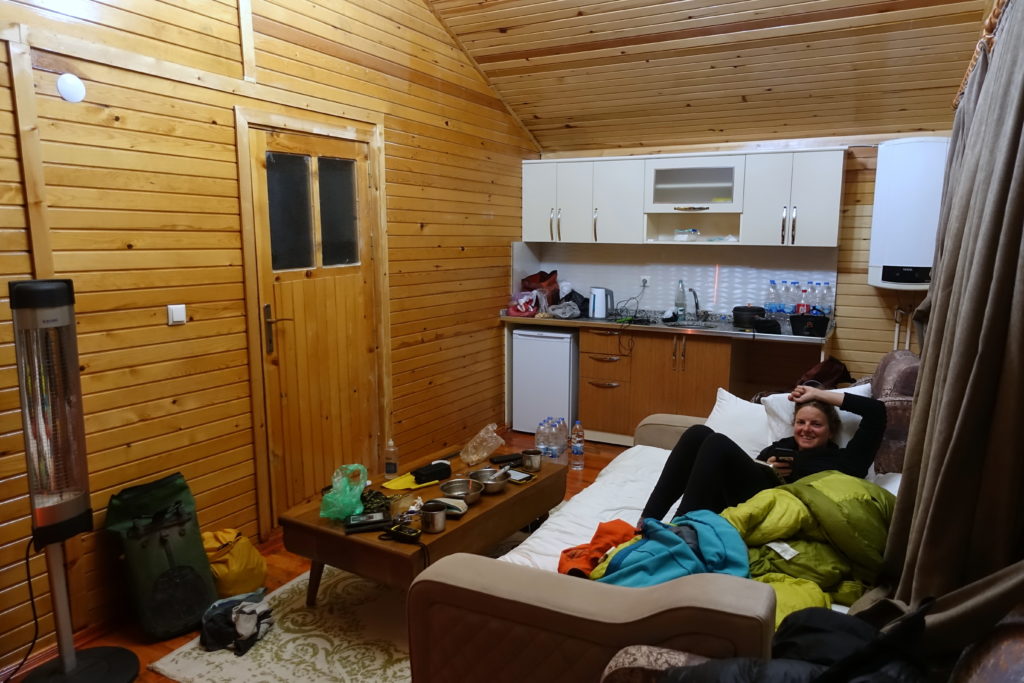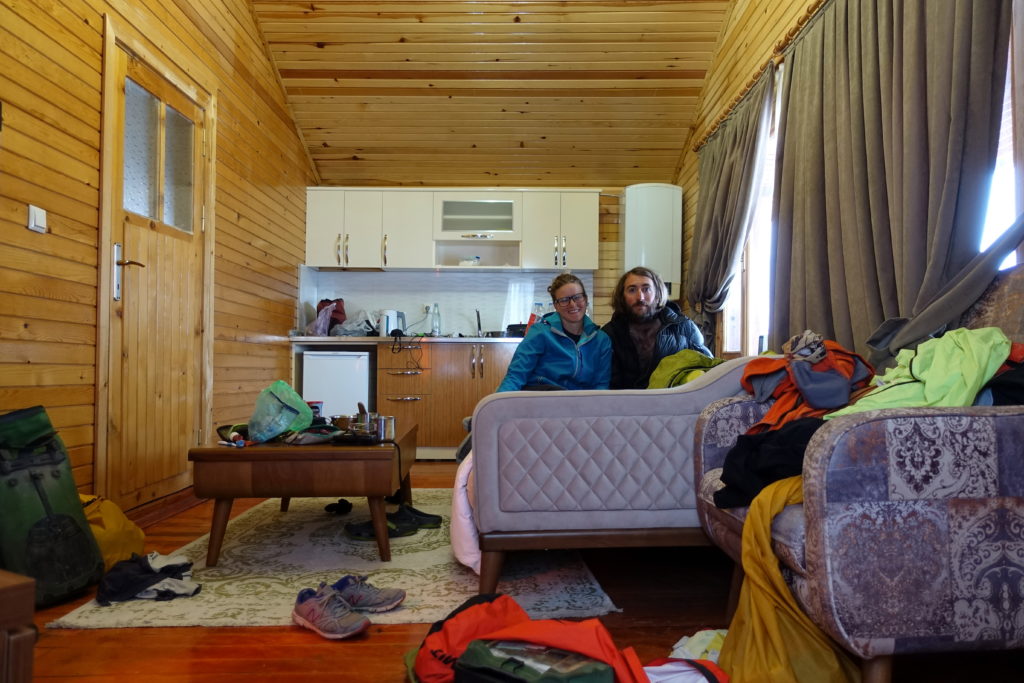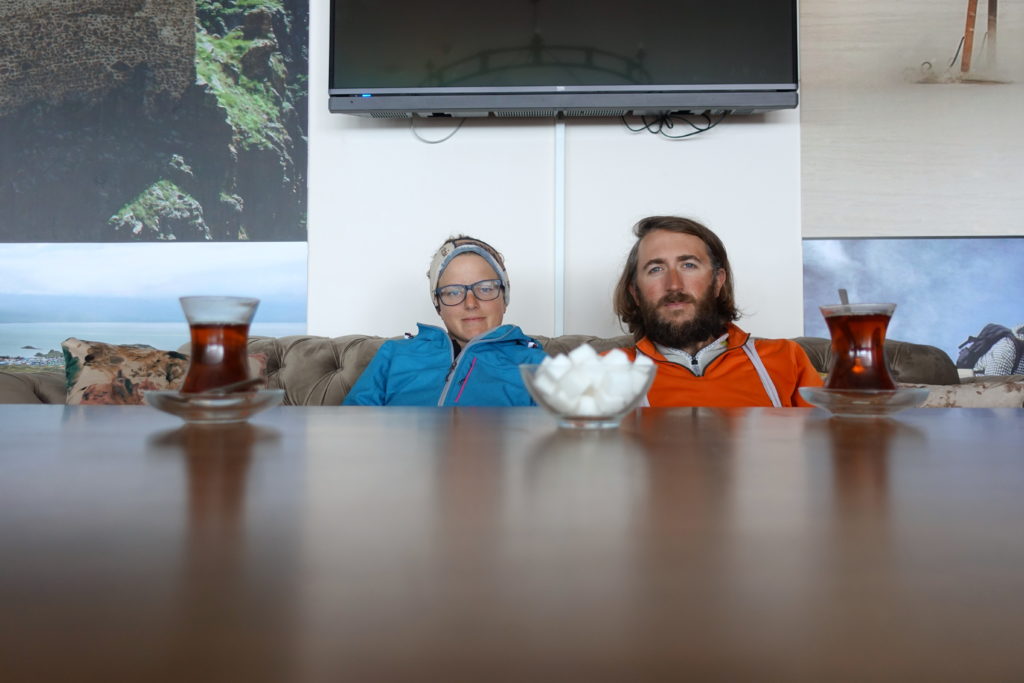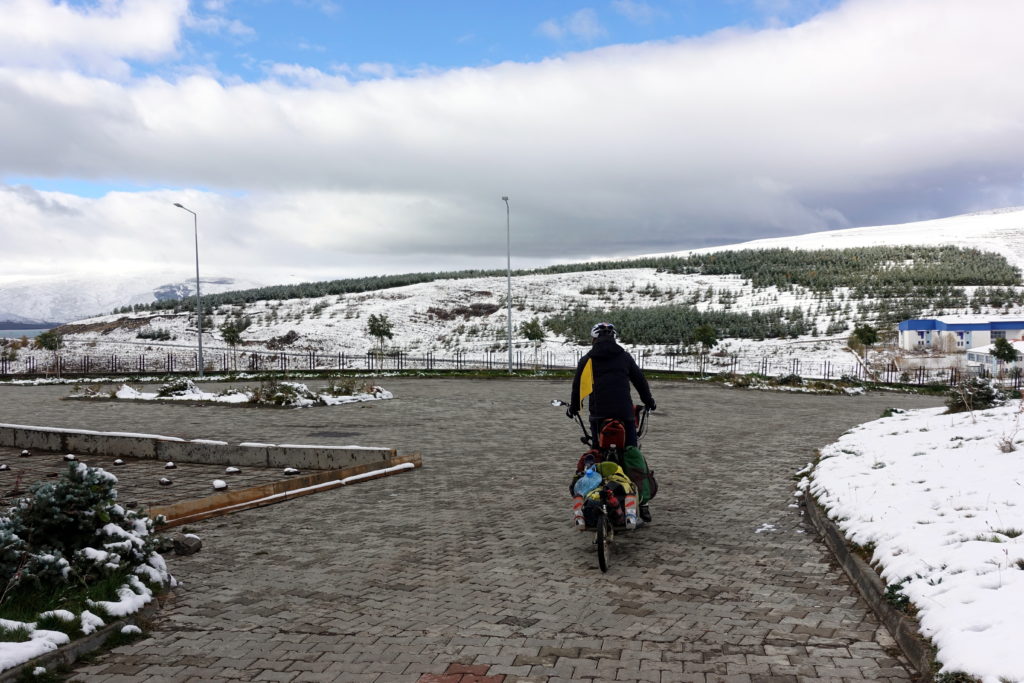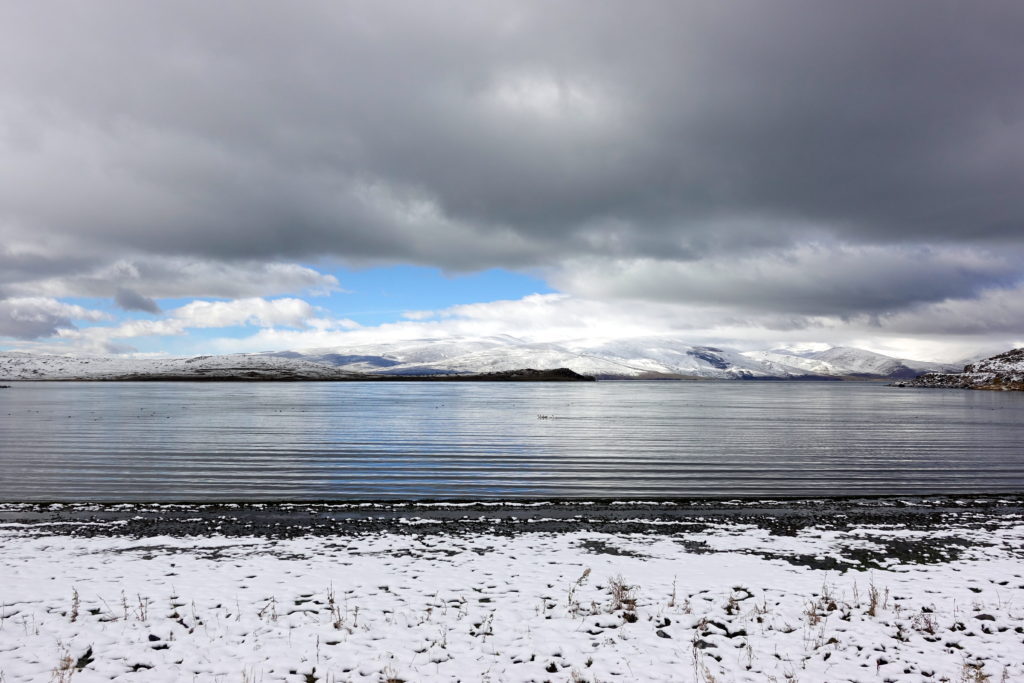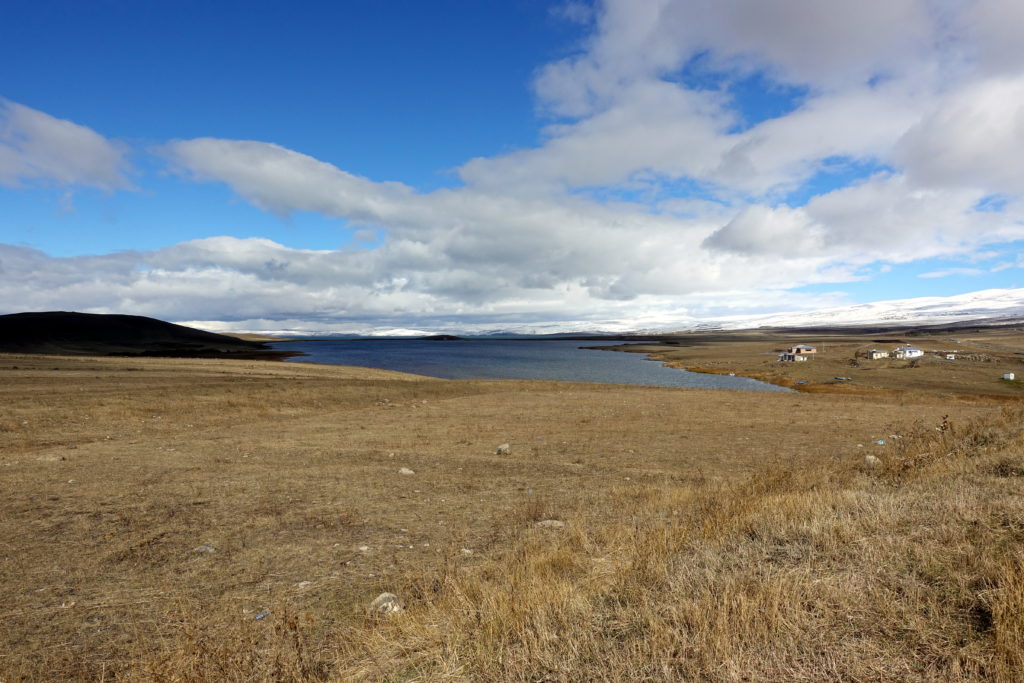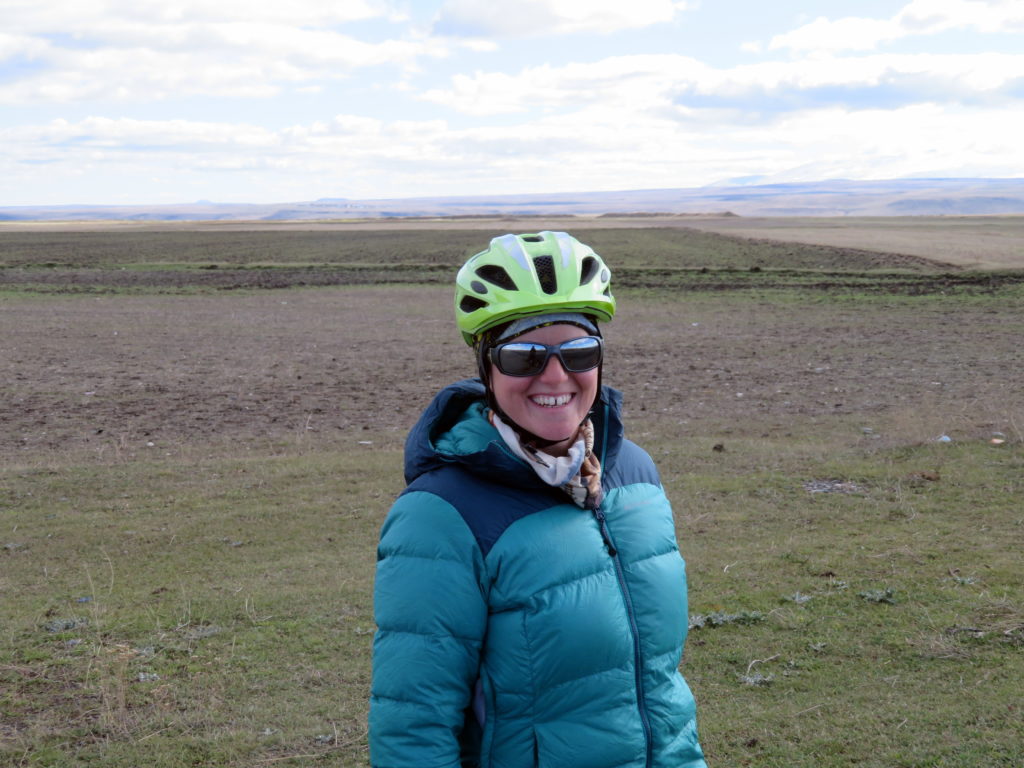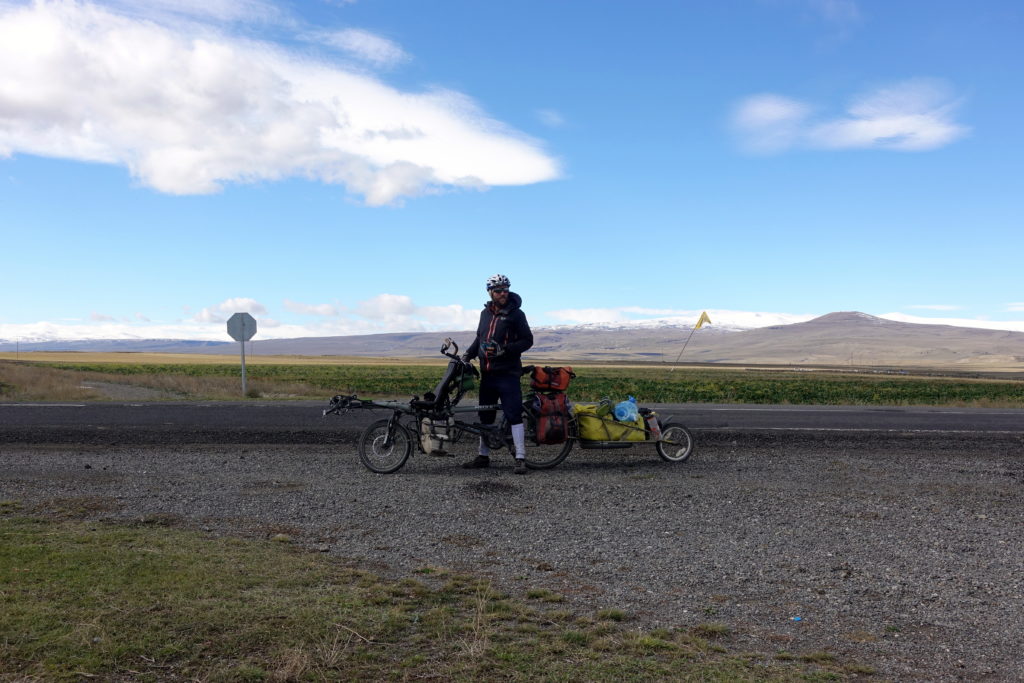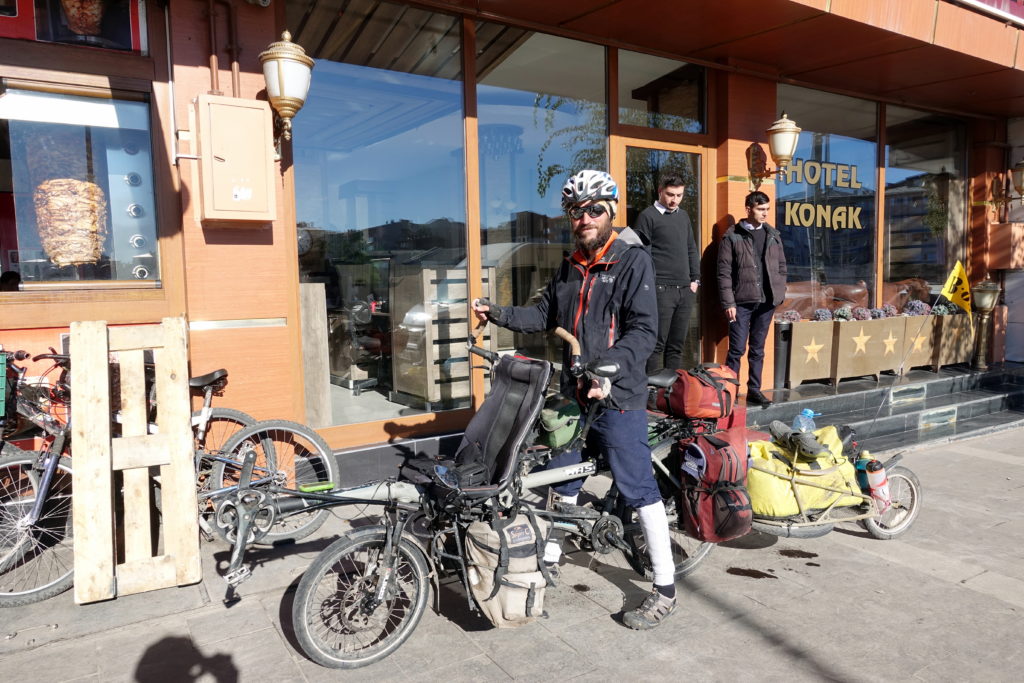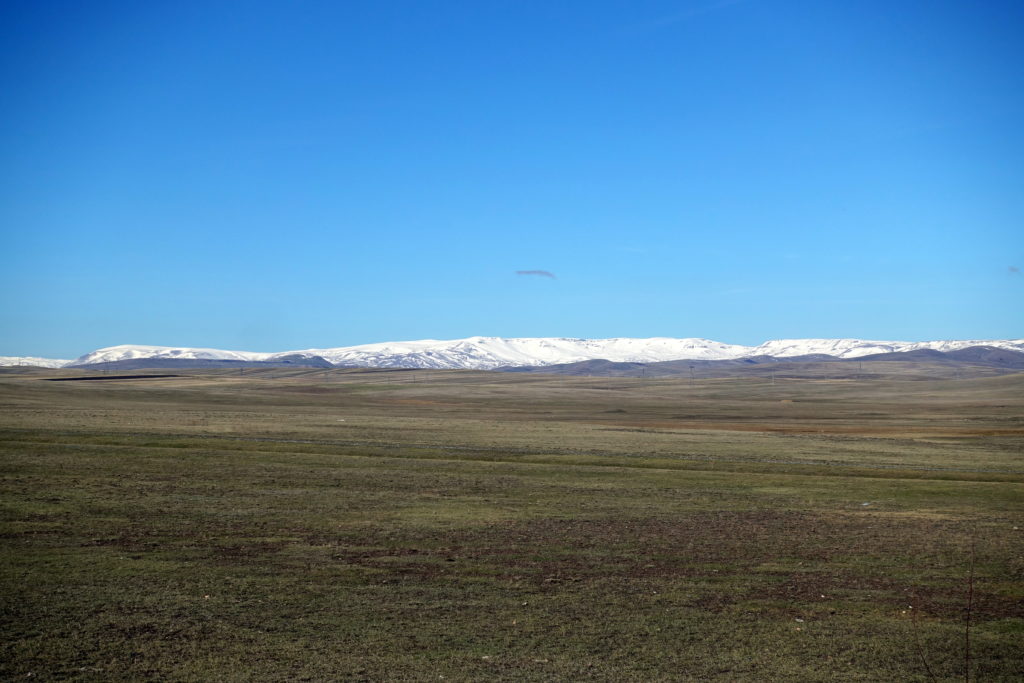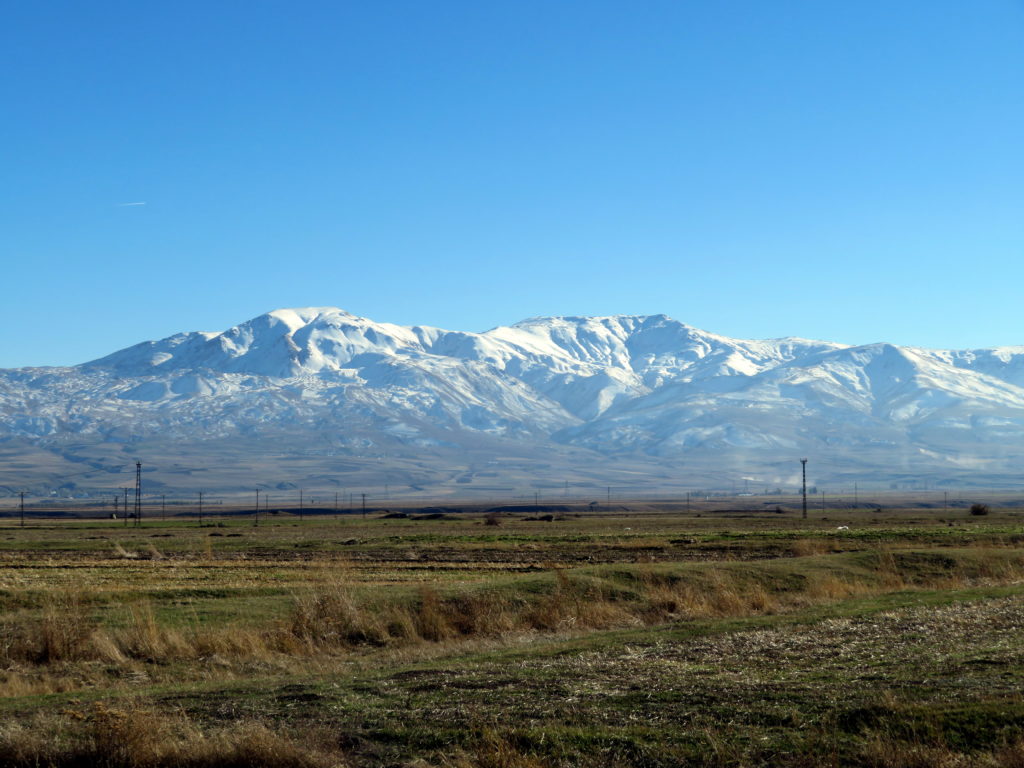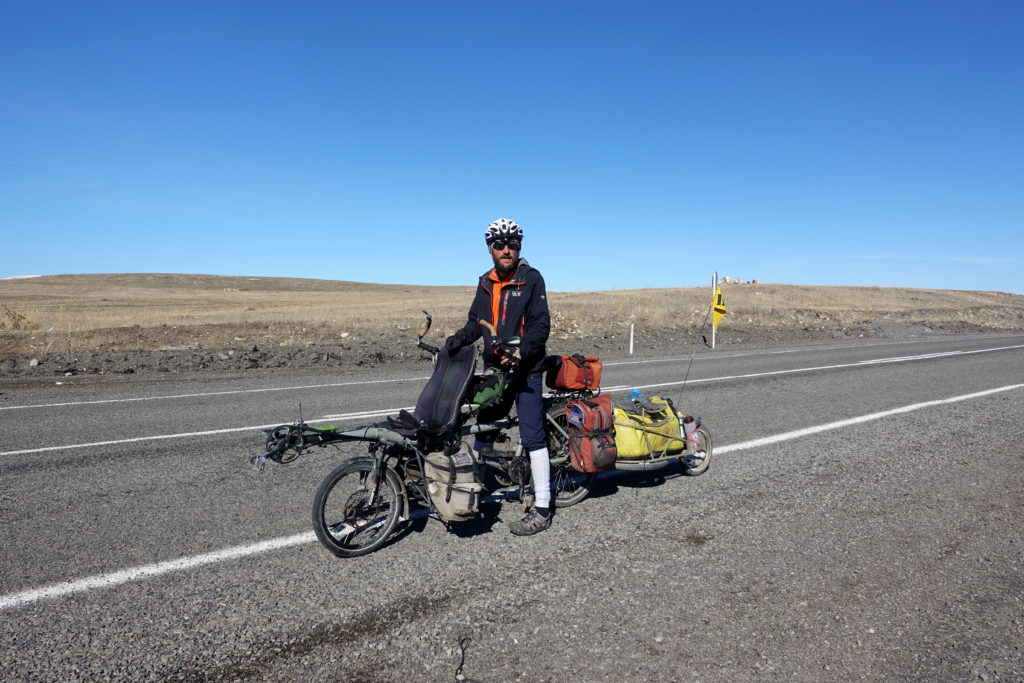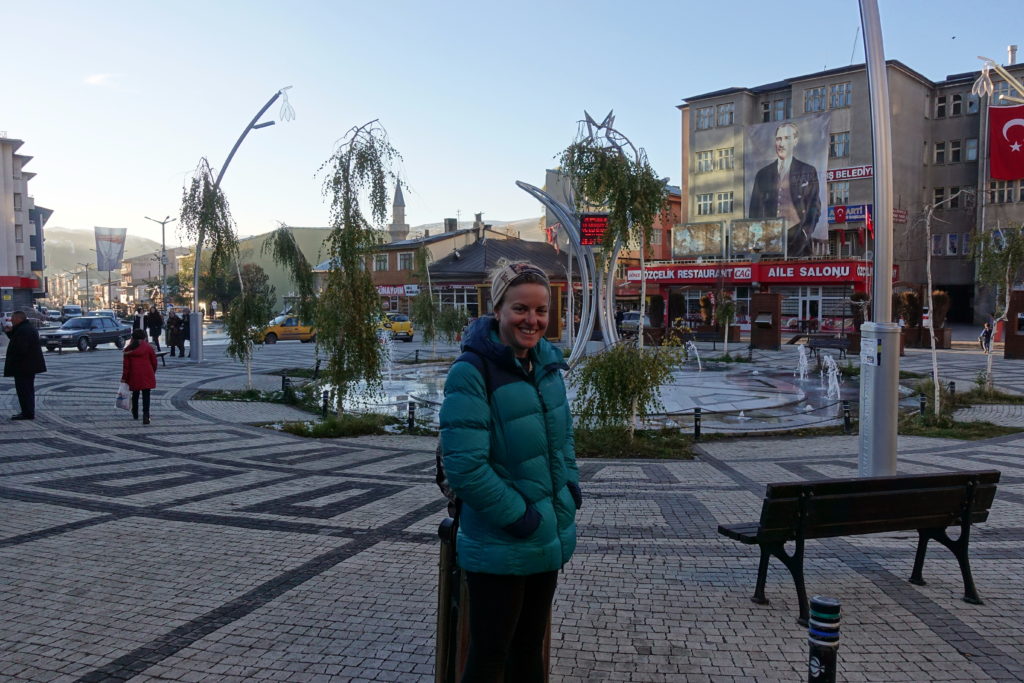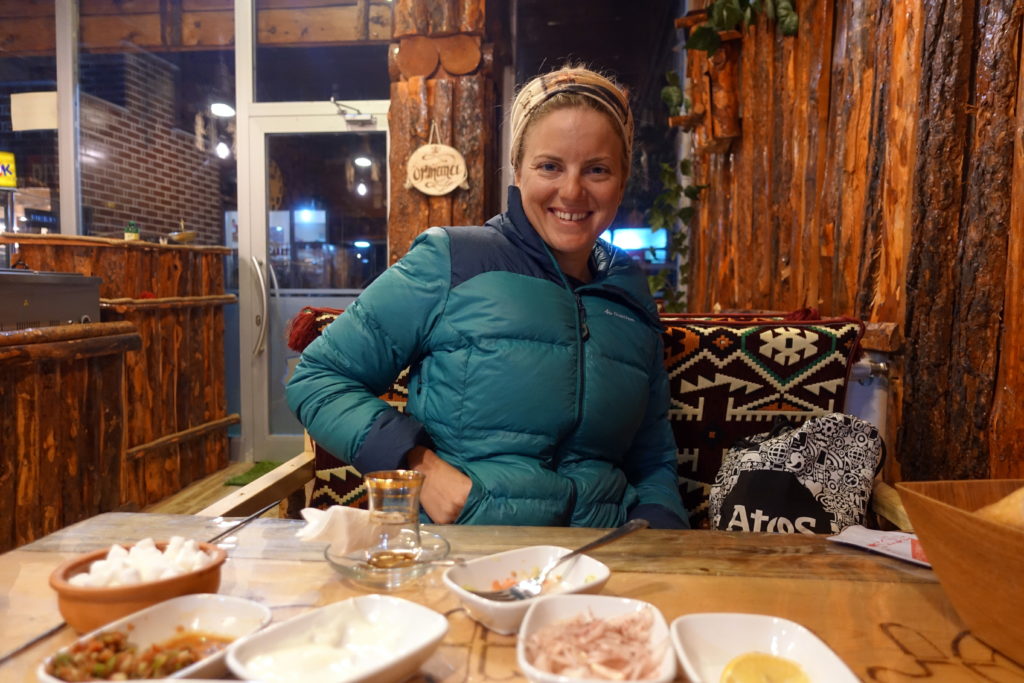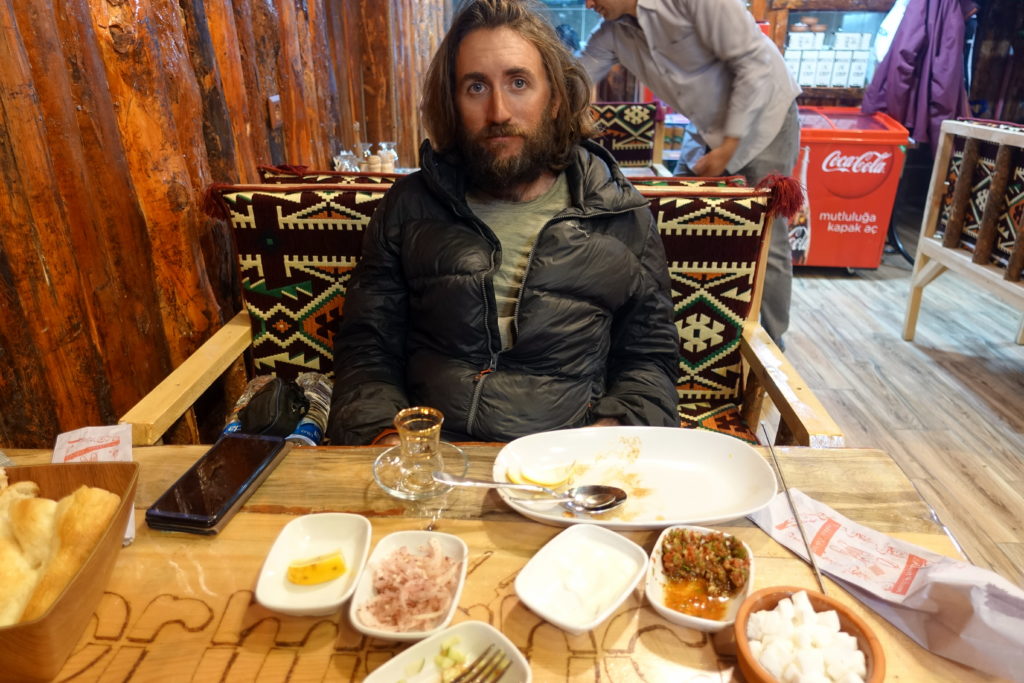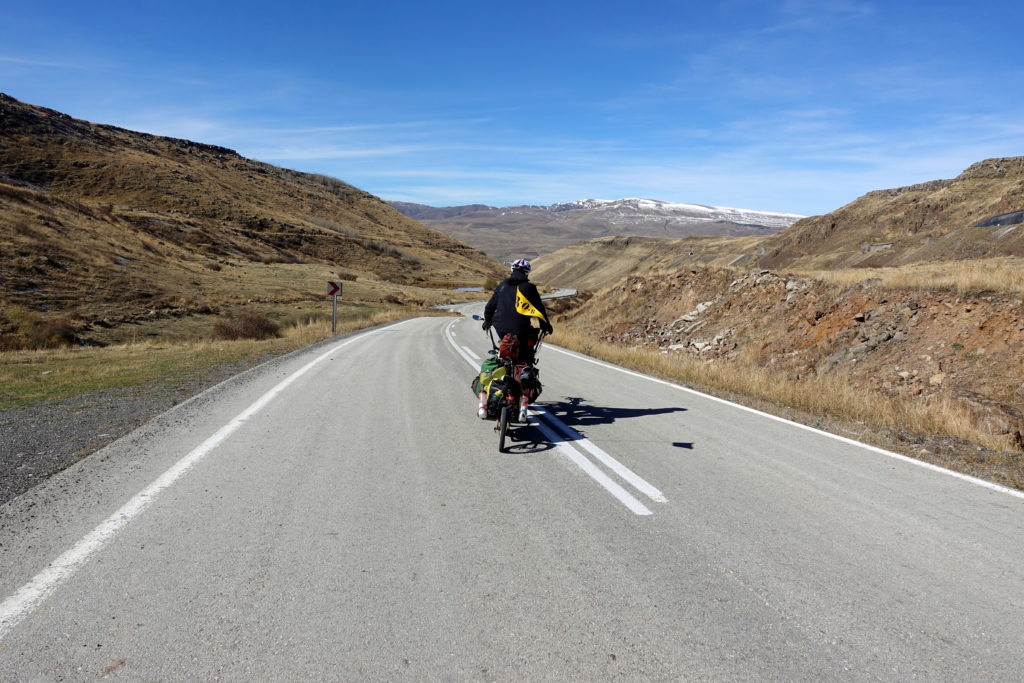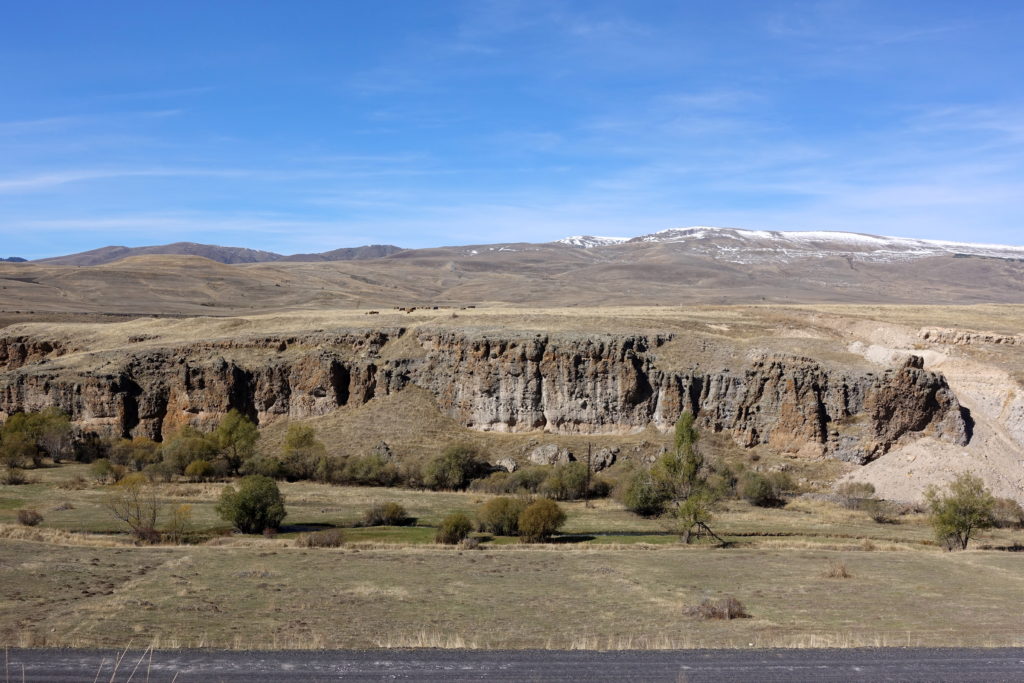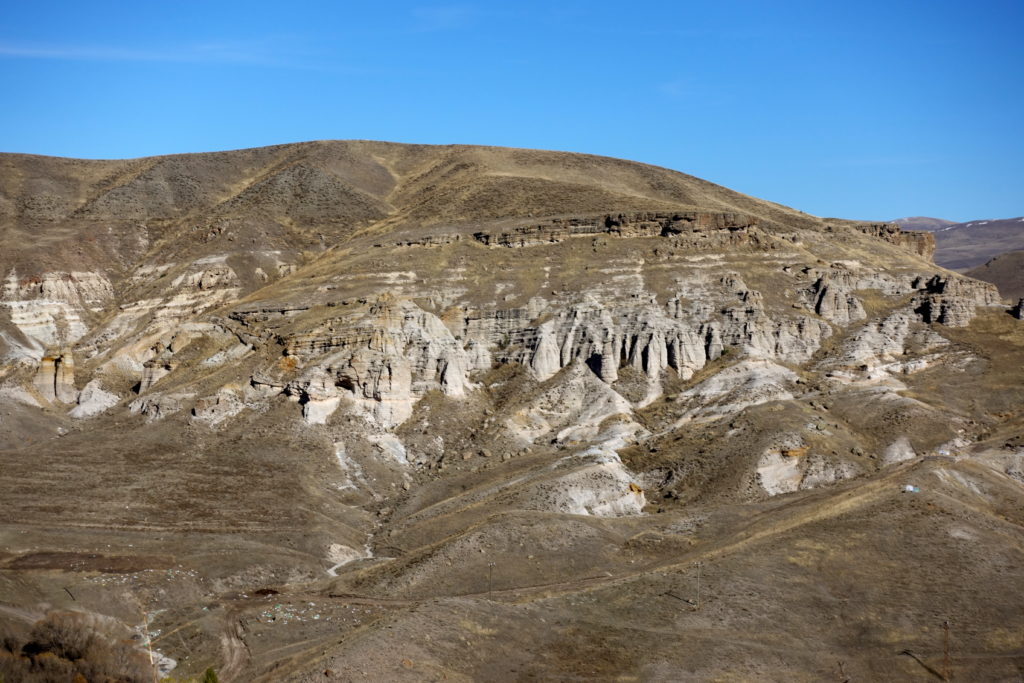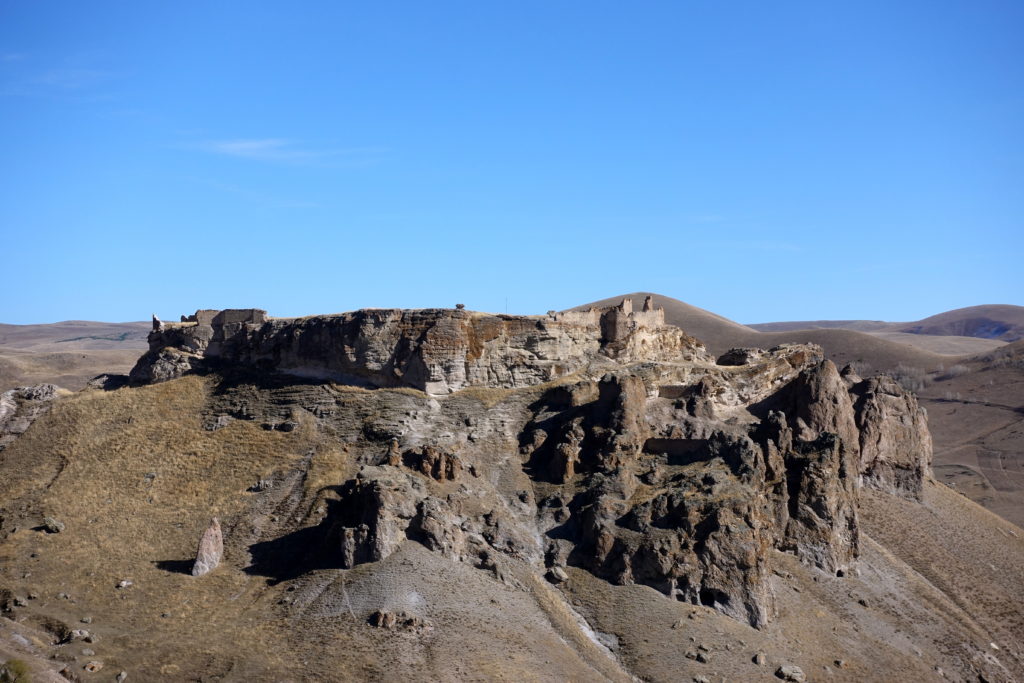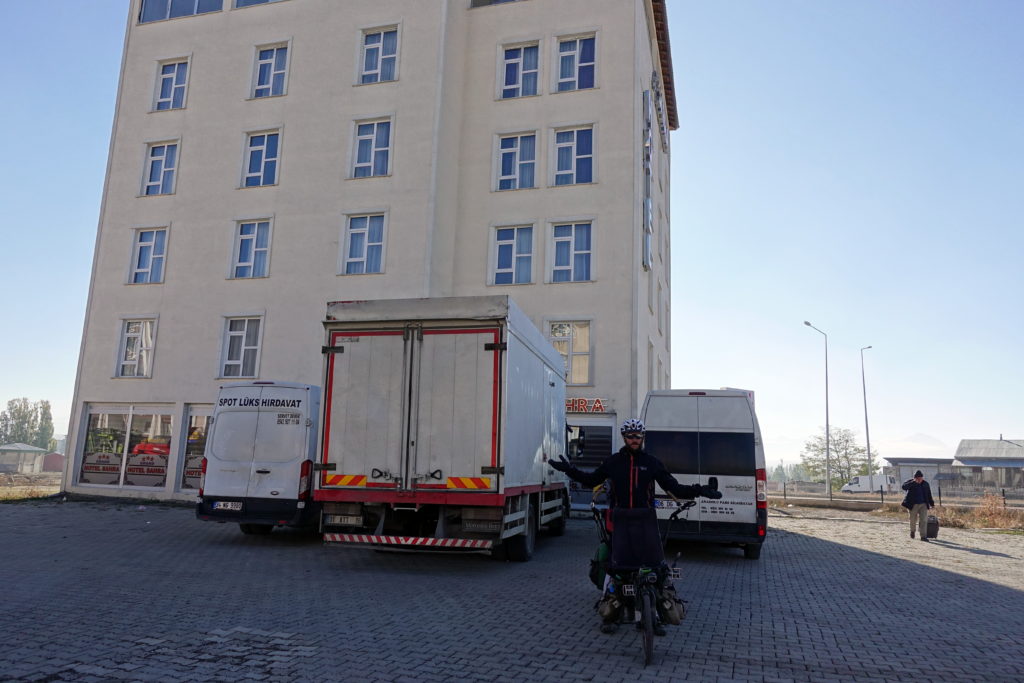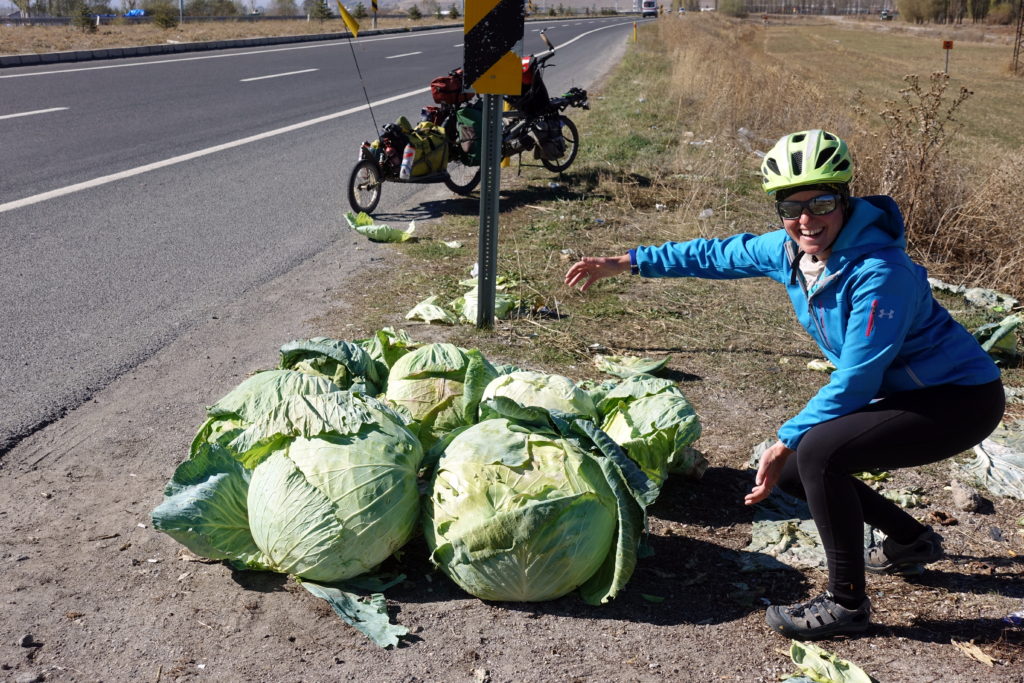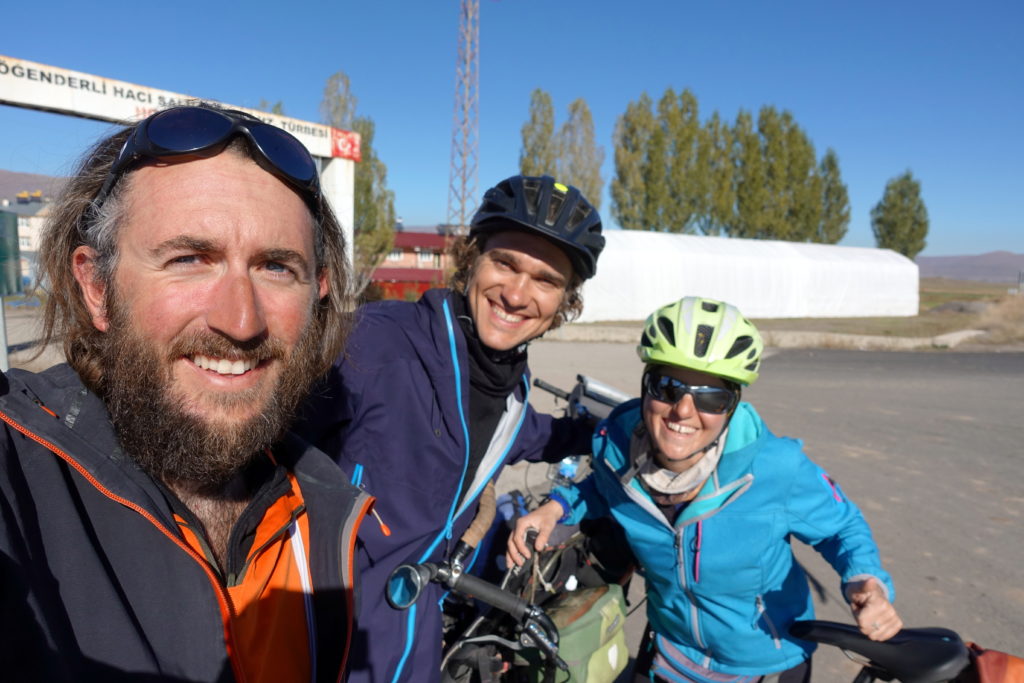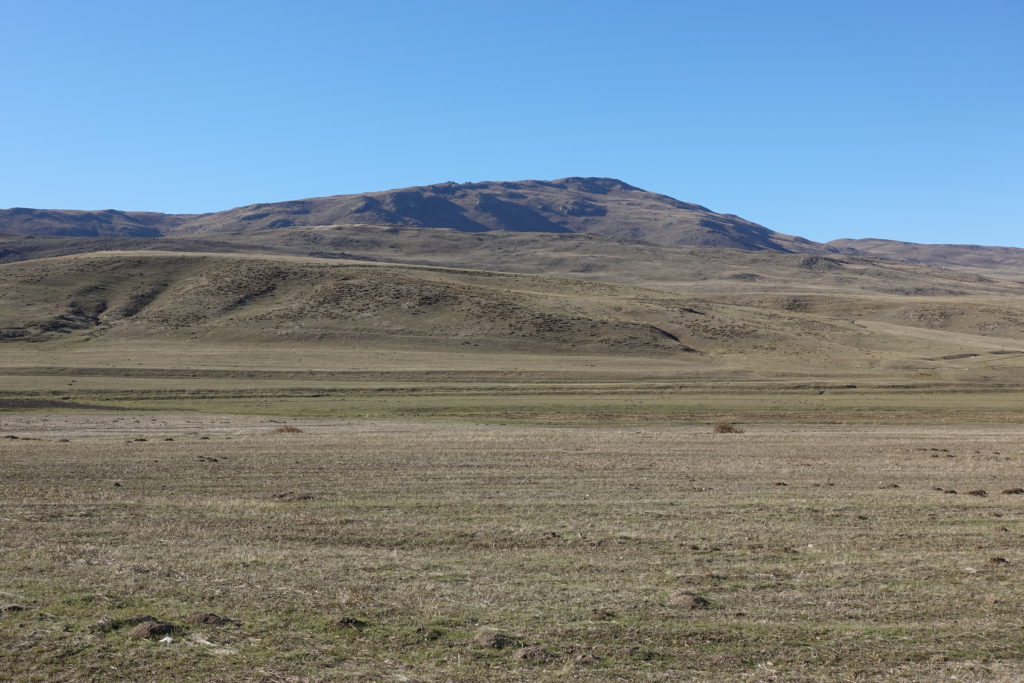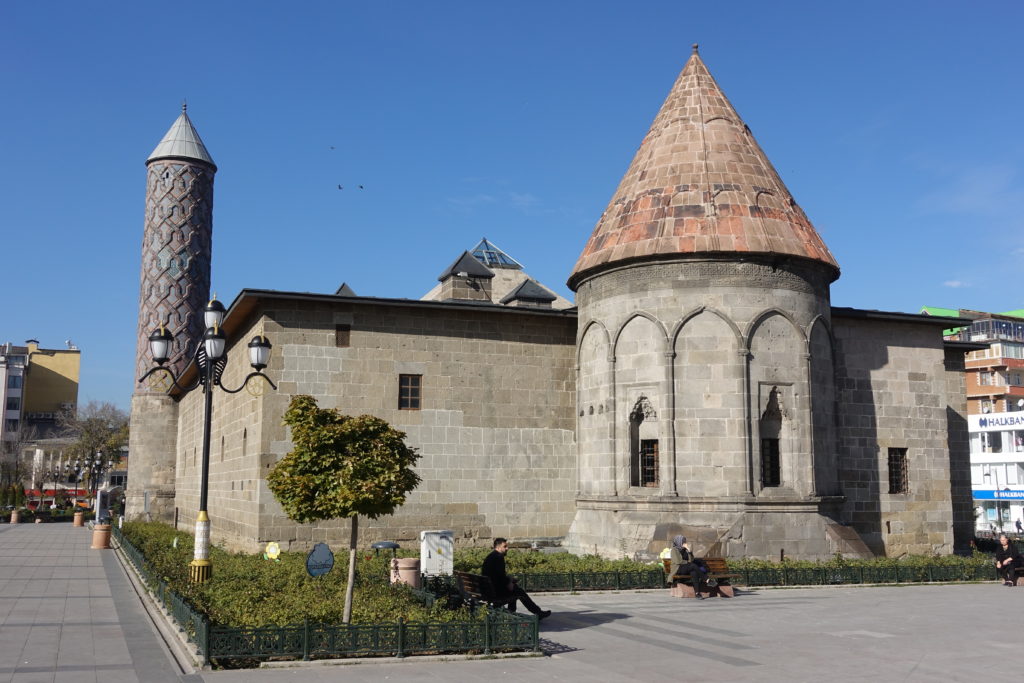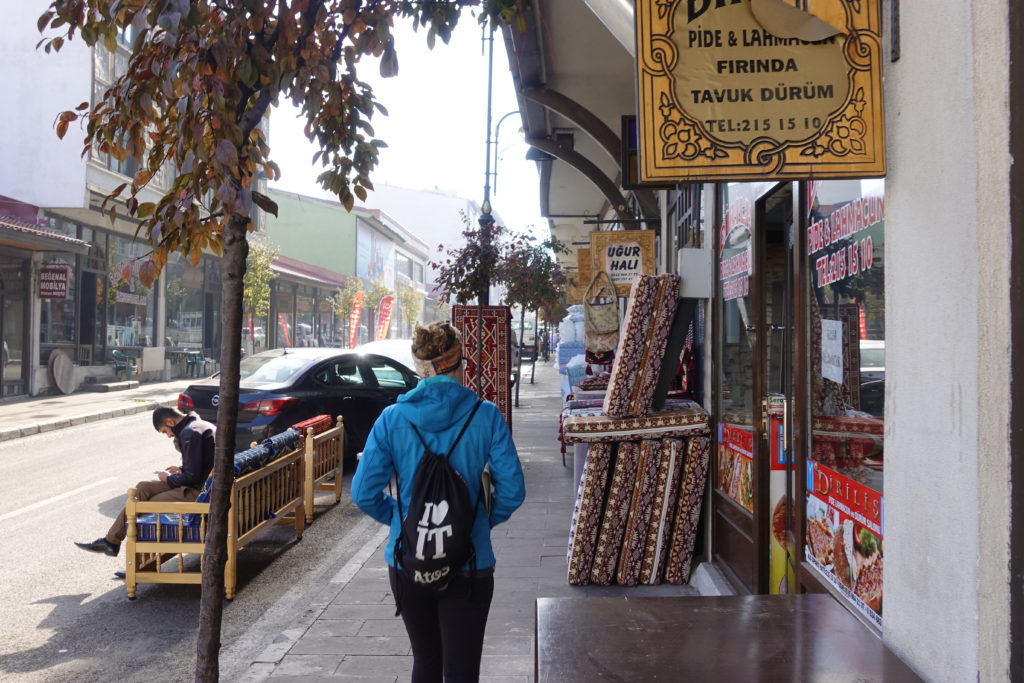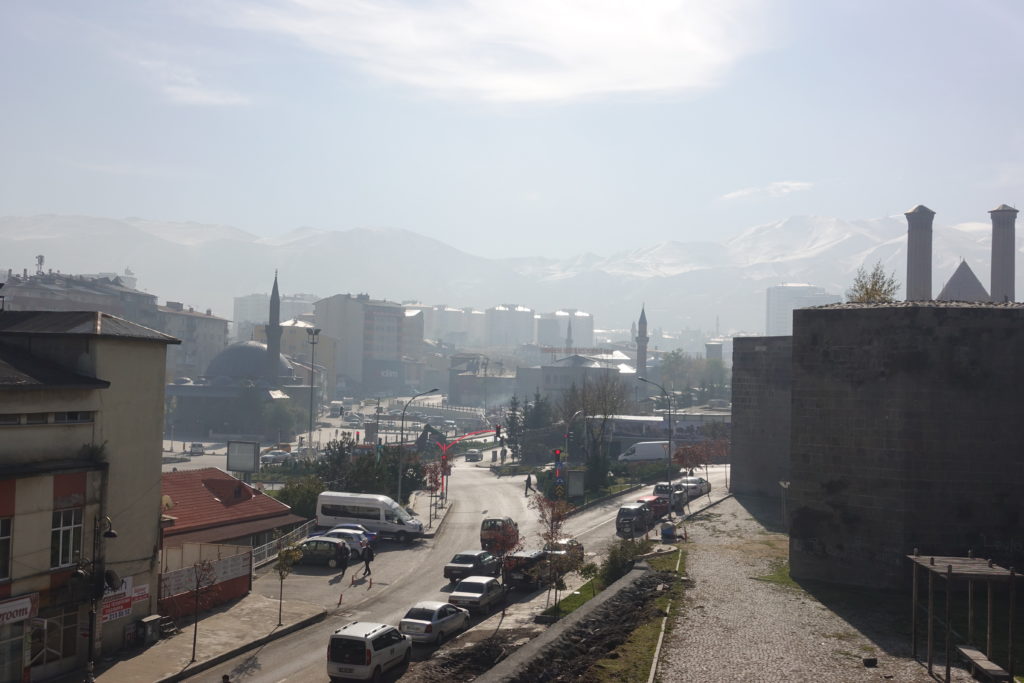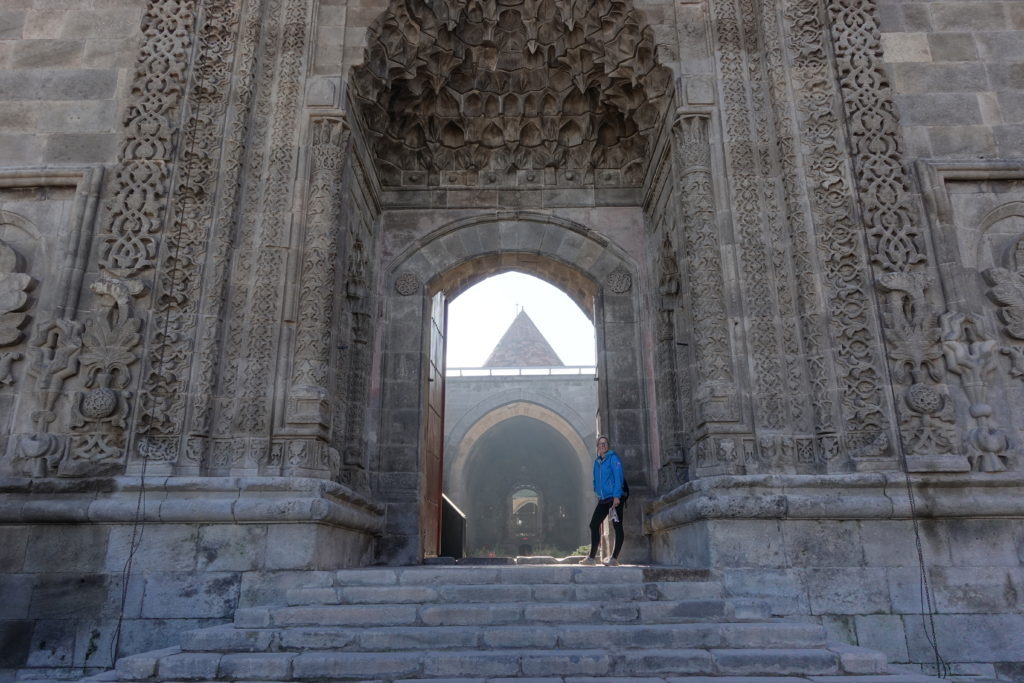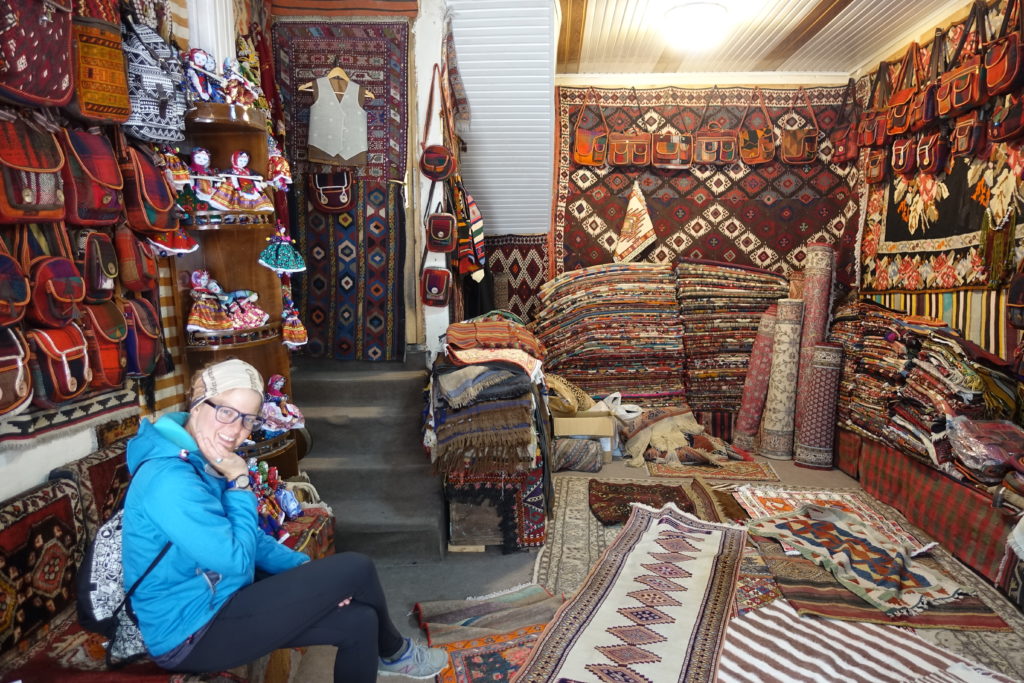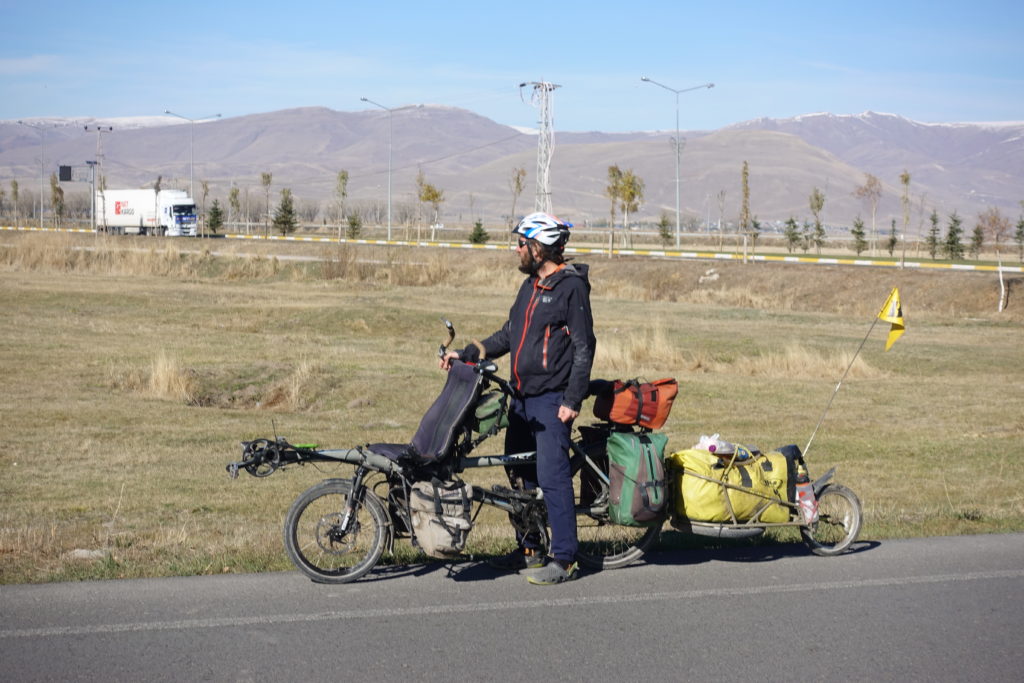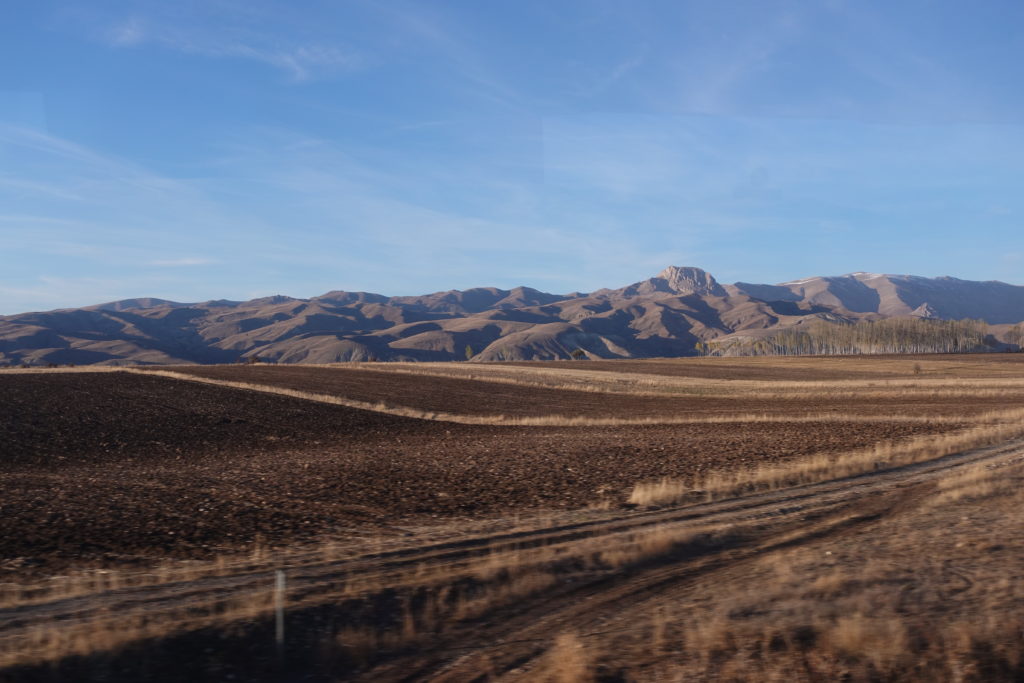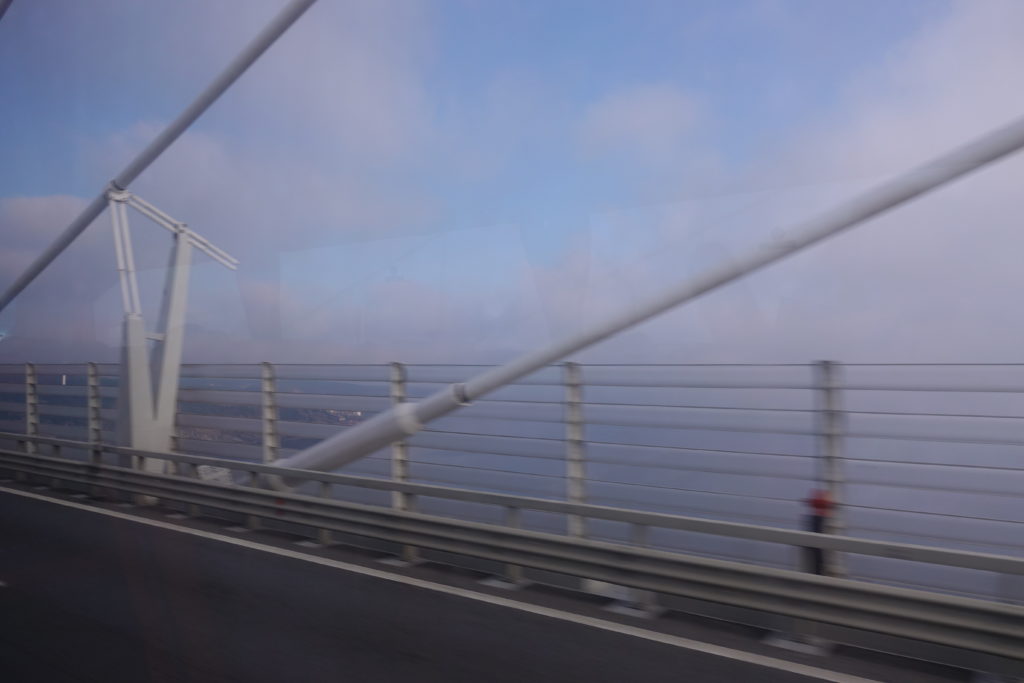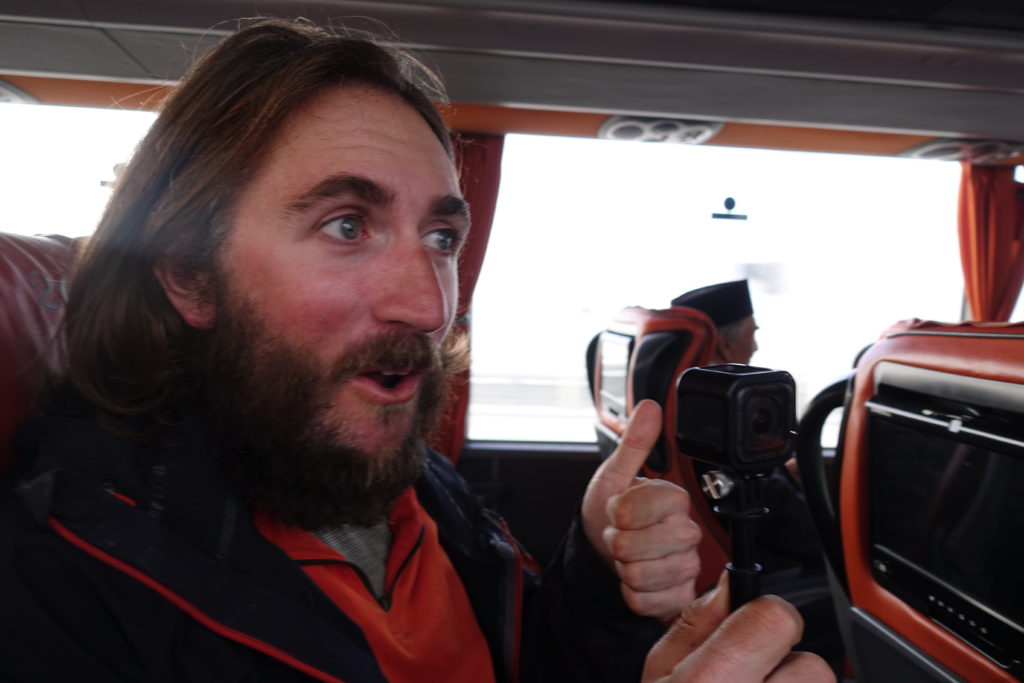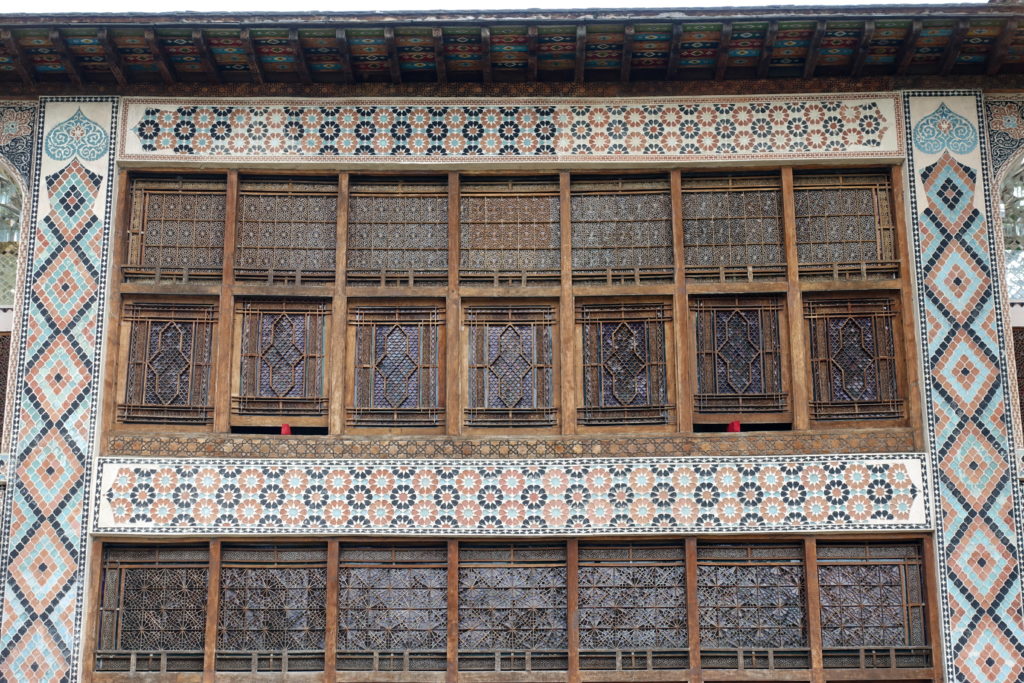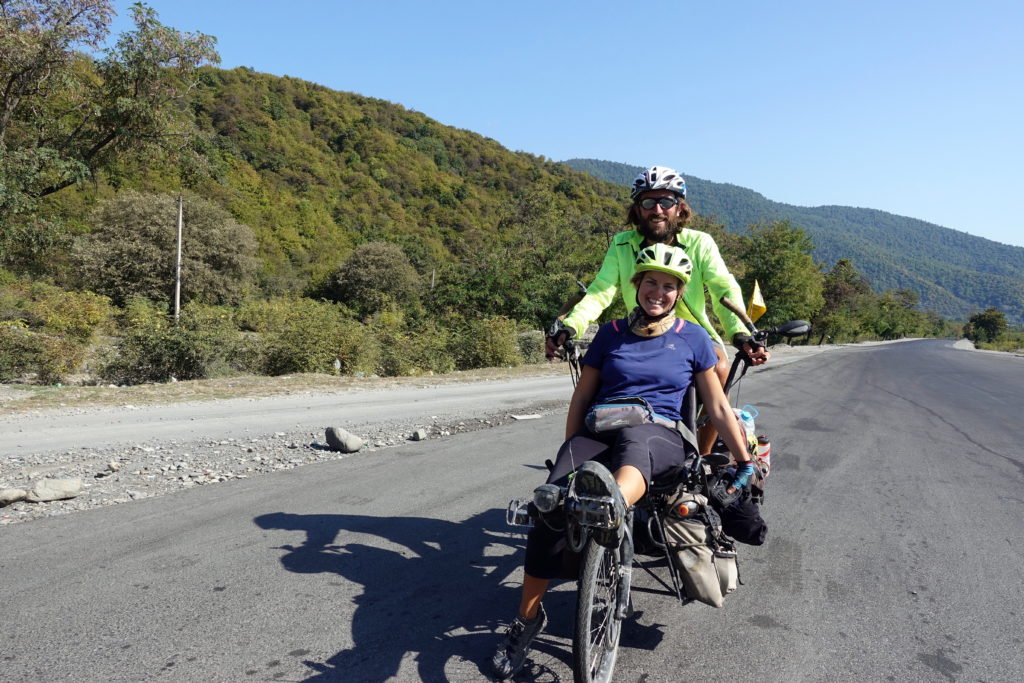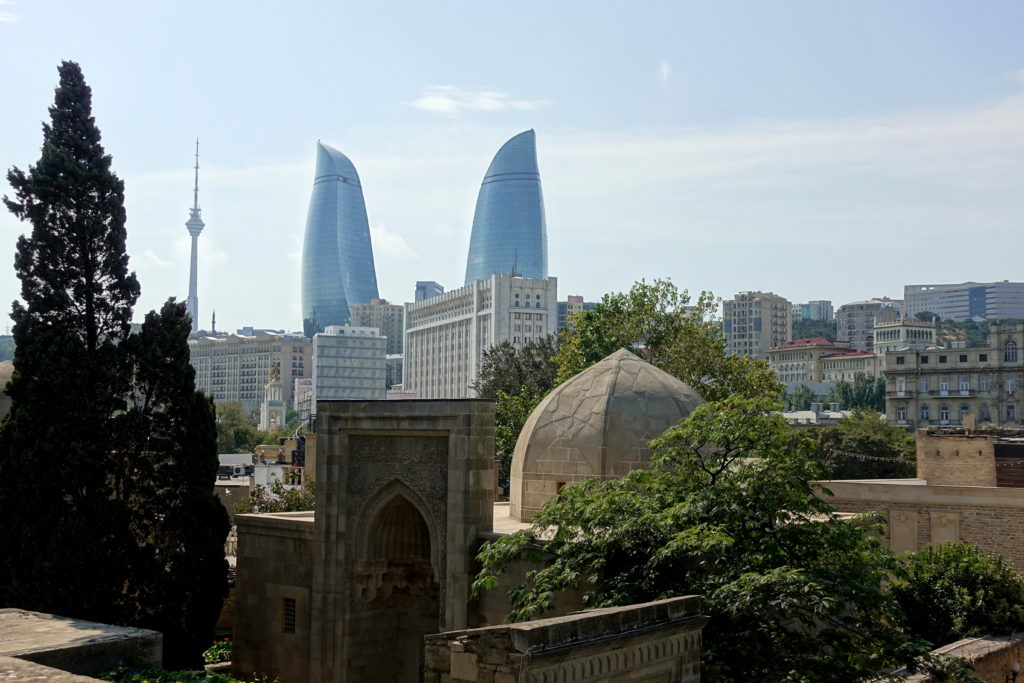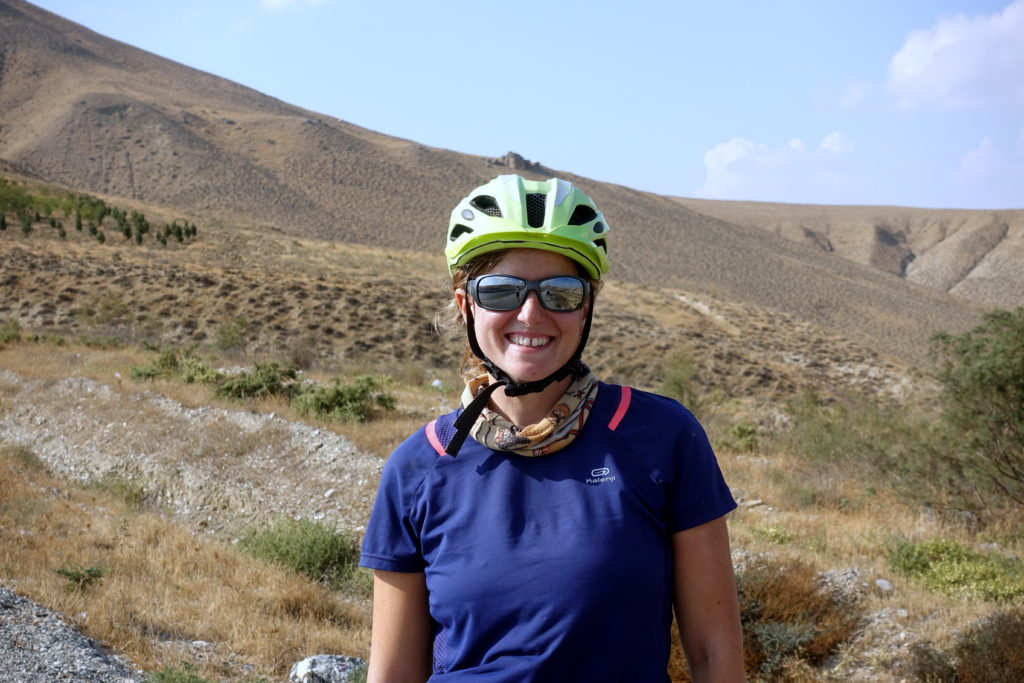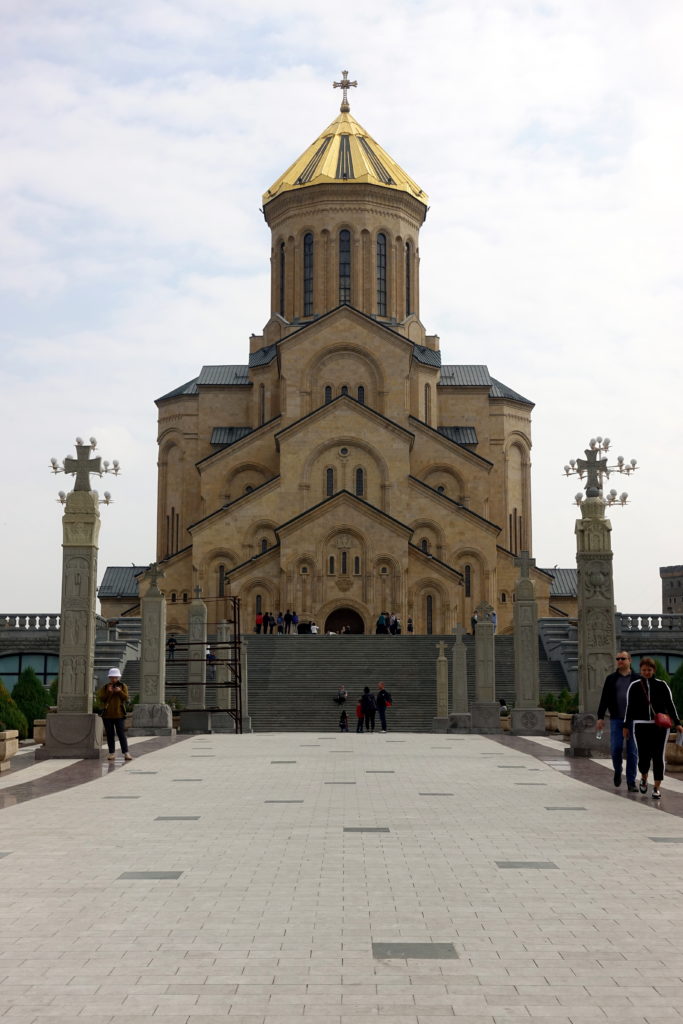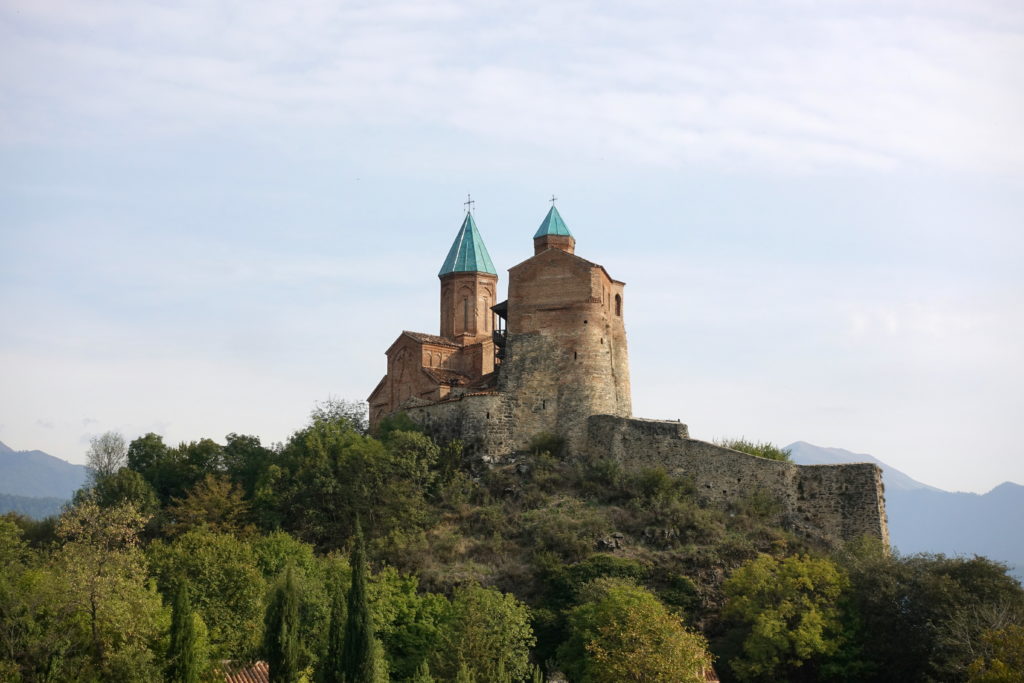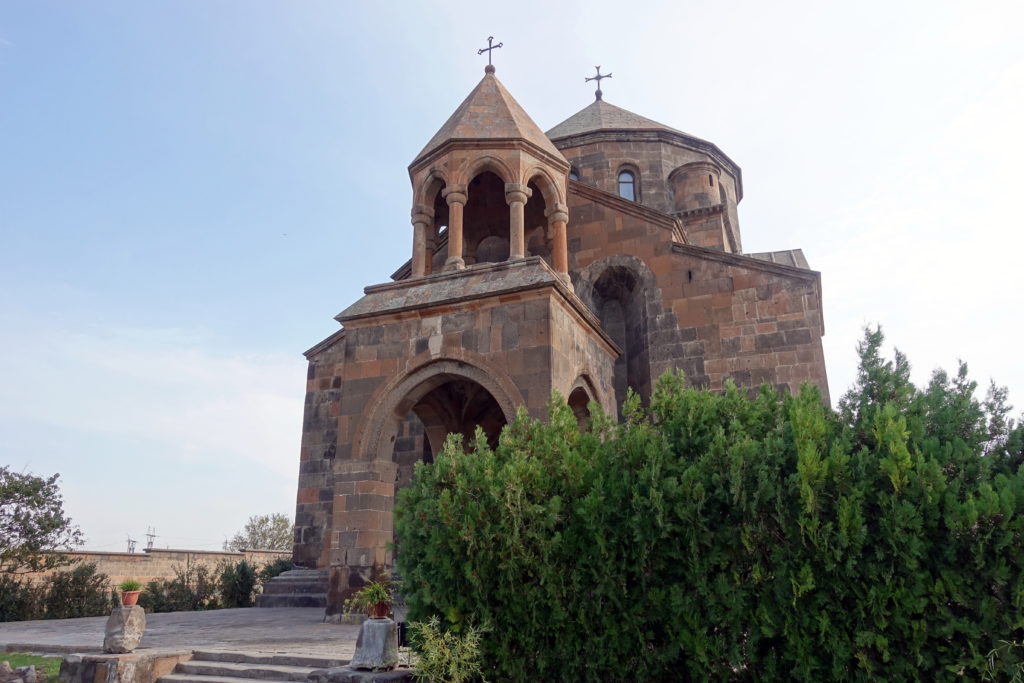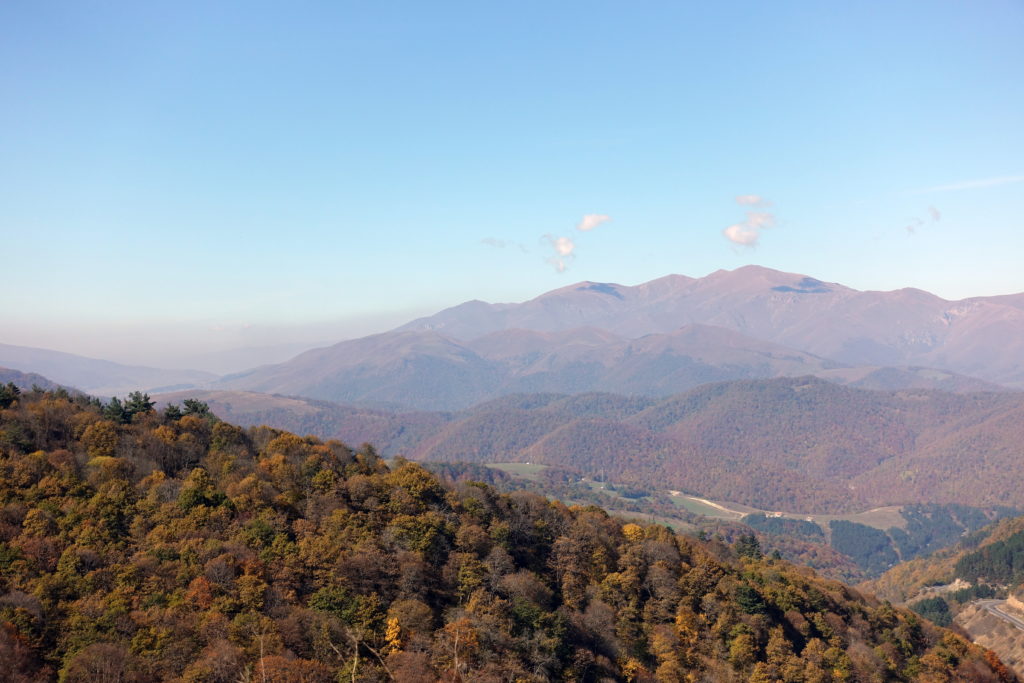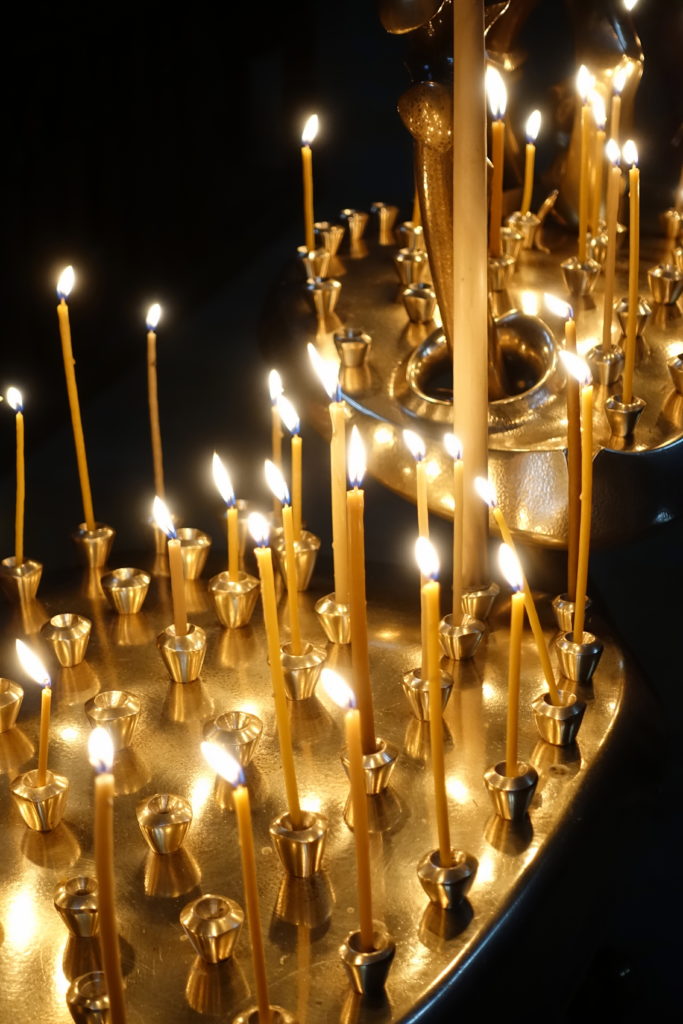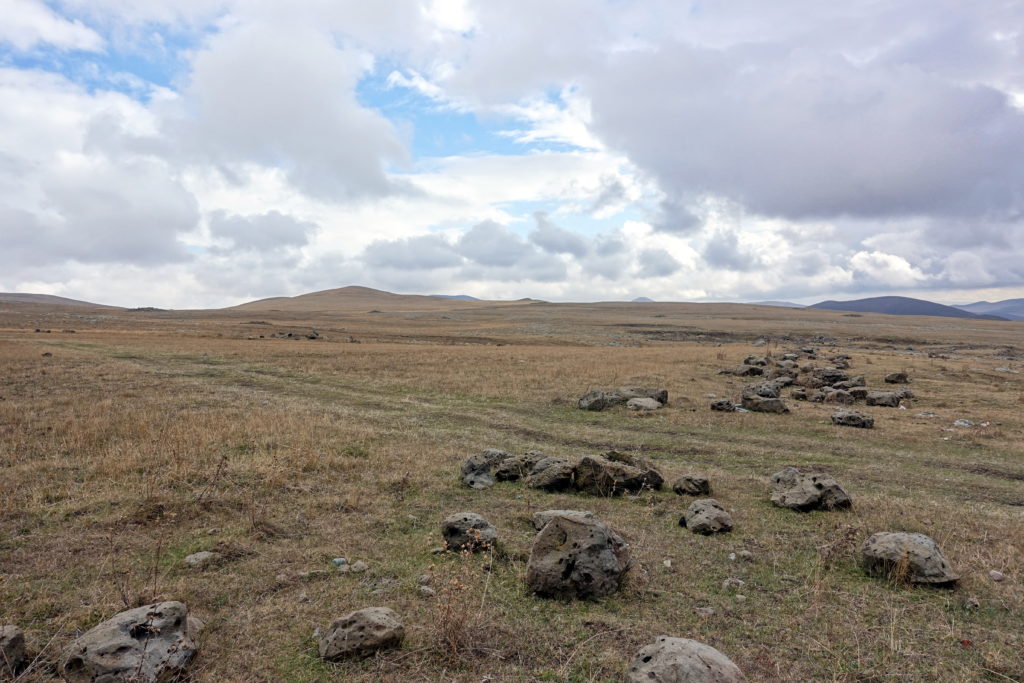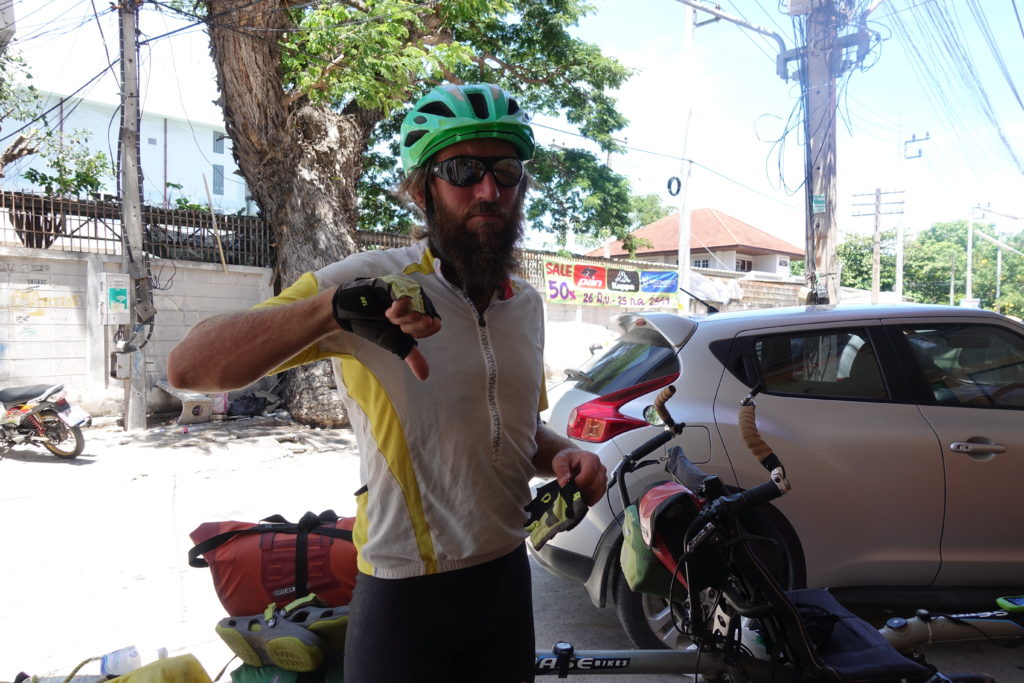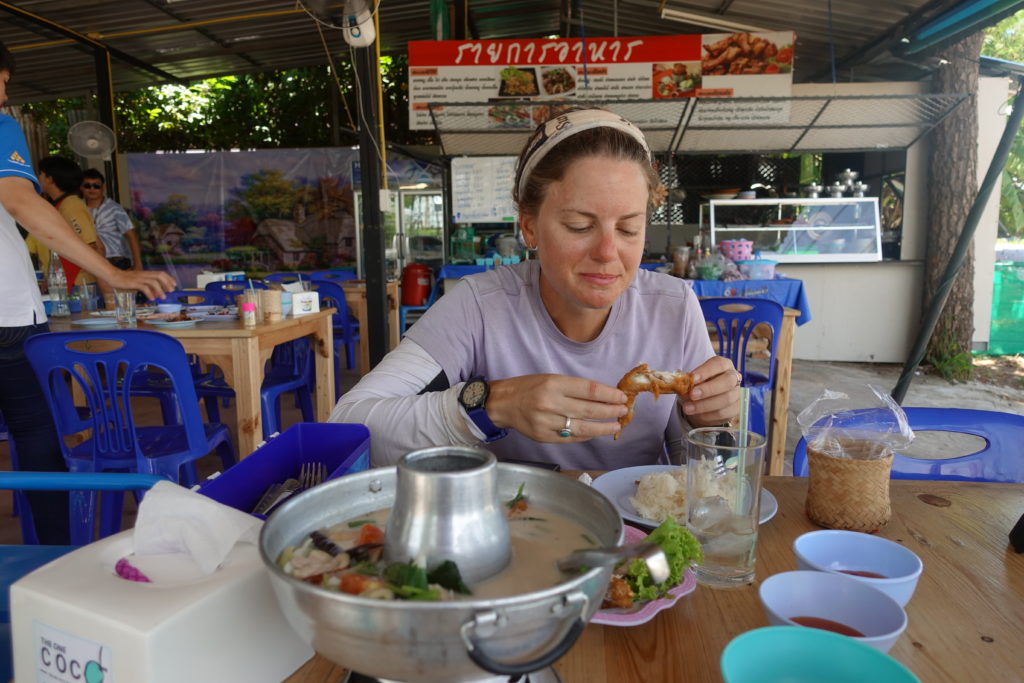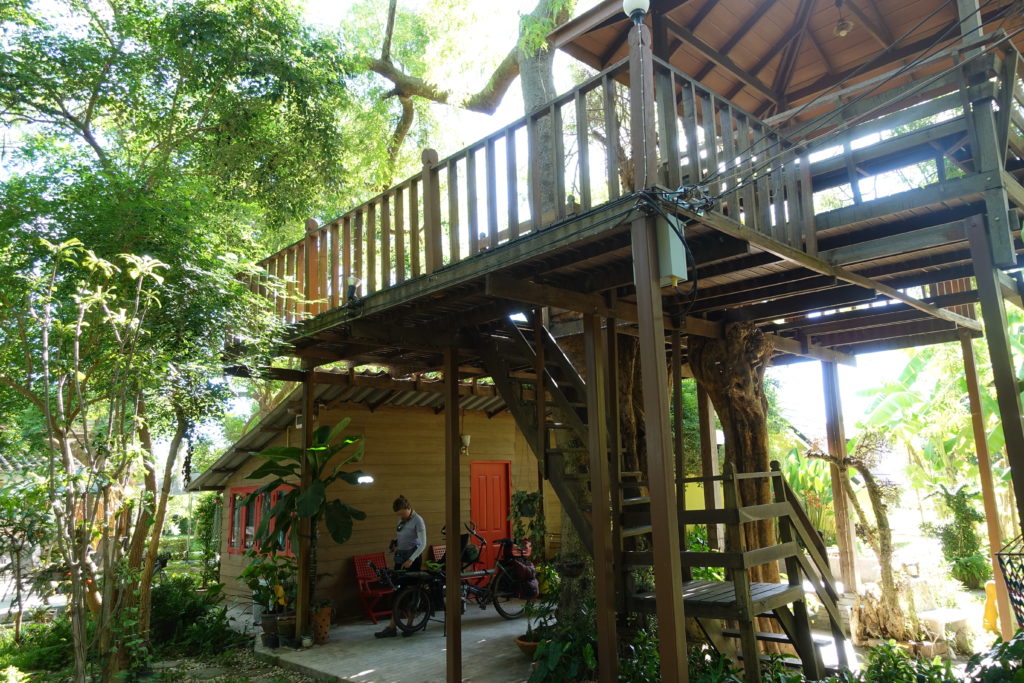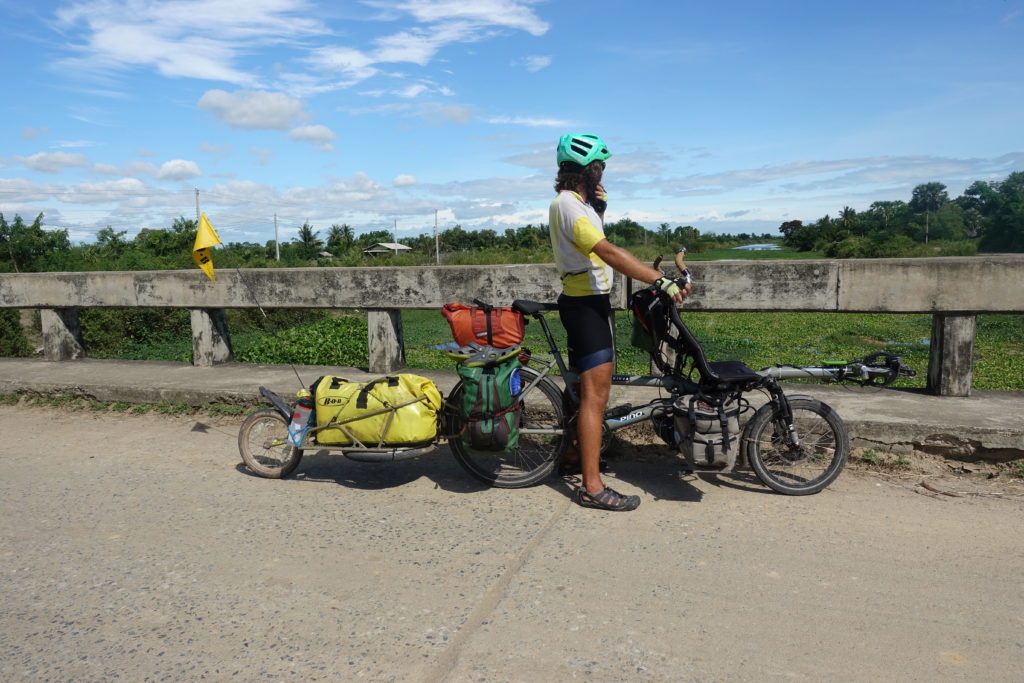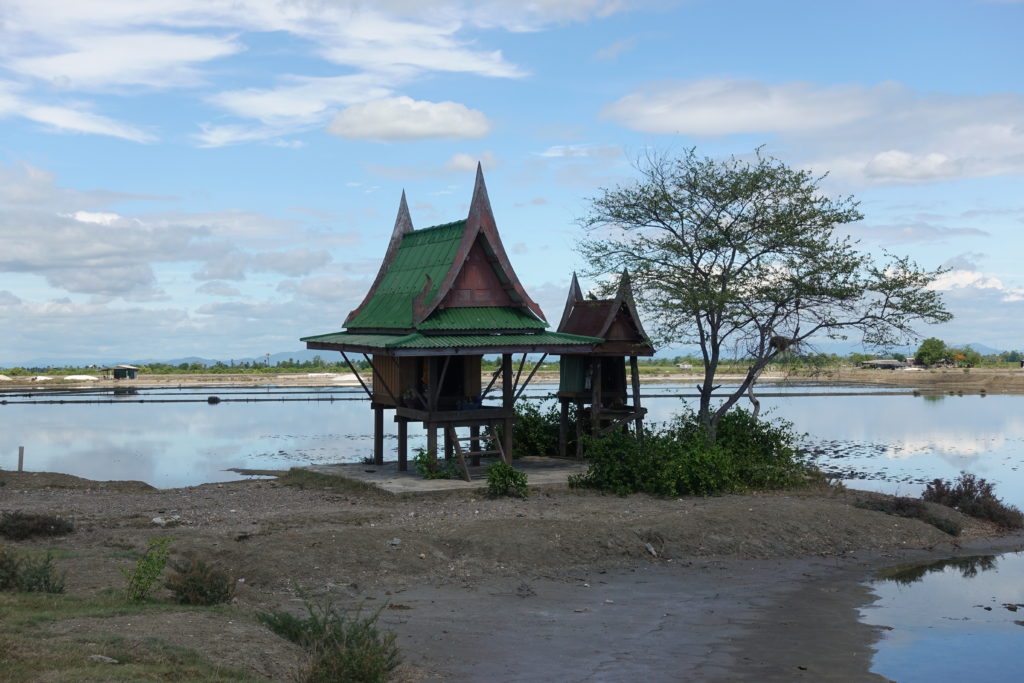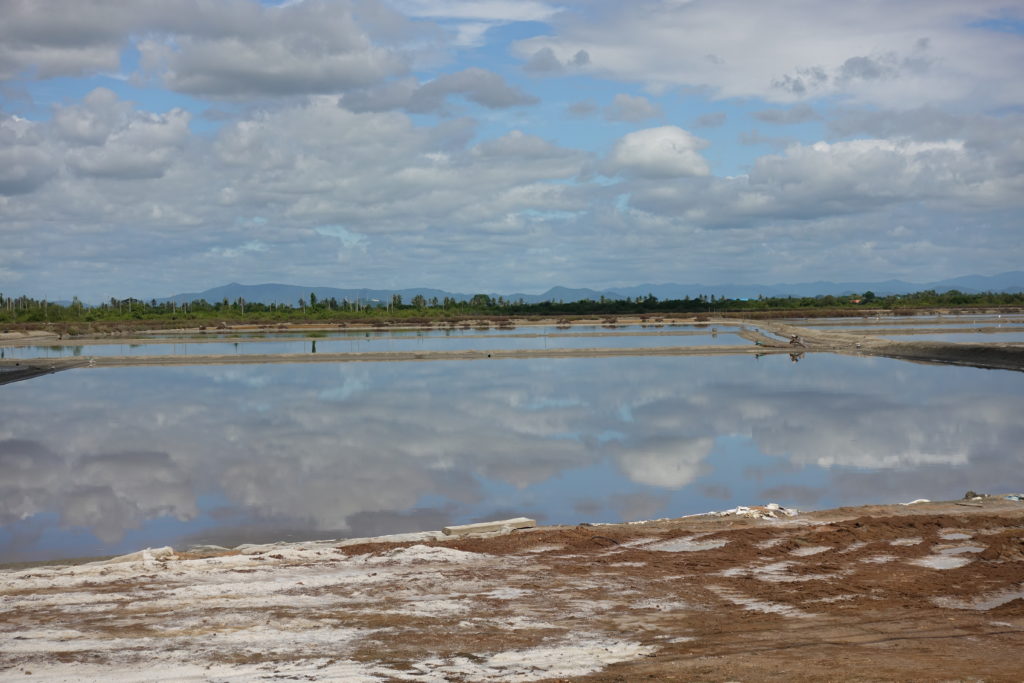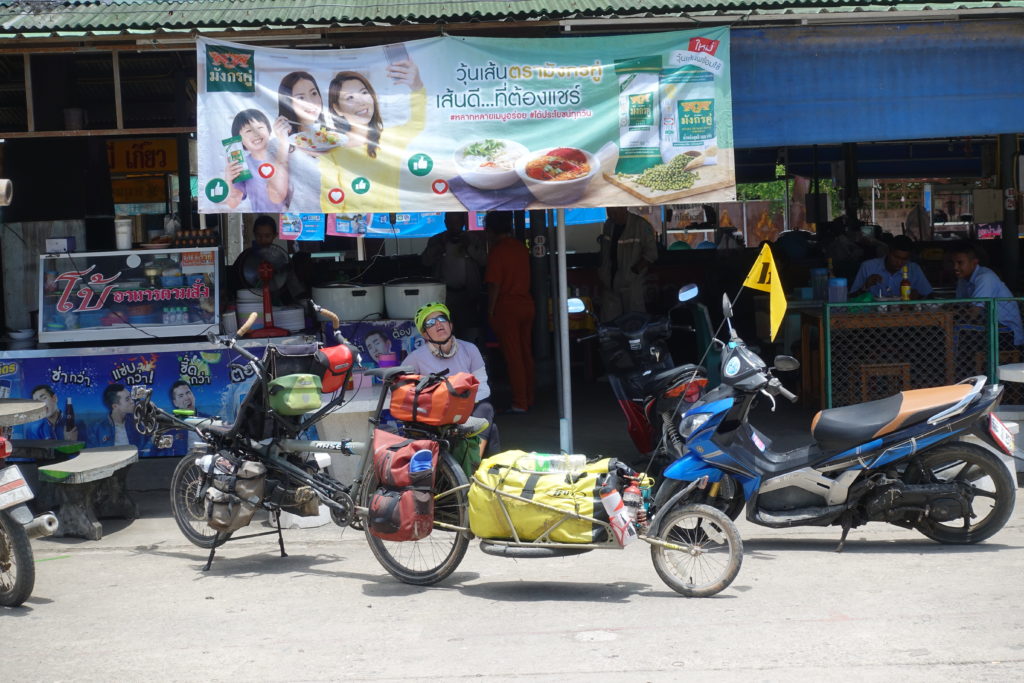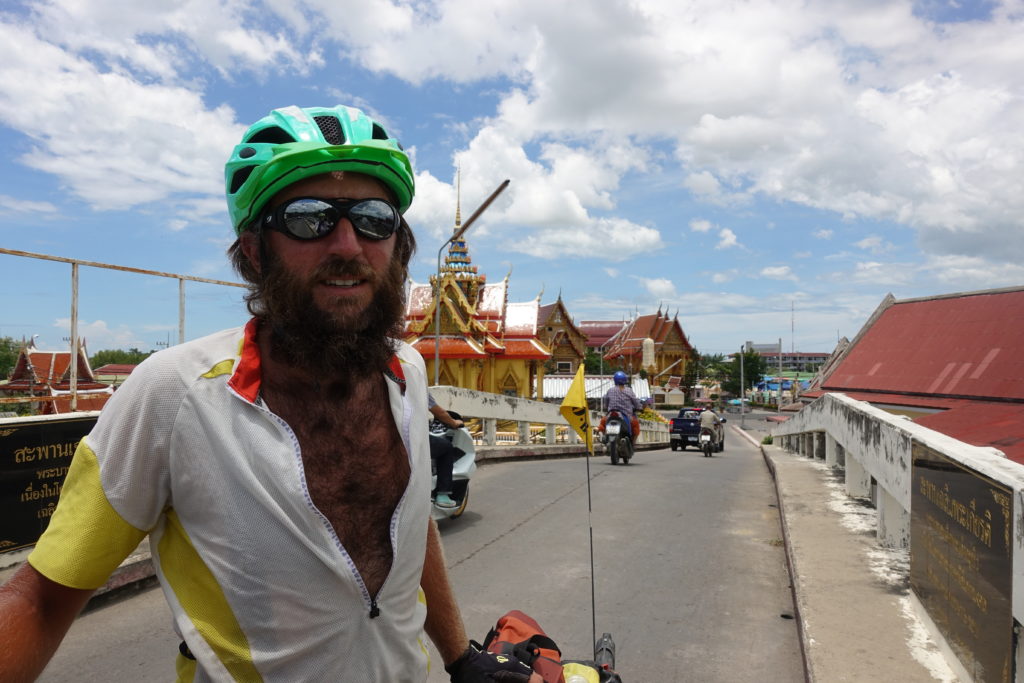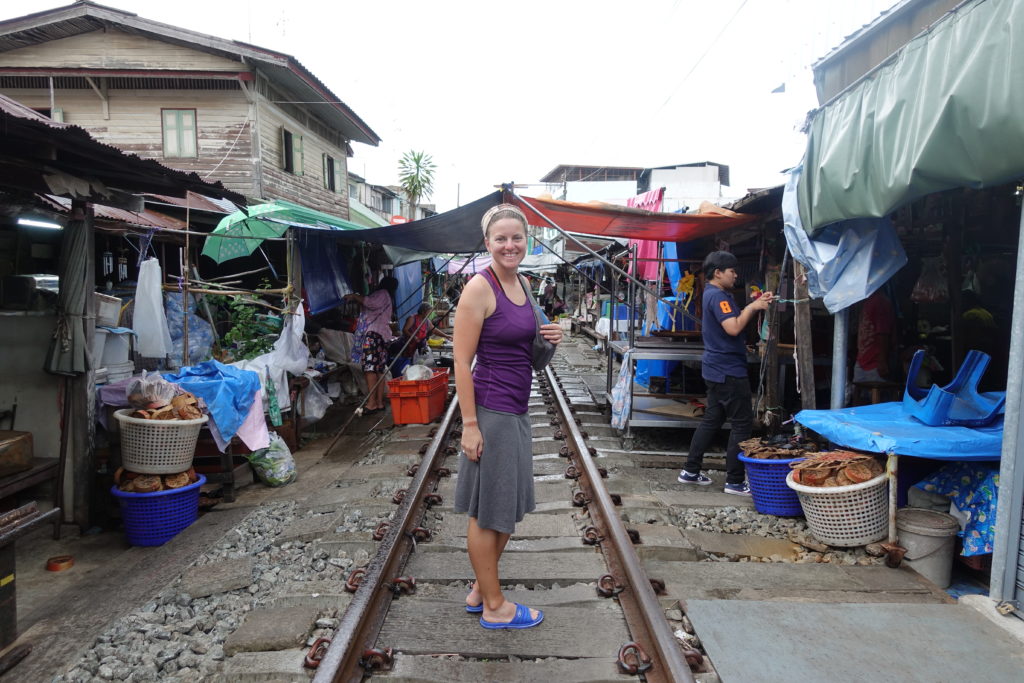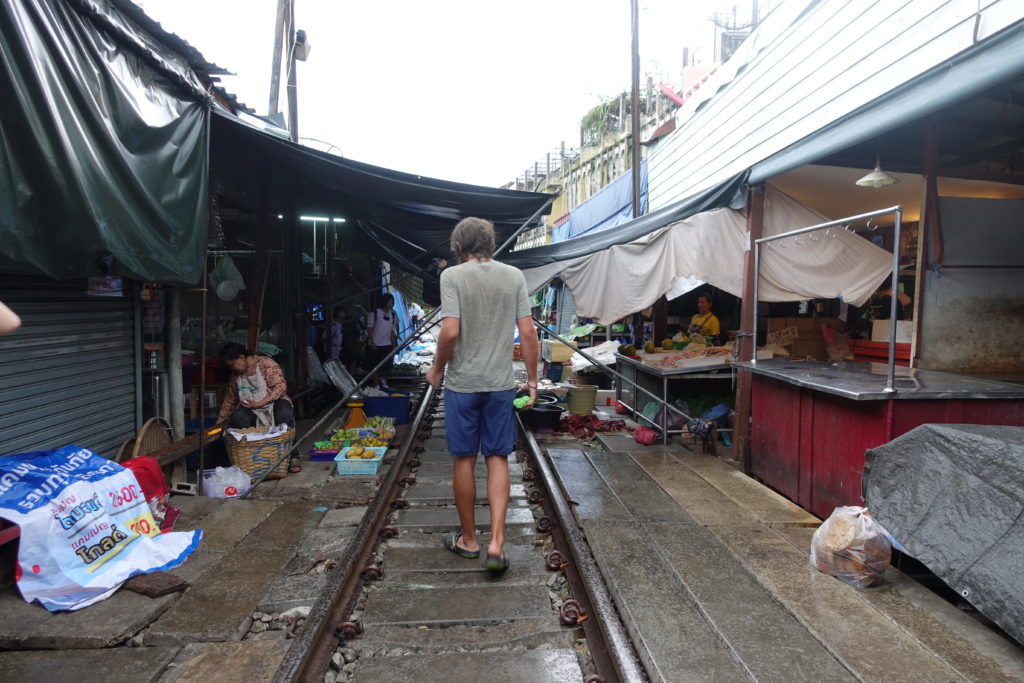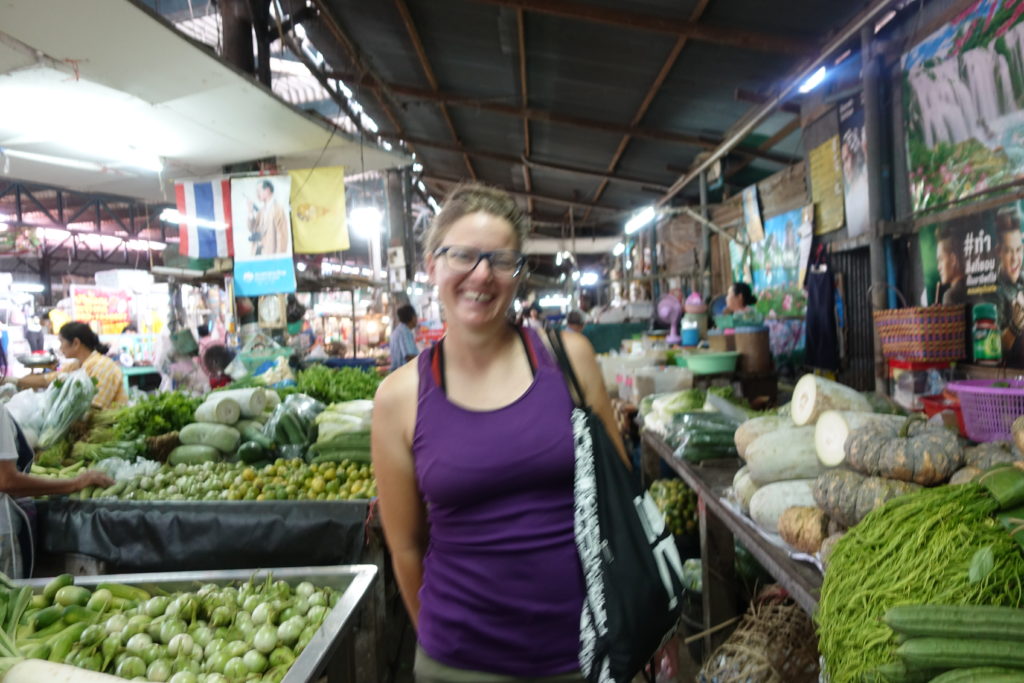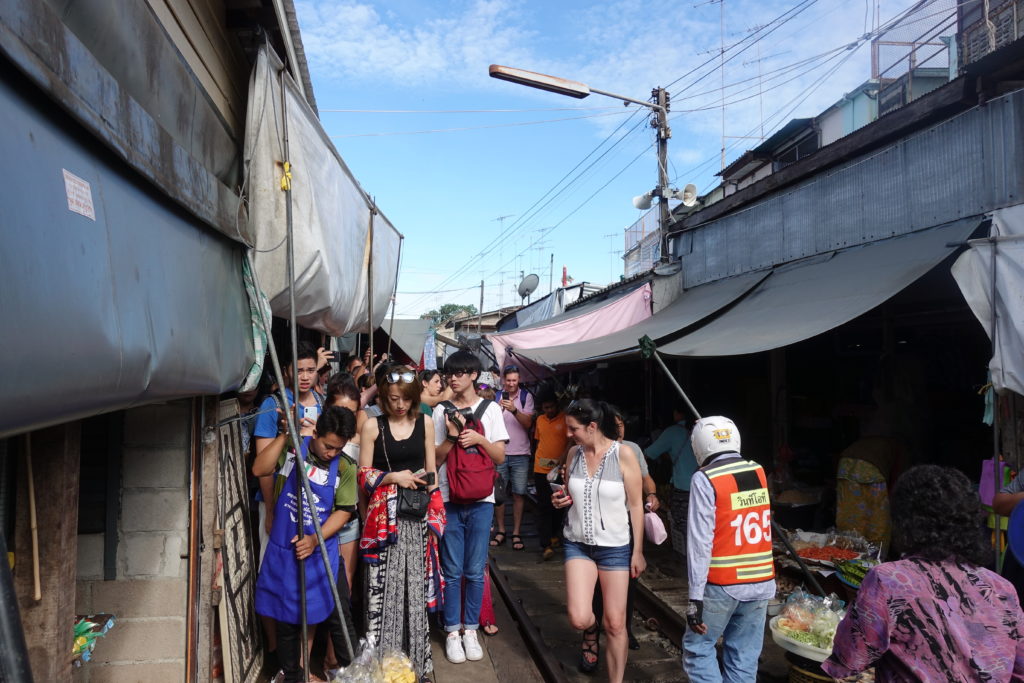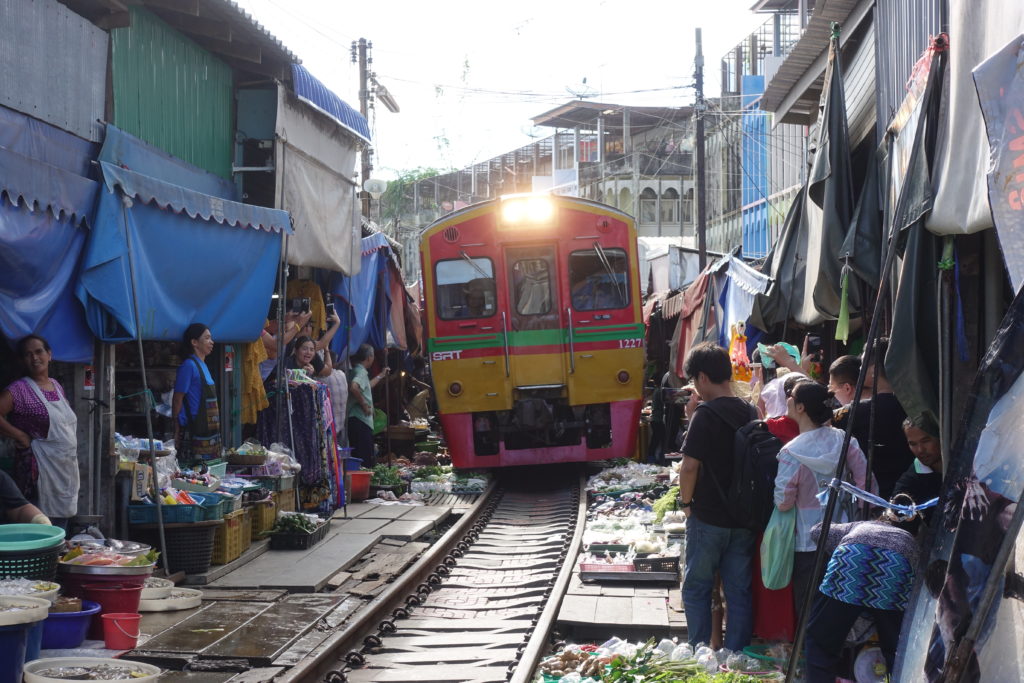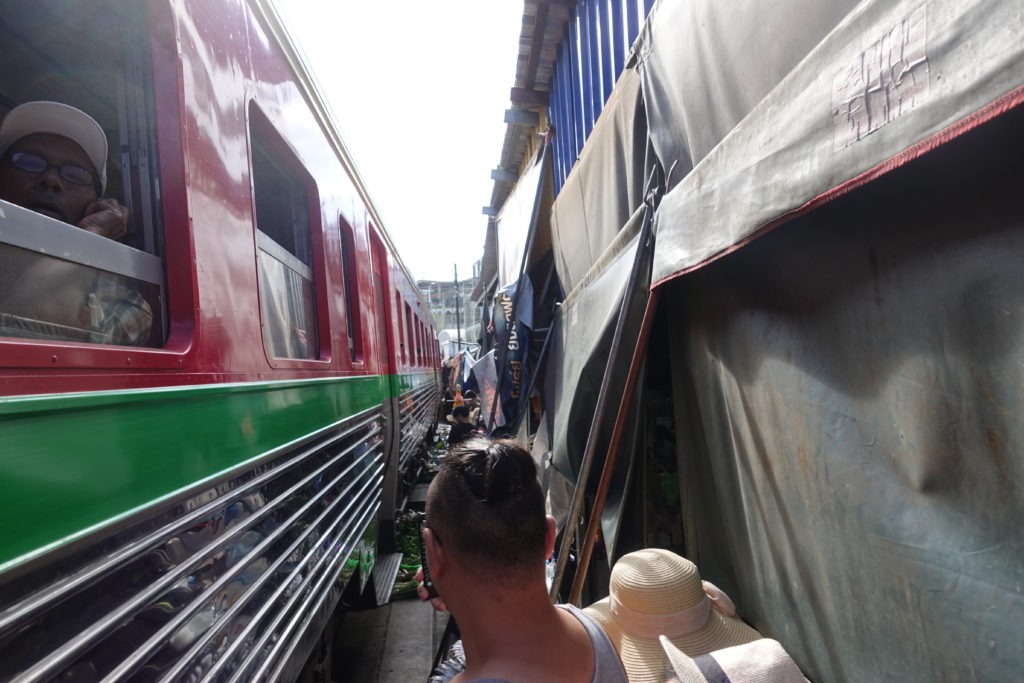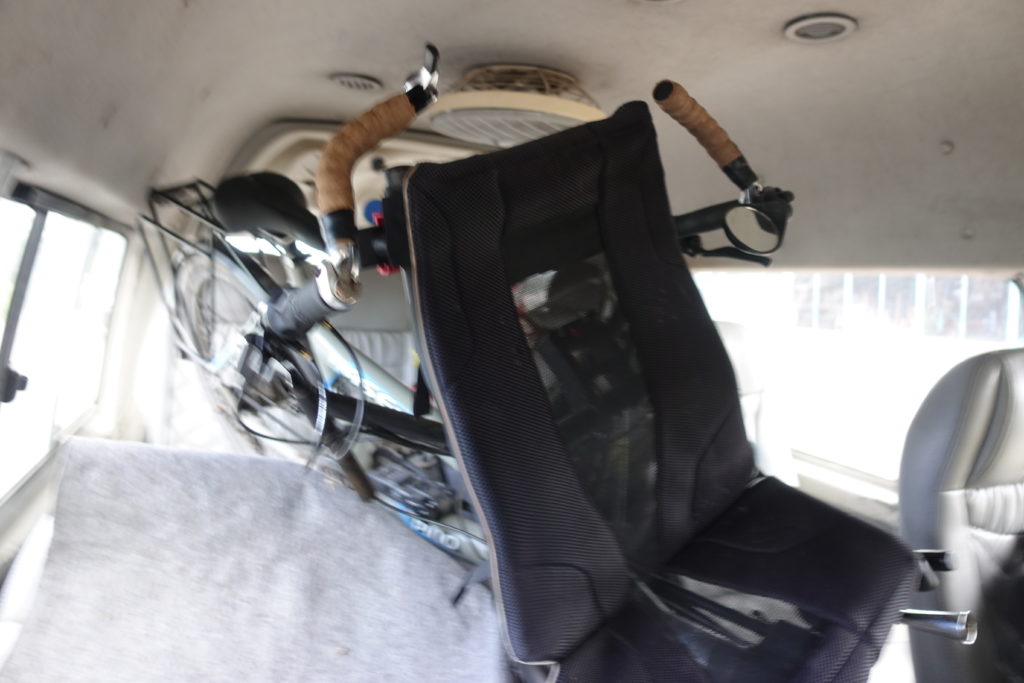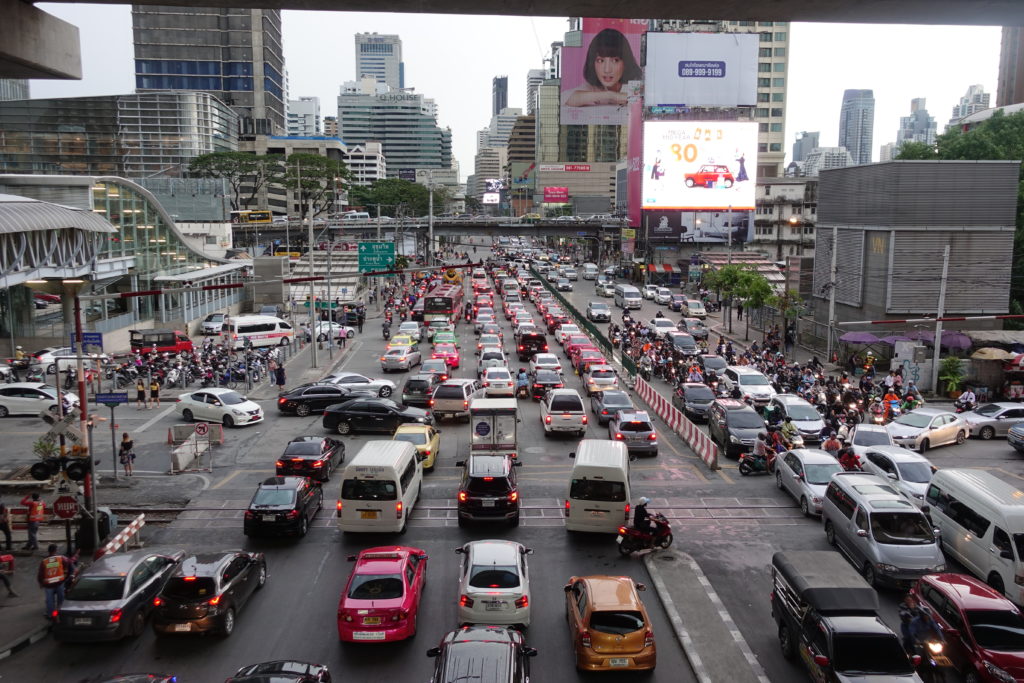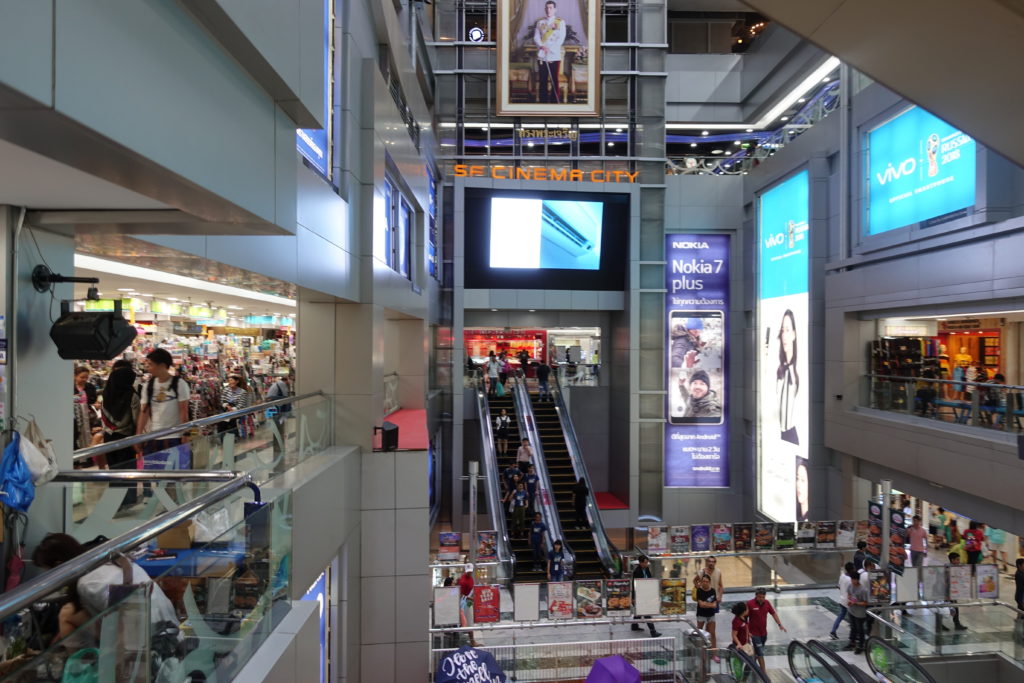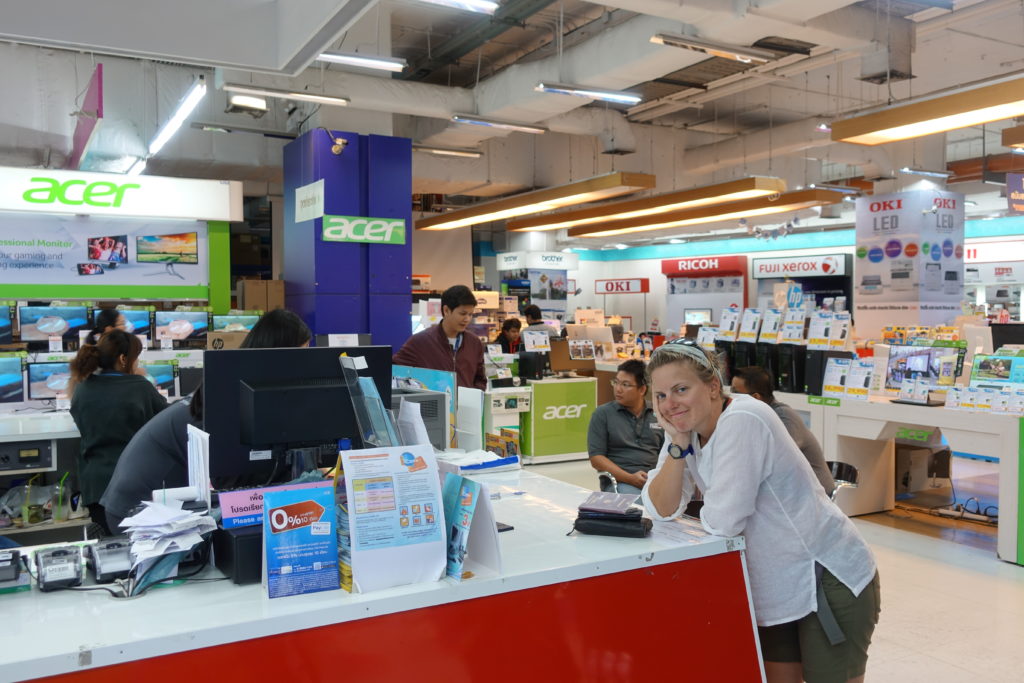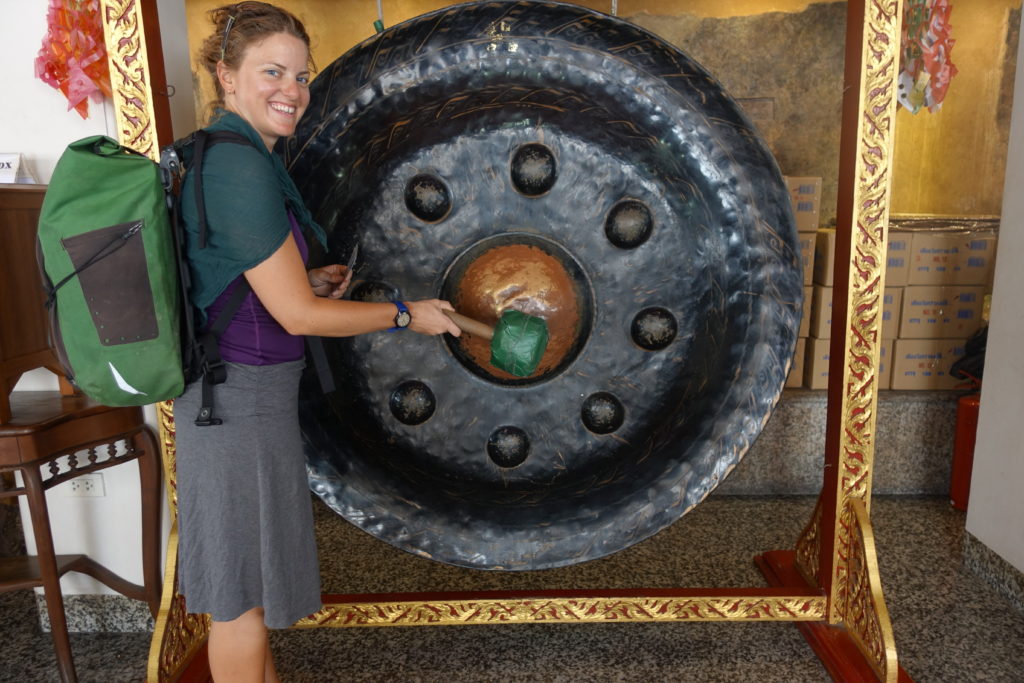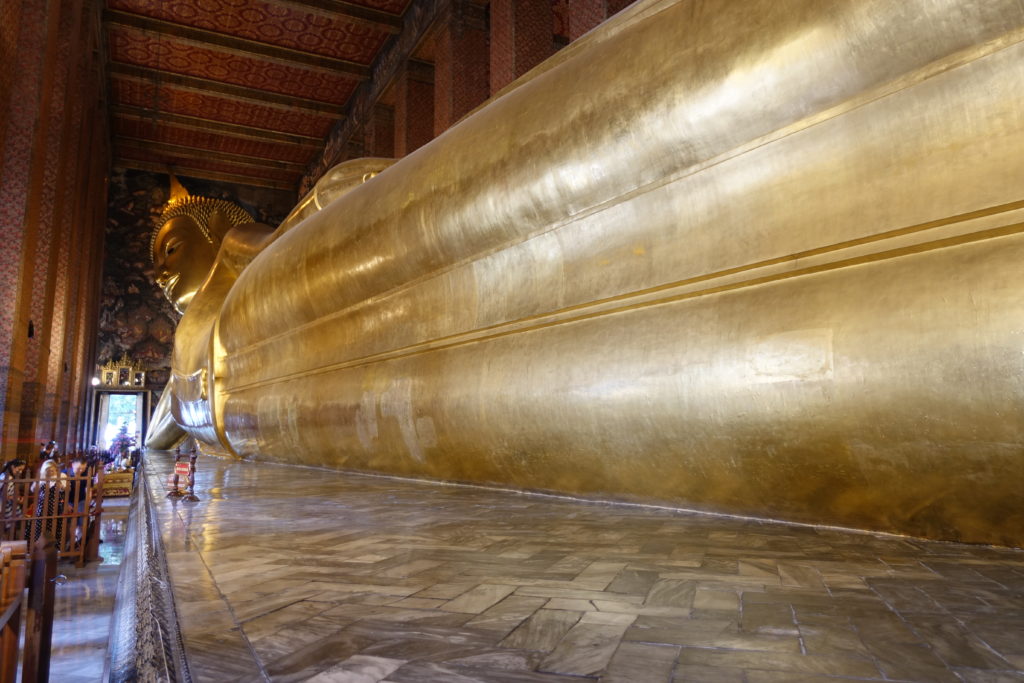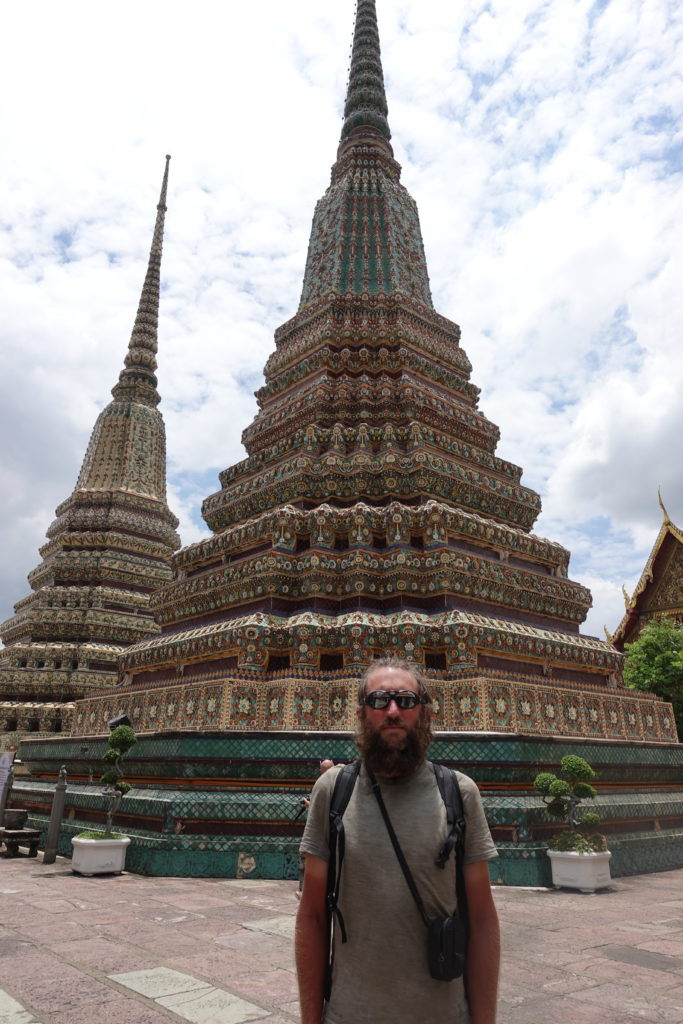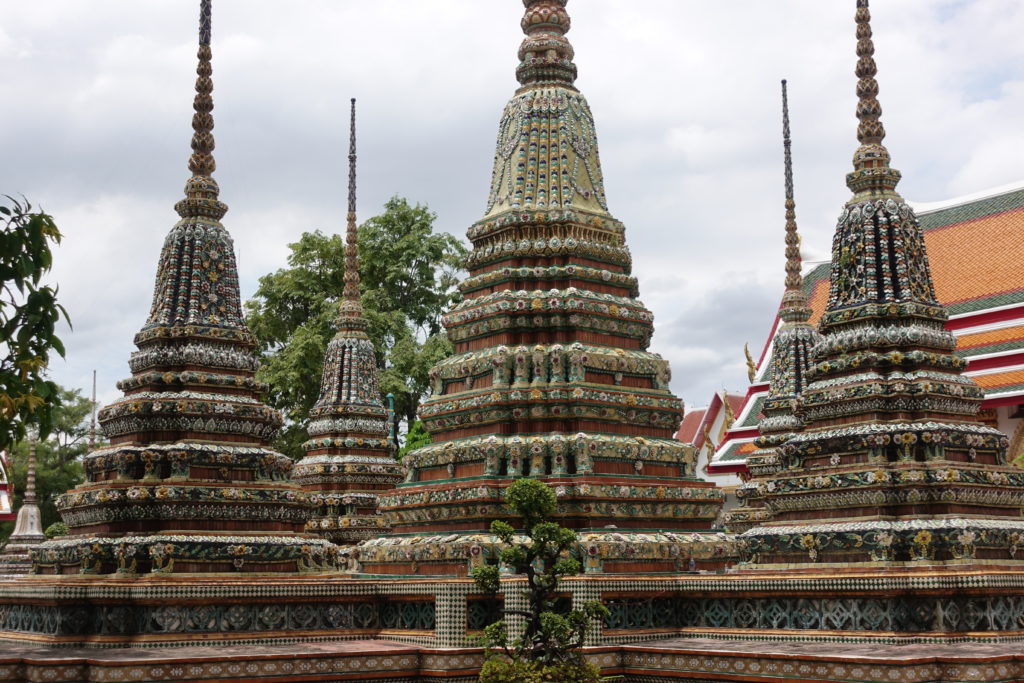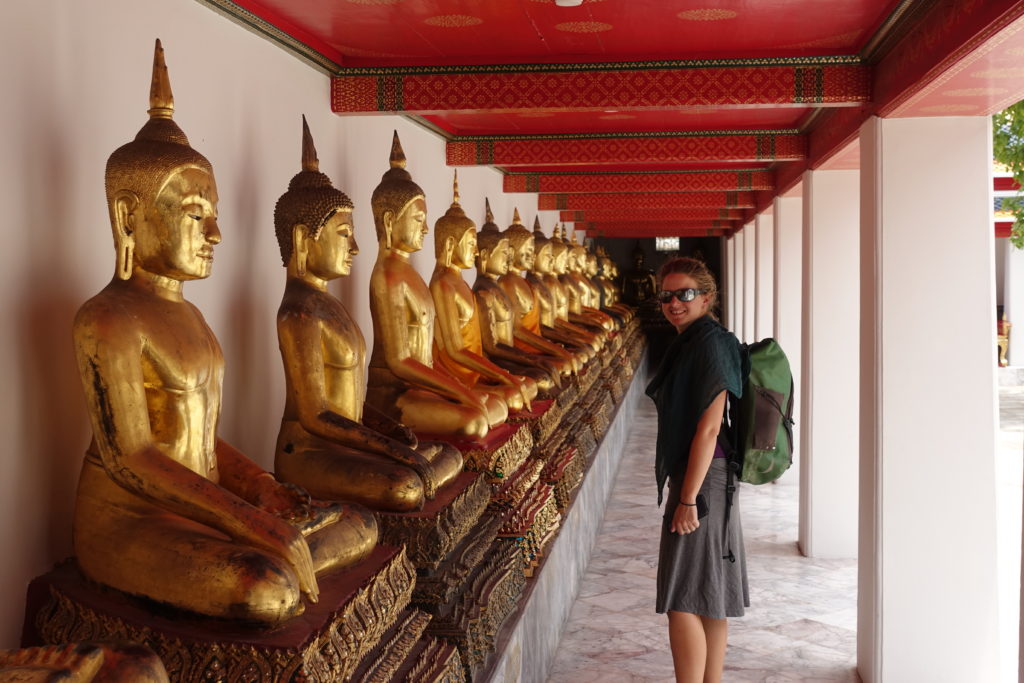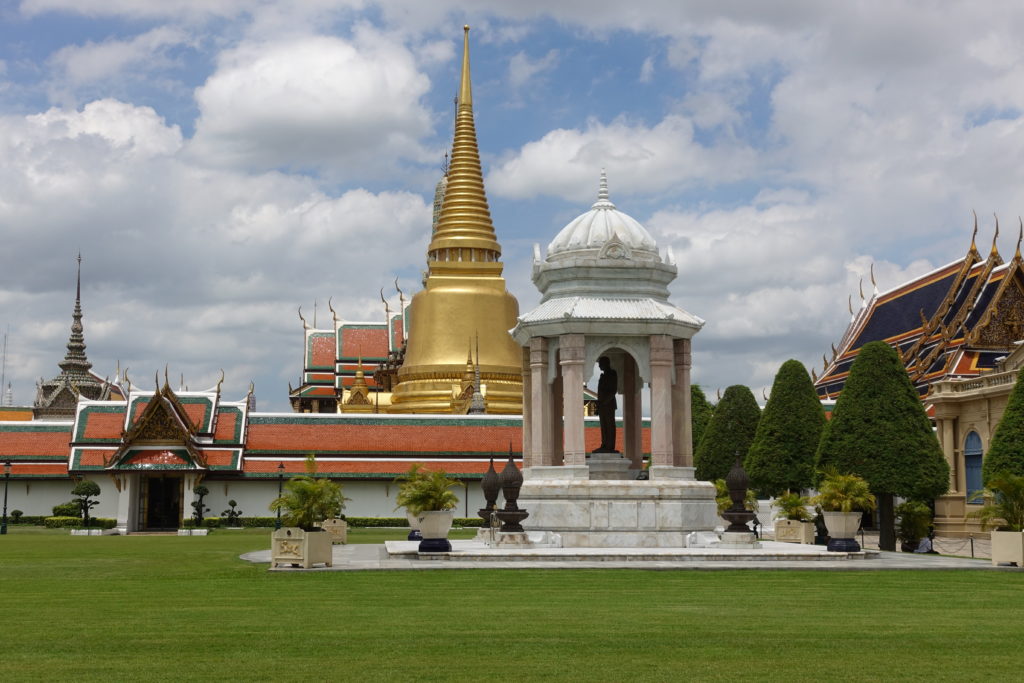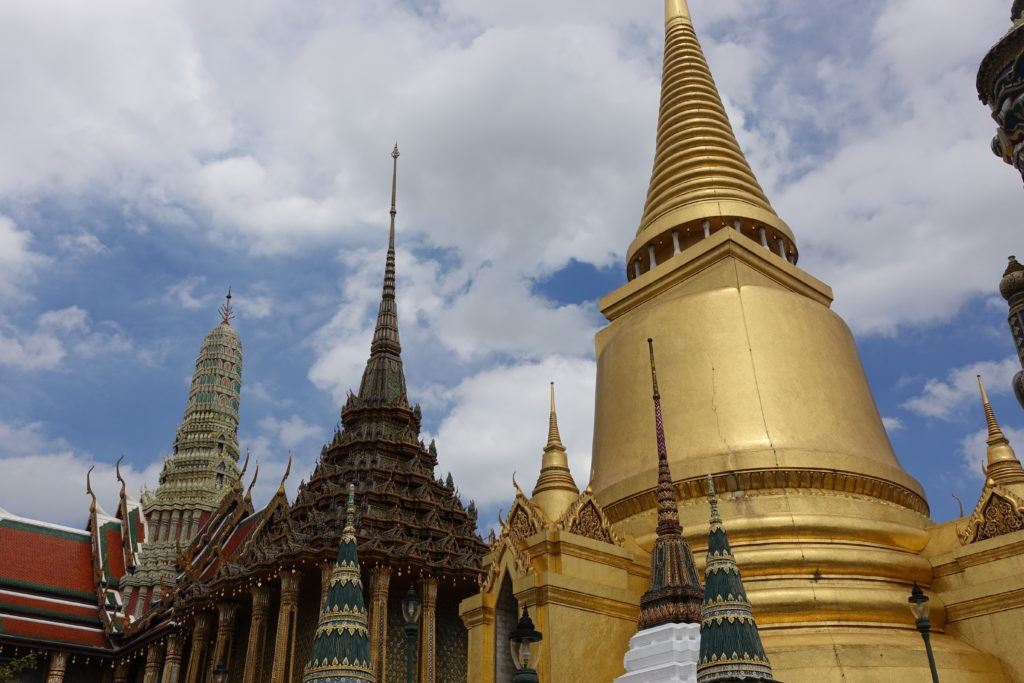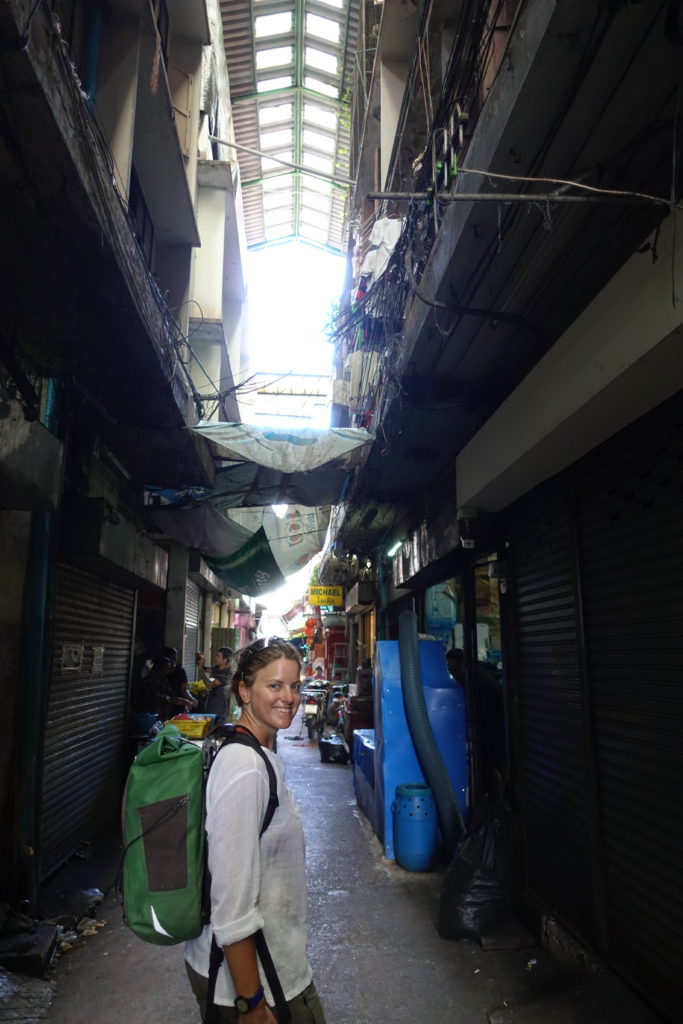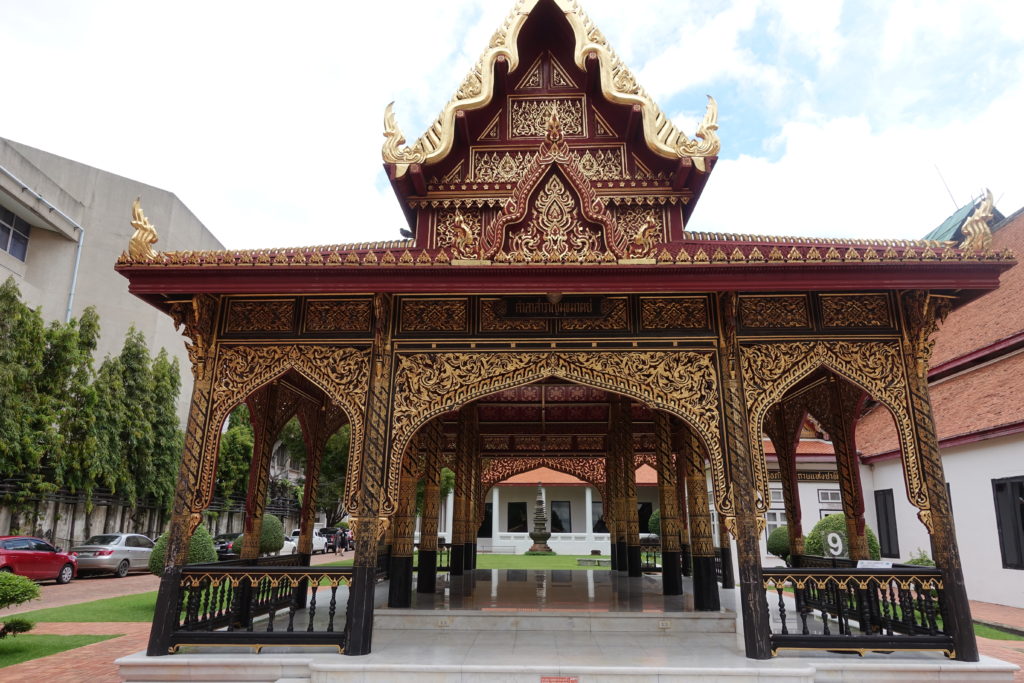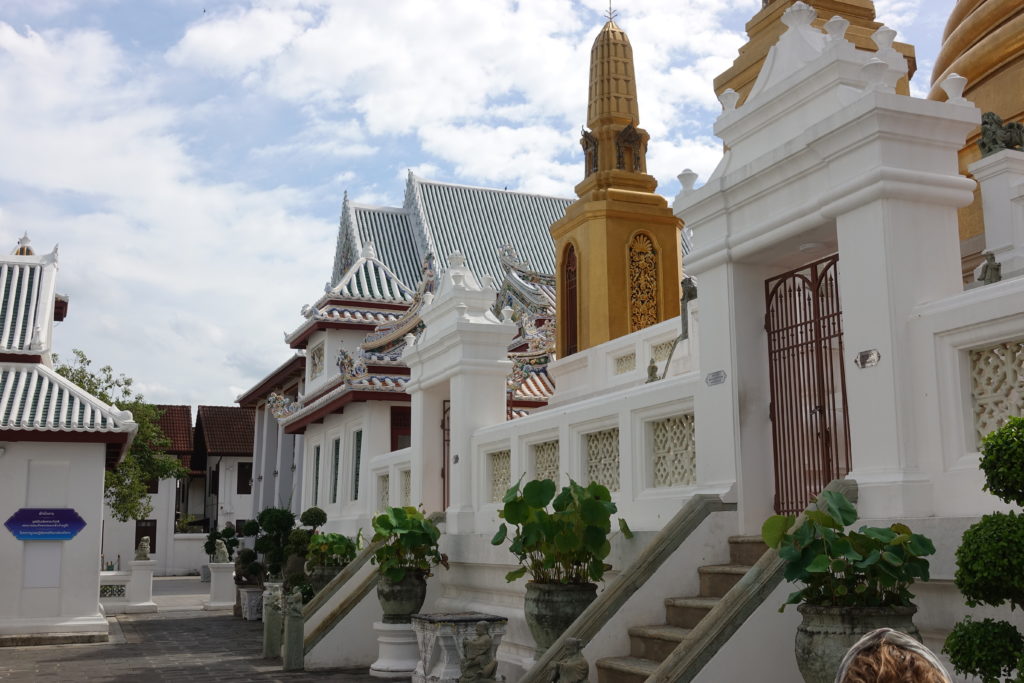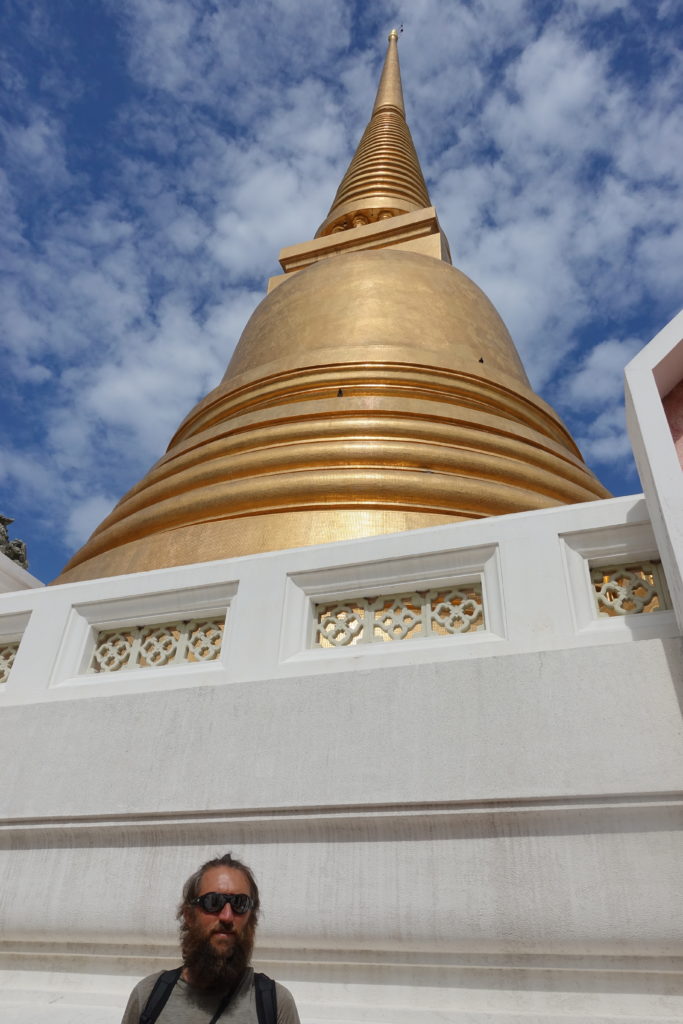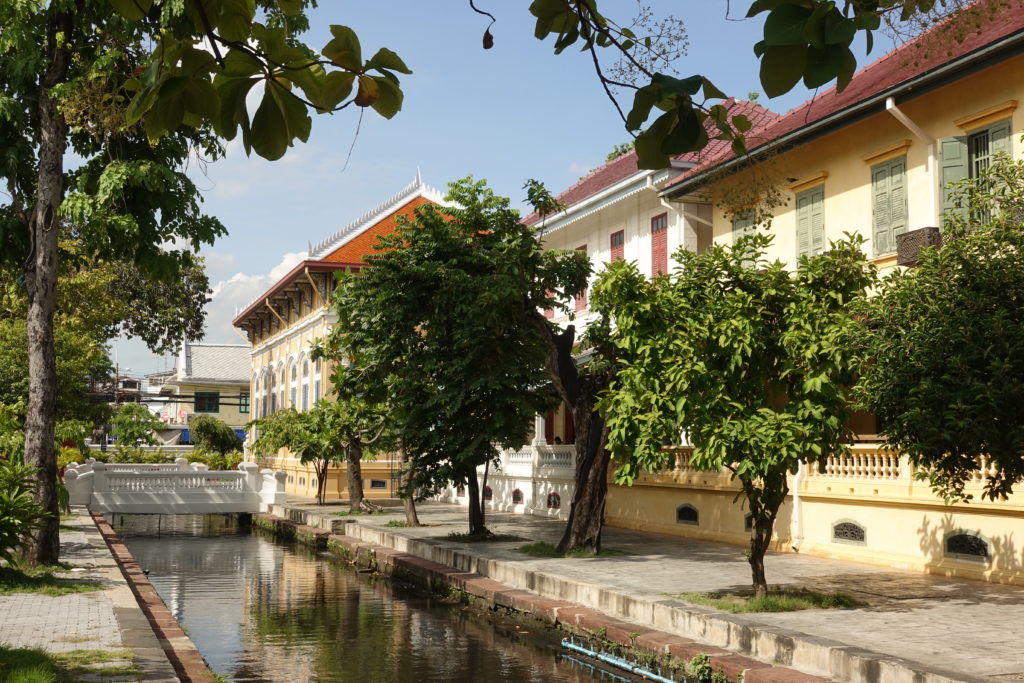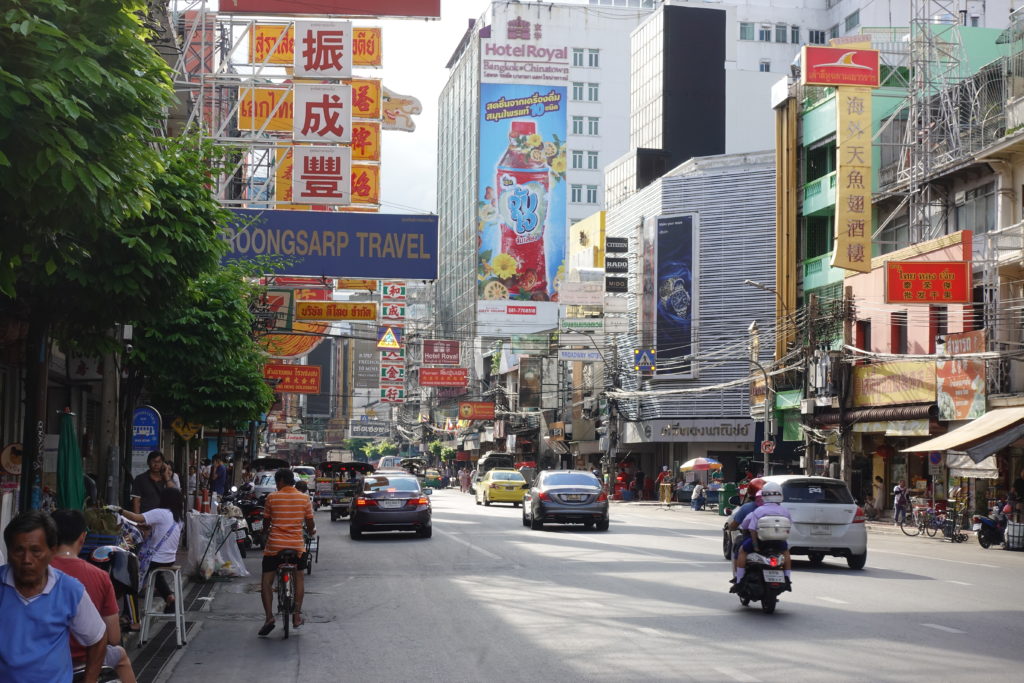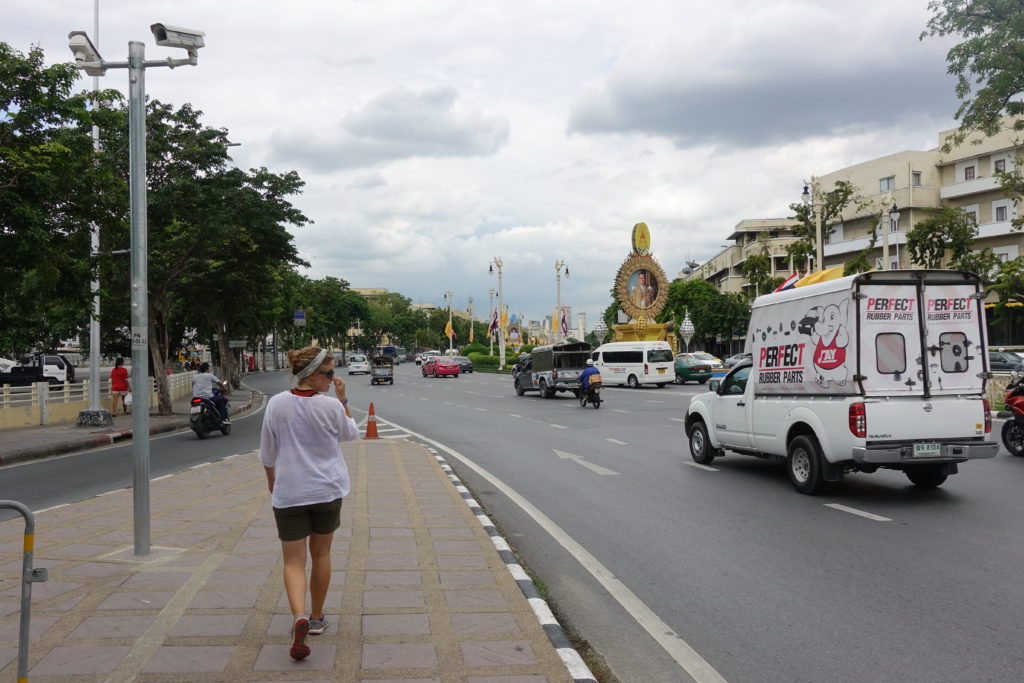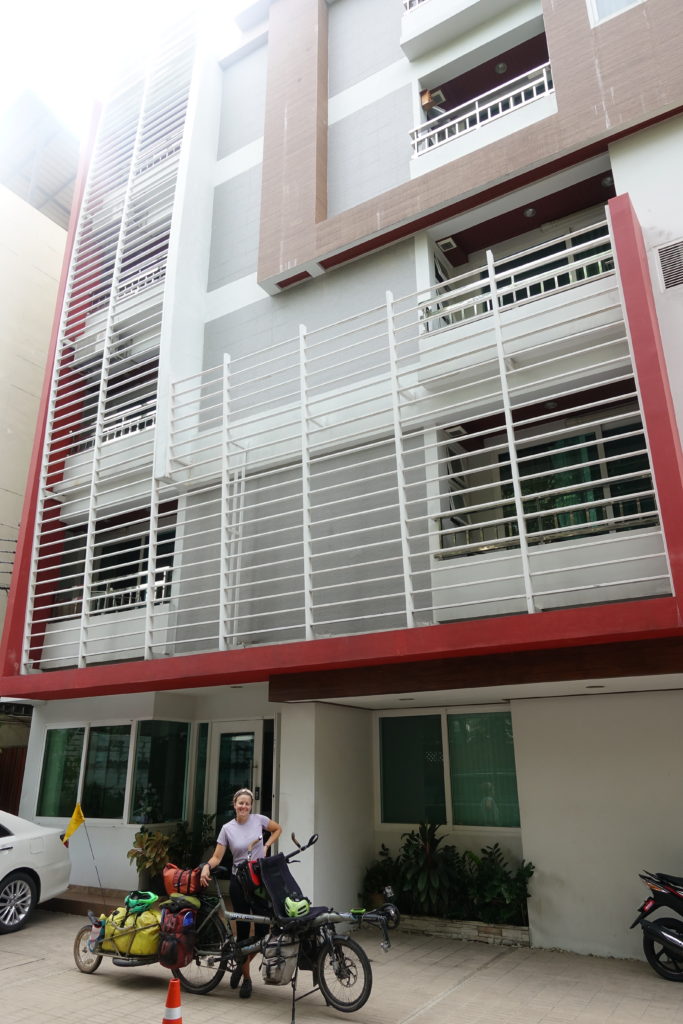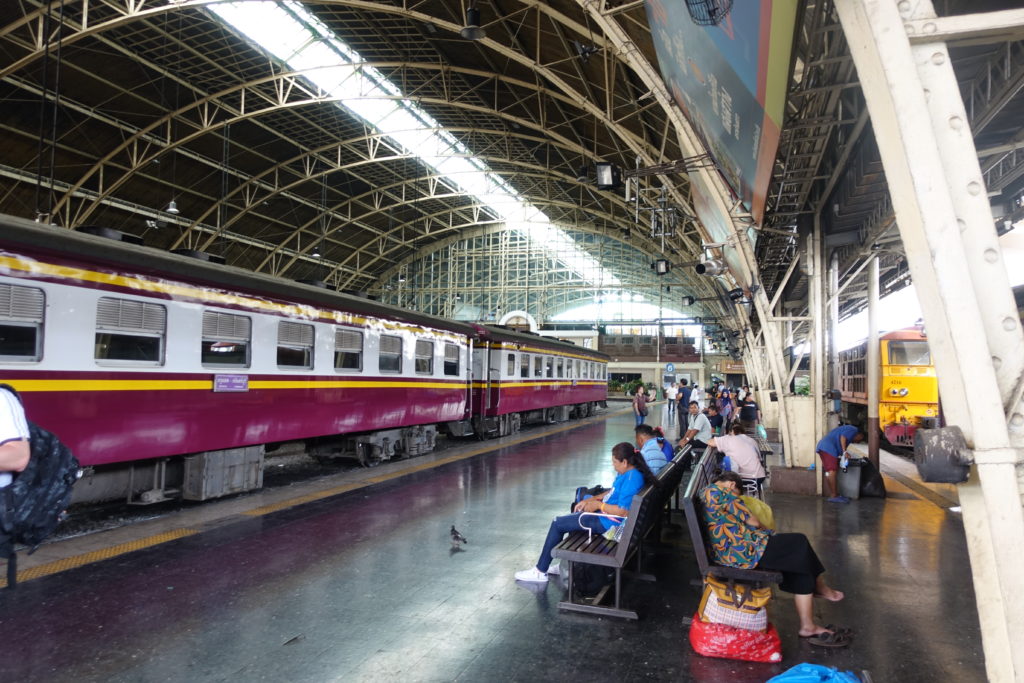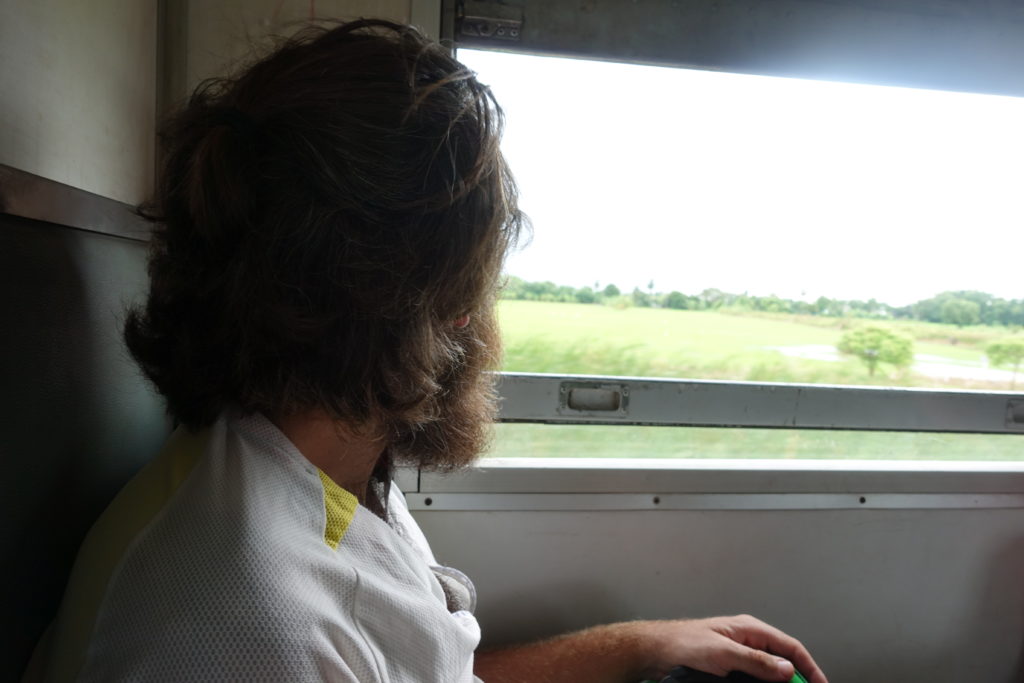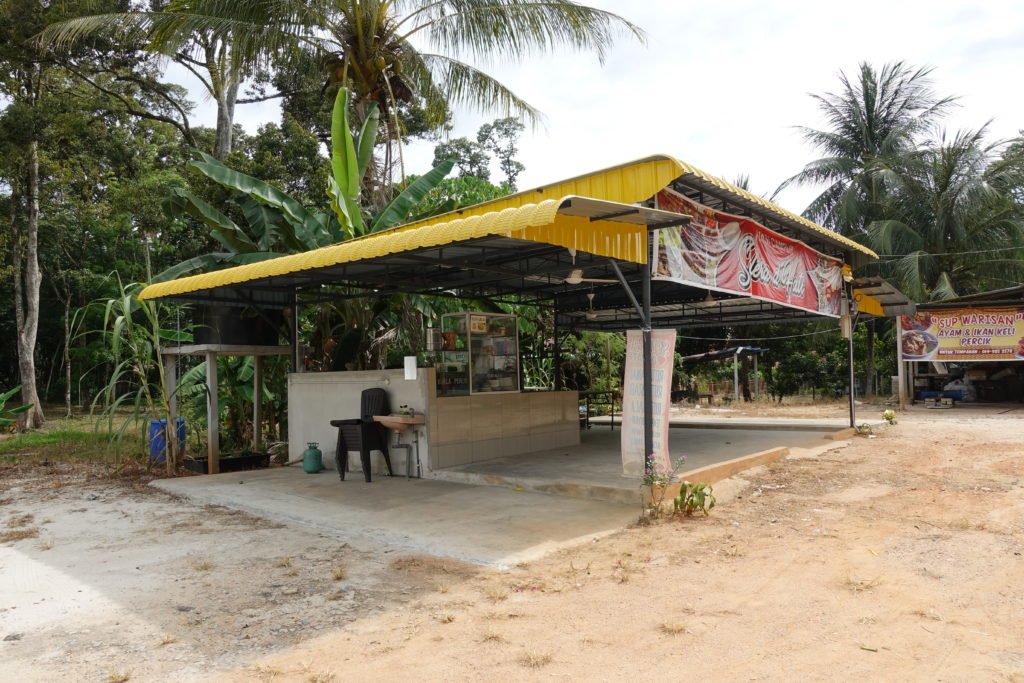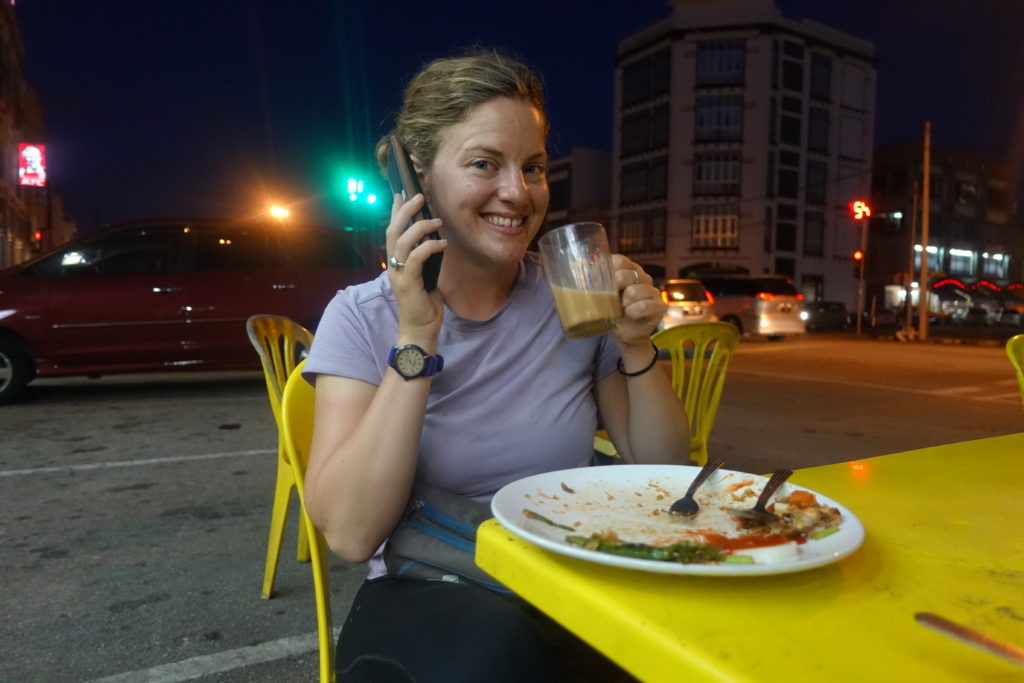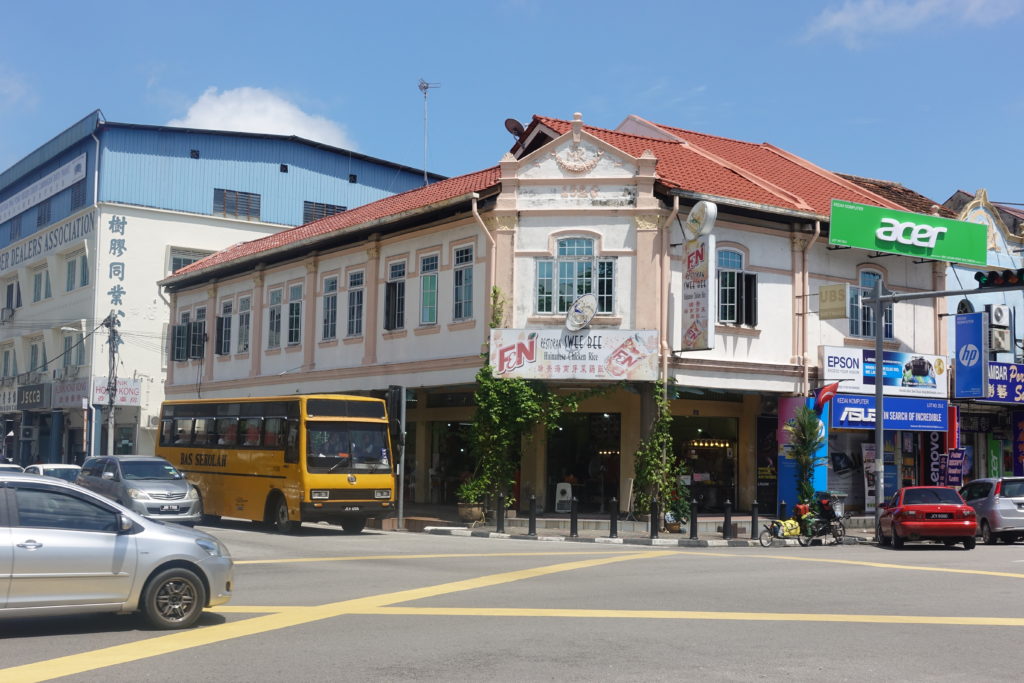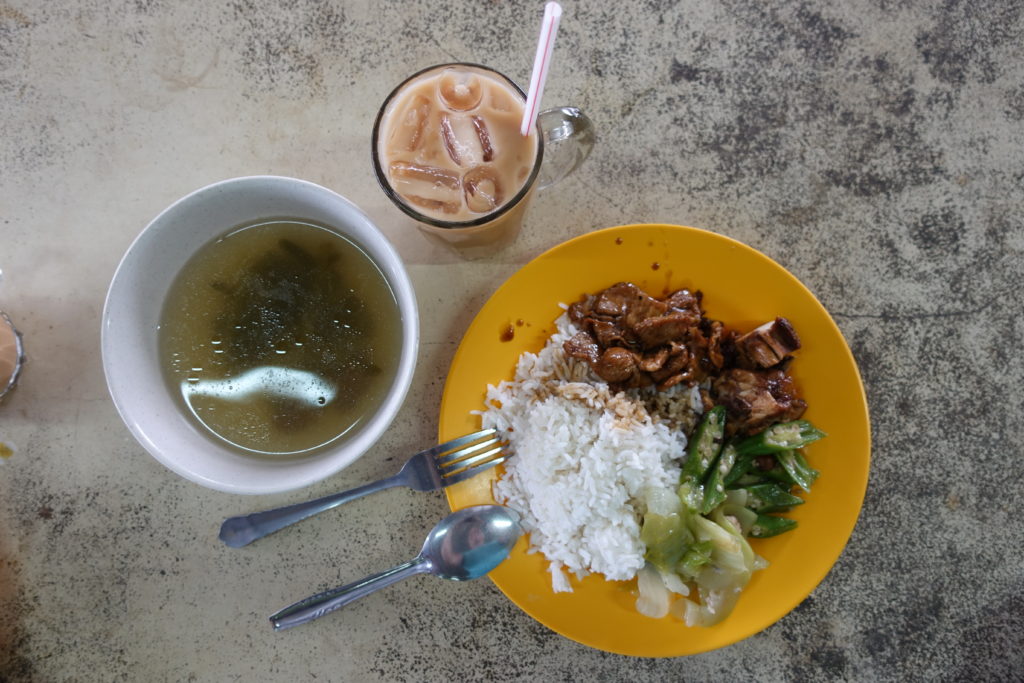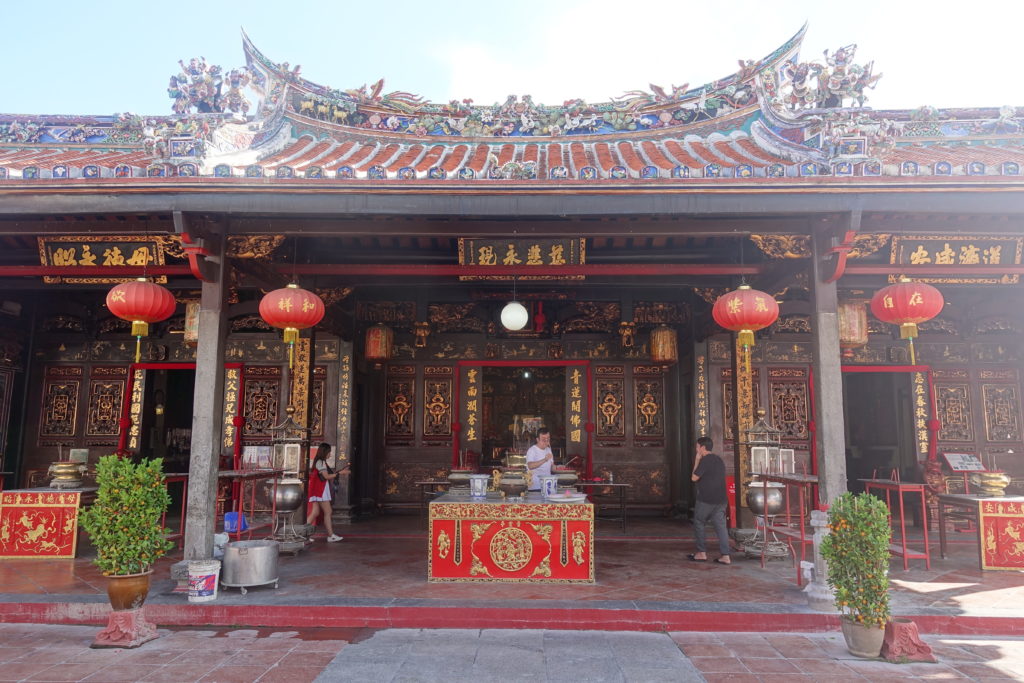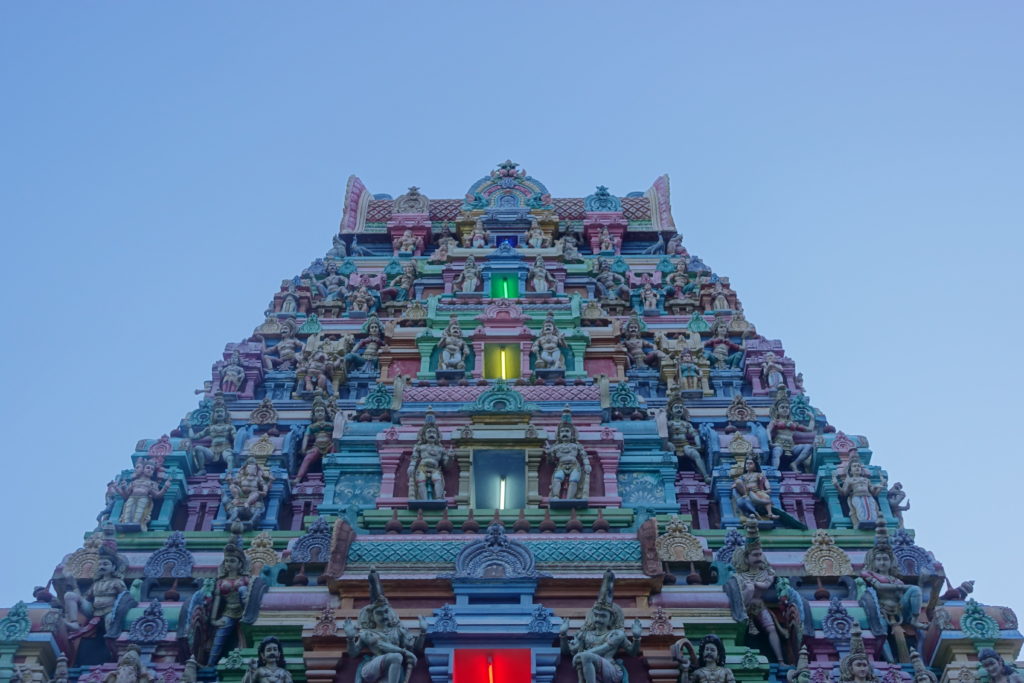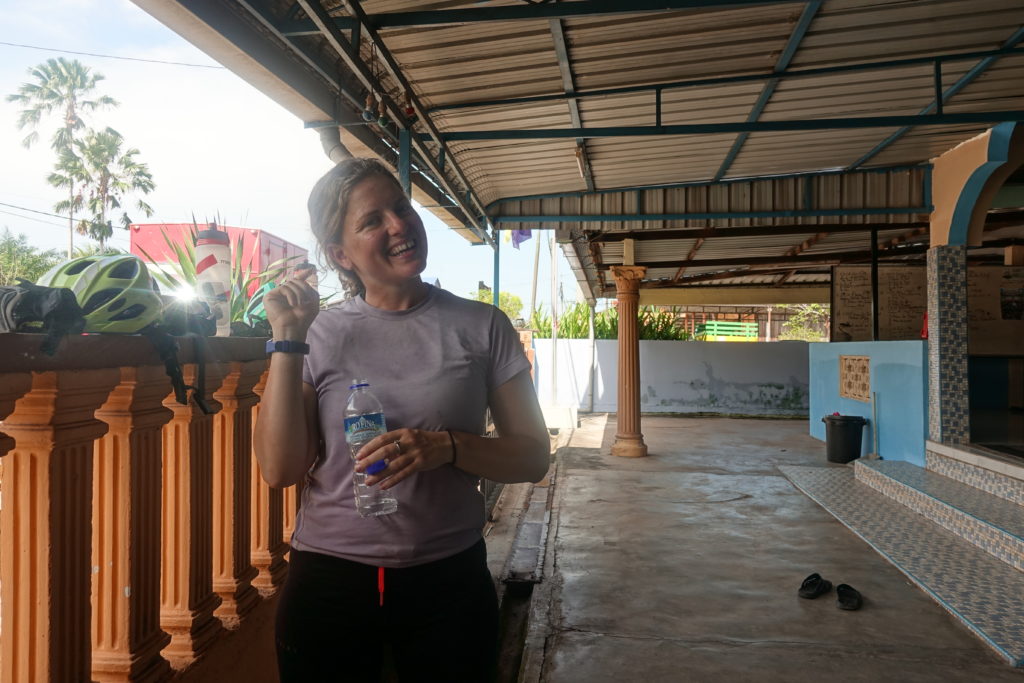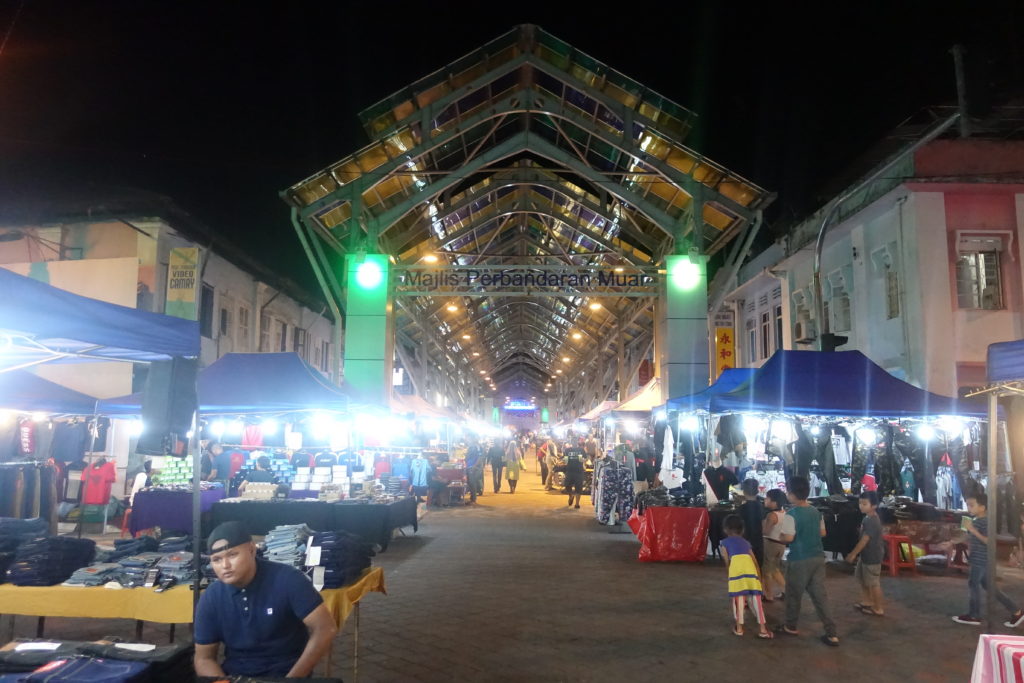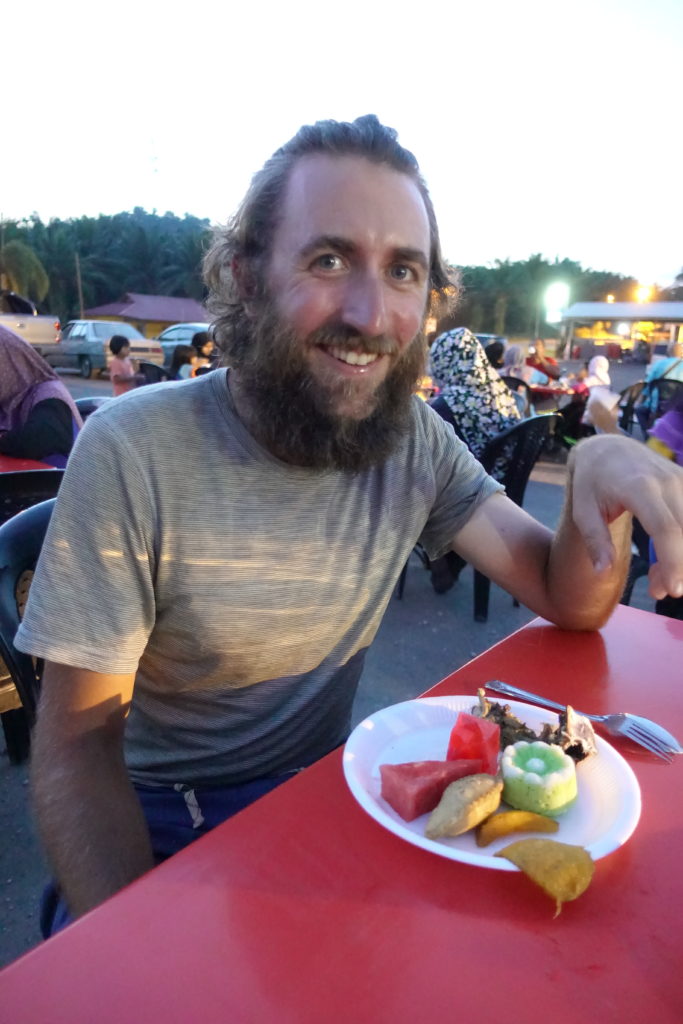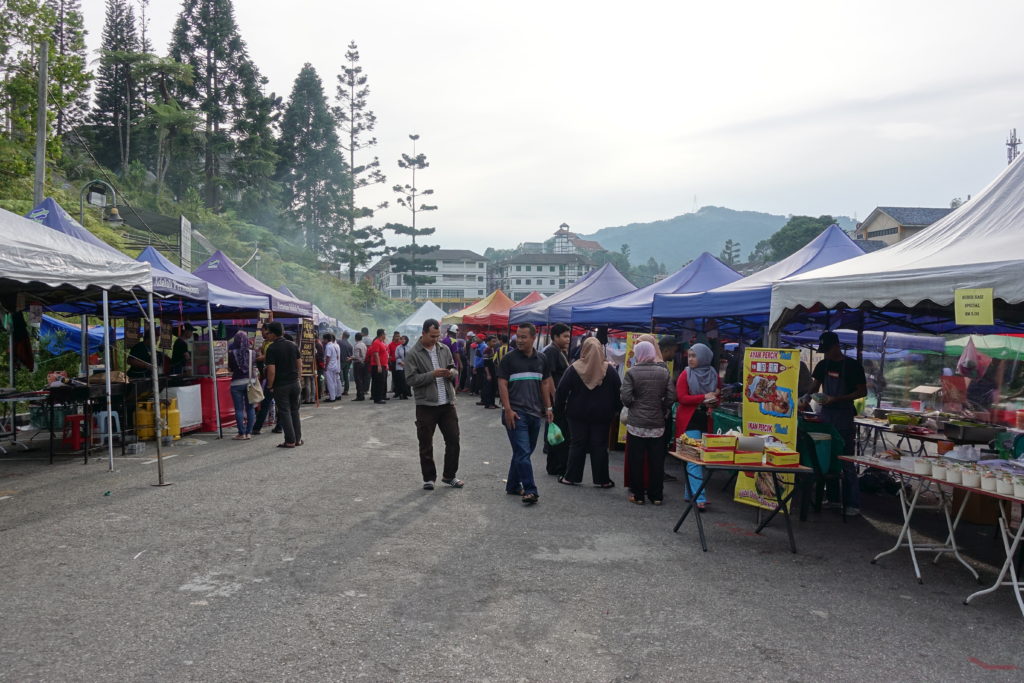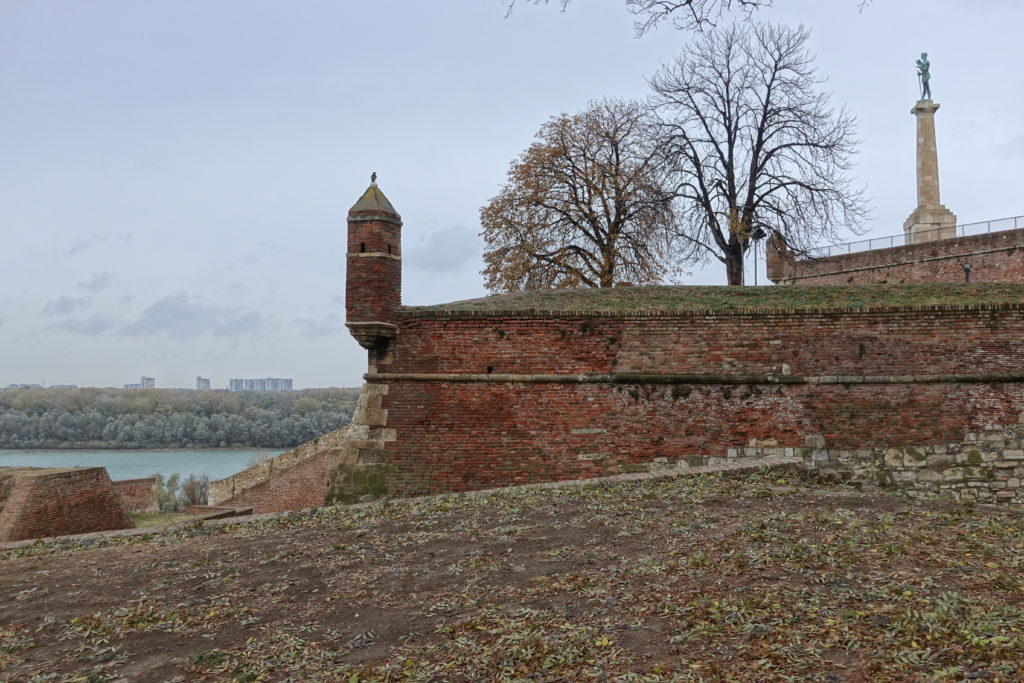
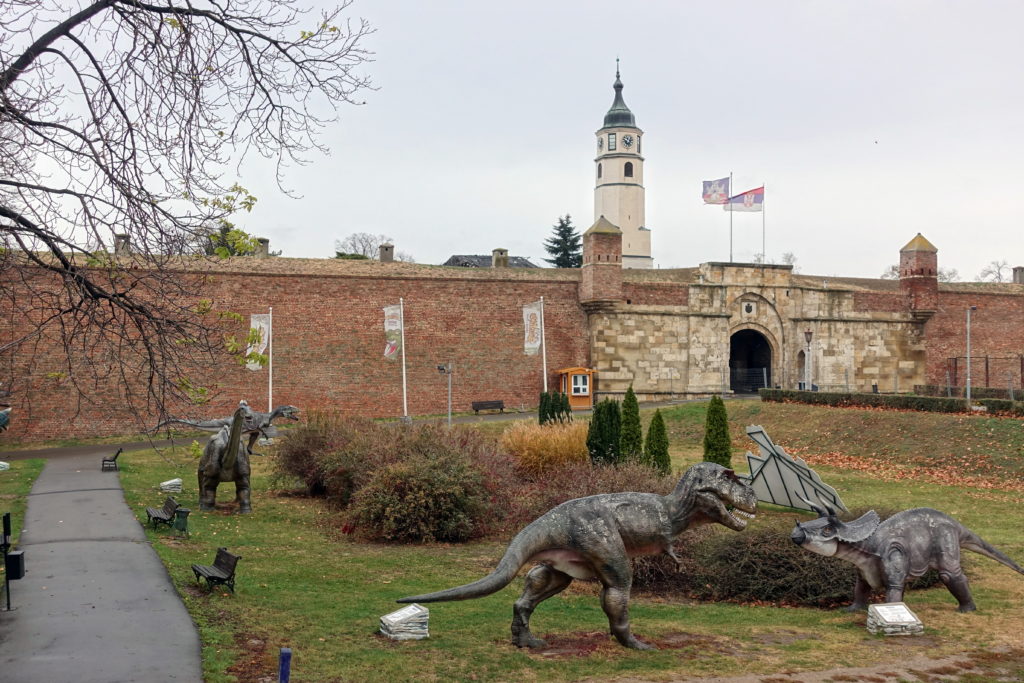
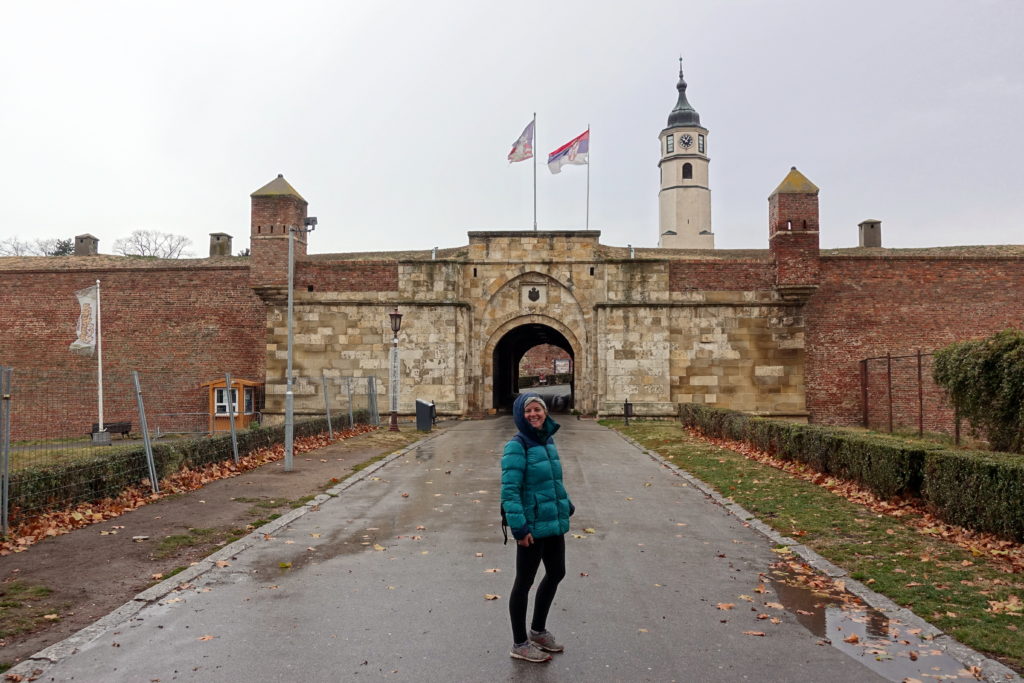
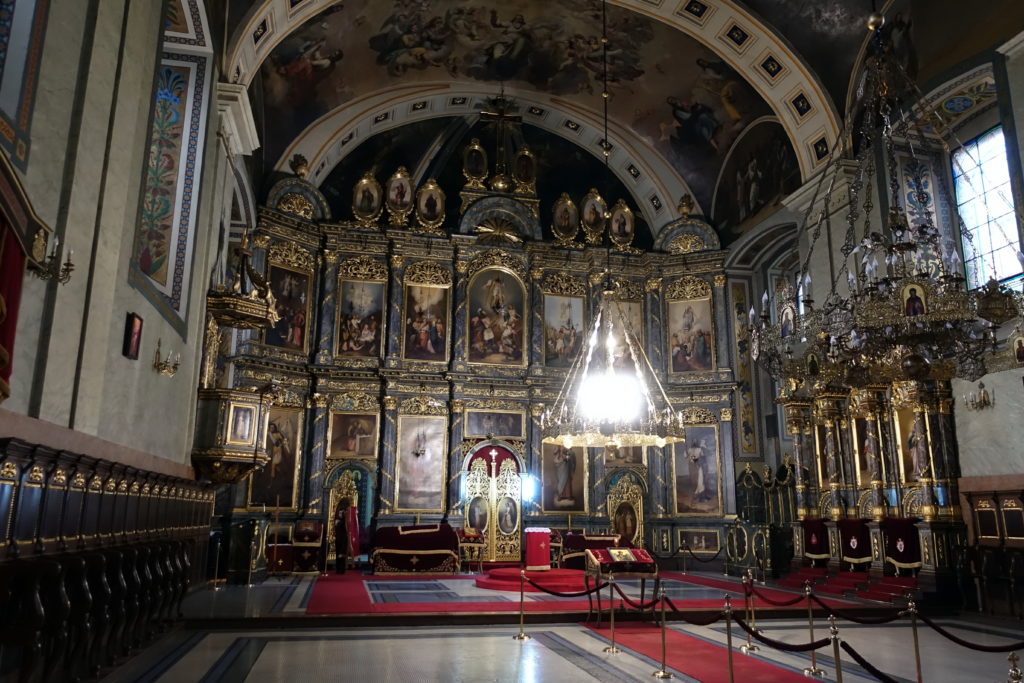
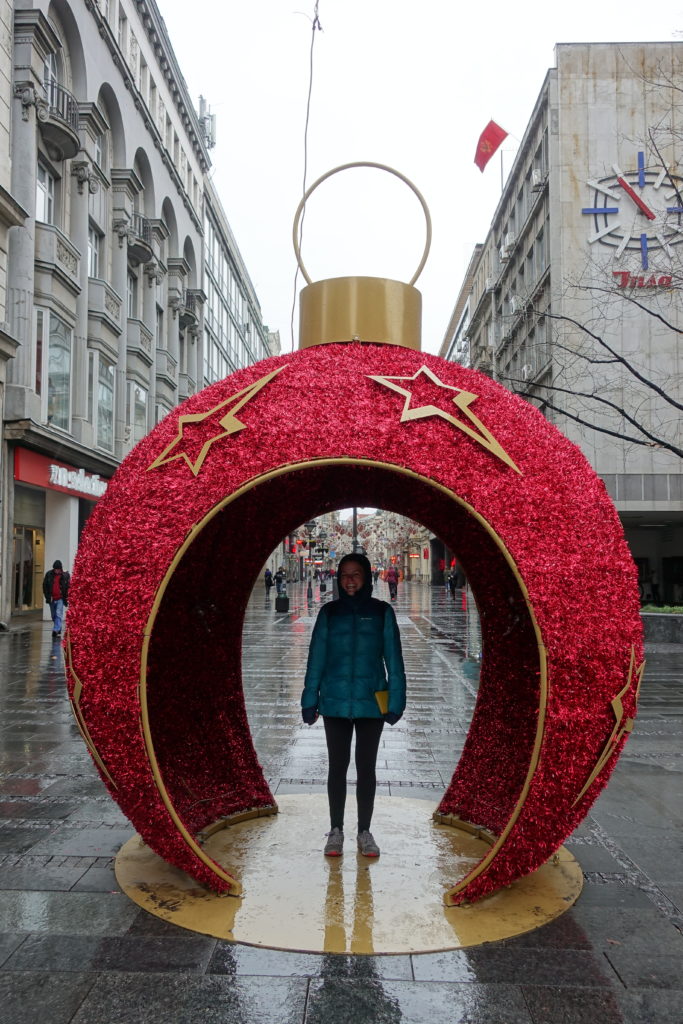
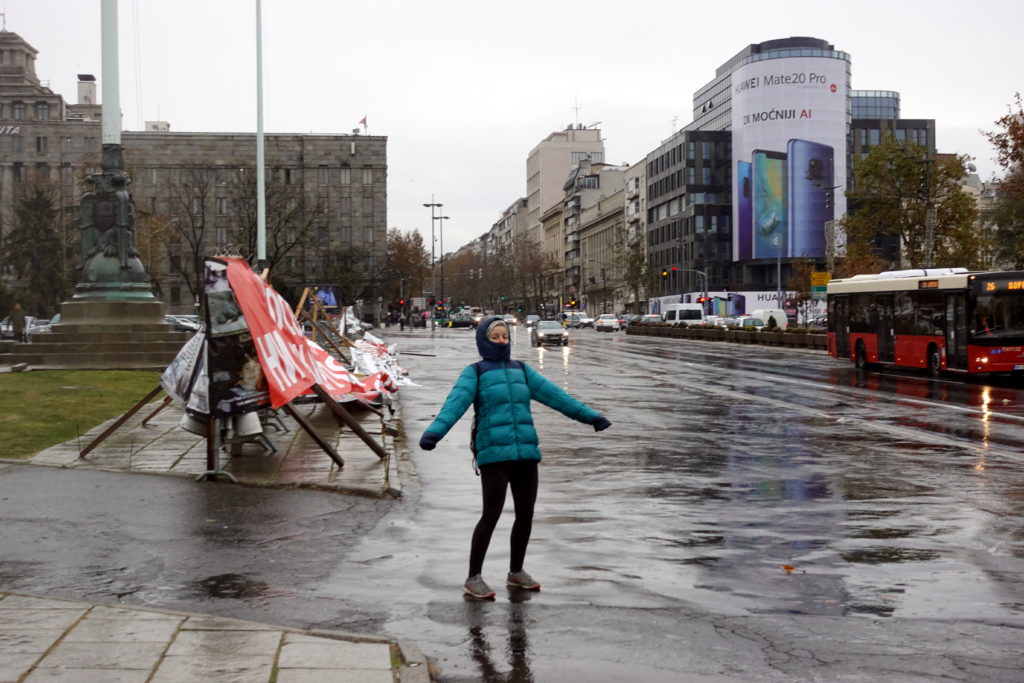
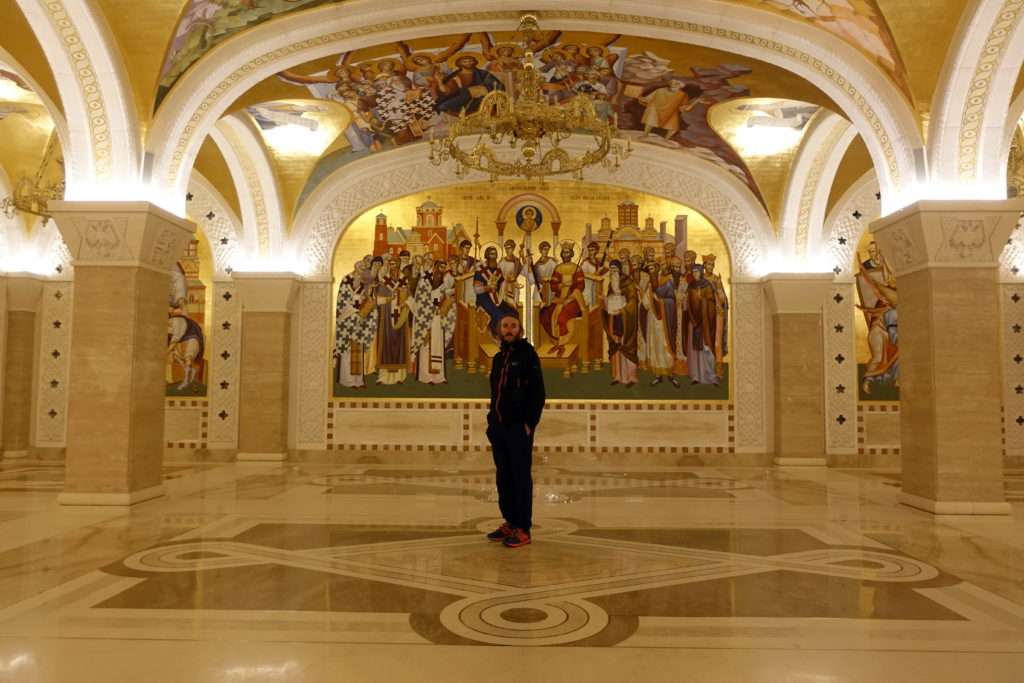
In the afternoon, we made our way back to the hotel and were surprised to find two other cyclists in our room: Corinne and Chris, who were also traveling on a Pino this year. As luck would have it, we have mutual friends in Augsburg and had been in contact with each other for the past few weeks, so we could finally meet. We were relatively close to each other in Kyrgyzstan, then we split – them going through Iran, we through the Caspian and the Caucasus, and even since Istanbul we had been playing cat and mouse throughout the Balkans – Cassie found her favorite French expression: chasse-patate! We finally found a way to join at the same place and same time in Belgrade, the (almost) final destination of their trip. The rest of the day, we exchanged stories of our travels over food and drink.
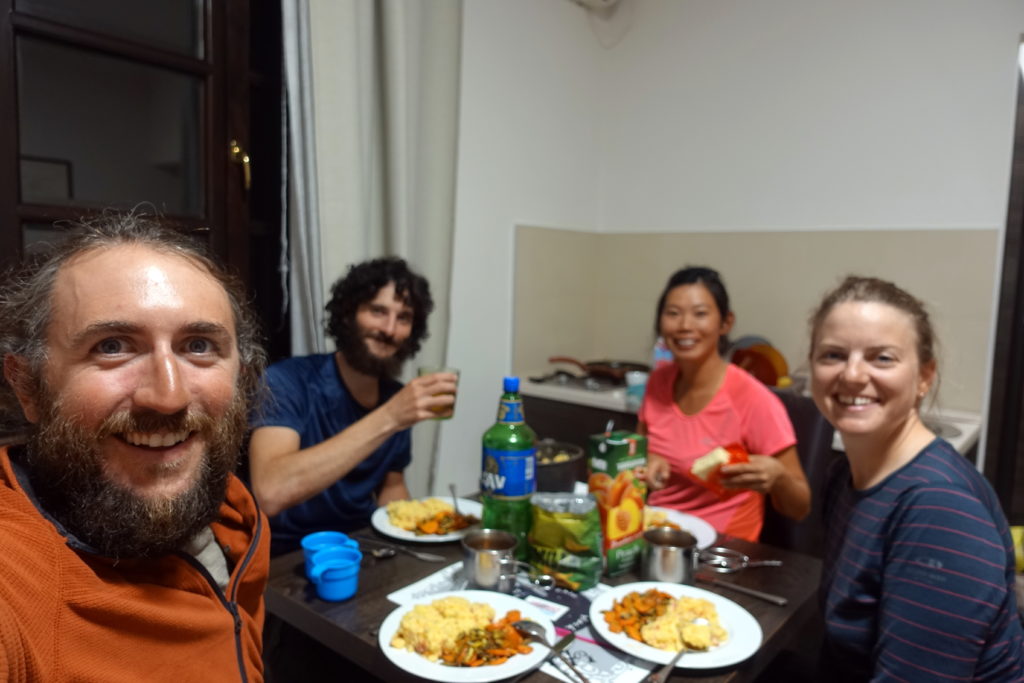
Everyone blurry but Cedric 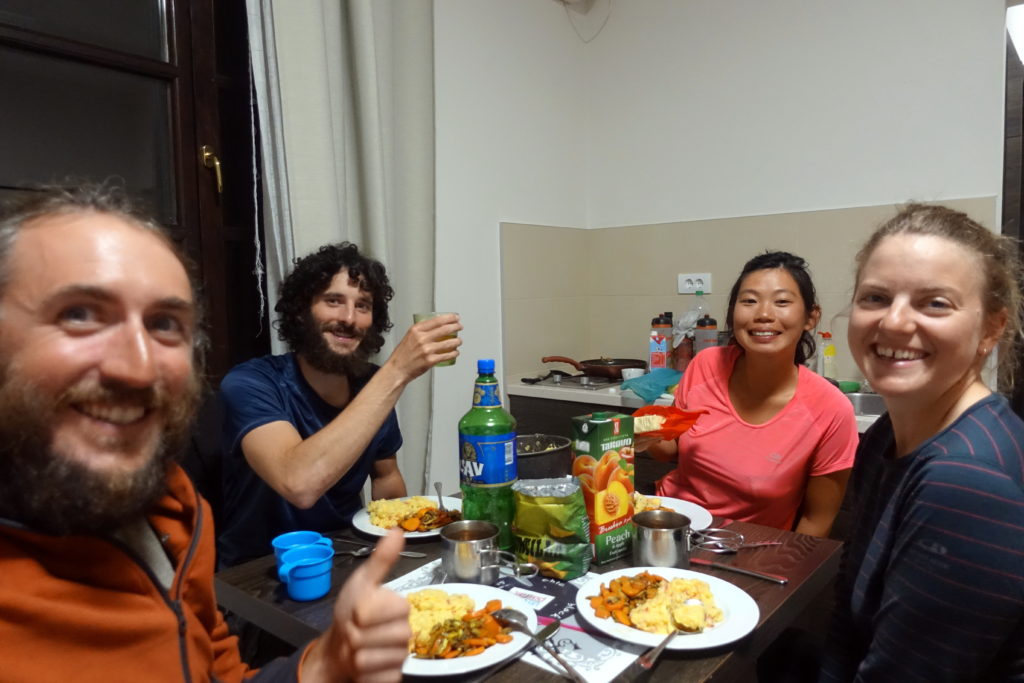
Everyone unblurred but Cedric
The next morning, Cédric and I said our goodbyes and headed north. Corinne and Chris, on the other hand, left to take a bus to Munich and were thus closer to ending their trip. Our day cycling on the road was a blur – with little opportunity for small roads, we joined the constant flow of traffic on a secondary road. The rolling showers and fog didn’t make the ride exciting either, so we cycled into Novi Sad with few breaks and arrived there early in the afternoon. After getting scammed finding an accommodation (a very poorly rated hotel presented themselves as being the owner of the highly rated place next door – and found out about it after paying the night – certain that given the reviews we would not need to check the room first like we used to do in Asia), we went around to discover this historical city and so for the remaining part of the day, we walked around the picturesque downtown. Unlike Belgrade with its plethora of communist-style architecture and busy industrial suburbs, the center of Novi Sad still has an abundance of regal 19th century and older buildings. Novi Sad being on the extreme north east of Serbia, it had been part of multiple other countries (Hungary until recently), and the influence of Austria and other central European powers is a lot more visible.
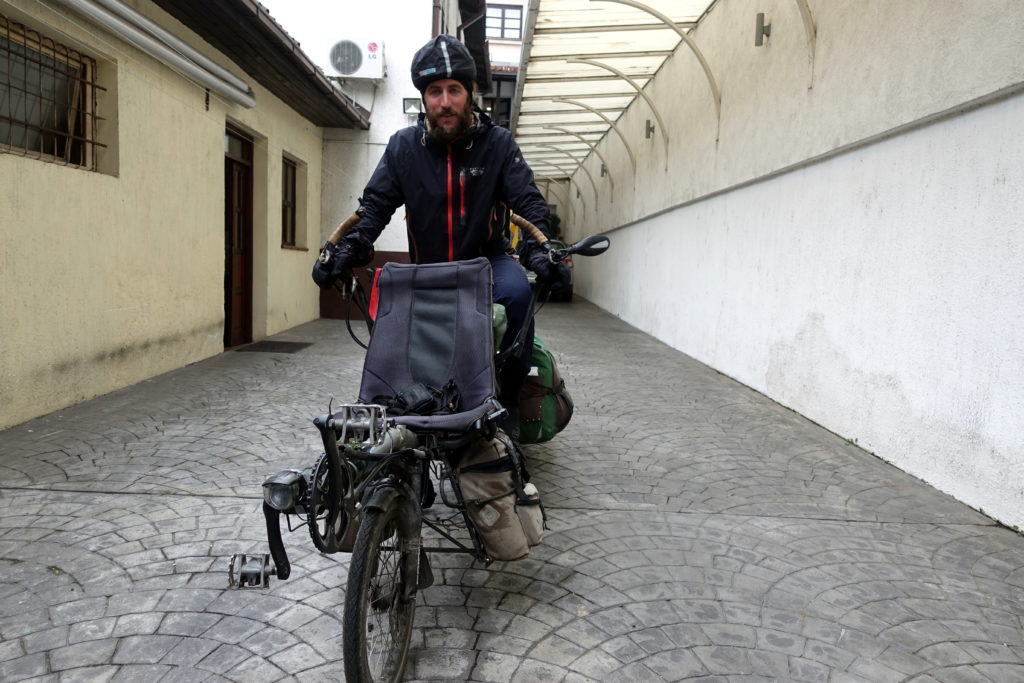
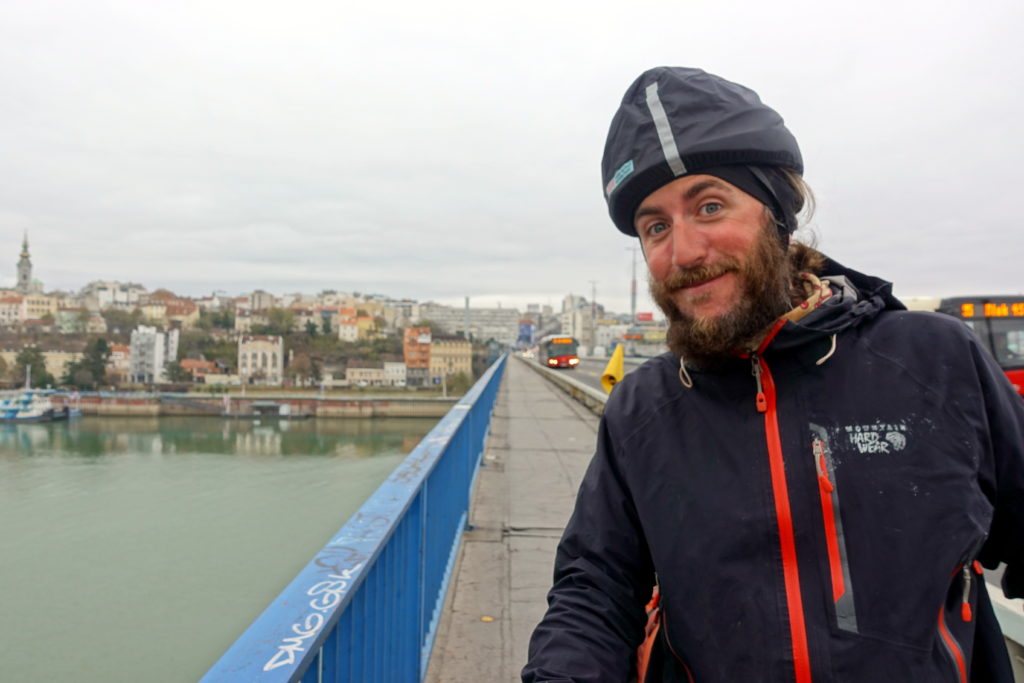
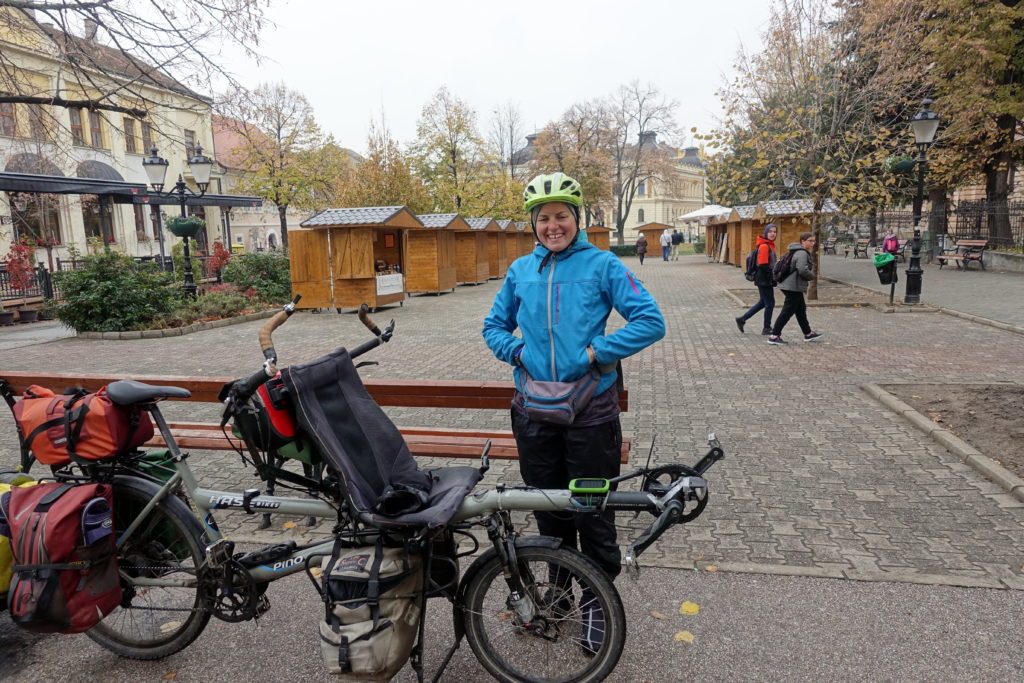
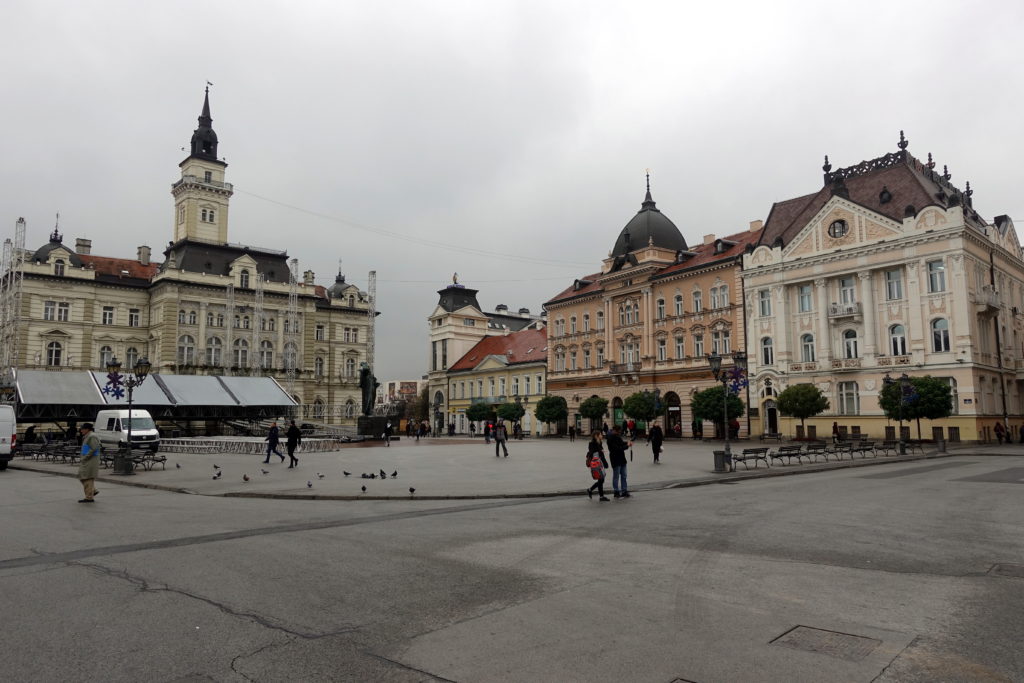
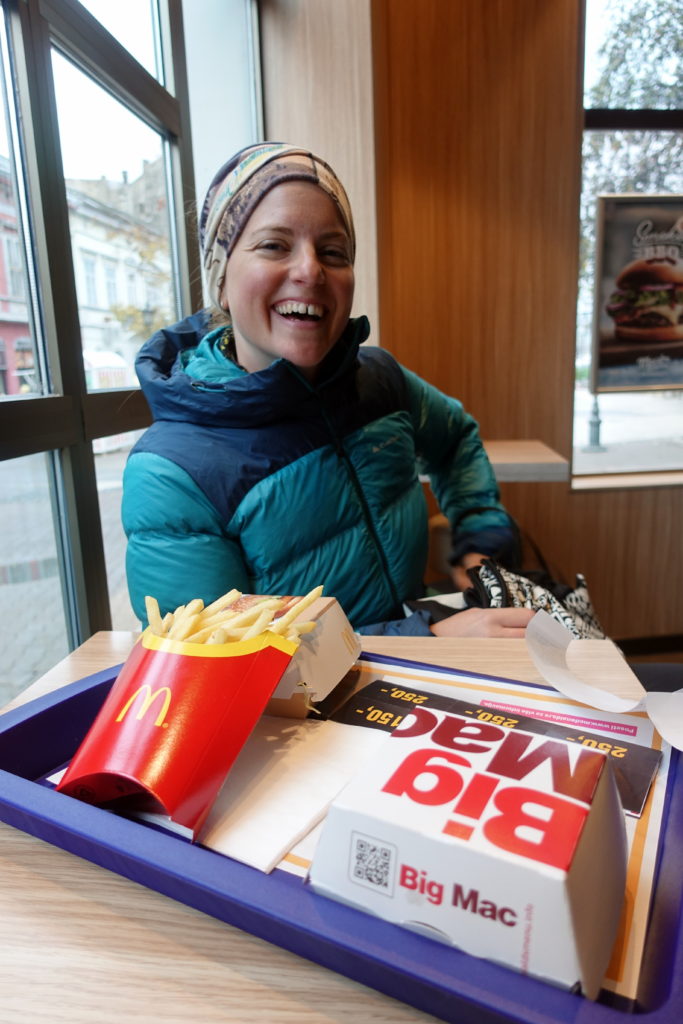

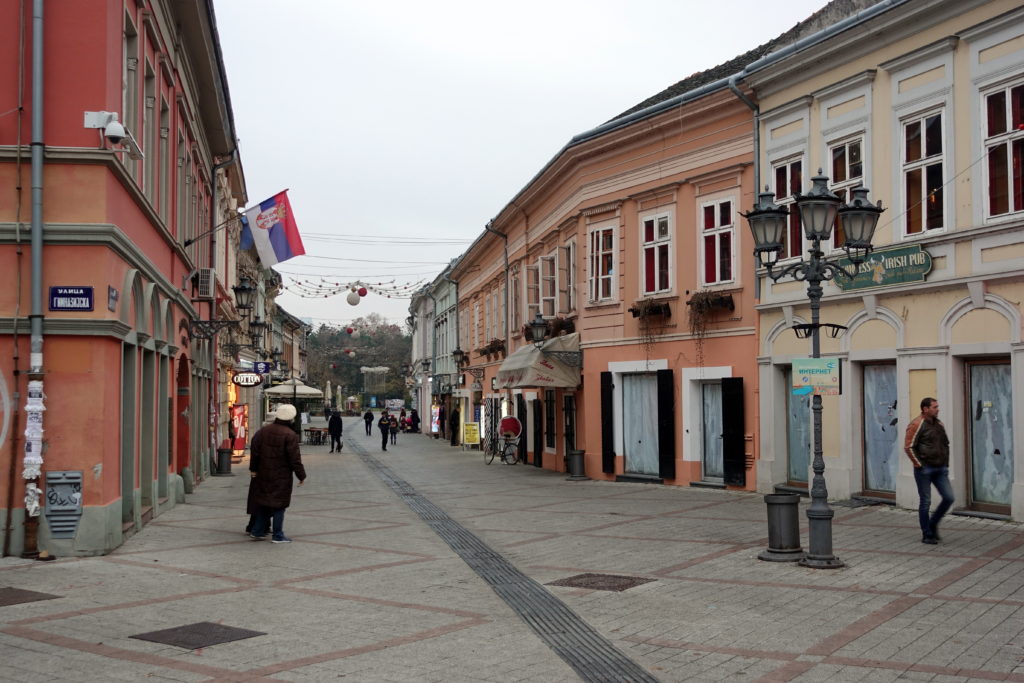
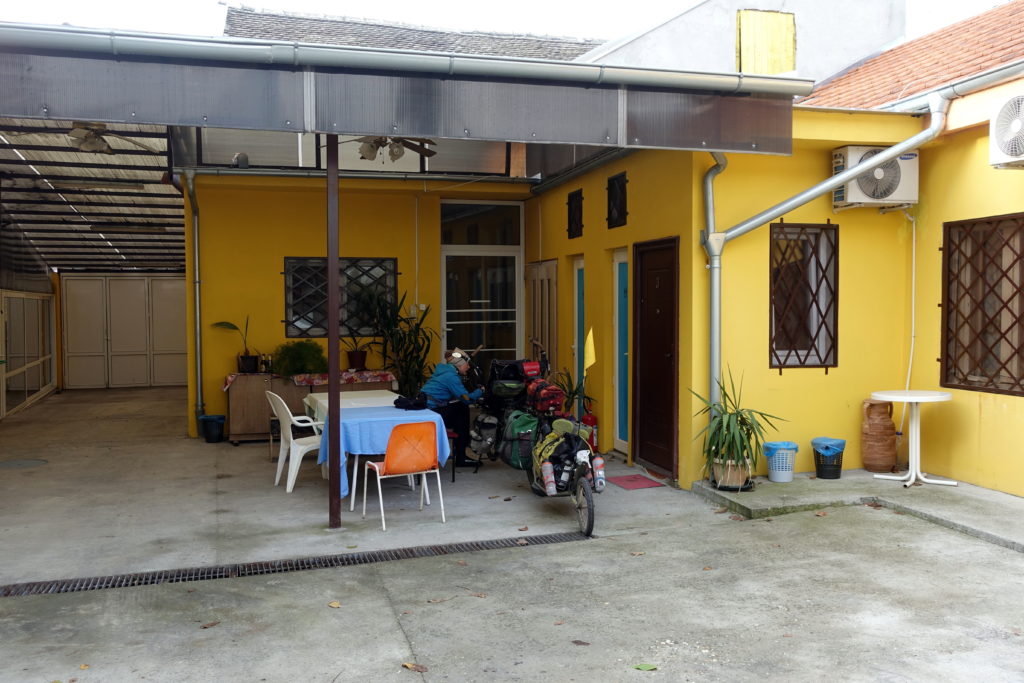
When we woke up the next day, it seemed like the bad weather was behind us (for now). We packed our things and decided to head for the Serbia-Croatia border. Cédric and I were getting tired of the traffic and the current hotel owners made us long for friendlier hosts – so we decided to give a different country a try. However, that first meant cycling with the traffic to Backa Palanka. For a kilometer or two outside of Novi Sad, we thought we found a newly paved bike path along the Danube (and the sight of a road cyclist made us hopeful), but the trail ended abruptly, so we pushed our bike back to the road. We got rid of our excess dinar (the Serbian currency) at the last supermarket and then crossed the Danube into Croatia. And just like that, the traffic disappeared. As we were riding through some small towns along river, we noticed that some houses were still riddled with bullet holes from the Croatian war of Independence. Many houses had a fresh coating of stucco, but some buildings bore scars as a testament to the war. Before finishing our day in Vukovar, we visited the military cemetery, which was another memorial to the war. Serbia is just across the river, and Serbians are not the souvenir of a good neighbor in here. The Balkans is now composed of many small countries that may look silly on a map, but the cultural difference is still significant – it is never sufficient for wars, but within a few kilometers we went from an industry-based Christian orthodox country to a Catholic wine growing touristic region.
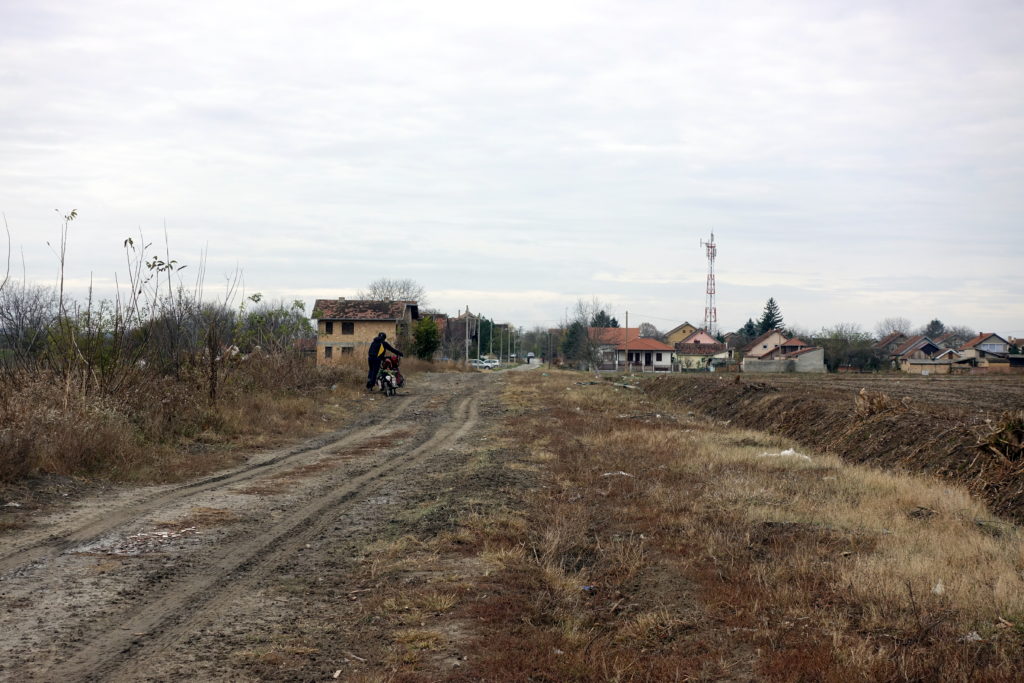
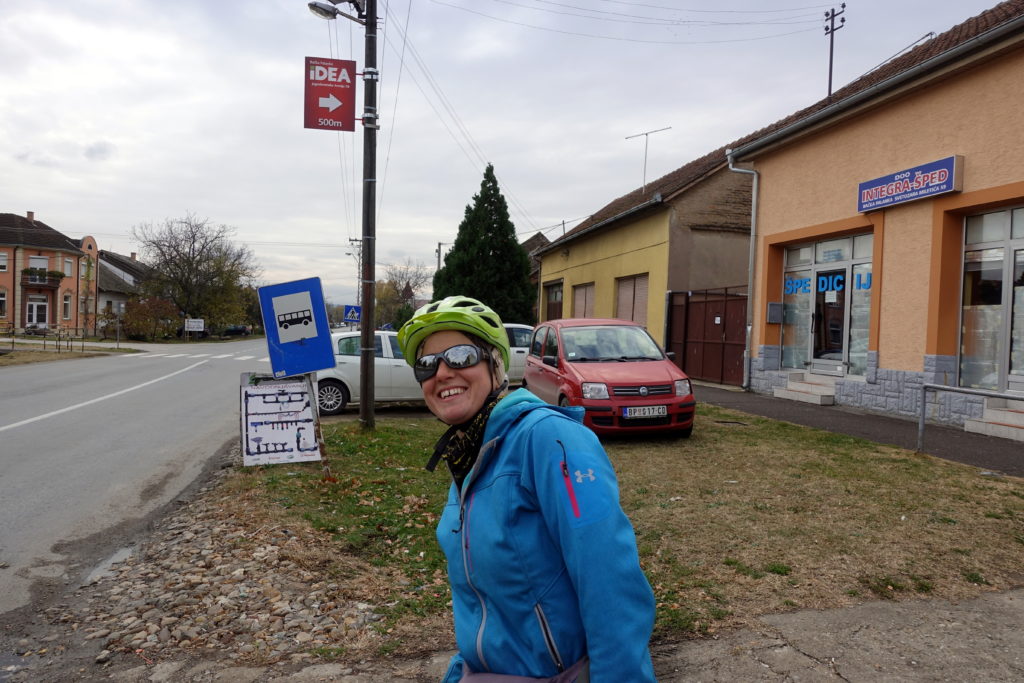
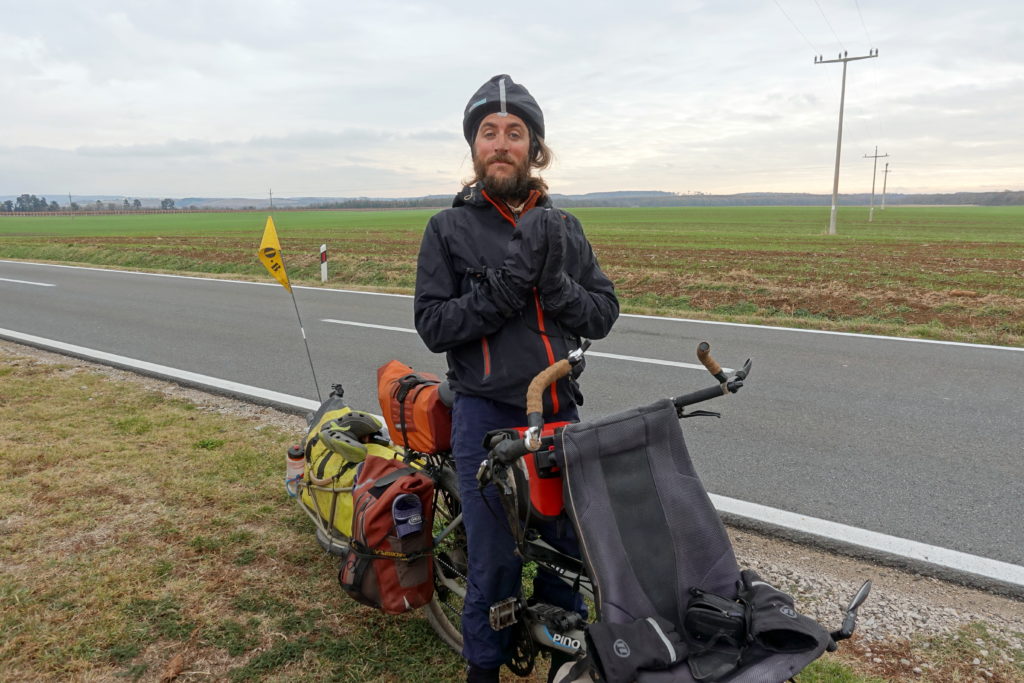
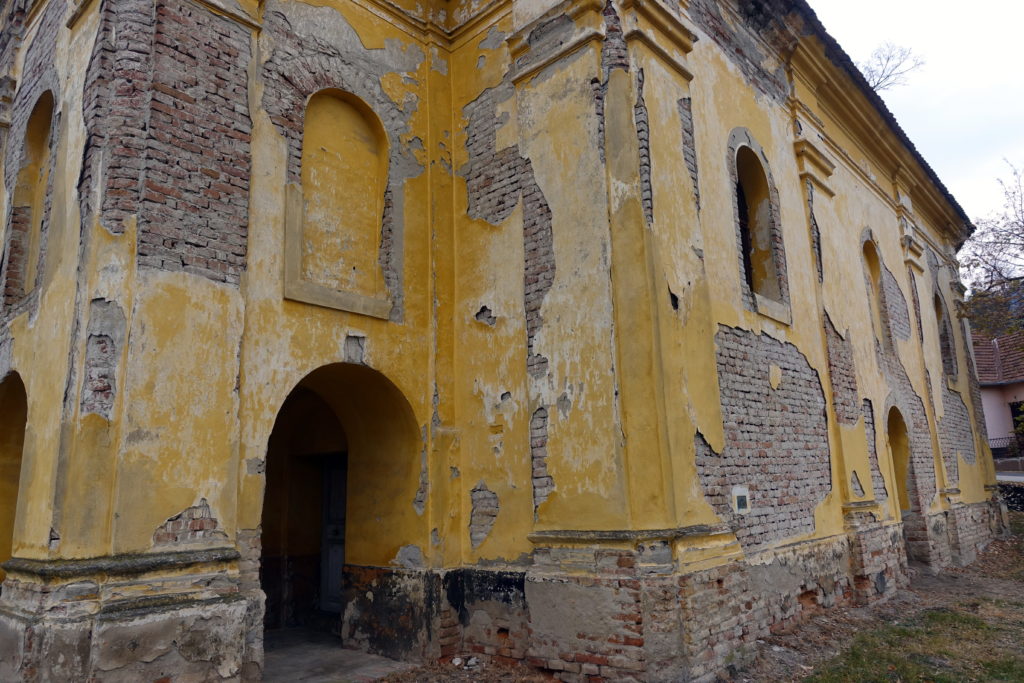
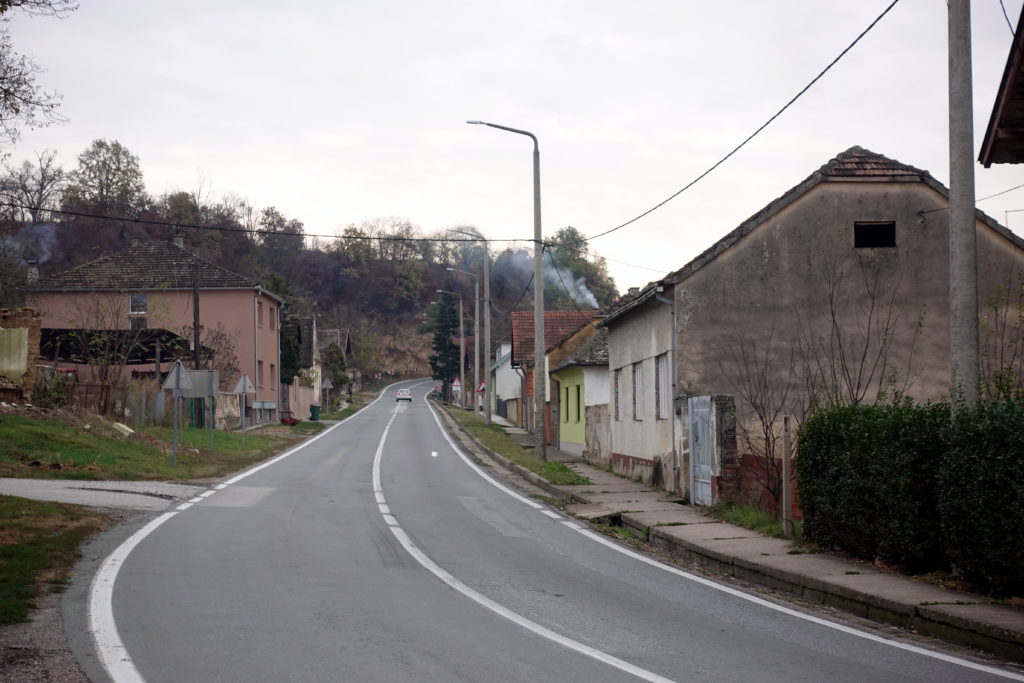
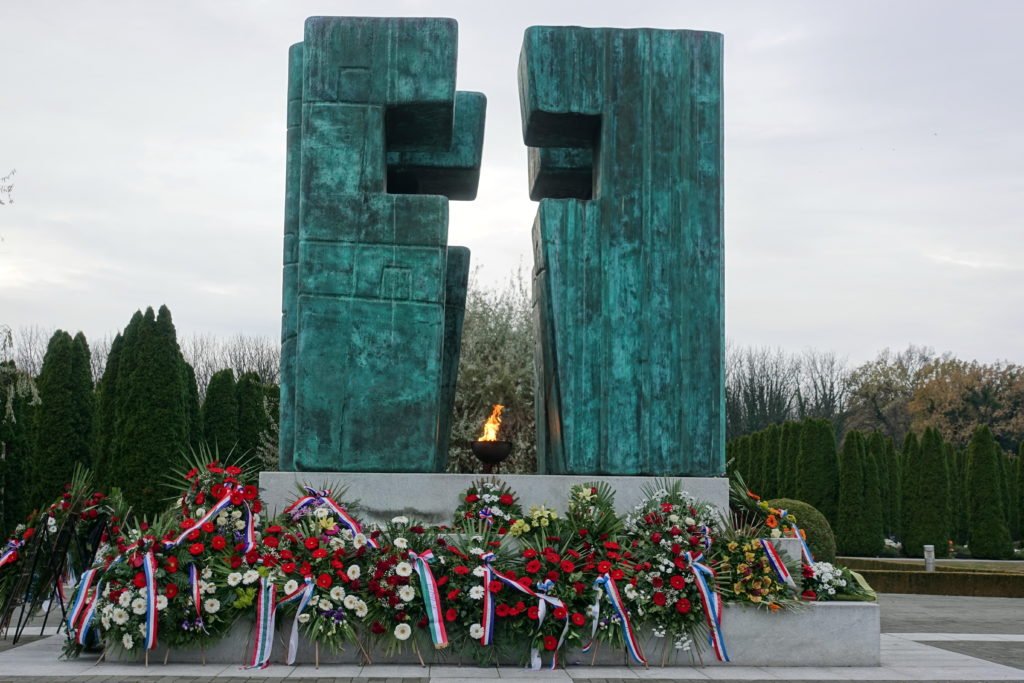
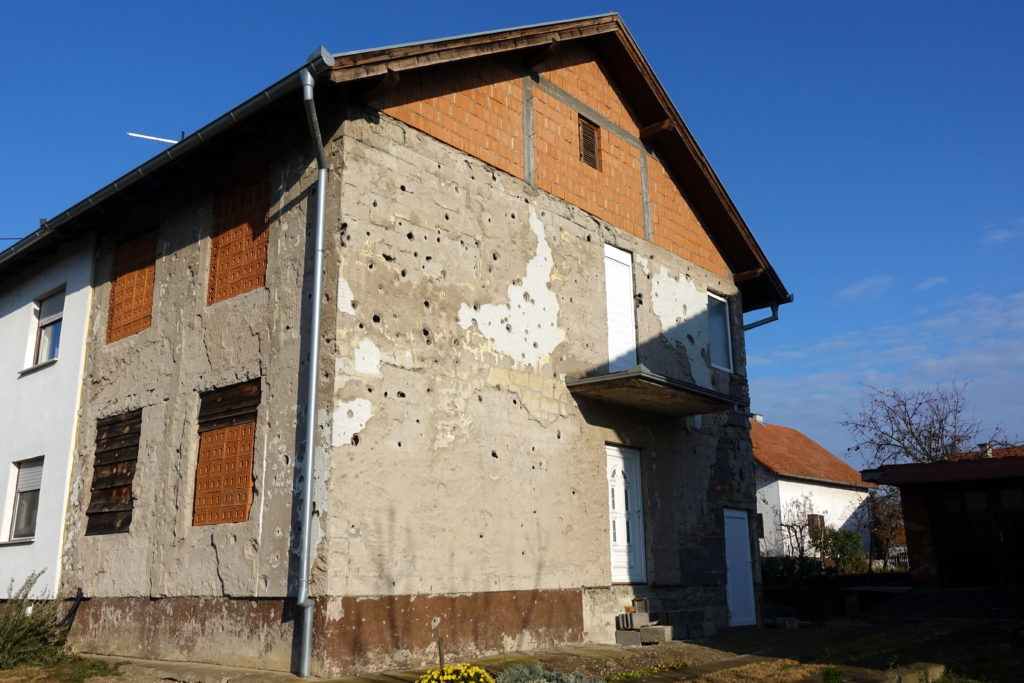
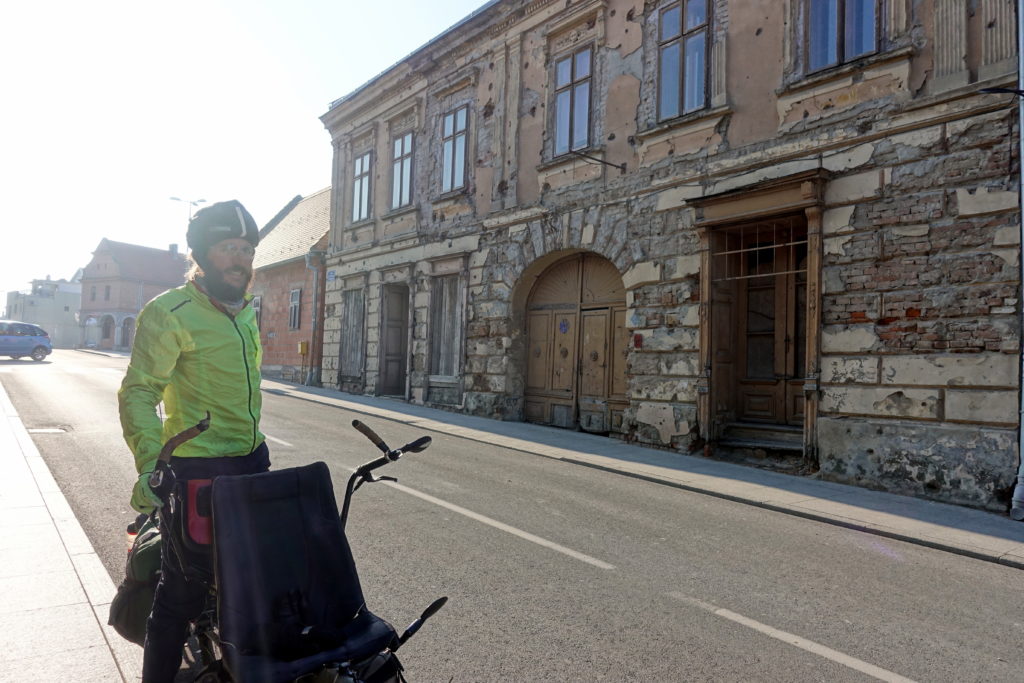
The next morning, we left Vukovar with brilliant blue skies and continued our journey north. Again, without many other options, we had to join a larger, more trafficked road on our way into Osijek. When we cycled into the city, we were greeted by bike lanes (they’re becoming more prevalent to more north we go) and stopped in the Tvrda, an old 18th century fortress built by the Hapsburg Empire. Heading west down the main street, we were surprised to see multiple Art Nouveau buildings lining the streets – coming from places with cheap, new construction projects, cinderblock houses, or soviet-style apartment buildings, this immediately gave us the feeling of being in Western Europe. We wandered around the downtown to look for a lunch spot, and finally found a boat restaurant on the shores of the Drava river. In the afternoon, we cycled through small villages and farmland to get to Valpovo, where we called it a day.
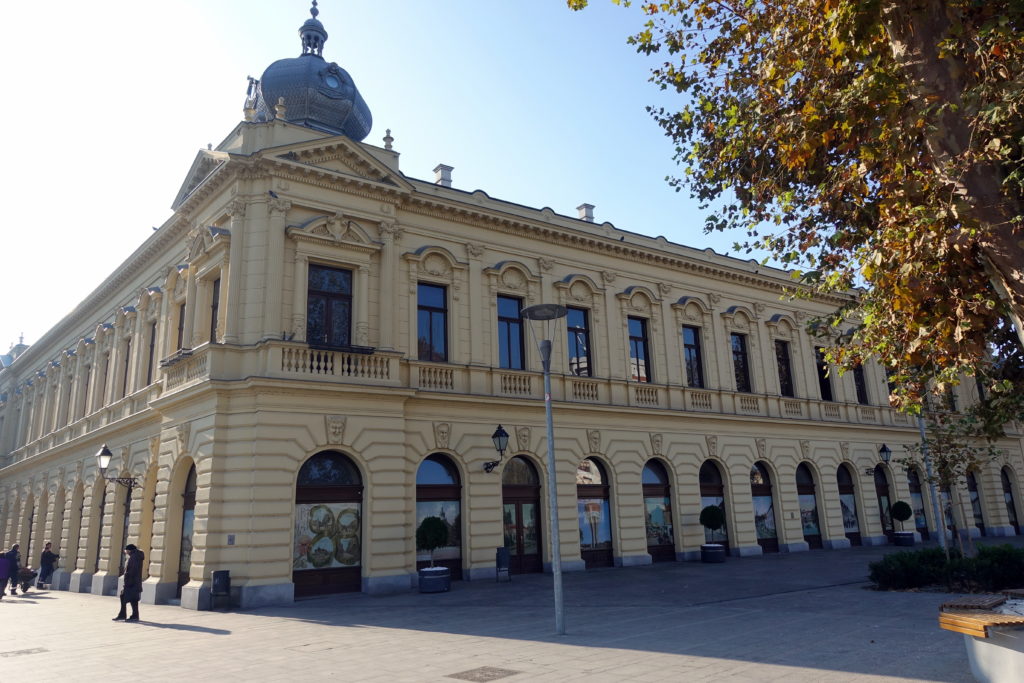
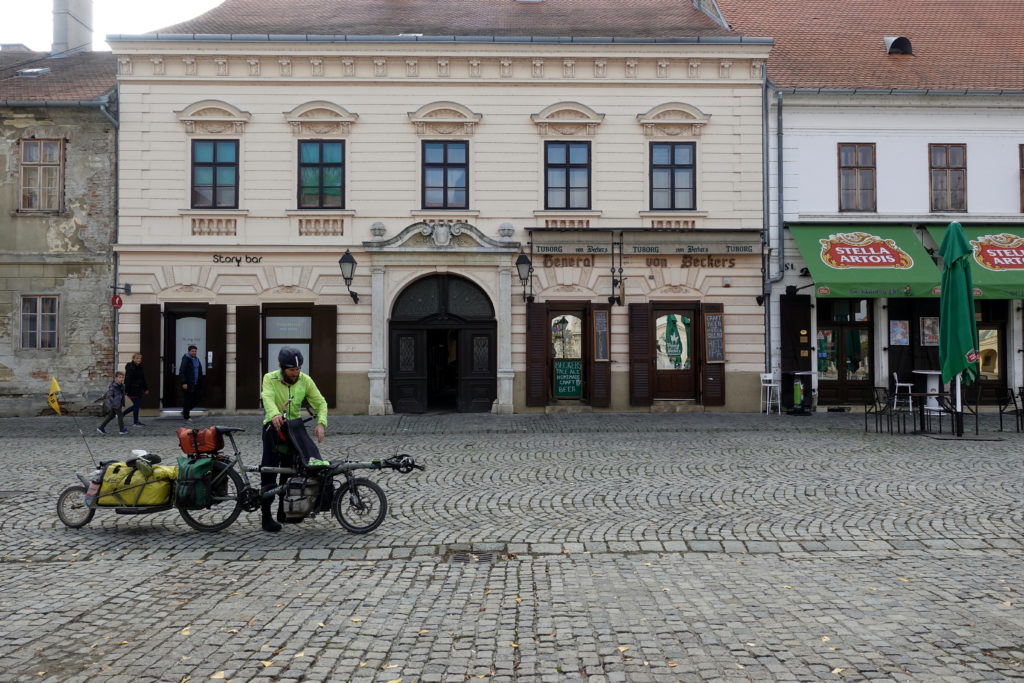
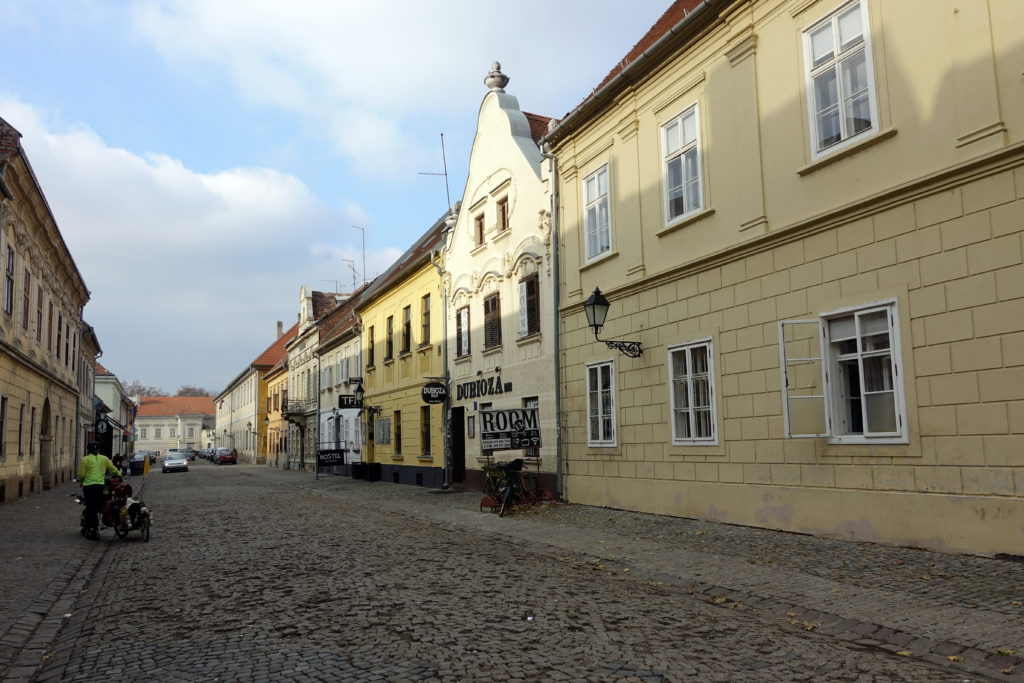
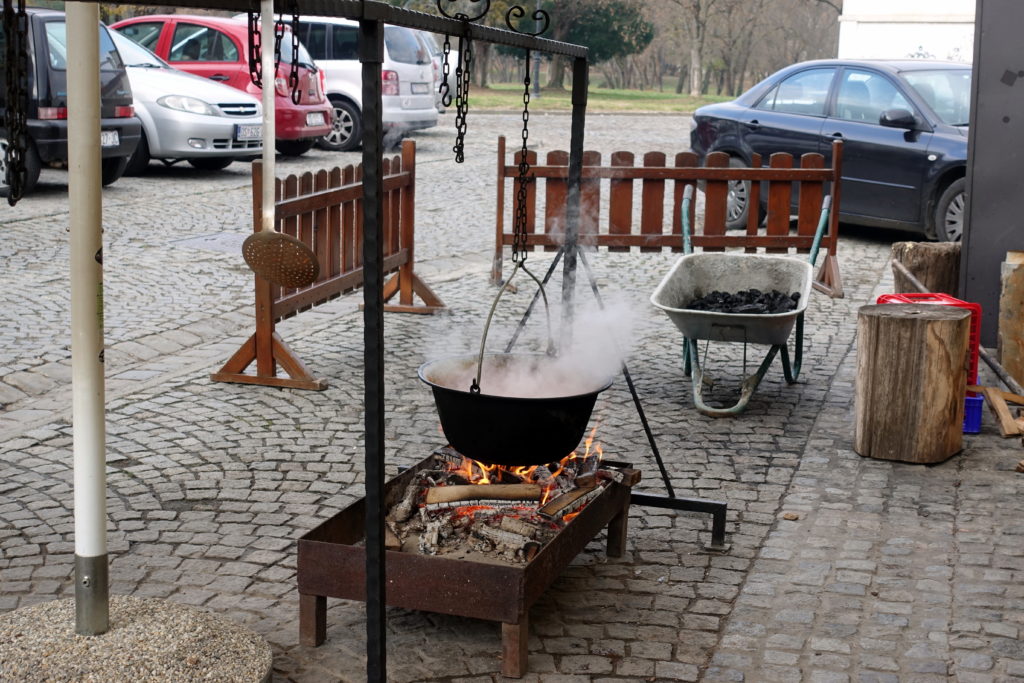
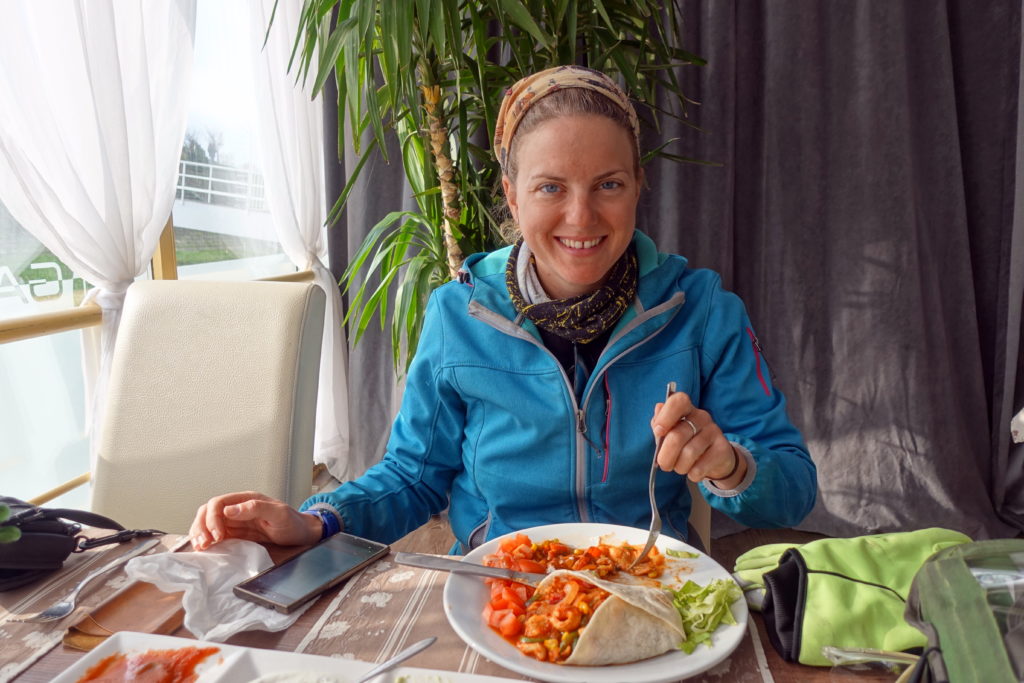
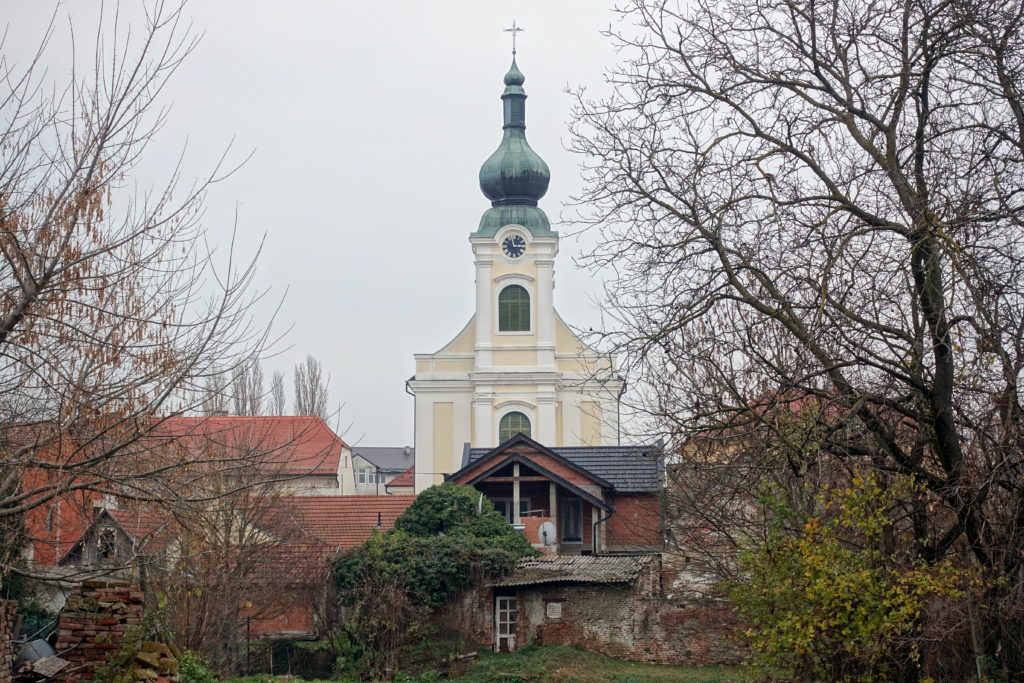
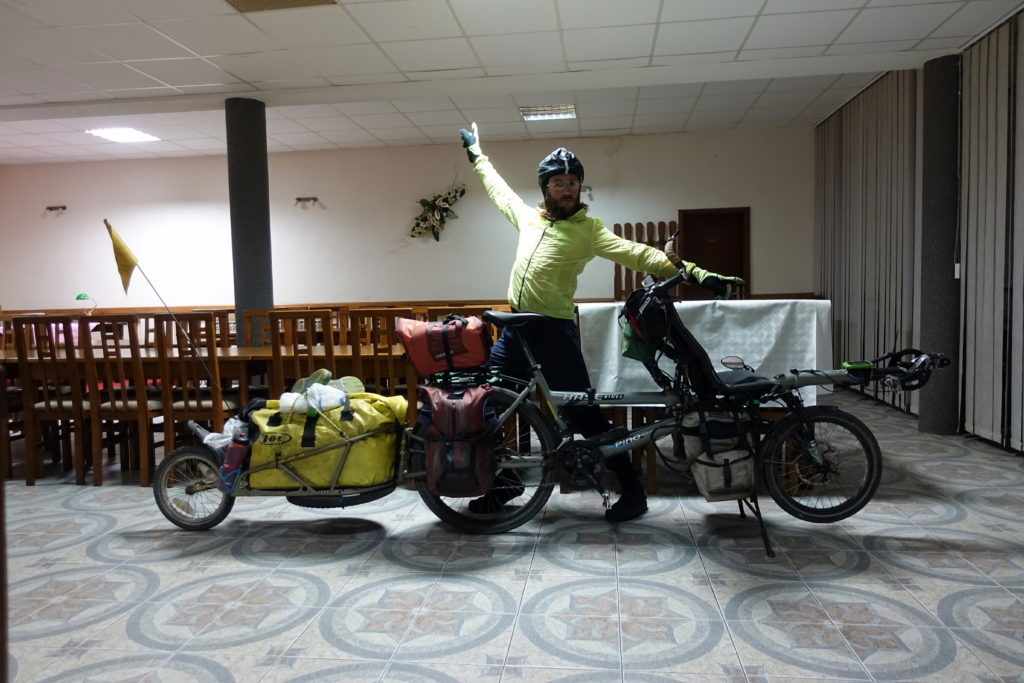
By the time we packed our bike the next morning, we noticed that the gray clouds were promising rain for our ride. Our plan for the day was to cross the Croatia-Hungary border and ride towards Pécs. Leaving Valpovo around 9am, we crossed the Drava River and continued north to the border town. The Hungarian border, with its new fencing and barbed wire, flanked us to the left and was a reminder of Hungary’s harsh stance against refugees and migrants. Shortly before the border, we met a few guys who where slaughtering and smoking a pig and offered us a few shots of their homemade schnapps, but we didn’t feel quite up for drinking at 10:30 in the morning. Just as we crossed the border into Hungary, it started to sprinkle and didn’t let up. We rode through small picturesque villages with their rows of wine houses and the wine bars in Villany. This would have been a perfect area to explore on a summer day, but we were determined to find a dry room in Pécs, so we continued cycling. When we arrived in the afternoon, Cédric and I dropped off our soaking wet bags and went out to explore the city while there was still some daylight. We had a bit of luck and the rain stopped just as we arrived in the city. Many downtown buildings were built at the turn of the 20th century and exhibit a neo-baroque style, but there are other vestiges of former periods and rule of other Empires, like a mosque-turned-church built during the Ottoman occupation and church foundations built during the Roman Empire. Our first reaction was that cities in Europe are definitely the most beautiful, sorry the rest of the world (okay, other countries or continents have other good things)!
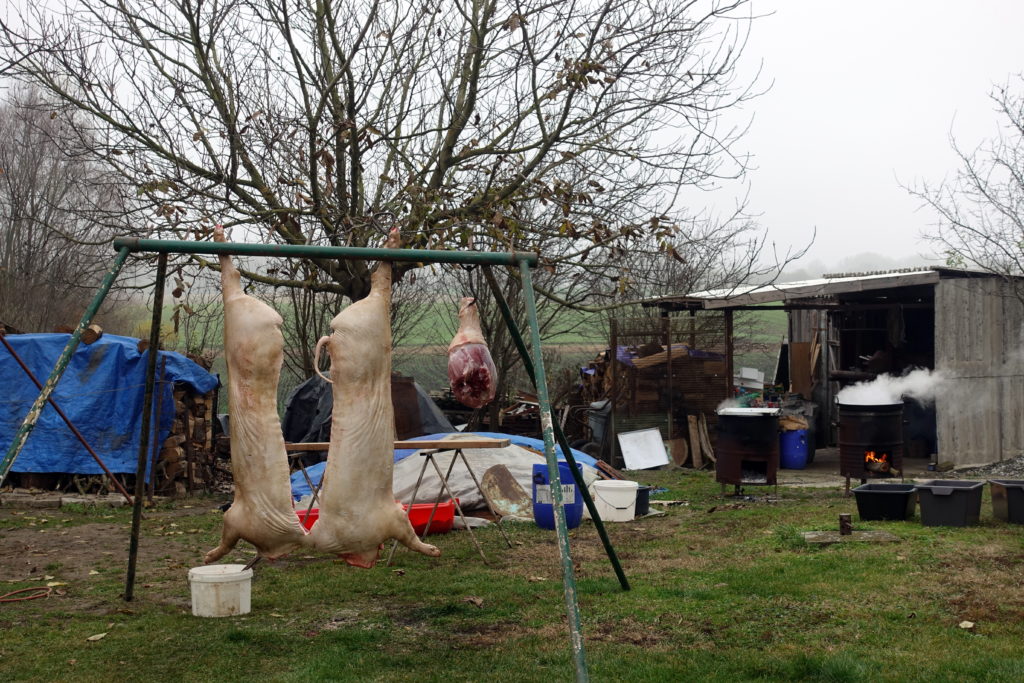
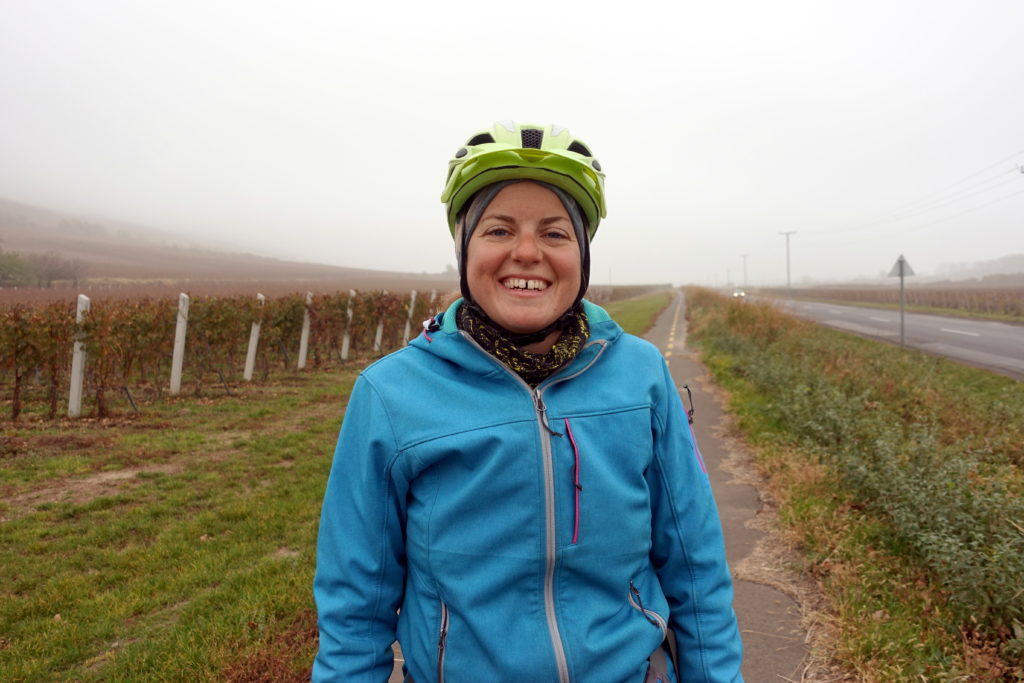
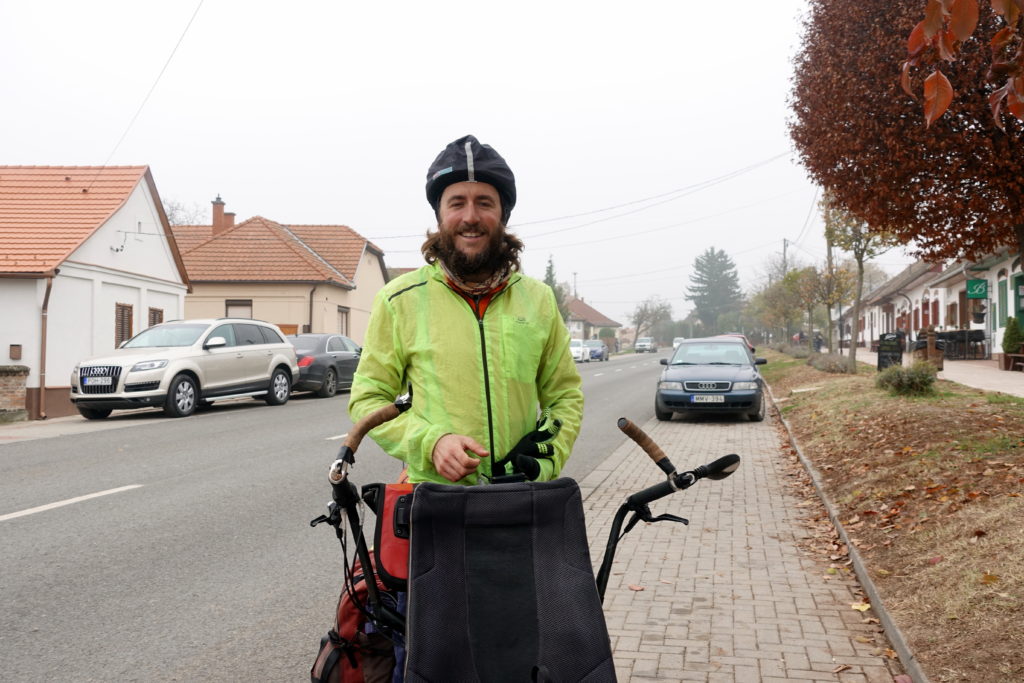
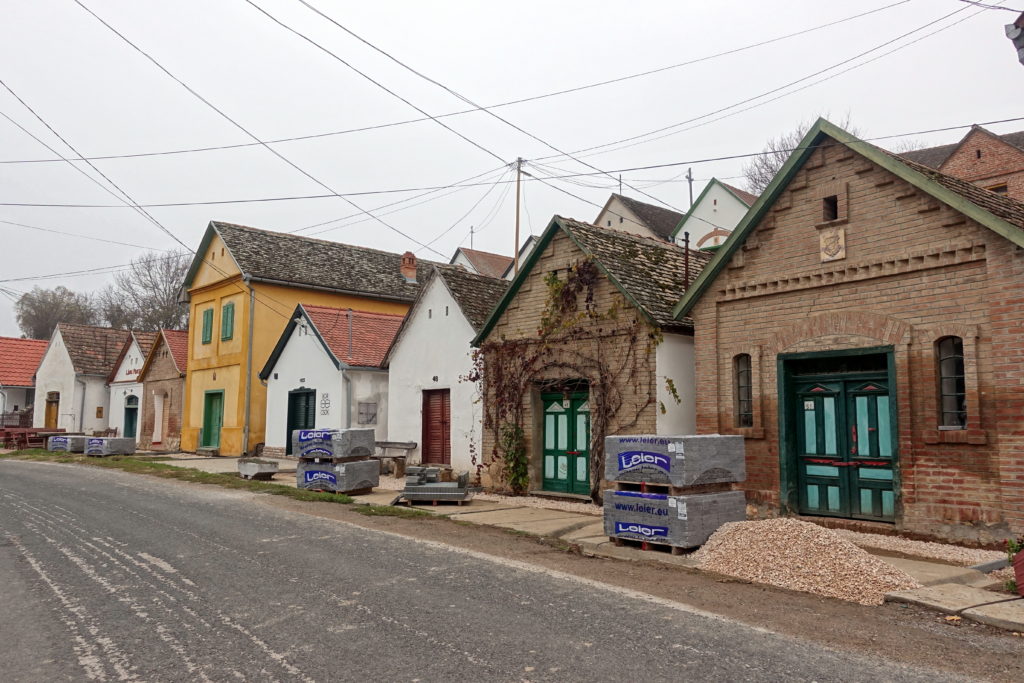
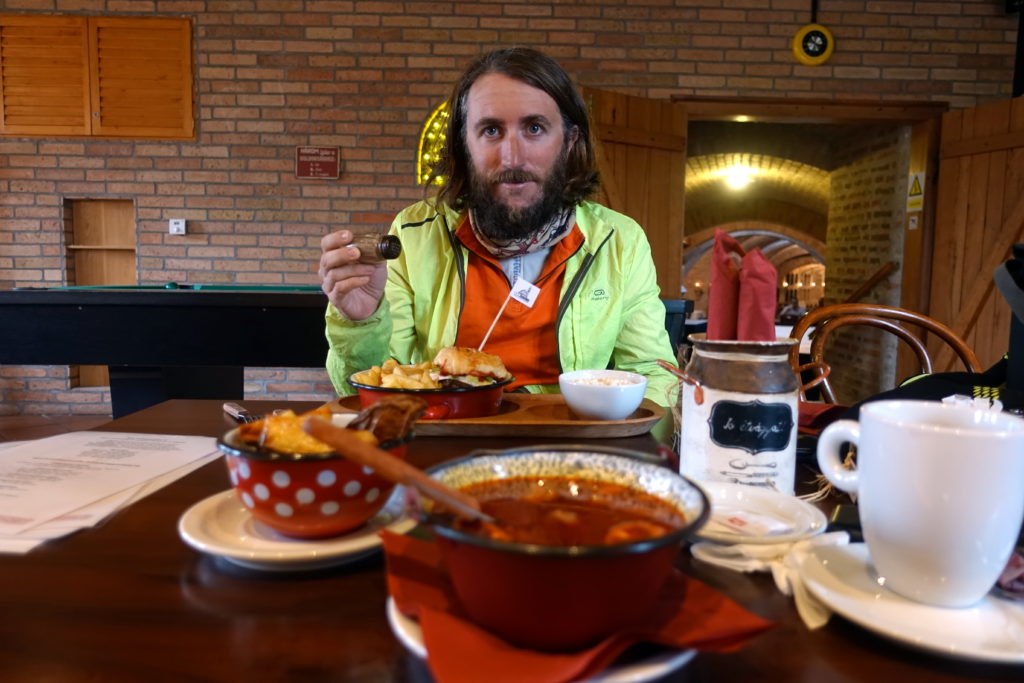
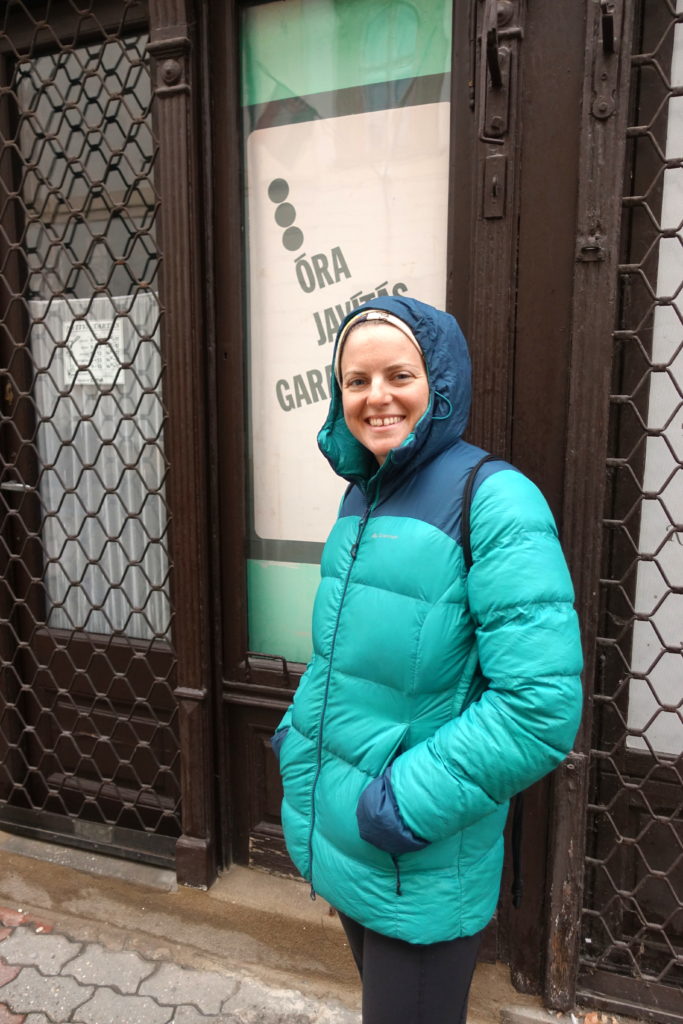
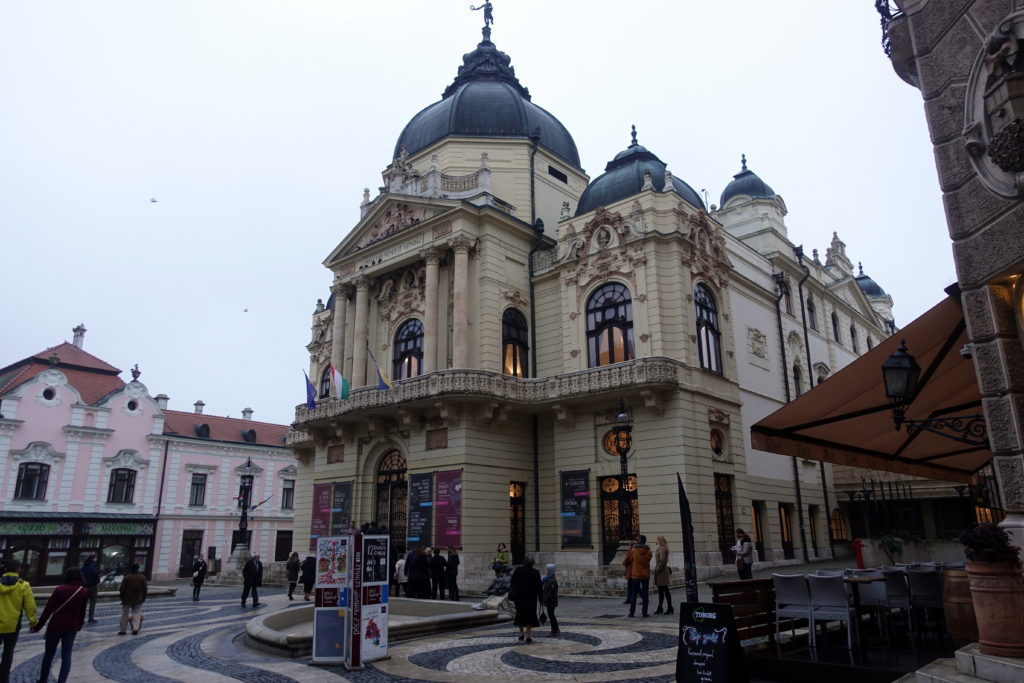
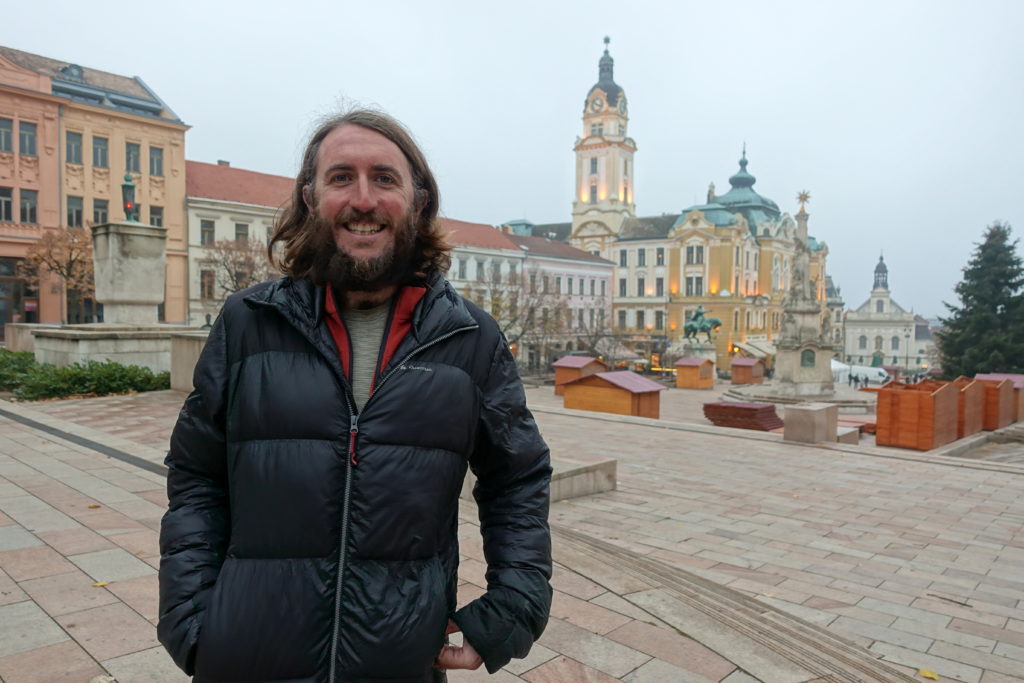
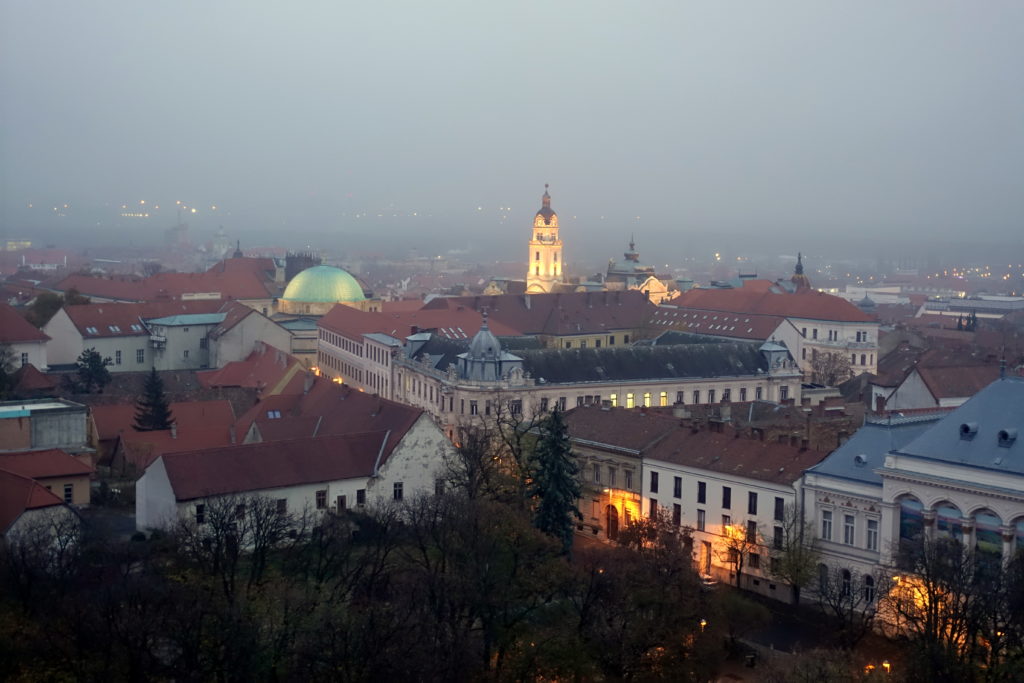
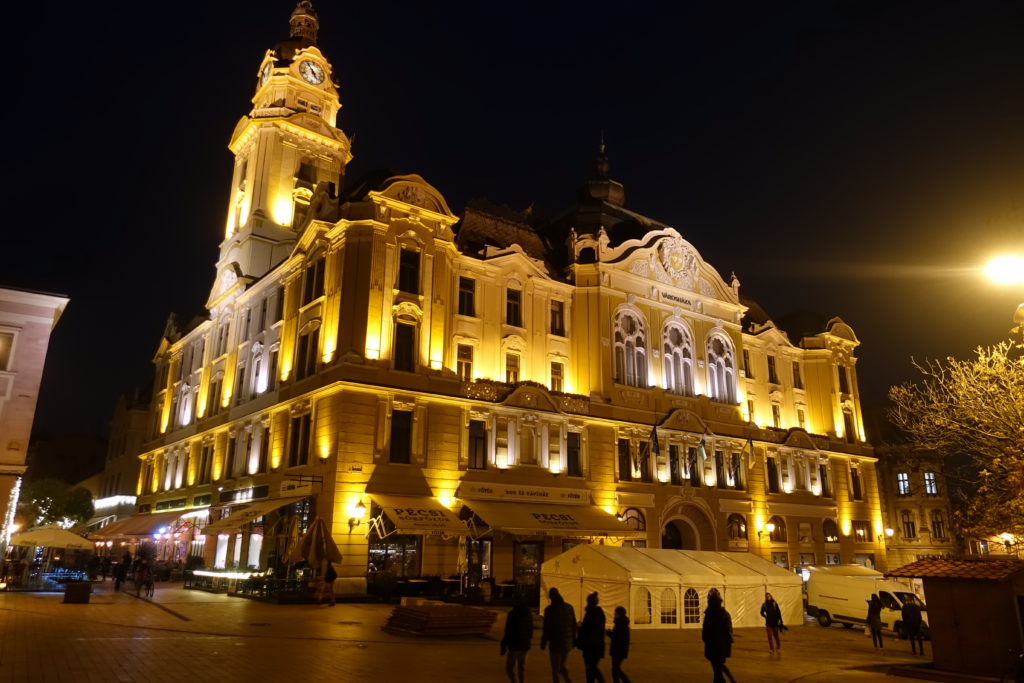
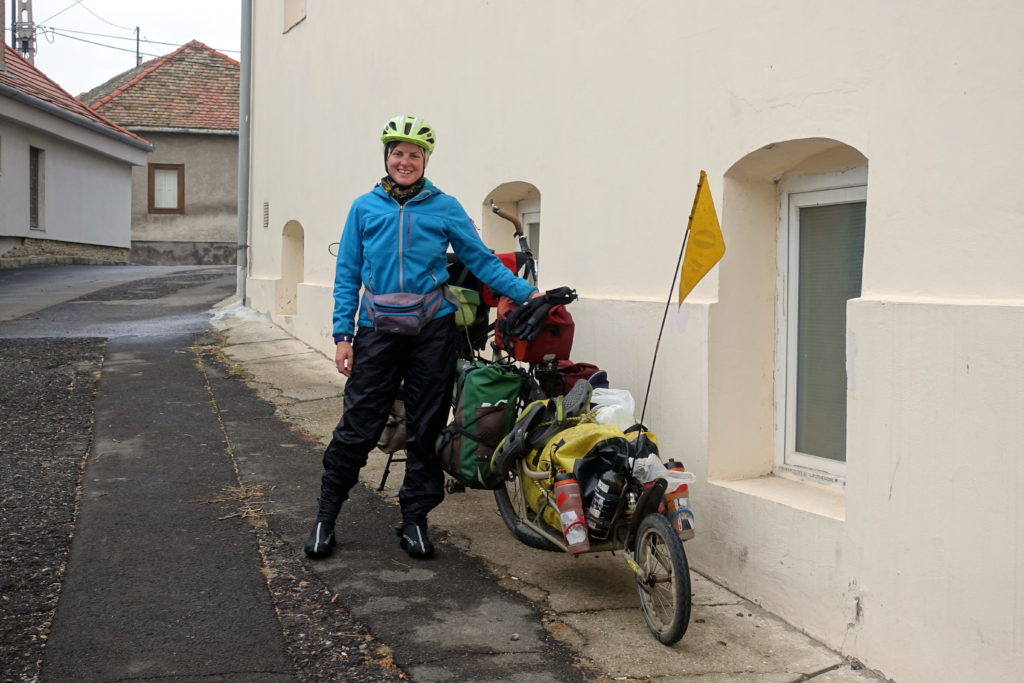
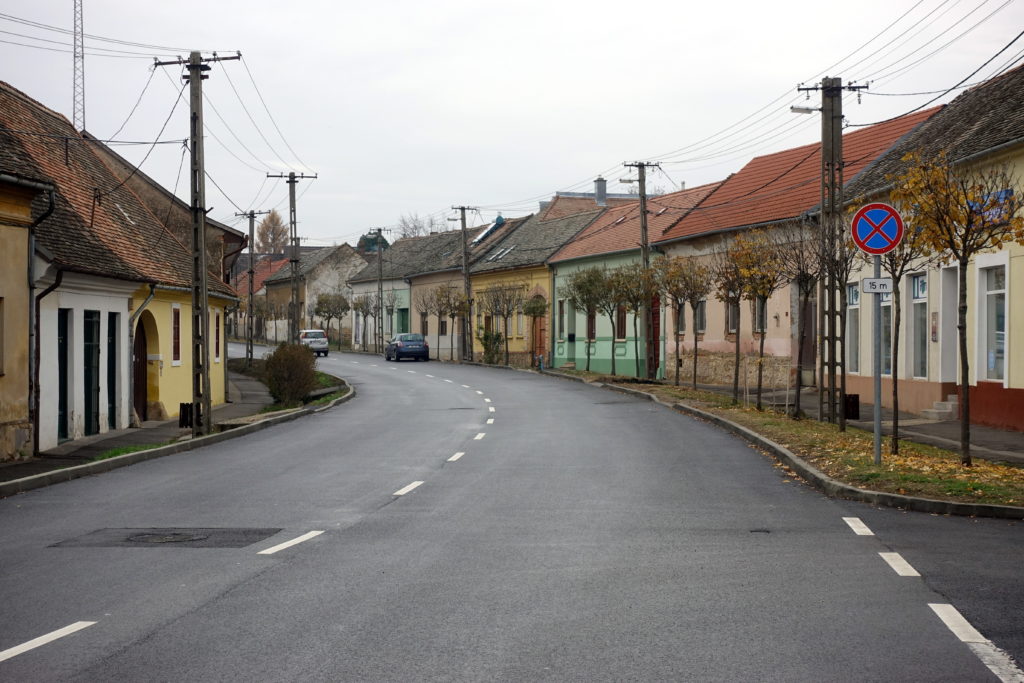
The next morning, the bits of the sun were poking through the clouds, and we were thinking that we’d have an enjoyable ride into Szekszárd. Due to the rain from the previous day, Cédric diligently oiled our gears and chain, but we discovered that the lubrication exacerbated a growing problem with our drivetrain: one of the chainrings was so worn down that the greasy chain would just slip over the teeth. This is a big problem because only one person is transmitting the force to move our iron horse. After 45 minutes of unsuccessful meddling, we managed to set things right with a well-placed zip-tie putting more tension on the chain and thus sticking it onto the chainring.
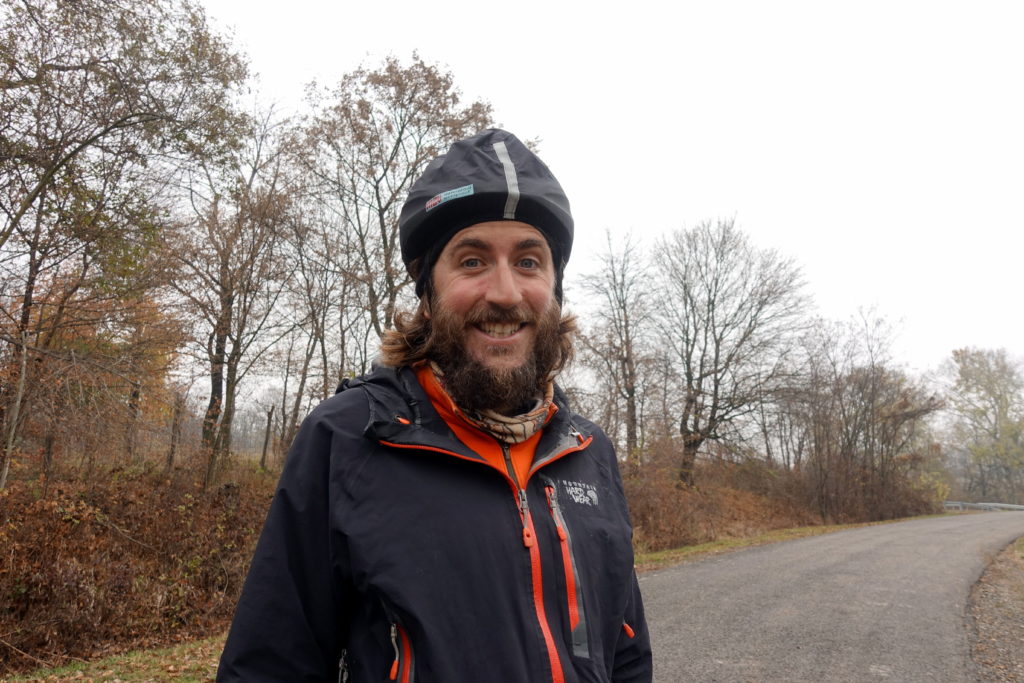
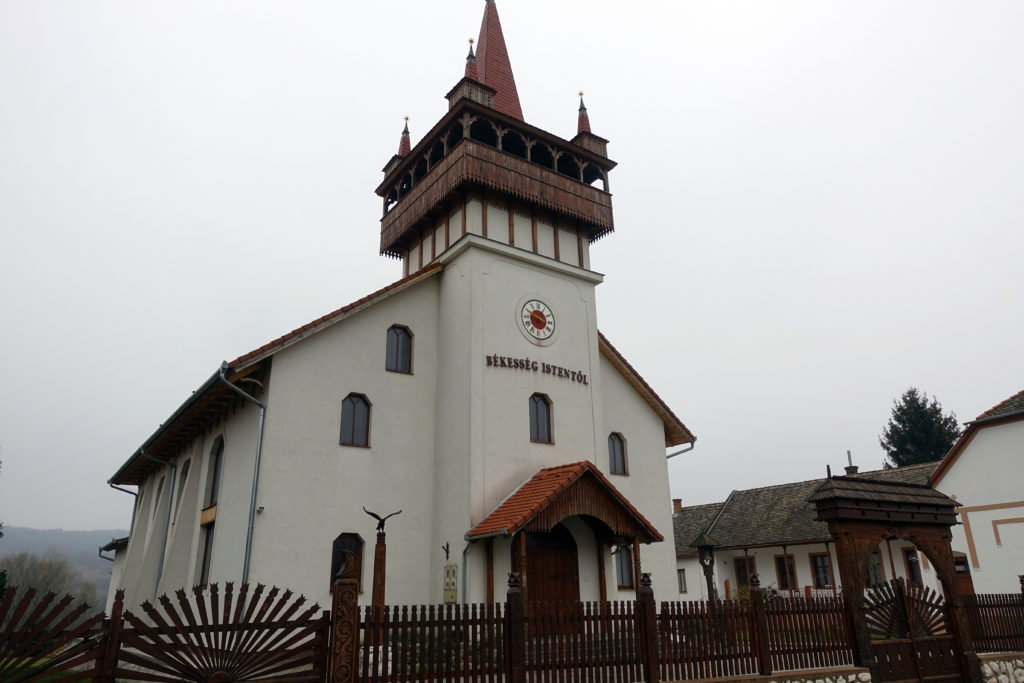
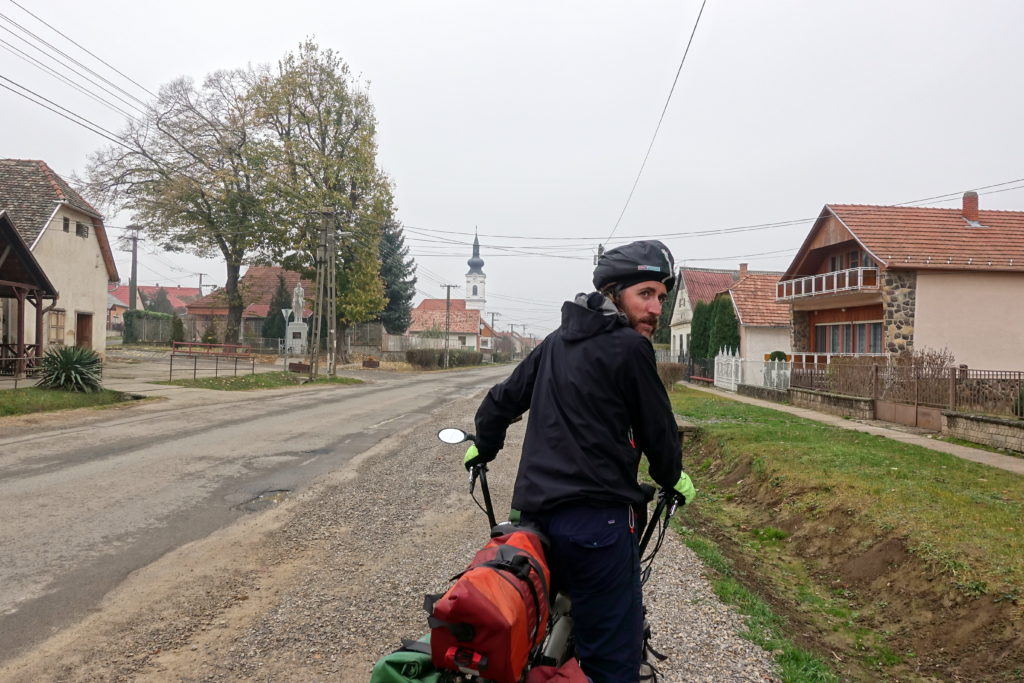
Upon leaving Pécs, we followed some hilly secondary roads north. Hungary is also the first country in Europe where we saw ‘No bicycle’ signs on the more-trafficked roads (which is probably a good thing, as those roads mean in Hungary that there is a quiet alternative nearby), but this meant that we spent the day swerving through the hills to stay on the correct roads. Hungary was also the first country where we met many people cycling as a hobby or sports – after all countries we visited, doing (and no watching!) sports is apparently mostly a western countries thing. Around lunch time, the heavens once again opened up and we were rained on the rest of the day. Towards the end of the day, we arrived in Szekszárd in a downpour and were happy to find our warm apartment for the night.
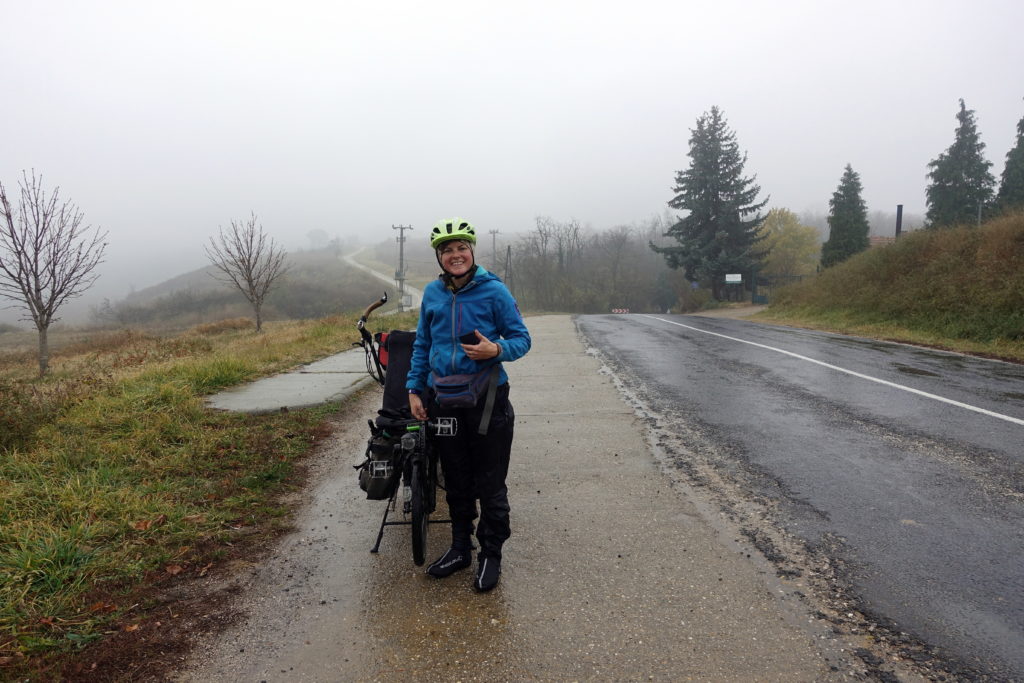
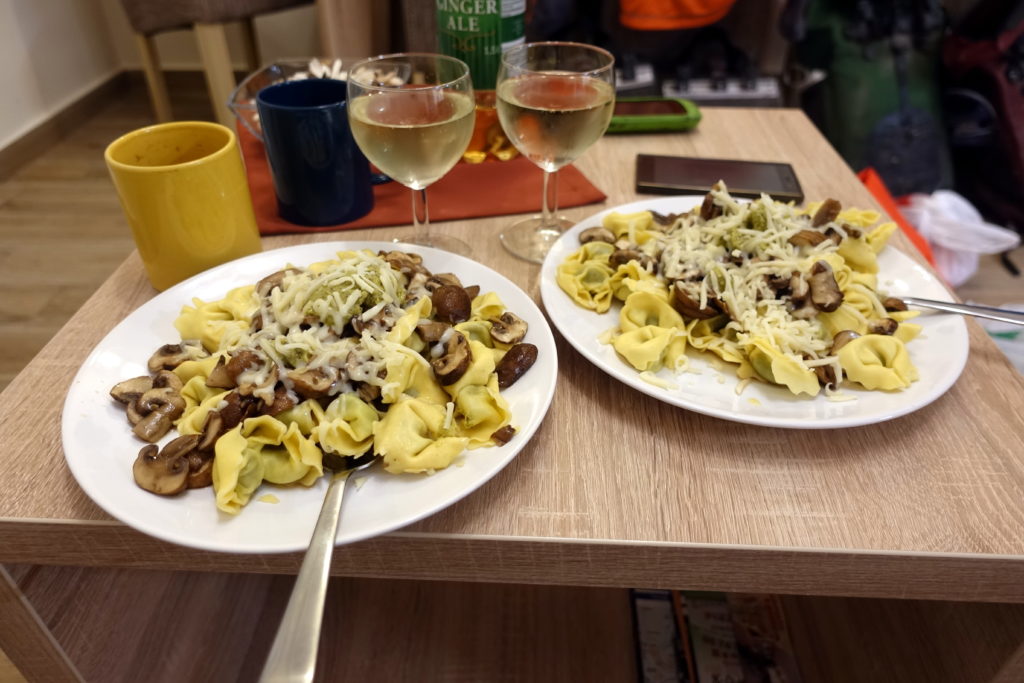
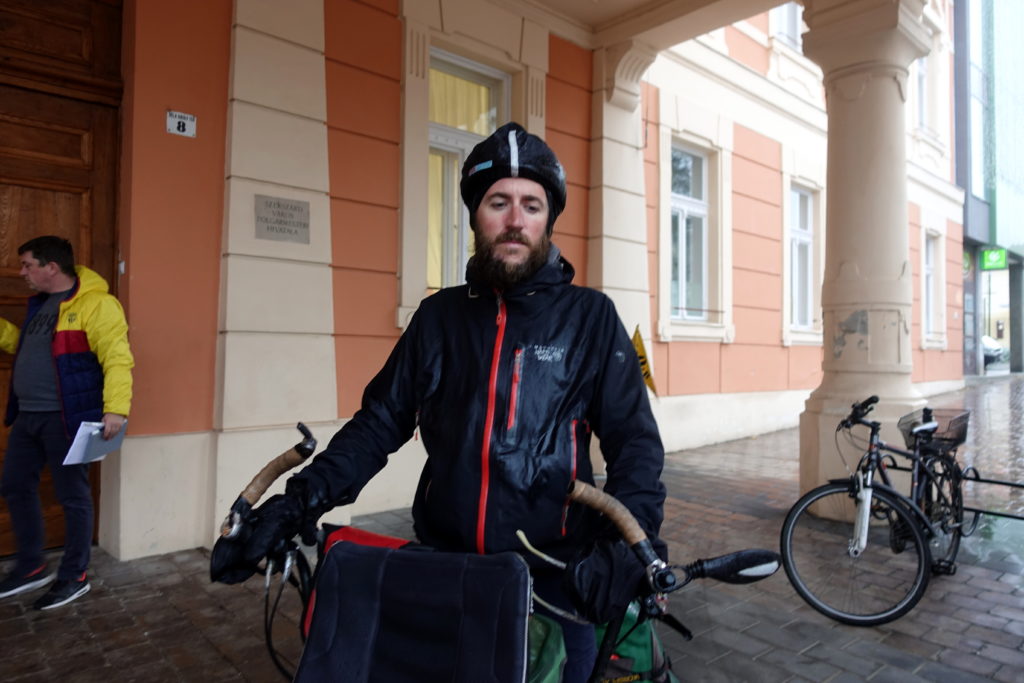
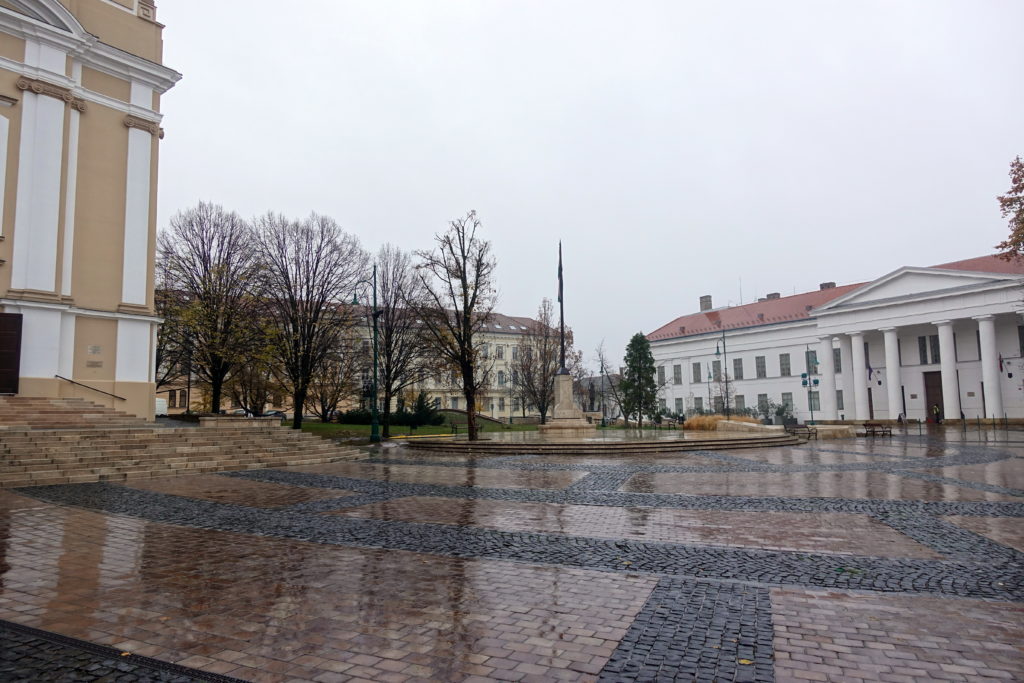
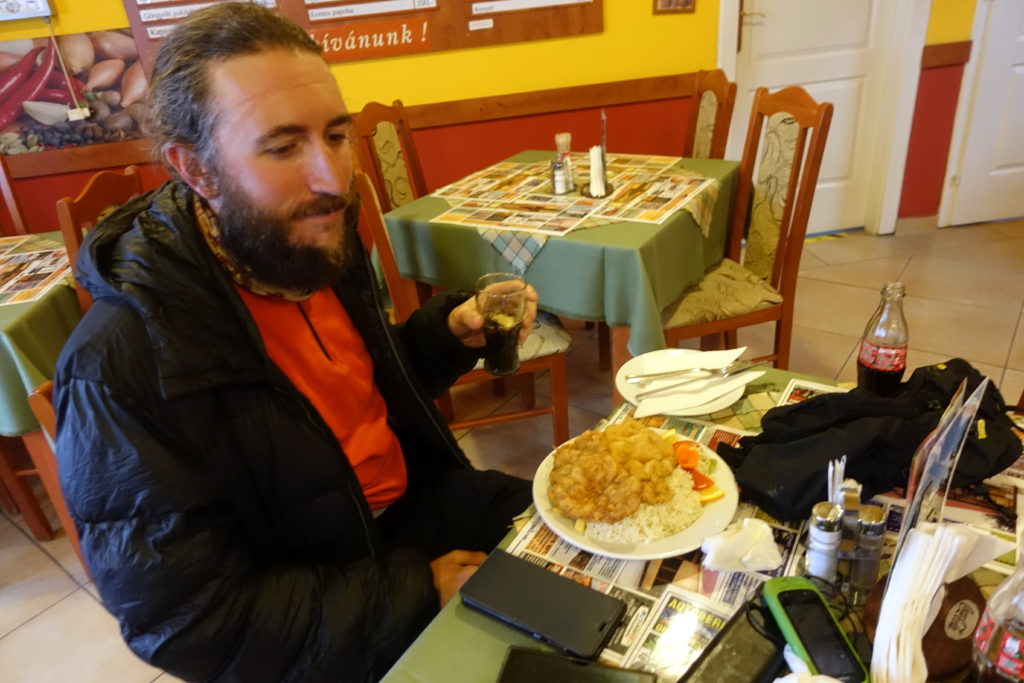
– leave at 9am
– shut-up and cycle non-stop until lunch
– when frozen enough, soaking wet and hungry stop in a local shack for lunch
– find a heater to try to dry gloves and jacket, possibly change the sweater, T-shirt or anything completely wet
– cycle non-stop with the sunset time in mind (i.e. avoid arriving after 3pm)
– spend the rest of the evening drying everything and huging the heaters at max level
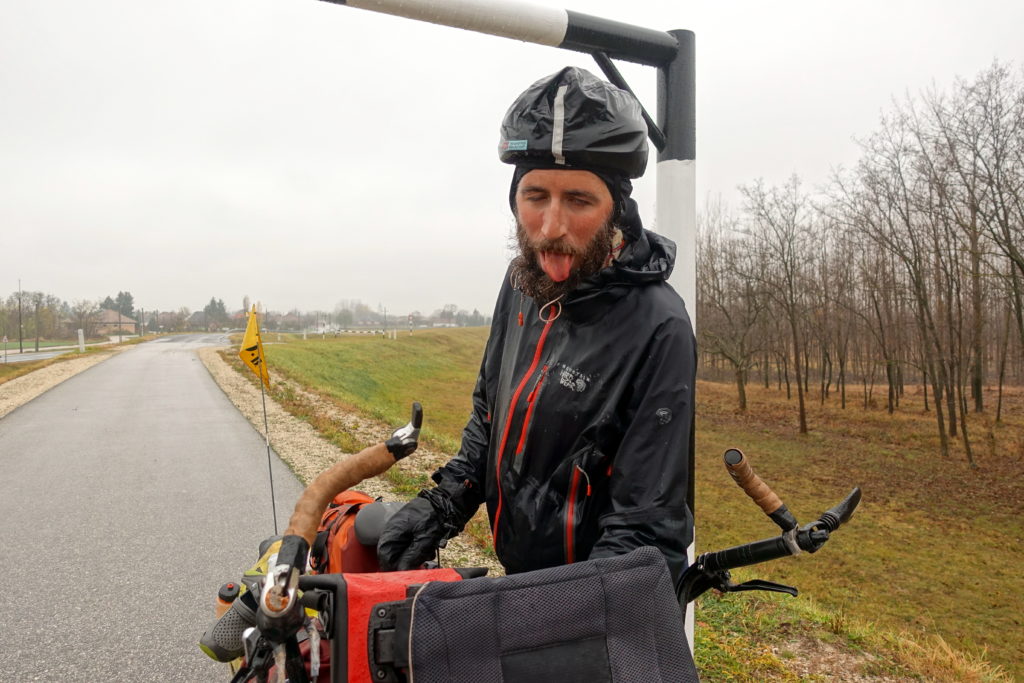
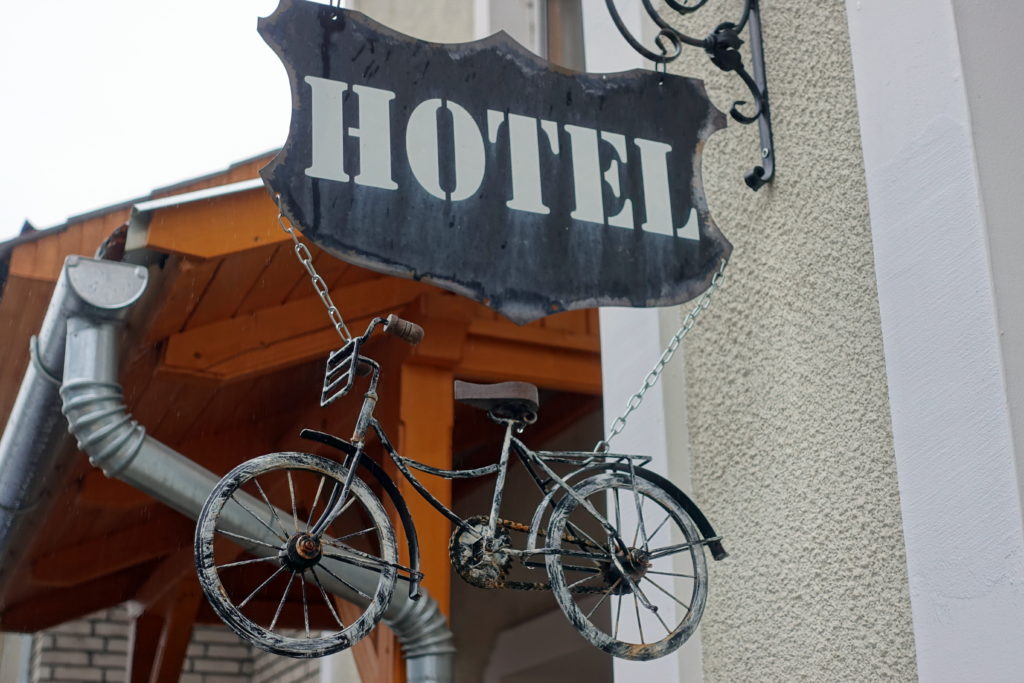
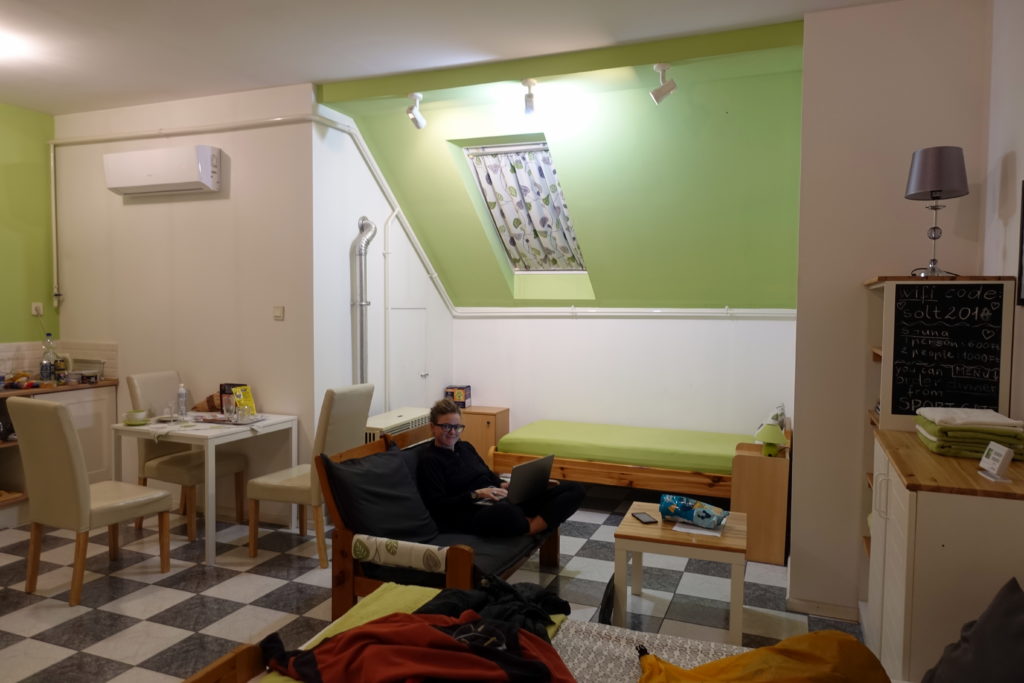
For the next two days as we rode towards Budapest, the weather didn’t improve – it remained cold, gray, and rainy. Out of Szekszárd, we rejoined the Danube and crossed onto the east side and followed the mix of bike lanes and roads into the capital Budapest. We attempted to stay out in the rain when biking wasn’t necessary, so we cycled non-stop to an indoor place for lunch, and then again to the apartment for the night. Nothing very exciting on those flatlands, more and more traffic getting closer to Budapest, and as usual the chaotic and totally uninteresting suburbs before finally reaching the much more bike friendly capital of Hungary. When we arrived at our place to stay, we somewhat felt bad for bringing soaking bags and clothes into the room, but… oh well, we needed a place to stay – and we tend to have less remorse in large hotels than guesthouses or B&Bs (and we are super cautious when invited or Warmshowers!). As we arrived into Budapest, we followed a bike lane along the Danube and into the heart of the city. It was nice to see grand buildings pop up out of the more modern suburban dwellings as we approached our hotel for the evening.
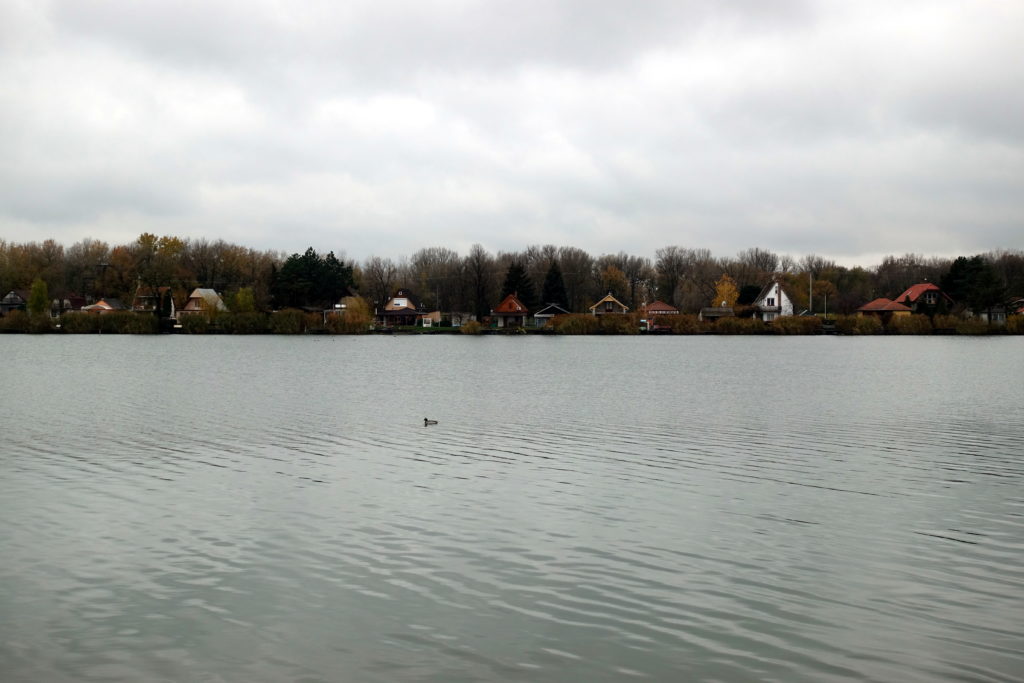
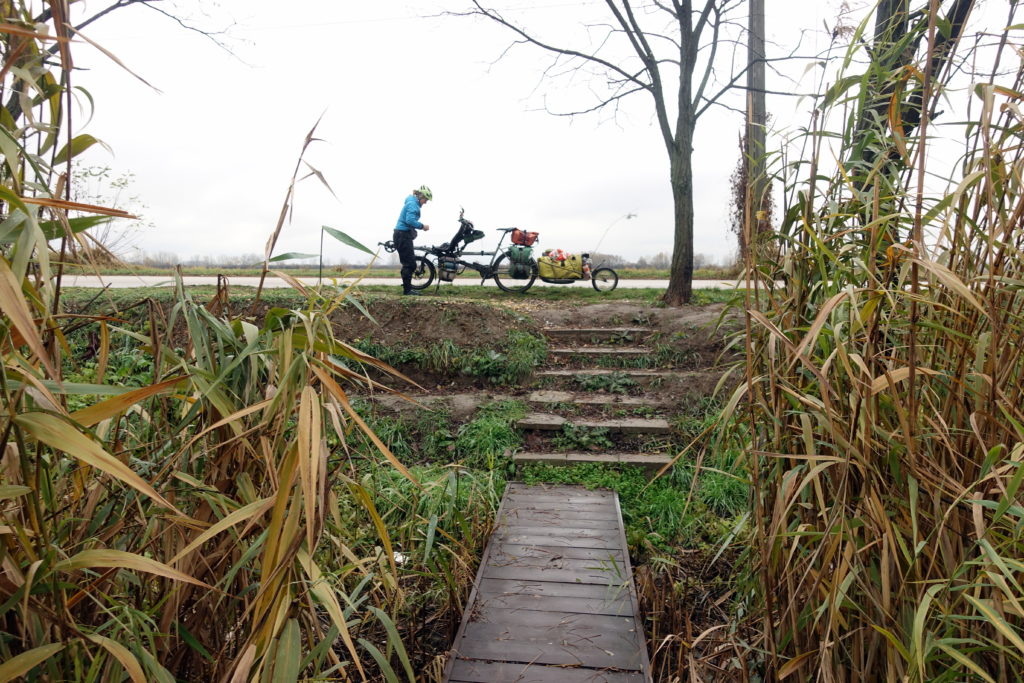
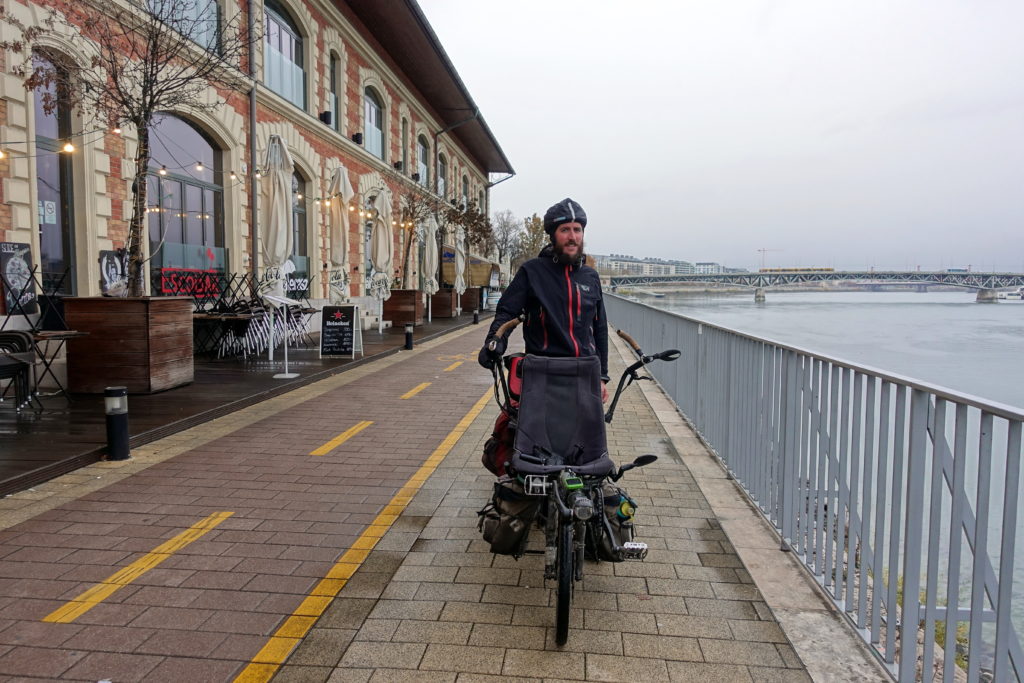
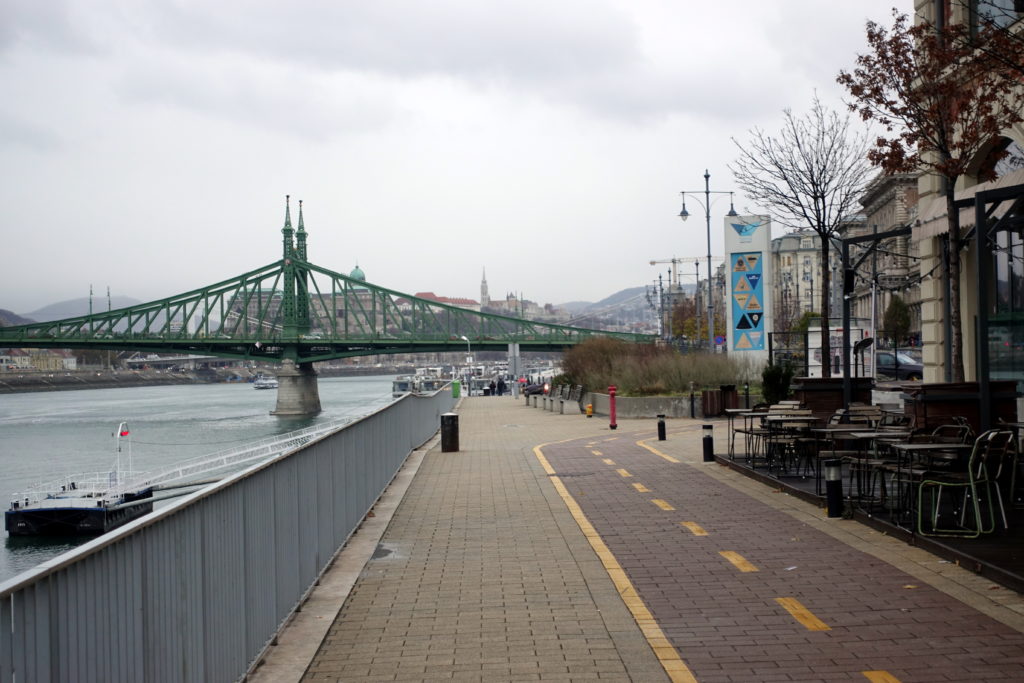
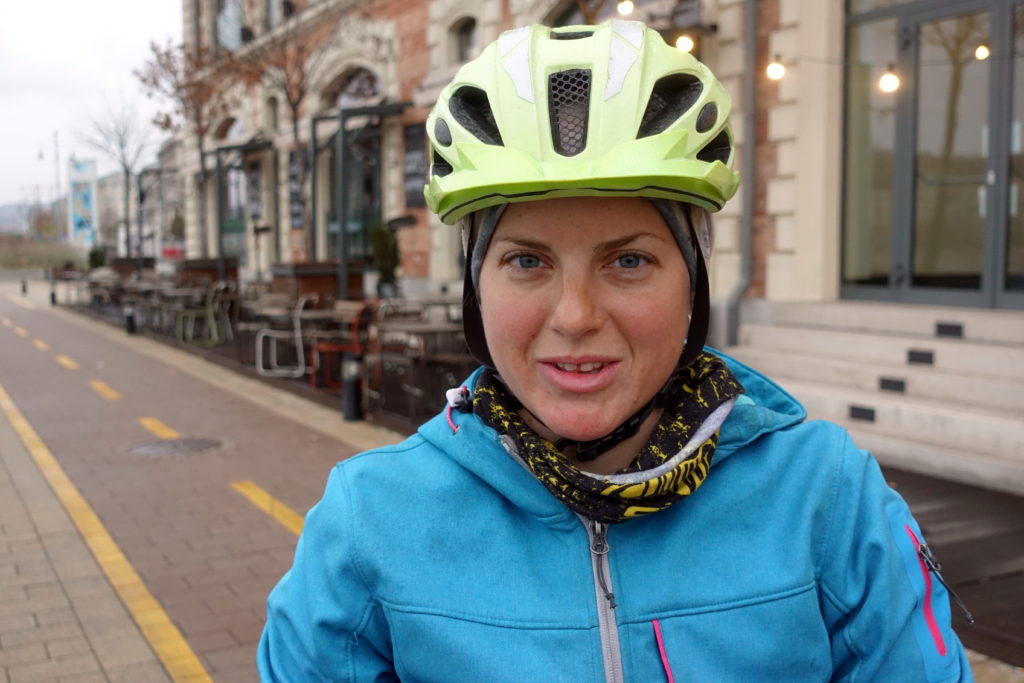
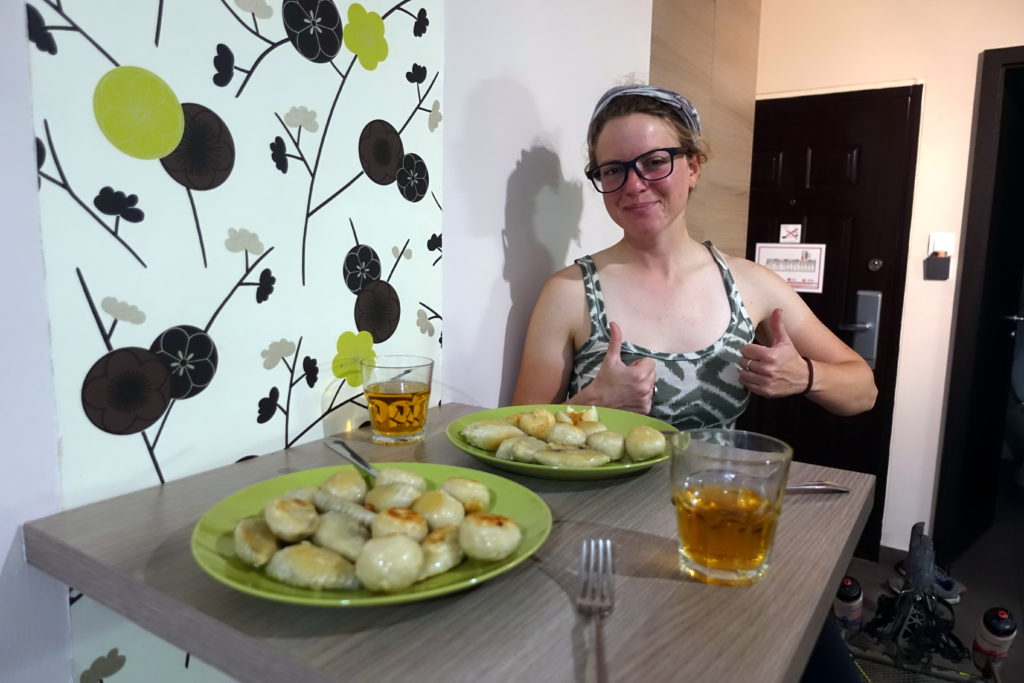
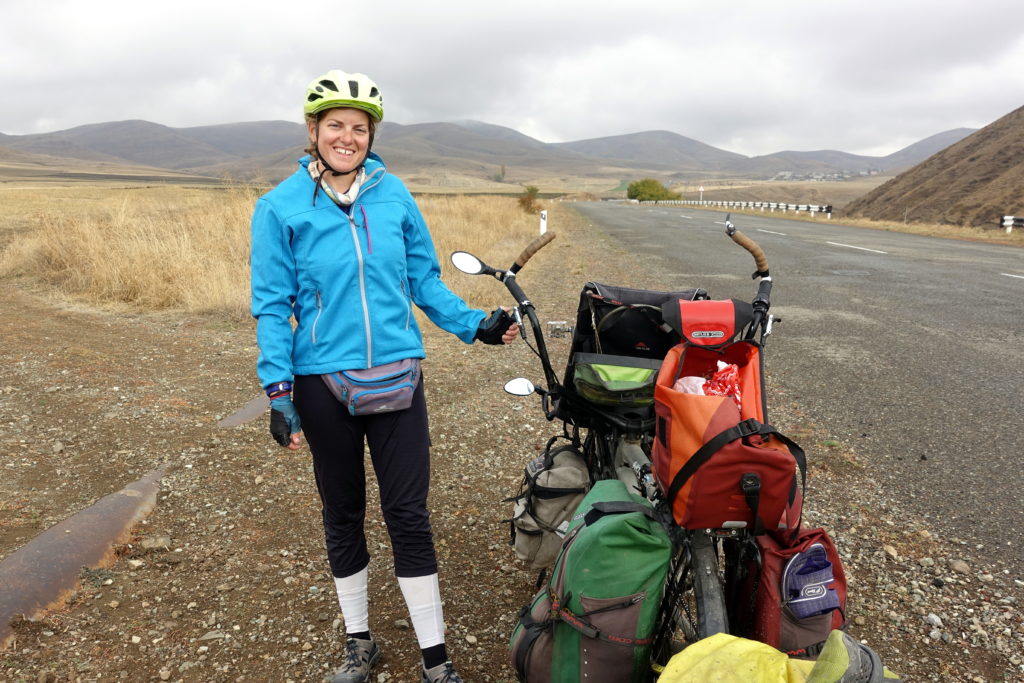
Getting from Armenia is not straight forward, it still reminded us that the country is mountainous everywhere. We had to start playing with multiple layers of clothing – strip down going uphill, swaddling going downhill.
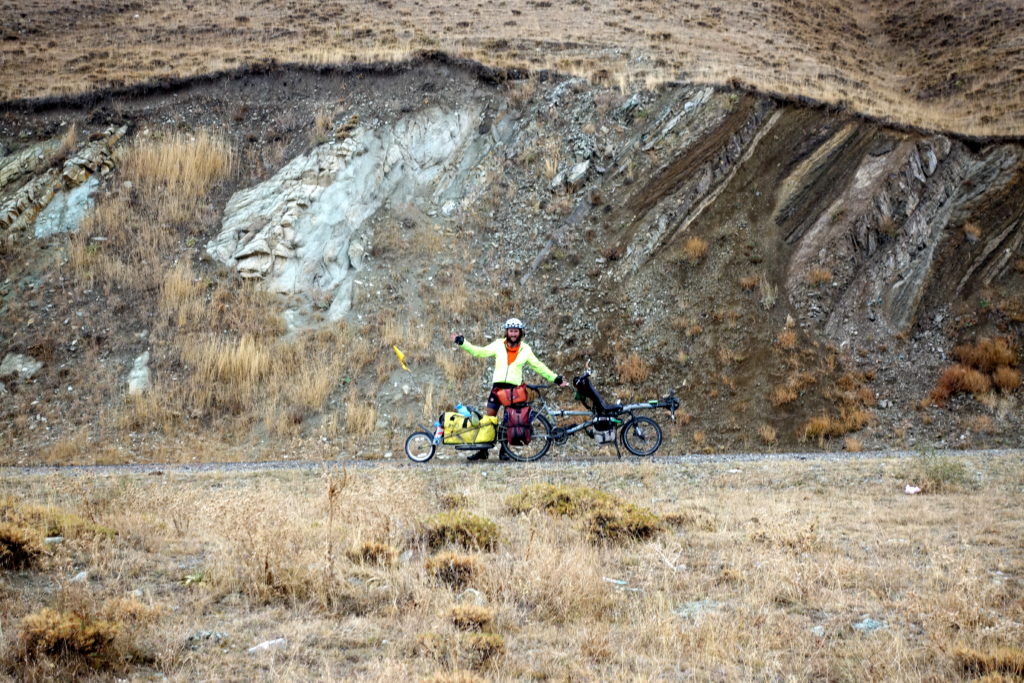
Up the last Armenian passes – and still enjoying the Armenian drivers before a short ride through the south-west of Georgia.
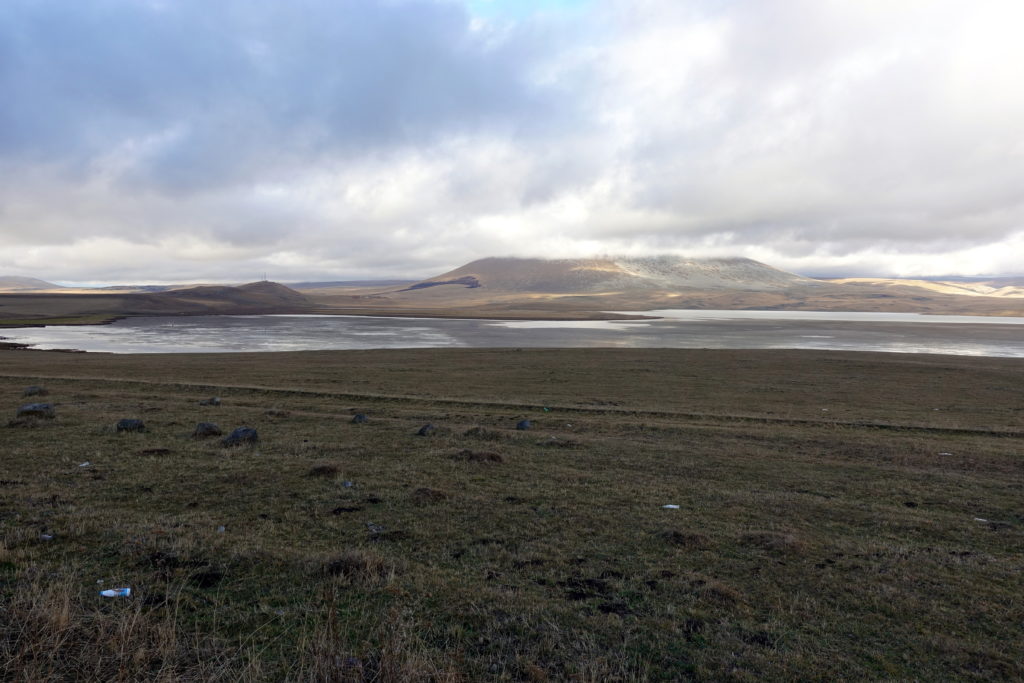
We mostly avoided getting heavy showers – no need of weather forecast, just looking at the clouds, the wind direction and adjusting the length and timing of our breaks.
We got the usual weird questions of the border officers: where do you come from? Cassie replying to one officer “Armenia!” while giving an US passport (we are in Armenia heading to Georgia at the border so obviously from Armenia, duh!), and Cedric told another officer “Kazakhstan” (well, that was where our last flight landed – duh again!) handing a German passport. Not sure what they are really asking at the borders with questions like that (and it has happened a few times) – but apparently no matter what you reply, they seem convinced with the answer (Western countries passports also probably help a lot!).
After the crossing, the roads took a turn for the worse and we had to cycle through thick, wet mud and potholed roads all the way to Ninotsminda, where we spent the night. It looked like the process of doing a new road was done over a decade, with years apart between the destruction of the previous road and the new pavement.
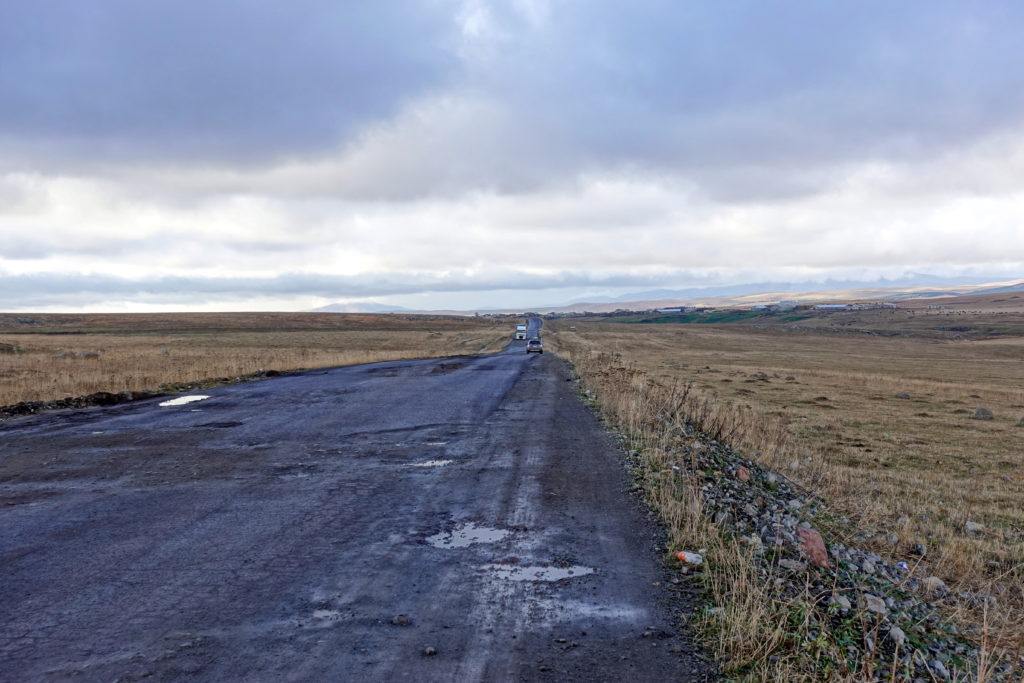
Surprise, surprise! The road turns into a 4WD track after the border…we were wondering why so few trucks were taking that road (it should be the shortest road joining Turkey to Armenia, but also western and norther Georgia to Armenia and Iran), we found the answer: a large detour is a lot faster than that path (Iranian trucks even completely go around Armenia through Turkey).
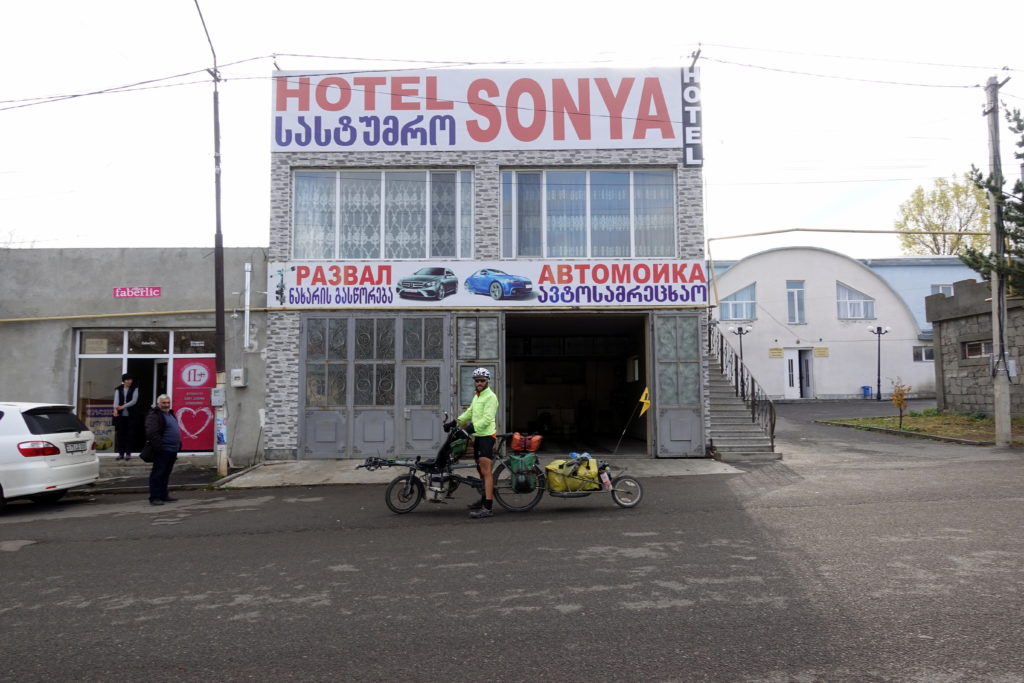
Our hotel, with the owner apparently managing everything around: the cosmetics shop on the left, the grocery store further left, the car mechanics underneath, and a restaurant on the right!
The next morning, Cédric and I packed our things in order to head towards the Georgia-Turkey border. The original plan was to camp somewhere close to the border, if not in Turkey that night. As we were leaving, Cédric and I had a debate about which road to take – my thought was to stay on the main road, despite the crazy Georgian drivers, and Cédric wanted to take a shortcut through some villages. I was a bit wary at first, considering that it had been raining and the Georgian roads from the day before had proven to be in rough shape, but I conceded after seeing a few cars driving down those roads. In the end, however, my first reservations turned out to be true. As we approached the second village, the roads went from manageable gravel to what I called ‘purely medieval.’ (A good reference for these roads would be from the Monty Python and the Holy Grail ‘Bring out your dead’ skit – Link). Within seconds on the path, our bike couldn’t move due to layers of thick, black mud between the wheels and the mud guards. With no other choice, we parked the bike and started poking out the dirt with our flag poles (the dirt was thick enough to break sticks). All too optimistic, we tried going on the path again and only made it for 100 meters before repeating the same process. And again, and again, and again through a village of 100 homes – which meant that people were watching us and dogs were barking all around, but no one came to help. Just a funny entertainment for the day – we had to cycle 60km in Georgia to get from Armenia to Turkey, and we were still not thrilled by Georgia. When we decided to head back to the main road, a guy called us and told us that he’d get us a taxi – but at the price he quoted, we decided that cycling was better, or at that fare accept only a helicopter-shuttle for a 10km leapfrog. By the time we made it to the main road, we had lost the entire morning and the clouds above started to swirl again. In order to improve our moods, we decided to cycle to one of the marked guesthouses in a village called Sulda, a lot before the original plan of reaching the Turkish border. We were hoping that it’s proximity to the main road meant paved village roads, but at this point, it was naïve to think that. We pushed the bike to a guesthouse and enjoyed an evening not toughing it out in the elements.
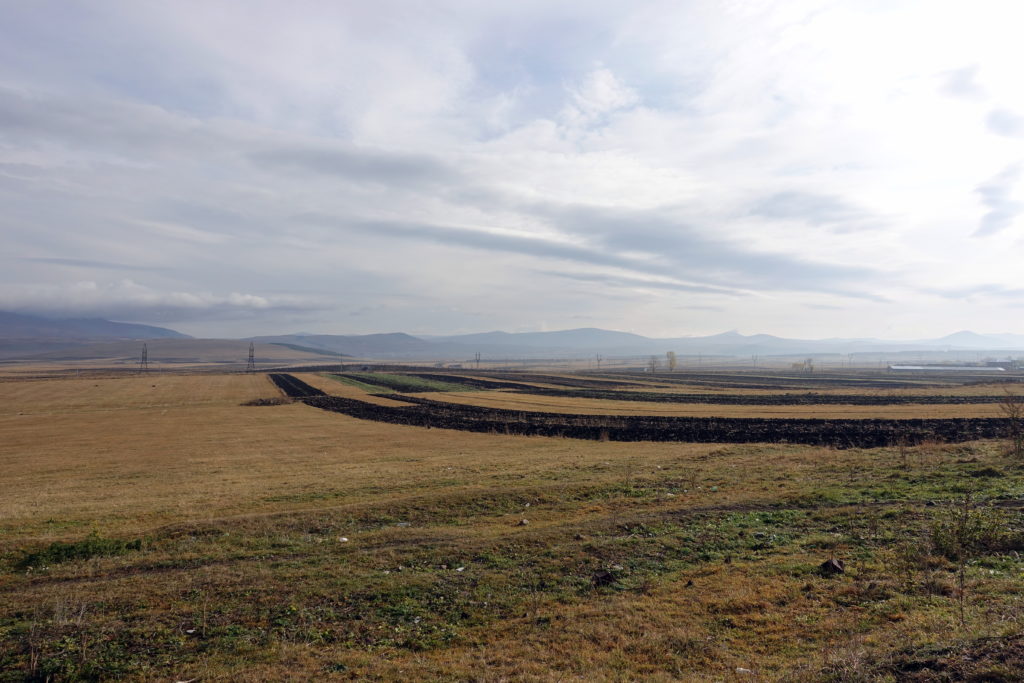
The last kilometers in Georgia shall have been easy and doable within a day – the shortcut did not work that well!
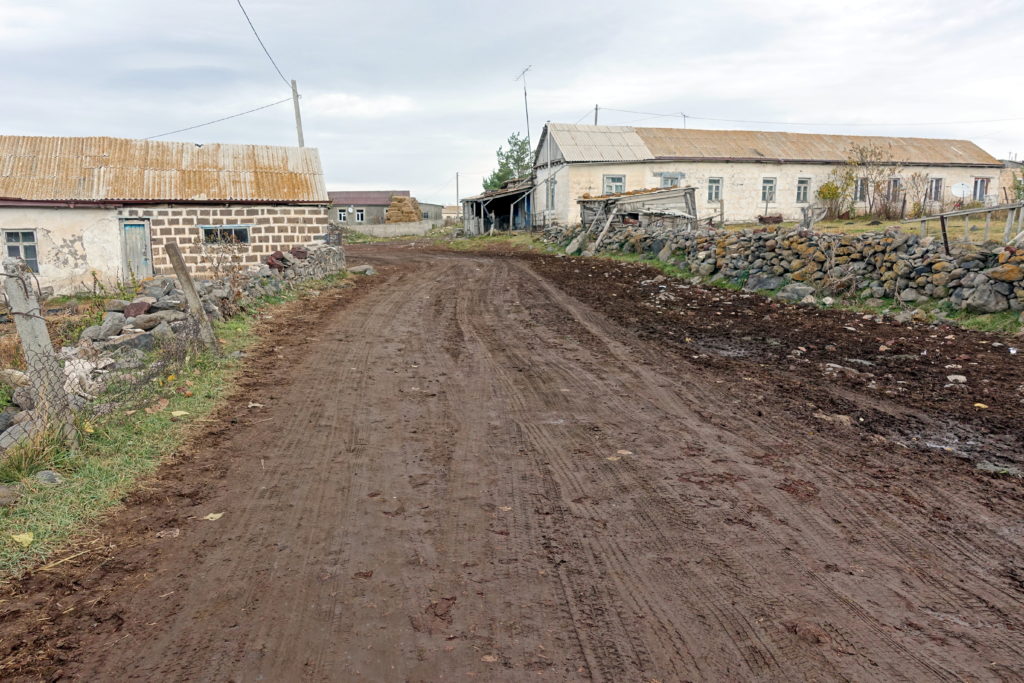
But to make things short, it make a nightmare! After three hours of struggle, we had gone back to the original intersection, the bike had dirt everywhere, and we had ruined our legs trying to pedal more than a few tens of meters between each clog.
A short video of the muddy mess:
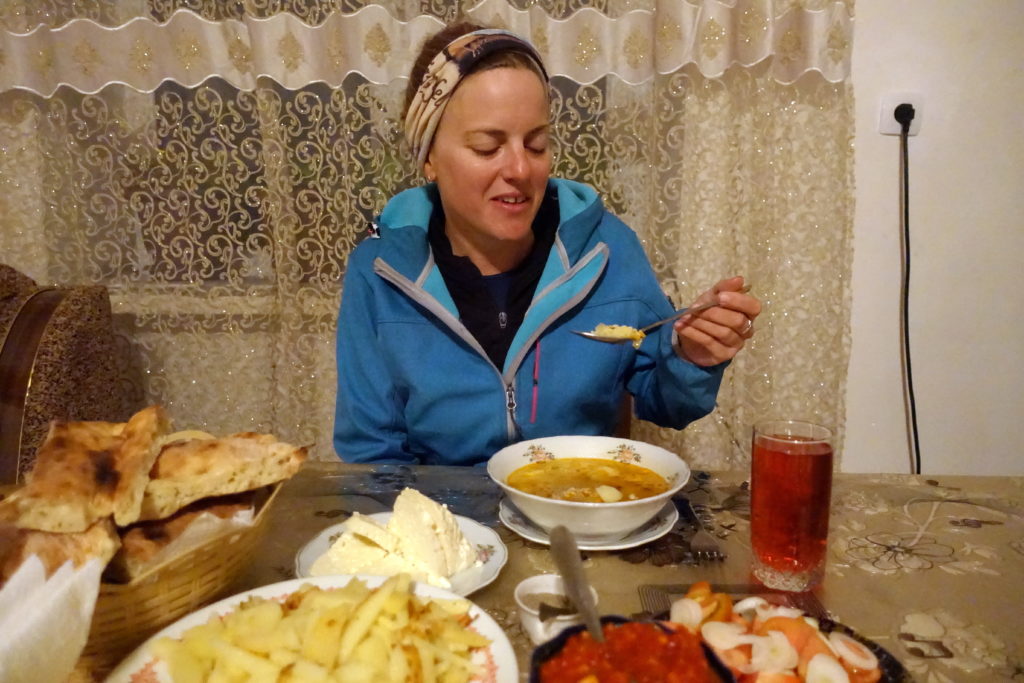
With the weather changing we are not hesitating much about overnight stays at cheap guesthouses – and if we can get something else than pastas, it is okay too!
The next morning, it was very difficult getting out of our warm bed and preparing for another cold and cloudy day with showers in forecast. We had a hearty Georgian breakfast, bade our host goodbye, and pushed our bike through the medieval dirt hopefully one last time. Once we got back to the main road, we pushed out the remaining dirt on our tires and set off towards the Turkish border. As we cycled through the last few villages, we couldn’t help but feel that these borderlands had been overlooked… the difference between here and Tbilisi, just 200 kilometers away – but centuries apart – was drastic, and it felt like being back into remote villages of Tajikistan. We reached the border in the late morning, turned in our passports for stamps (we got an officer testing our German skills – probably just to make sure that we had not stolen the passport – but not understanding our answer… I guess it probably sounded German enough to him), and then cycled off into Eastern Anatolia. The first thing we noticed was the new asphalt (with a shoulder, mindful drivers and even trucks using their blinkers!) and hopes that we would no longer have to deal with mud. We cycled up a large hill and came across two other cyclists who were speeding down. We quickly exchanged information about where we’ve been, where we’re going, the respective hazards of both countries we had just gone through, and where we stayed over the last few days before it became too cold and we said our goodbyes. They gave us a good tip on where we could stay that night (and price), because the weather was continually getting worse. The wind was starting to pick up and the showers were becoming more frequent, so we quickly stopped at a café for lunch in Çildir before cycling the last stretch to a resort on Lake Çildir. Cédric negotiated the prices and we settled into a bungalow for the night, once again glad that we wouldn’t have to worry about the tent crumpling due to the wind. Although the bungalow had three large room, we quickly re-tuned the interior design to condemn two rooms and transform the third into a studio with heater full-on and to not have to get-out of the room until the next day.
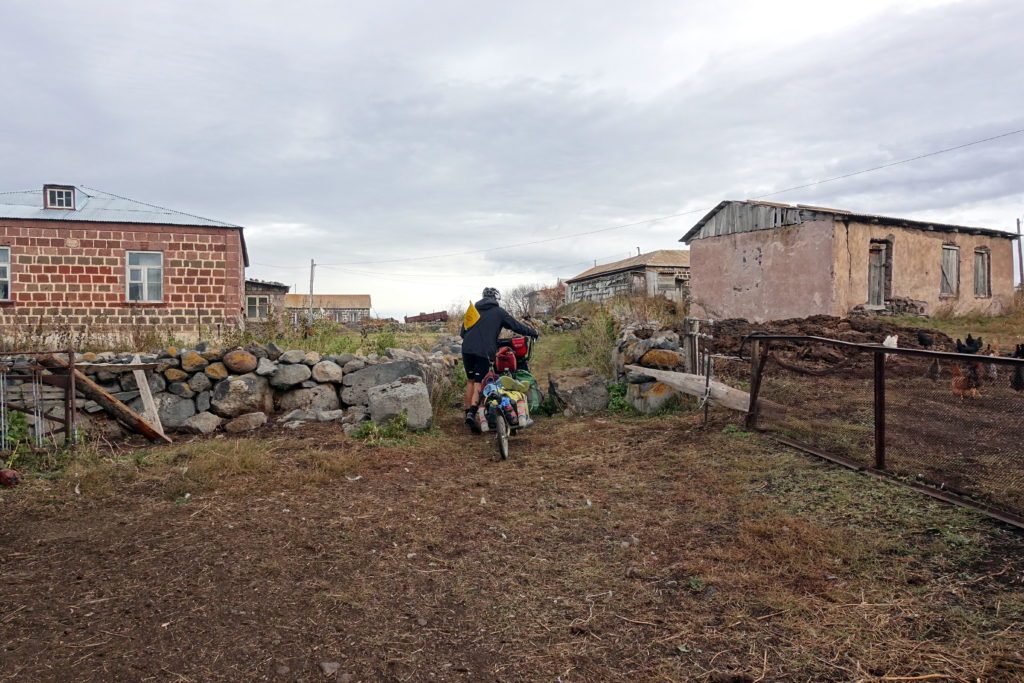
Not quite as shiny as Tbilisi! It seems that Georgia has forgotten to invest anything during the last past decades in that corner of the country (but the guesthouses had received some support from a German state agency).
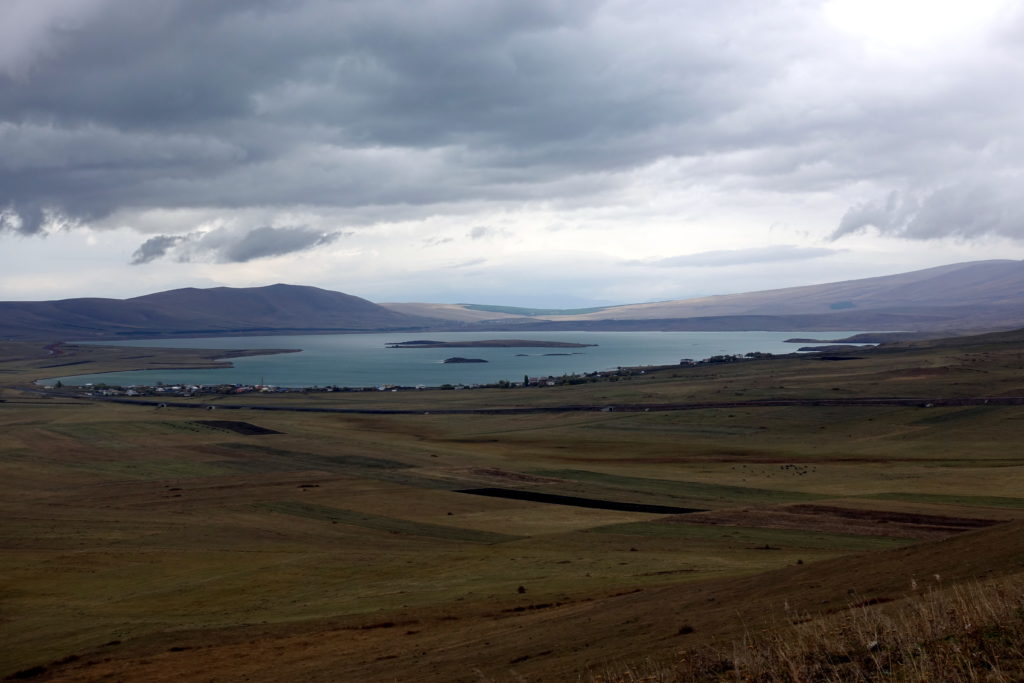
A last view towards Georgia, the lake being split between the two countries. That area was a lot more tense before the fall of the USSR – the idea was that whoever attacks first would probably go through those high but easy passes and turn the whole Caucasus into a battlefield
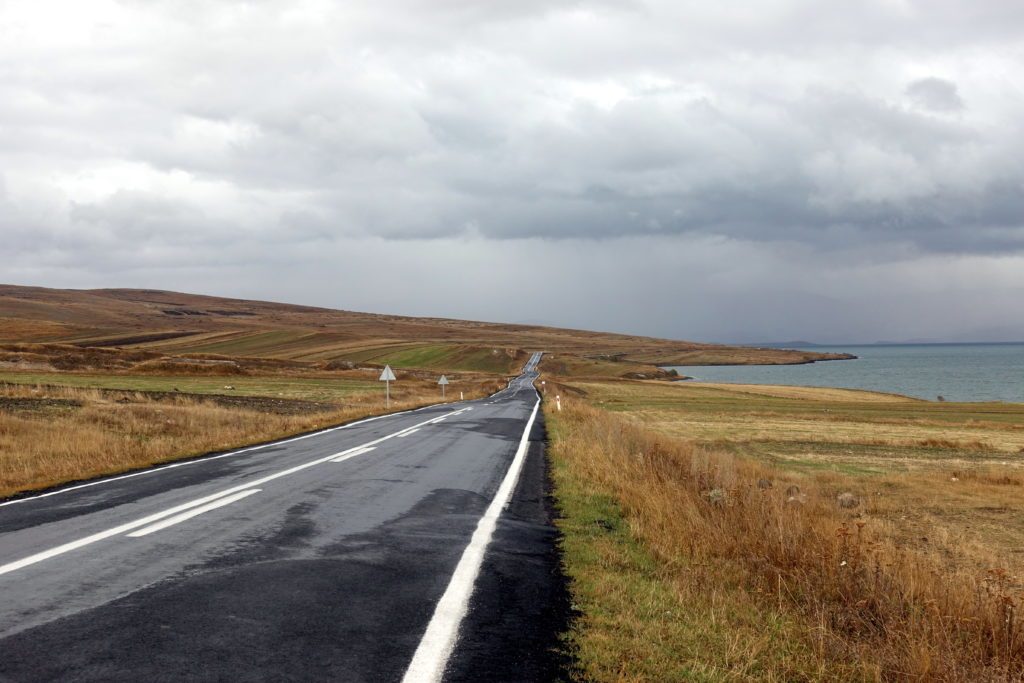
The first glimpses into Turkey: awesome roads, little traffic, gentle drivers, great views – just not the most promising weather.
We awoke the next morning, tired from a loud, windy night. It seemed like our bungalow was built only for good weather since wind was blowing through the cracks throughout the entire night and sometimes felt like it was going to collapse. When we awoke, we looked outside at the trees bending in the wind and wondered whether it was worth it to attempt cycling this day… since we had time before breakfast to figure it out, we flipped on the heater and watched the news on the TV. At breakfast in the resort’s restaurant, the wind continued to howl outside, and it was predicted to get even stronger to gale-forces by midday… so we decided to stay an extra day and use the time to catch up on blog posts. The next morning, we again woke up early and noticed that the wind had died down over night, but were surprised when we pulled back the curtains… snow! A few centimeters of it, too. The wind was still blowing, but not as strong, but now the roads were covered in snow. Again, we pondered over our predicament over breakfast and then decided to wait it out another day as we watched snowstorm after snowstorm pass.
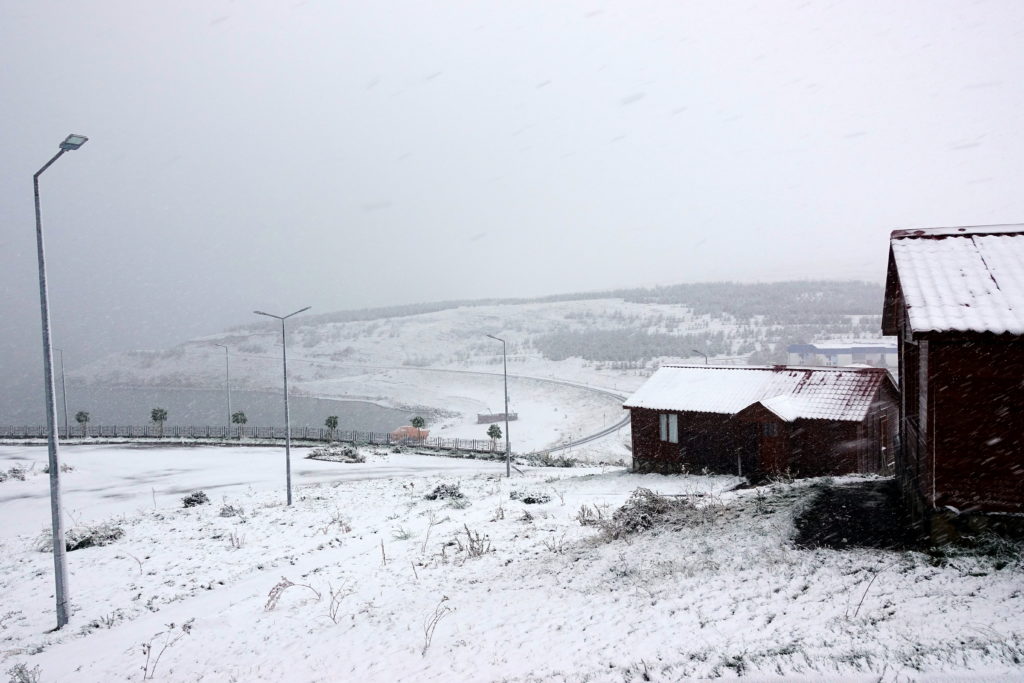
Surprise, surprise early in the morning on day two… the whole area (over 2000m) turned wintry overnight. Snow only would have been fine, but the flurries, the consecutive snow showers, the temperatures kept us stranded there.
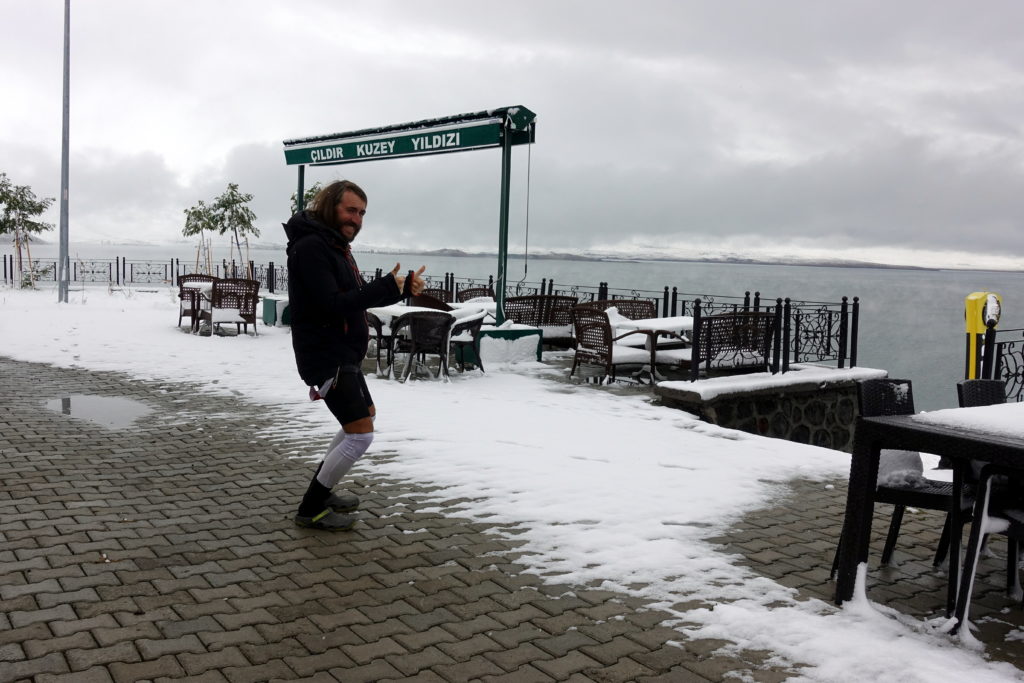
Cedric still had hopes in the morning that it would get better at some point and we could race into Kars – 80km away. The weather got better at some moments, for a few minutes only – still keeping cycling equipment on.
Finally, after three nights confined to the resort (and having exhausted all our food supplies), the weather became better and we could leave. In true Murphy’s law fashion, our bungalow didn’t have running water during our stay at the resort (a burst pipe or something, maybe laziness), so we were also without shower and a convenient bathroom. As we were leaving, however, the water magically started working again. We packed the bike, said farewell to the resort staff and cooks, and set out for Kars.
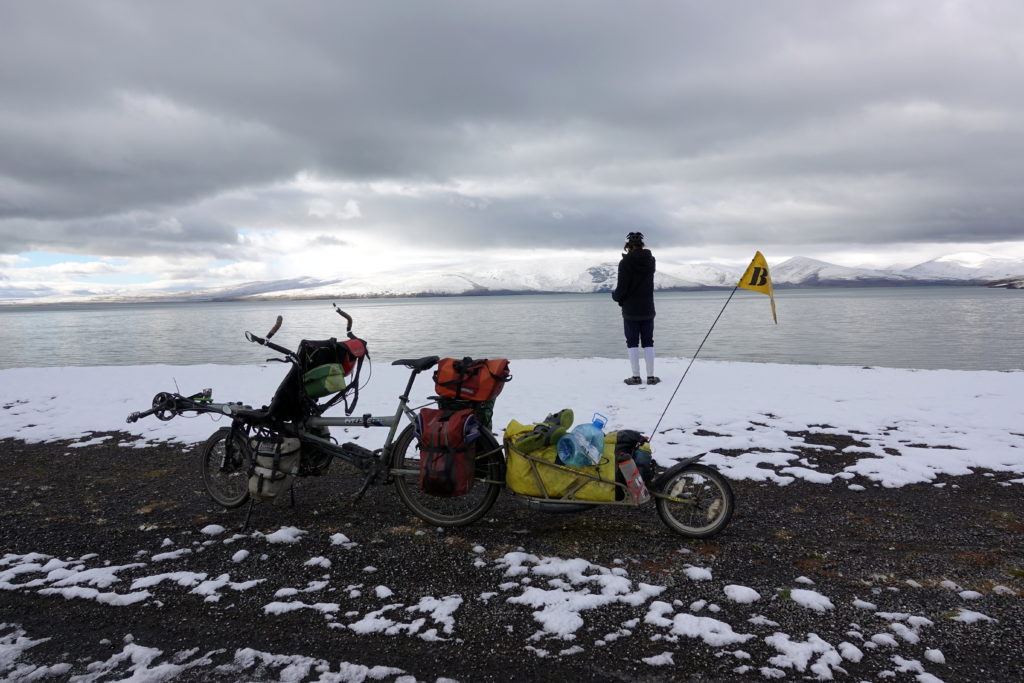
The landscape looking completely different after the two days. Yes, this is still Turkey and not Greenland.
The already-melting snowfall did wonders to the landscapes as we cycled around the rest of Lake Çildir- it added another dimension to the mountains that we had not yet seen while cycling. We enjoyed the journey down to Arpaçay for lunch and continued cycling over some hills until we reached Kars. The benefit of Turkish cities is that most people live in large apartment buildings, so reaching the center in towns of tens of thousands of people is quick and tolerable (as opposed to navigating thousands of streets and cars). All shops and restaurants are altogether within walking distance. Knowing that the overnight temperatures were dropping to below freezing, we found a hotel downtown for the evening. Turkish hotel owners have notably always been great at helping us manage our gears and store the bike for the night – no questions or reluctance, they always find a safe indoor spot for the bike (no way it stays in the street, but people don’t always understand that).
The next morning, we set off westward. Our trip in Turkey was only going to last until Erzurum and we still had a few hundred kilometers to get there. After cycling through a few streets, we reached the highway once again. Compared to nearly everywhere we had been cycling over the past few months, Turkey felt like a dream: the highways were empty, shoulders were wide, gentle drivers and everything was newly paved. This is what we wanted after countless roads covered in potholes, gravel, glass and constant honking. Looking at the snow-capped mountains in the distance also made the day even more enjoyable. We stopped in a town to eat our lunch, which ended up being bread and spreads on a curb because we weren’t interested in cycling into the center. In the afternoon, we followed a small road through a few villages to Sarikamis, which again had light traffic and unbelievably smooth pavement. Because the day was easy, we packed our things inside our hotel and walked around the ski town, eating at two restaurants because one meal wasn’t filling enough.
While the morning temperatures were still below freezing, Cédric and I packed our things and left. For us, it was slightly depressing to know that the temperatures for our last stretch of cycling wouldn’t improve (or at least get back to shorts and t-shirt weather). Just like the day before, it might have been a cold start, but there wasn’t a cloud in the sky. We warmed up by cycling up a small pass and through pine forests – although we needed to put our jacket and gloves back on for the descent. As the day progressed, we marveled at the landscapes we were able to see from the road: canyons, cliffs, fairy chimneys (and we weren’t even in Cappadocia!) and the remnants of the Zivin Fortress… all of this aided by the mountains in the background and lack of cars made for an awesome day of cycling. We ended our day just before it dipped below freezing in Horasan.
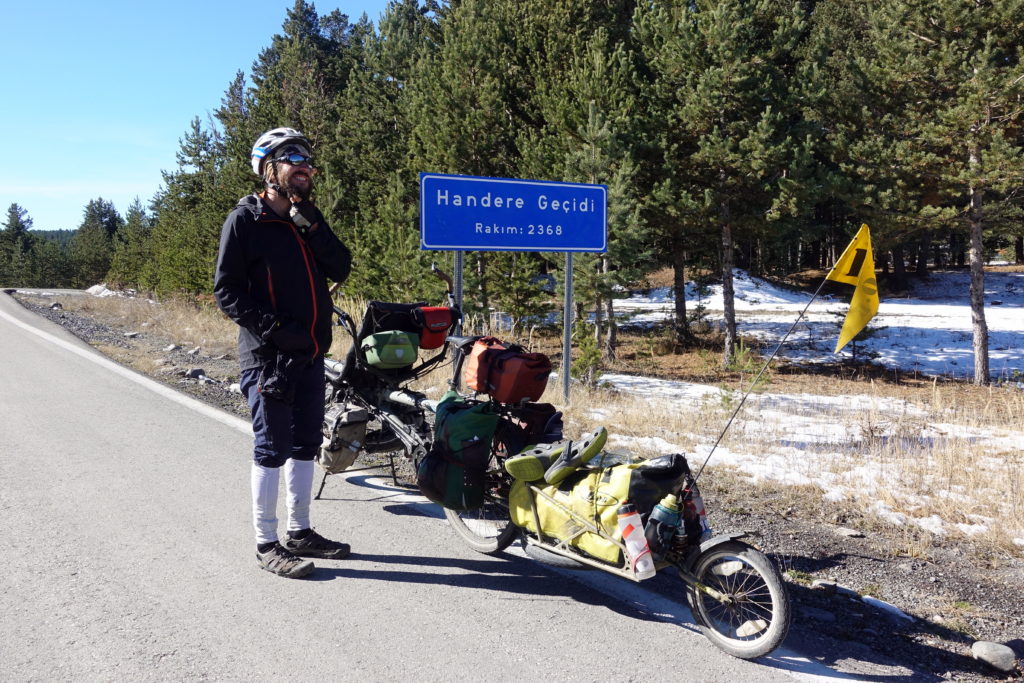
We’re hoping that this is the last official ‘mountain pass’ of our trip (anything under 2000m can be ignored – anything under 3000m is kinda easy stuff now!)
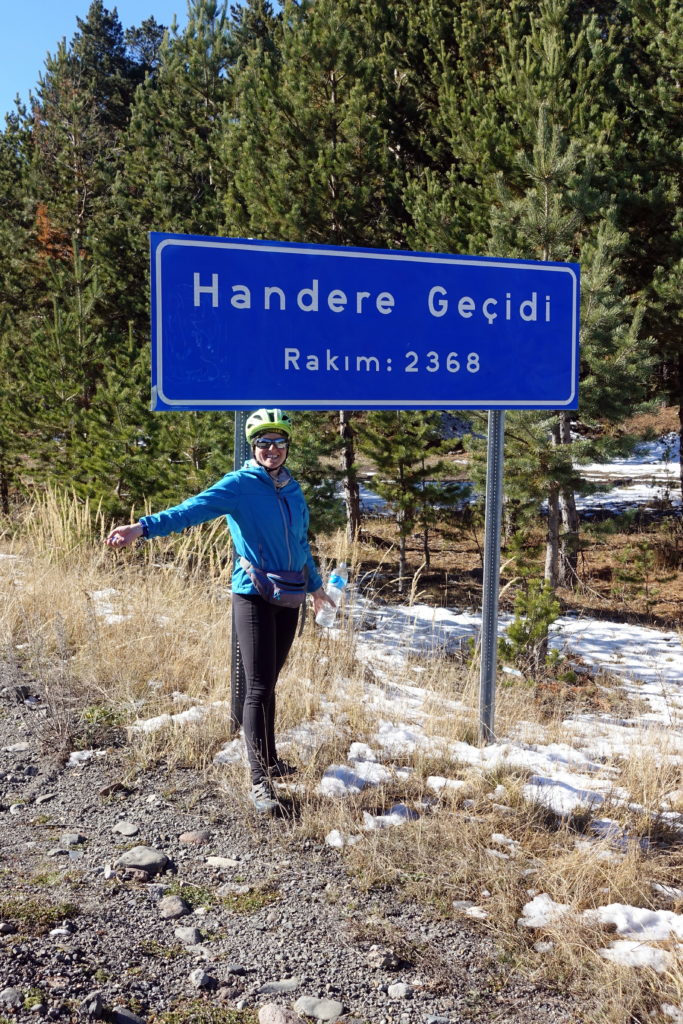
Ah, the altitude might be why it’s always freezing! After all the ascents we have done in the last months, that pass really felt like being one easy piece of cake.
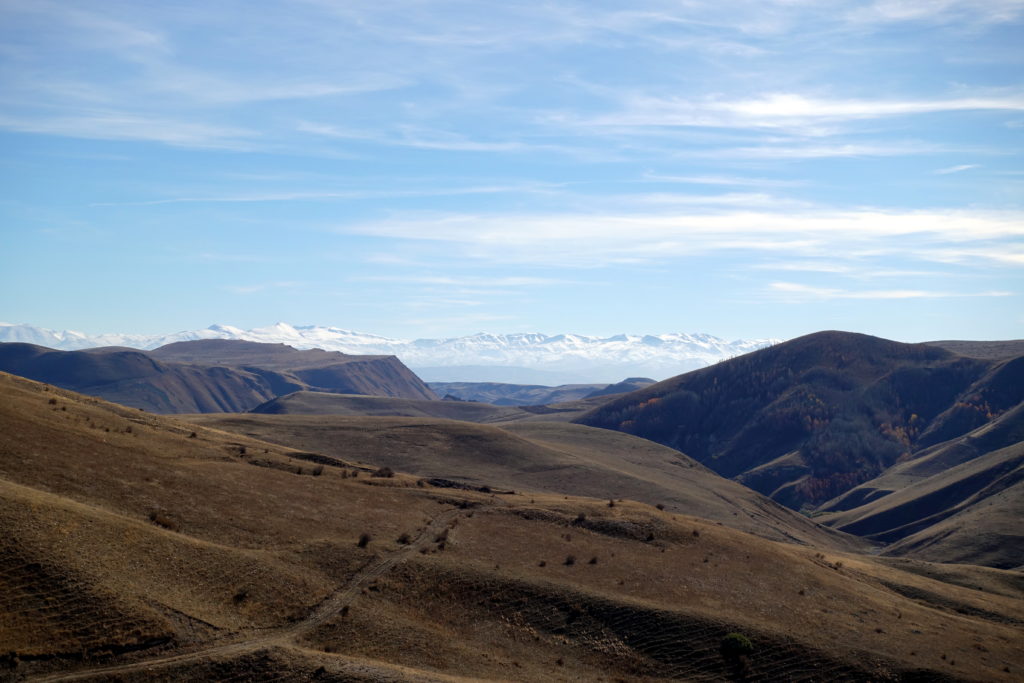
While we were taking these pictures, a guy asked to we needed a lift to Horasan and we told him absolutely not when we can look at this the whole time
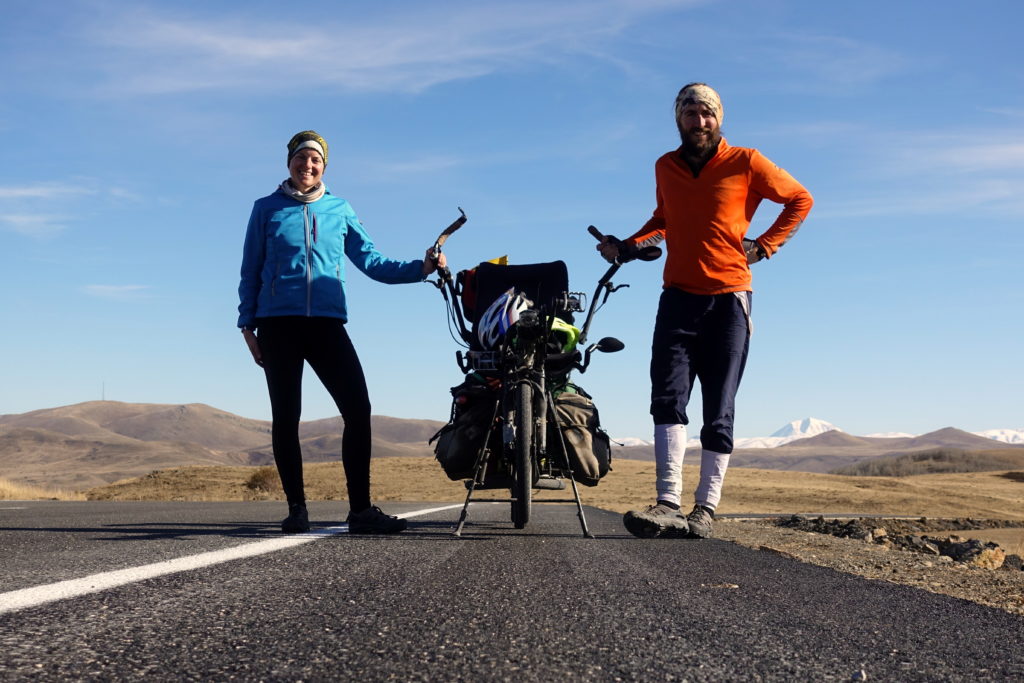
It was also a perfect day for taking selfies. Cedric did not carry winter clothes, so managed to ride by putting any kind of clothes available – including arm sleeves on the legs. He finally shopped for winter clothing in Istanbul (thanks Decathlon!).
For our last day of cycling, we had no other option besides cycling along the highway to get to Erzurum since it was the most direct route. The weather was still cloudless blue skies and the day was pretty enjoyable, despite the uptick in the number of semi-trucks cruising past. While cycling through a police checkpoint (they’re looking for guys avoiding the compulsory military service… and terrorists?), we were offered tea by one of the guards who could speak English. He told us that many cyclists go past in the warmer months, but it’s rare to see people so late in the season. We stopped to warm up over a lunch in Pasinler and then continued our journey. In the afternoon, shortly before Erzurum, we met Joscha, a German guy heading towards Singapore and exchanged a few stories on the side of the highway. The ride into Erzurum was effortless and we quickly found a place to stay in the downtown. The hotel was also helpful in finding a bus company that would take us into Istanbul.
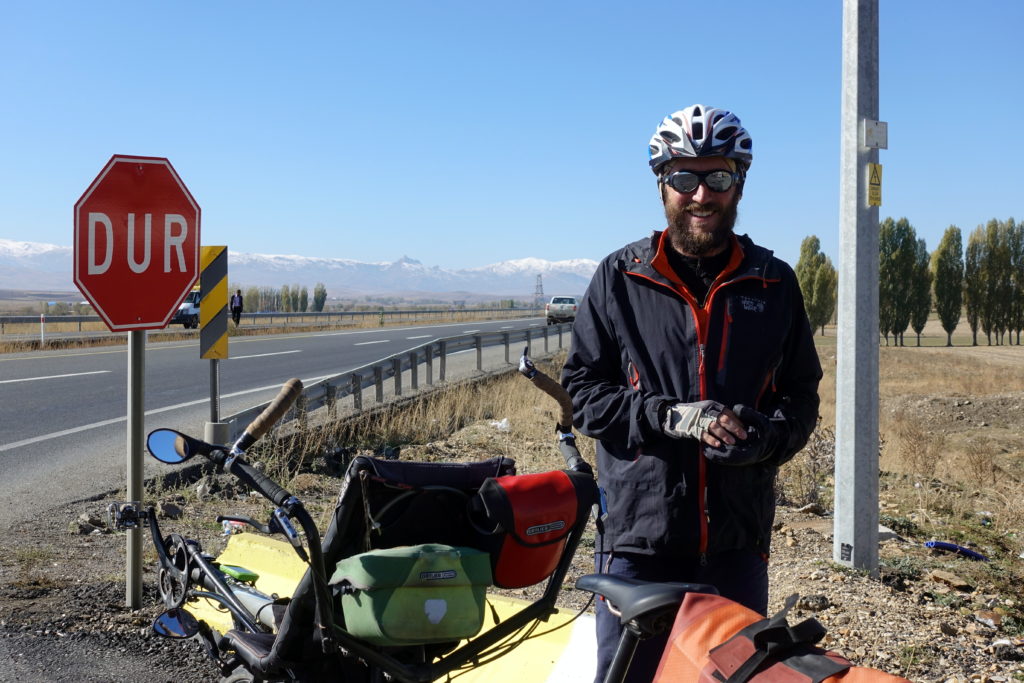
Happy after being offered a cup of tea (we weren’t allowed to take a picture of the checkpoint). Oui, traverser l’Asie est dur!
The next day, with a bit of extra time do to an afternoon departure for Istanbul, we wandered around the city and saw some of the historical sites. It appeared as though Erzurum was also planning to be a hit tourist destination in the near future, so the castle was under renovation (or possibly reconstruction). We were also being pulled into a carpet shop and spoke a bit of German with the friendly owner as he told us a bit about the handmade carpets and his life. If we weren’t cycling, I’m very sure that we would have walked away with something. In the afternoon, we loaded our bike and made our way to the bus depot, hoping that our luggage wouldn’t freak out the bus driver. When we loaded our stuff, the drivers and assistants rammed our bike into other luggage, which broke our headlight, but still demanded that we pay additional money for the luggage. I tried my best to negotiate the price (mostly by screaming “problem!” and pointing to the headlamp), but we didn’t walk away with a discount. The 20-hour ride to Istanbul was cramped and uncomfortable; we were able to sleep a few hours during the night, but many old guys talked on their phones and the frequent rest stops didn’t allow us to have uninterrupted sleep. The bus driver, probably doing the trip several times a week, managed to even miss Istanbul (15M people) and realize that half way to Bulgaria: 2 more hours in the bus! He was focusing a little too much on his cigarette and buddies on the phone… We rolled into Istanbul the next day in the late morning and quickly packed the bike and rode to the nearest hotel that would take us. Competition between hotels is fierce in Istanbul, and by being in the business area on a week-end, thus slightly outside of the touristic downtown we got to settle in a 4* hotel for a bargain price.
]]>Those three countries have been strangled throughout history between their influential larger neighbors or simply part of larger empires: Russia in the North, Persia/Iran in the south and the Ottoman/Turks in the West have all shaped the culture and traditions. Reading a little more in detail the history of those countries, it is interesting to note that although all claiming millennia-old history and ancient roots, the three countries got defined as of today only with nationalism in the 20th century.
We thus found interesting that although the three countries have had multiple wars and have tense borders, they felt somehow quite similar: food, people, towns, etc. Many parts of Georgia/Armenia/Azerbaijan were previously inhabited by some people from other ethnicities – notably Baku being mostly Armenian and Yerevan being mostly Azeri.
We got particularly amazed that those tensions are still so strong and deep – Armenia still struggles with Turkey as nationalists regularly claim half of eastern Anatolia, Azerbaijan and Armenia have basically no clear border, just some barbwire, snipers and fields of landmines spread randomly (it felt, looking at the geography…) over hundreds of kilometers.
Azerbaijan, although a Shia country, is closely allied with Turkey and surprisingly with Israel (yet not sharing a border with them). Armenia has close ties with Russia and Greece, although again not sharing any borders with those two countries; it is also astonishingly closer to Iran than Azerbaijan. Georgia after having tried to defeat the Russian army (and unsurprisingly failed within a few days) is doing everything imaginable to get as close as possible to the EU and the US: NATO advertisement campaigns, EU flags on every public building (even the border crossing), etc.; again, Georgia does not share any border with the EU and the US. In short, those countries have populations who lived together for centuries, but managed to make things ugly and at the end, we felt that the loser of the story was Armenia – landlocked, and not benefiting from foreign resources like the two other countries: Georgia through EU aid and Azerbaijan through apparently unlimited oil reserves.
So once again, if you haven’t read the previous posts about the three countries, check those out first. If Yerevan sounds for you like the capital of Yemen and Baku the nickname of your local confectioner, take a map first!
- Azerbaijan: we had not read or knew much about Azerbaijan before getting there, except its history linked with oil in the 20th We got surprised to see a variety of landscapes, from desertic areas on the coast, to humid mountainous forests up north.
- We liked:
- The trees: after being in tree-less climates for the past few months, it was nice to find good shaded spots. Trees also meant that we could possibly have a more stealth camping spot (although we were always found by a shepherd).
- The informal tea houses. Ok, according to the Lonely Planet guide, Cassie wasn’t supposed to hang out there, because it’s understood as a male-only space (where men can feel comfortable in the presence of other men – as opposed to markets, bakeries, every restaurant… etc.). In our short bit through Azerbaijan, we found them a nice place to have our lunch and warm up.
- The mud volcanoes – although not a large area, this is a seriously weird landscape.
- Finally getting a variety of fresh fruits and vegetables. Okay, the lower valleys of Tajikistan were also enjoyable for that (especially as everyone was offering us their garden produces!)
- Baku (downtown) is surprisingly clean and well-maintained, people in Baku feel open and liberal.
- We disliked:
- Cars – Particularly in Baku. There were just so many parked and taking up space on the street, honking, speeding down the blocks, and generally making the city a bit unbearable. This trait isn’t just Baku alone, almost any sizeable town or city (everywhere we’ve been) is cramped with cars – and while on the bike, we’ve been pondering ways that could make things more bearable. Cédric has been thinking of a device that would blow-off the driver seat and make the car useless if it goes less than 10 kilometers in distance – but yes, most of the drives are clearly a few kilometers, if only a few hundred meters, and almost certainly slower than just walking.
- Shashlik – or any type of barbecued meat. Ever since the Caucasus, Cassie’s been trying to avoid the dish – threatening to go vegan when the trip is done. Shashlik and Kebabs are found virtually in every post-Soviet country (and now shish-kebabs in Turkey…), but when every restaurant only serves meat with lots of inedible gristle… it starts to get to you.
- Men (outside of downtown Baku!) – Azerbaijan was the most machismo and misogynist country we have crossed. There are just no women in the country, and idle dudes are not particularly interesting, not very friendly, and really invasive.
- Trash – Azerbaijan is certainly the dirtiest country we went through this year. There are trashes thrown everywhere! Nothing stinky, but plastic was found in all fields (even far from the main axis, roads, villages are covered with plastic.
- We liked:
- Georgia: one of the first (oldest) Christian countries, we were happy to get into a different culture (not that we particularly intended to go to mass, don’t worry!), known for its cuisine and apparently also its wine.
- We liked:
- Cute churches – Georgia is one of the oldest Christian country in the world, and unlike in Europe where churches have been rebuilt and enlarged multiple times, Georgian churches have not changed much since they were built (sometimes in the 5th century). Churches are often on top of hills (together with small monasteries) and not necessarily in the center of the villages which make them very picturesque.
- The food: food is seriously awesome in Georgia – seriously! Great variety, some elaborate dishes, and getting dinner in guesthouses is just awesome: you get more dishes than you can imagine, whenever you think it is finished, something else comes – meat, fish, vegetables, nuts, fruits, salads, desserts, etc.! The dream

- Guesthouses: there are lots of guesthouses everywhere in the country for a very reasonable price. Hotels are not that great (and expensive), but all people we have met in guesthouses were really friendly (it probably also helped that we were in the low-season and went to remote towns who rarely have any guests – or went into guesthouses owned by Iranians).
- Some scenic rides, with autumn season colors and massive mountains at the border with Russia (well, sort of – Russia found that its country was a bit too small and invaded two Georgian regions 10 years ago)
- Georgia was the first country where we first saw books and newspapers in houses since Malaysia (honestly) – we got really surprised to find shelves of encyclopedias, dictionaries, and novels in the various guesthouses. This is also true for Armenia. Similarly, Georgia was the first country in months where using a VPN was no longer necessary to get around internet censorship (also valid for Armenia).
- We disliked:
- The traffic: Georgians are the most insane drivers we have seen in any country (and not just this year). The driving is simply as fast as you can, the turns in the mountains with the hand brake, some drifts on the road, driving on the left side of the road, full-throttle all the time. And obviously almost no law enforcement. Really scary! We did not stay long in the country mostly for that reason – steering the bike means a continuous focus on any car instead of enjoying the landscape, and the safest roads felt like the busiest ones (it’s harder to drive on the left side when there are traffic jams on both sides of the road…).
- Aggressiveness – for whatever reason, Georgians are a little rough and nervous. They want to get to the fist immediately for some complete non-sense (we had a guy who wanted to show his strength because I warned him that he was backing-up his Mercedes into our pedals – he would have probably preferred a long scratch on his car… but again, it helps to be a head taller than Georgians (and looking a little rugged with chaotic beard and questionably clean clothes! The consumption of wine does not seem to help much… You combine the aggressiveness with their driving style and you get people yelling and honking at disabled or older people while they cross the street on the crosswalks a few meters away. It is ranging from boorishness, crudeness, intolerance, or just stupidity.
- The wine (sorry, because it seems like the national pride!) – okay, we are not experts in wine, and the wine in Georgia is better than Kyrgyz wine (a mix of grape-juice and vodka!) but compared with its supposed reputation…well it tastes better after multiple glasses (guesthouses are happily continuously refilling your glass, and you cannot drink water with dinner)!
- We liked:
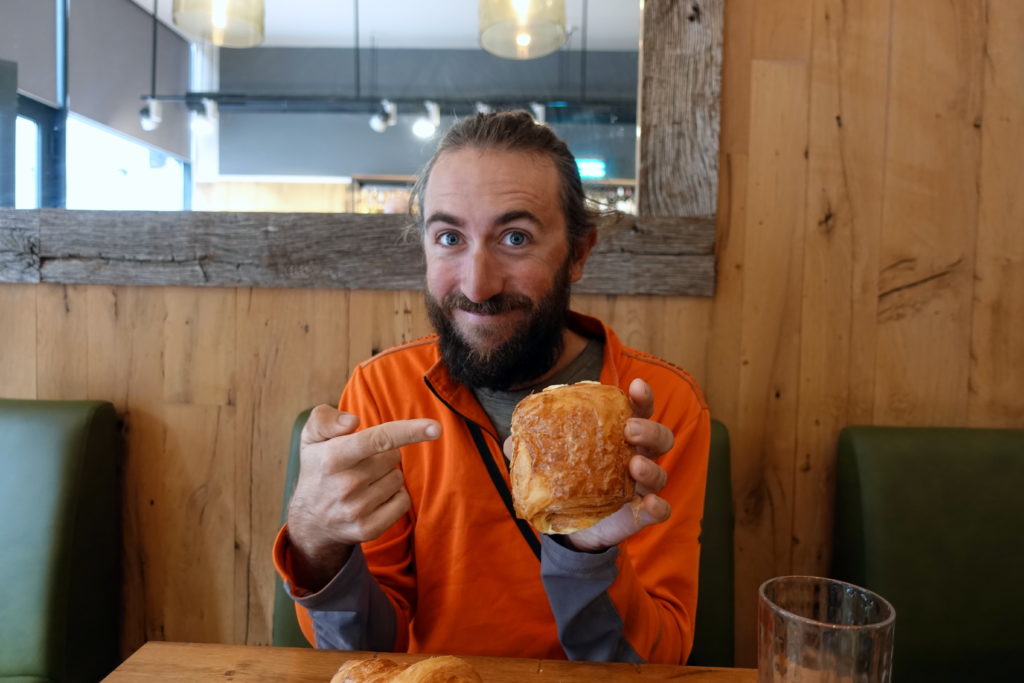
This is a look of pure joy – one day after saying he desperately wanted a chocolatine, Cédric’s wish came true!
We came back the next day for breakfast too! Btw, they taste exactly like the French ones…
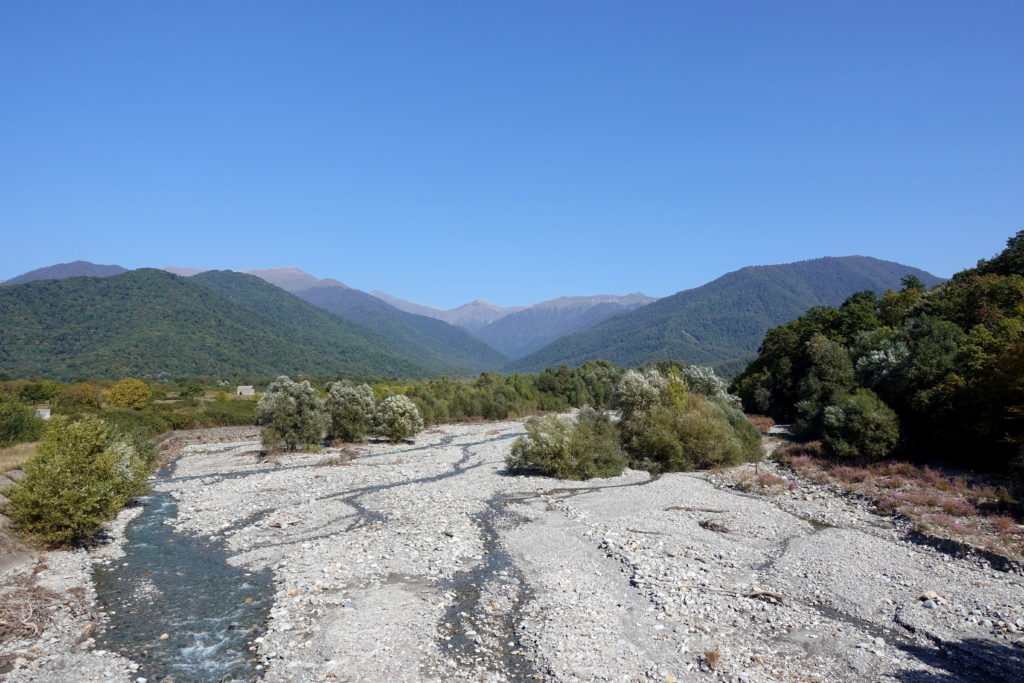
The main range of the Caucasus, between Georgia and Russia. This range actually beats the Alps in height (the Elbrus at 5640m would make the Mt Blanc look like a dwarf).
- Armenia: An even older Christian country – supposedly the oldest – although just like Georgia, the borders of Armenia have significantly moved over time. Armenians are also Christian Orthodox, but not the same Orthodox as the Georgians: Armenian are somehow more “ancient orthodox” – closer to Ethiopians and Copts – whereas Georgians are more “Byzantine orthodox” – closer to Russia and Greece. We tried to figure out the difference, I doubt many people understand it: something about miaphysitism versus monophysitism, good luck explaining that to us! Armenia was one of the most industrial country of the USSR but managed to get into nasty relations with its two largest neighbors, got itself stuck and mostly ignored as just small land in the Caucasus.
- We liked:
- Compared with Georgia, it was surprising to be in a much more chilled atmosphere right after the border. Car drivers are a lot more relaxed, not much honking, no aggressivity. A big relief!
- A very mountainous landscape. It does not go up as high as Georgia, but valleys are also narrower and more remote, implying a lot more up and downs for us cycling. While we mostly followed larger valleys in Georgia, we went from one to another in Armenia. Thus, more variety of landscapes and changes of views during the day.
- More historical towns – Armenia felt like the country of the Caucasus with more traditional villages, most historical relevance, some ancient castles (really old, not the plaster Potemkin castle decors of Azerbaijan, and overall a very old presence of humans in the area. Forget about the history of Yerevan though.
- Carrefour! (a large French supermarket chain) – we got to pile up lots of food in our bags and significantly improved our breakfasts and lunches (including pâté, chocolatines, etc.)
- We disliked:
- A lot of industrial wasteland – remains of the USSR, particularly around Yerevan. The 50km around Yerevan offer a weird sight of huge abandoned factories, and if still functioning, in a state of disrepair. The nuclear plant (near the Turkish border – they don’t like each other) is notoriously unsafe and there are warnings on traveler advise websites to regularly make sure that nothing goes wrong there (!).
- The brandy (locally renamed Armenian-Cognac) – like the Georgian wine, a national pride, but urgh bah (we’re also not liquor drinkers, beer please)! We bought the smallest possible bottle (at Carrefour!) and had to buy an additional 2l of Fanta quickly after to drink it. It tastes okay while mixed 10:1.
- The tensions with Azerbaijan – we admit that we had not paid much attention of the local geopolitical situation. Well, this is very tense there! Some regular fights, snipers regularly having fun, landmines on the ceasefire line, and just hate towards Azeris (Azeris hate Armenians just as much). After some reading, and because the locals seemed to exaggerate a little, it seems that the responsibilities are far from being one-sided – also similar to the situation between Georgia and Russia. If you stick to the paved roads, it remains safe though – but it might have been wiser to monitor the situation beforehand.
- Somehow Armenia feels like there is a problem of dysfunctional state and some crookedness going on in the country. Some areas are in a complete state of disrepair with villages falling apart, no schools (children just playing in the streets during week days) and any remain of industry abandoned, while some people (even in some towns) show an exuberant wealth. We have never seen that many Bentley and Rolls-Royce cars as in Armenia – several every day – it felt like people either have rusty wheels or cars that most people are unlikely to ever afford with an average salary in the country of 400$/month. While the country struggles to produce energy with aging plants, the clergy apparently finds enough funds to build spanking new outrageous churches…
- We liked:
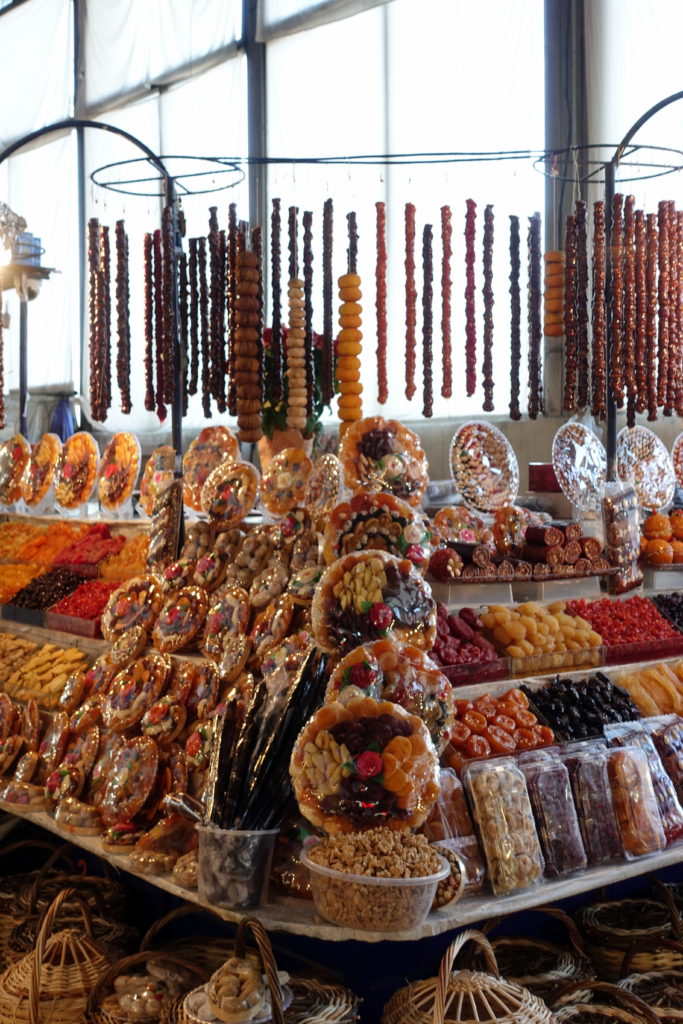
Dried fruit, nuts, and strings of churchkehla (nuts on a string, dipped in caramelized jelly) are very common in the Caucasus
The rest of the day consisted of riding alongside the busy highway 4 until we could finally turn off. In Hua Hin and Cha-am, we could once again feel that Thailand is indeed a heavily touristed place. Where Krabi and Ao Nang had a laidback beachy vibe (at least in the low season), these northern cities touted multiple-story 5-star hotels, visited by the wealthiest people from Bangkok (only a few hours’ drive away, and thus a good weekend getaway) and a surprising number of northern Europeans. Hua-Hin and Cha-am are not particularly appealing, especially after the long stretch of empty beaches just a few hundred kilometers south, but I guess some tourists cannot imagine being abroad without safe 5-stars large resorts with a romantically modelled version of exotic Thailand – but still within walking distance of Starbucks, KFC and H&M.
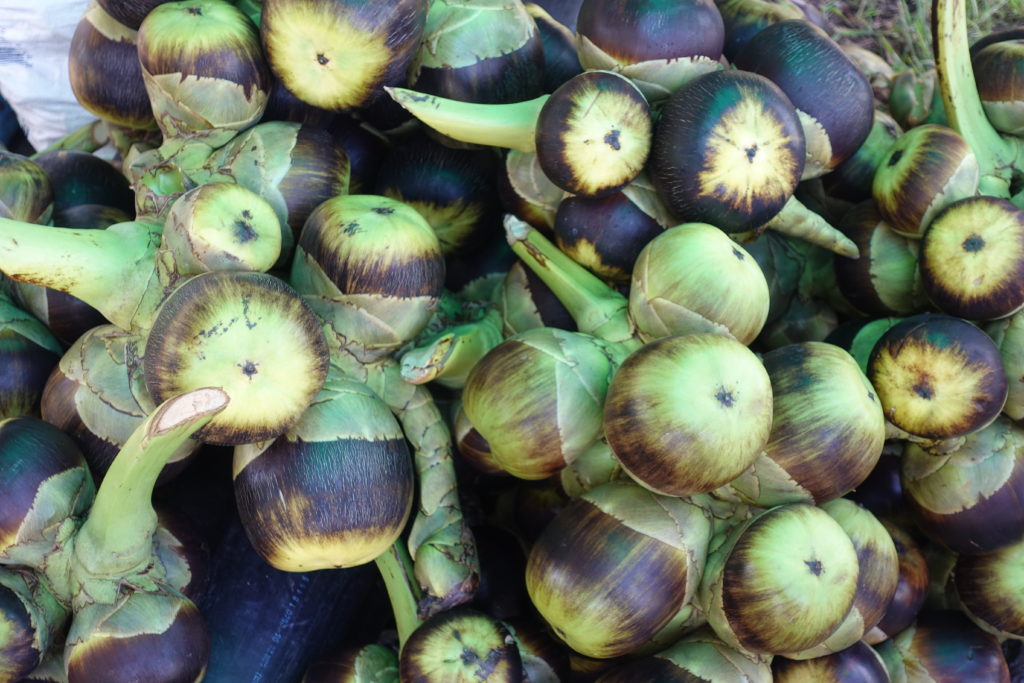
A newly discovered fruit: toddy palm! It’s supposed to be a good laxative, not necessarily what we are looking for in Thailand…
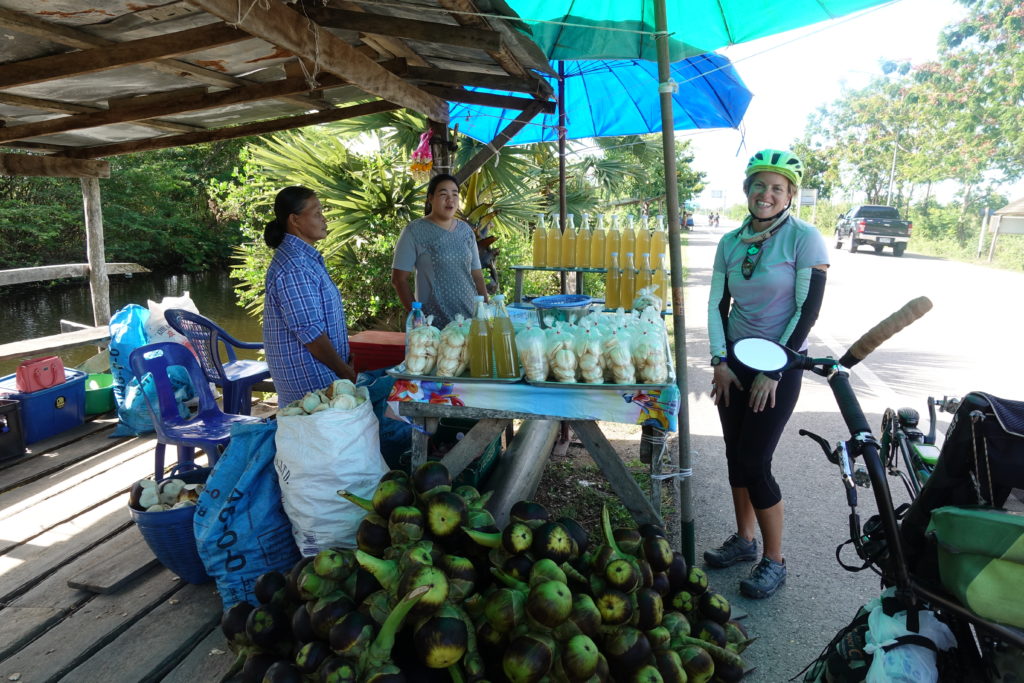
We found these stands along the road, so naturally we had to see what they were selling. The juice is from the sap. Thanks to high-tech cleverphones technology (yay), we managed to ask the world in Thai, then look for what it could be in English and discovered the toddy palms.
We cruised across that part of Thailand, helped by good tailwinds, flat roads, smooth asphalt, being fit, used to the climate, and not much interest to stop anyway and managed to cycle some parts at almost 30km/h (a bullet speed while cyclo-touring). Arriving in Samut Songkhram, the 2×4 lane-highway clearly indicated that we were entering the metropolitan area of Bangkok. The traffic also becoming less and less enjoyable (although we felt that the massive highways are a lot safer for cycling than smaller roads thanks to a 3m wide shoulder), we decided to stop there our way to Bangkok that evening and continue with a van the next day.
Samut Songkhram is mostly known for its train line that goes right into a market (it’s actually more a market that goes right into the train), looking at the map, that train runs only a few times a day from kinda nowhere south of Bangkok to that town 30km away (train are not quite optimal in Thailand as train rely on an outdated infrastructure and lines are not physically linked to each other), but this train has become a popular touristic destination around Bangkok. In short, hordes of people come with a train in the morning, then empty their wallets buying elephant-pants and other souvenirs that will end up in a drawer while waiting for the next train, take a picture of the next train and go back to Bangkok. The market thus lives with sudden waves of hundreds of visitors, with the city returning to quietness in the evening.
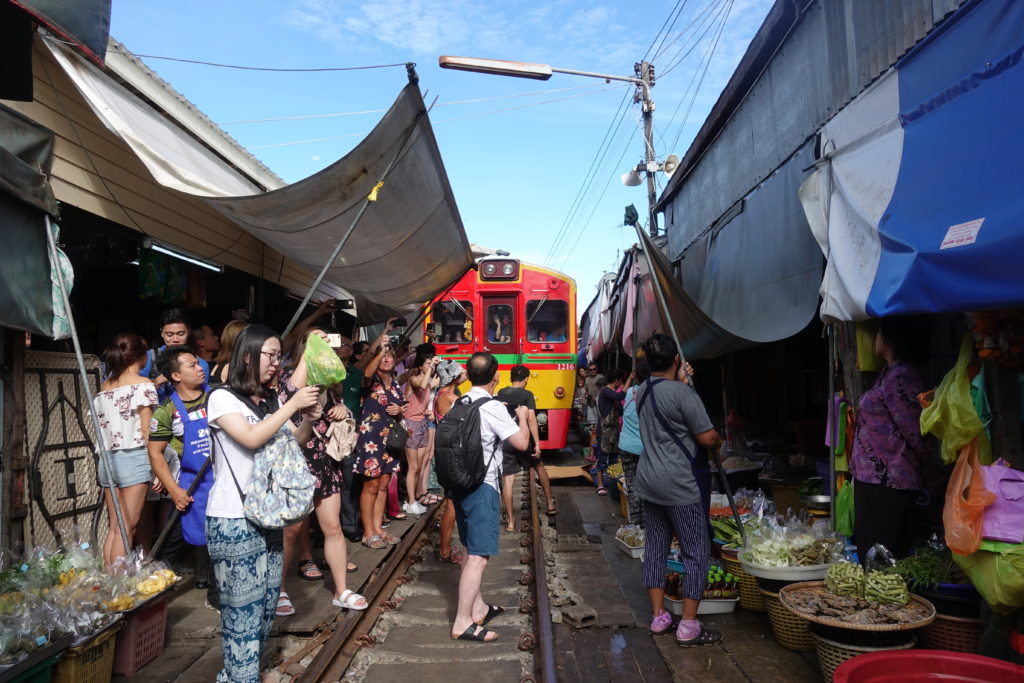
Immediately after, the awnings come back out and the tourists are pushed back onto the rails so the people can start selling their goods again
Even though we had explained the number of luggage, the size of the bike and so on the day before to get a van to Bangkok, things obviously did not work out the next day with the van company telling us that it’s not possible to put a bike in their van (a 12-seater minibus). We eventually had to double the fare and an hour later another minivan from the same company (same model, same story that the seats cannot flip, etc.) took us to a station in Bangkok that we had not agreed on, but “same same, still Bangkok, you can take your bicycle to your original place”. Of course, they understand English whenever they feel like it. We went into Bangkok to visit Cassie’s friend Pete, against all odds telling us to ride around it, and observing its lights from far far away. We eventually got welcomed into Bangkok with 20km of traffic jams, a lot of concrete and smog, and our nightmarish 10km ride to Pete’s place.
Bangkok has had its population multiplied by 30 in the last century, seemingly growing without any sort of planning or urban thought. Public transportation is just completely inadequate to that size of city: my hometown Toulouse (far from being any sort of public transportation model) has a longer commuter train network despite being the size of Bangkok in the 1930s, buses all seem to have had their odometer fully loop a few times. Add the fact that the Bangkok area is a lot richer than the rest of Thailand (the GDP is about 7 times higher), and that cars are a symbol of wealth and success, and you get the second most jammed city in the world! Its drivers apparently enjoy wasting on average 1h15 of their lives every single day of the year in traffic jams (it’s about 18min in LA or 25min in Paris for comparison), its pedestrians enjoy noisy engines and their unregulated scent of exhausts and other particles – literally 24/7. The only way to get around: add on to the traffic and get a long nap in a taxi, luckily unbelievably cheap (count about 3 euros for 10km in an hour).
Being in Bangkok, our main first goals became to service our bike in one of the rare reliable shop around as we don’t want to mess up our precious iron-horse (read the Malaysia post) at “BokBokBike” and find a solution to keep on updating the website (among other useful things a laptop can do). For the bike, that unfortunately meant twice 8km dealing with the traffic, with Cassie refusing to steer a single meter and pedaling while closing her eyes/nose/ears – just the mouth and the lungs must remain open to try to supply a bit of remaining oxygen that hasn’t been burnt by combustion engines around!
The bike got its maintenance done without much problem, things got a little more complicated for the laptop: the manufacturer telling us that it will take several weeks and probably will have to get some parts from Germany because it comes from there (I have never heard of a Chinese laptop manufacturer having its production outsourced to low-cost western Europe…), then a few places refusing having to deal with those small compact devices, and finally a Dutch owned shop explaining us after running a few tests that we should cry a little and prepare the credit-card for a new one… Shipping a laptop to some place in Europe for a repair until our return appeared to be impossible (thanks Li-Ion batteries), but we yet managed to sell the dead carcass at a market for a tenth of the price of the brand-new one (knowing that the motherboard and screen were broken)! So we are now writing our posts on a Thai-keyboard (you thought the French keyboards were weird? Check the Thai script!).
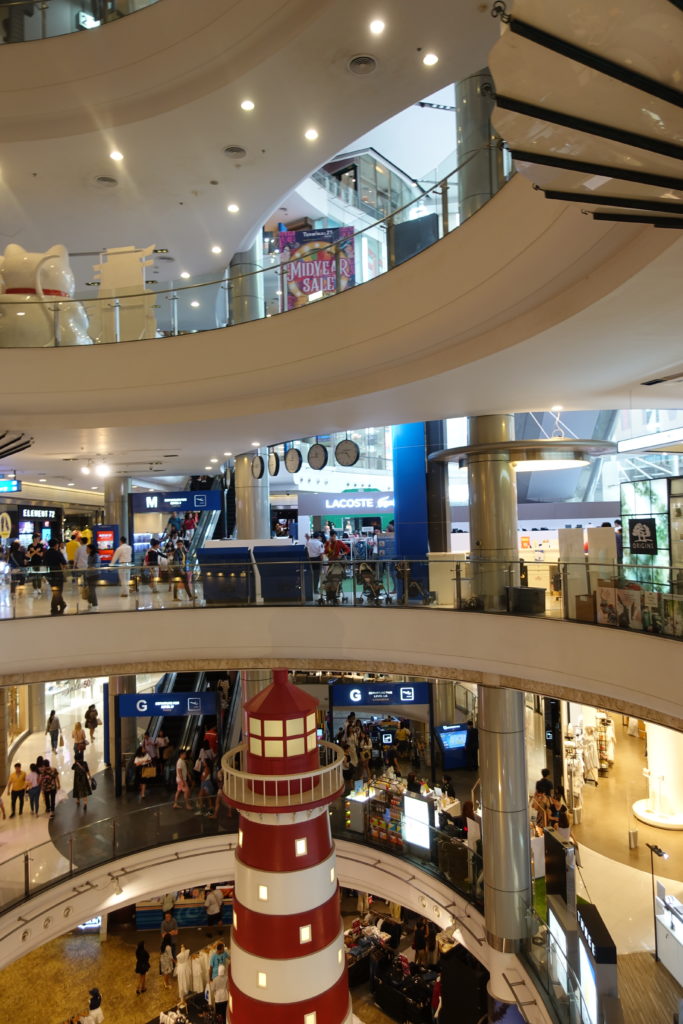
Another mall – the lighthouse probably to remind that Bangkok is basically build on a swamp, and those 14M people will soon need to build some lighthouses with rising water levels.
While waiting for the Hase Pino and computer to be serviced, we also managed to see a few of the touristic parts in the heart of old Bangkok: the Wat Pho complex, the Emerald Buddha temple complex (an overrated temple with a ridiculous entry fee – that we reluctantly paid because there is not much more in Bangkok otherwise, where we were turned away twice for not wearing the correct clothes – both long pants and long sleeves are required despite the heat) and Chinatown. We also explored the myriad of shopping malls along the Rama I and Sukhumvit roads (very exciting: you can see the new models from Zara, H&M or Gap…) to look for a few items and a new laptop. Besides exploring the seedier side of Bangkok (think: white-creepy-gramps with their new Thai-love-too-young-to-be-their-daughters and happy endings), the other thing tourists can turn to is a shopping extravaganza for everything you can think of. Having spent the past 6 months carrying around just our necessities, it was mind-blowing to see the sheer abundance of goods in these shopping malls. Besides ‘luxury’ shopping malls with a lot of western brands, Bangkok has also other types of malls with literally thousands of stalls selling cheap no-quality useless (often Chinese) crap – and a lot of tourists apparently enjoy wasting their time and money filling suitcases of stuff that will never be used and will eventually be trashed across the world. A bit too much for us!
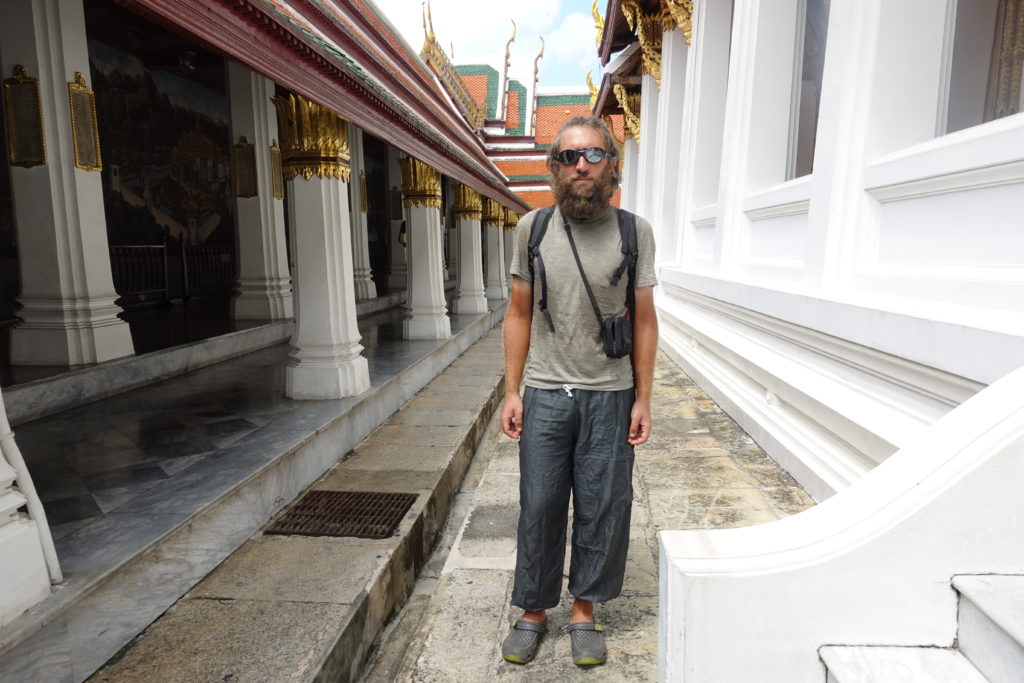
Cédric, thrilled that he had to buy pants to be able to pay a ridiculously expensive entrance fee, to enjoy hundreds of guided tour buses – the Grand-Beardy-Chedi-Guru declares from now on: pants strike!
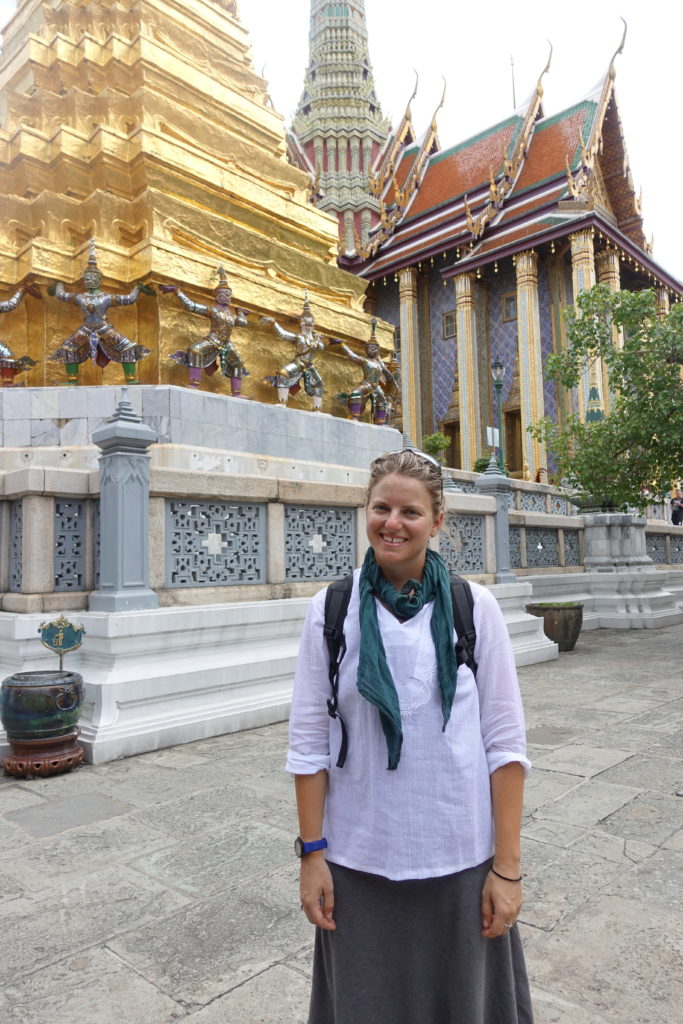
Cassie also with a new shirt – apparently scarves around the shoulders weren’t enough this time (this place is not even a temple being used. But the greatest royal way to make a pyramid of cash (more about the Thai government as soon as we are out of the country…Big Bro is watching you here).
Once the bike was ready to go and we set up the new computer (a few hours were dedicated to trying to remember just how we managed to get a free version of Microsoft Office on the old laptop), we packed our things to get out of the city. Being in Bangkok, we had a few more transportation options than a van ride so we bought tickets to Ayutthaya, the capital city of Siam before Bangkok, less than 100 km north of the city. Just as we were leaving, Cedric picked up a nice respiratory virus as a bonus gift to carry with us for the next few weeks…souvenir from Bangkok!
So in short, we really enjoyed hospitality of Pete’s family, and Bangkok is the place in Thailand to find literally anything you may be looking for (including a branch of Cedric’s company  ), however don’t expect much for sights and enjoyable places to hangout. If you really need a Thai-script-tattoo, some elephant-pants, or a Singha/Chang beer-T-shirt, the Khaosan district will have everything to provide to look like a western clown, if you are into the weird obscure brothel stuff, well you can surely find that too, but we really cannot give any advice on that (unless recommending taking a flight back home).
), however don’t expect much for sights and enjoyable places to hangout. If you really need a Thai-script-tattoo, some elephant-pants, or a Singha/Chang beer-T-shirt, the Khaosan district will have everything to provide to look like a western clown, if you are into the weird obscure brothel stuff, well you can surely find that too, but we really cannot give any advice on that (unless recommending taking a flight back home).
If any cyclist is reading that post, seriously don’t consider cycling into Bangkok (apart for suicidal riders), and unless you need a bike shop (BokBok) or spare parts, just ride around the city (to get to Laos, Myanmar and northern Thailand) or get another mean of transportation across (for example if heading towards Cambodia). Also read the previous post about dogs: 10% of dogs in Bangkok have rabies – very exciting!
]]>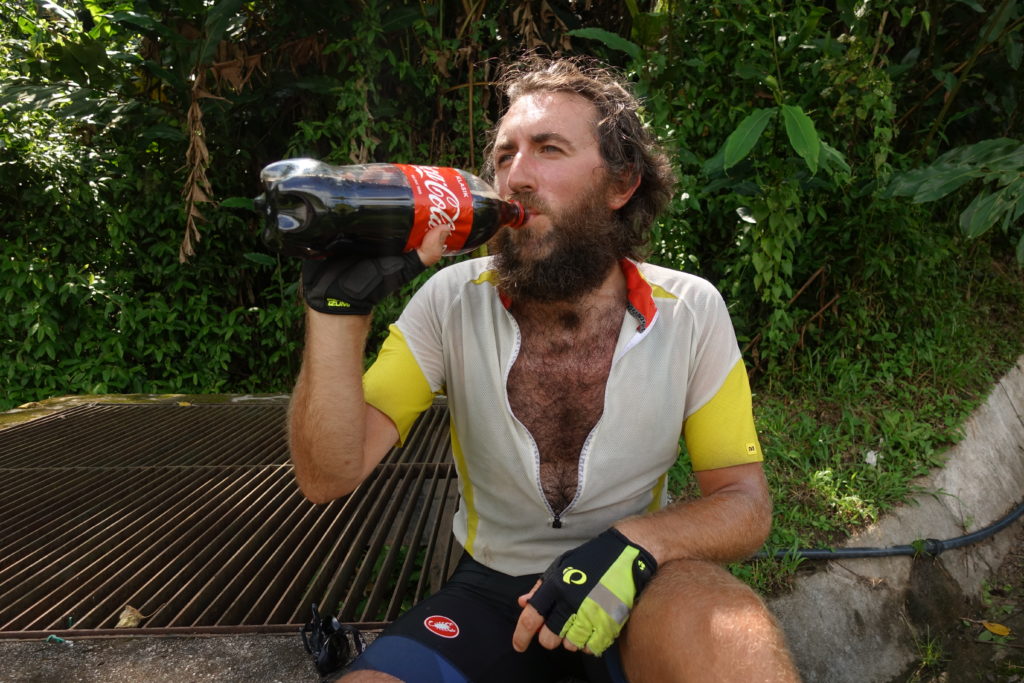
Coke is a very important part of our diet during rough days – here going up to the Cameron Highlands
Our first 24 hours in Malaysia, Cédric and I didn’t notice much difference because the town of Kulai had a strong mix of Malay, Chinese, and Indian populations (the latter two not observing Ramadan). Once we started riding towards the west coast, however, it became apparent that a lot of roadside stalls were shuttered, with plastic chairs and tables stacked along a wall. Around lunchtime, we rode through village of Api Api in desperate search of food. Nothing except for a small market was open, so Cédric and I resorted to eating peanut butter sandwiches (aka. okay but not exciting) under the shade of a bus stop. That night in Rengit, another small town, we also had trouble hunting down dinner (and later, breakfast… we learned that most Malay restaurants are closed throughout Ramadan). After being rather unsuccessful and resorting to gas station instant noodles, we devised a plan: plan to eat in bigger towns, not villages, and don’t be choosy whenever there’s an open restaurant – cooking is not wished in SE Asia (it would end up being more expensive and a lot less healthy/tasty), and chips or snacks at a gas-station not very enjoyable long term.
A common accommodation type in Malaysia are the “homestays” (a Bed&Breakfast without the breakfast – you can get that outside in the street), and it seems that the Ramadan month made some people more religion sensitive (particularly in the southern part) by accepting only Muslim hosts. That quickly made our trip focus more on the Malaysian minorities (they still make up 50% of the population altogether), and unfortunately less on Malay-Malaysians (this post may be confusing, everyone is Malaysian, just some for a few more generations).
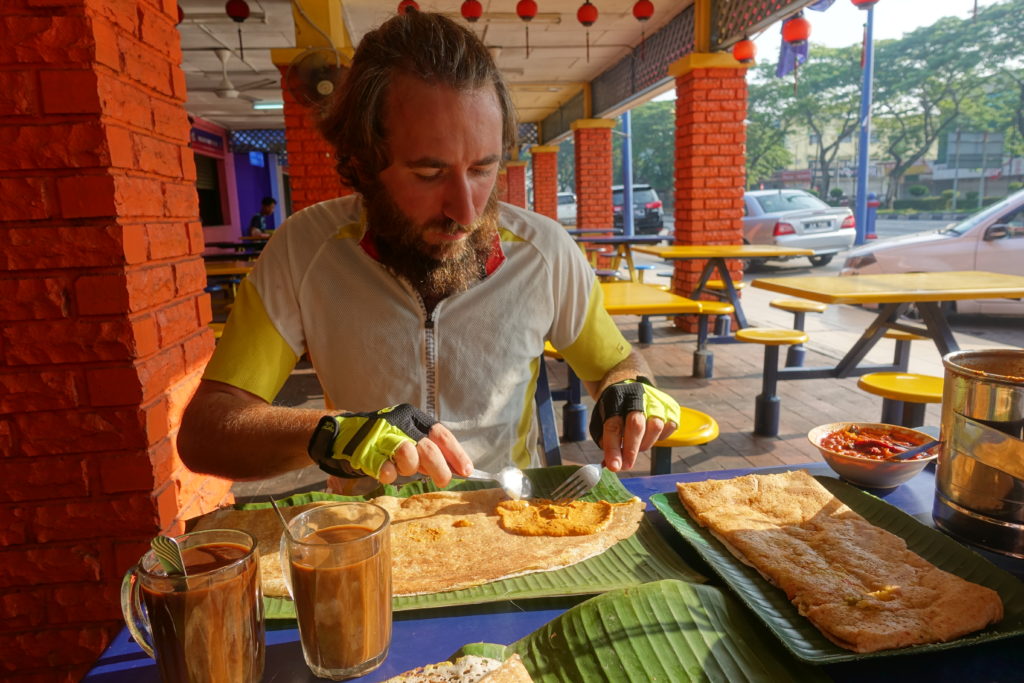
Luckily we stuffed ourselves with thosi in Kulai. Also shout out to the guy who bought this breakfast for us!
For lunch the next day, we had a lot more success at a Chinese restaurant in Batu Pahat. As the days progressed in Malaysia, Cédric and I became more perceptive to indications about whether we’d be able to find food: the presence of Chinese or Tamil schools (found with our map apps, it let us know that the town had a diverse population) and shops with a lot of people lingering around in the shade (we’d bike slowly through the main street looking into each storefront). The better we got with knowing where the restaurants were, the more we increased our food intake – by the end of our trip through Malaysia, we were able to find a second breakfast of coffee and roti with ease and the correct timing (around 10am). The name of the town also gives a good hint of the cultural background of the town – larger cities are mixed, but smaller towns inland are fairly recent (mid-20th century). “Manchis” is for example mostly Chinese (and thus still very lively during the Ramadan), whereas “Sinpang Pelangai” about the same size, a few kilometers before was completely deserted without a single shop open (it’s most Malay).
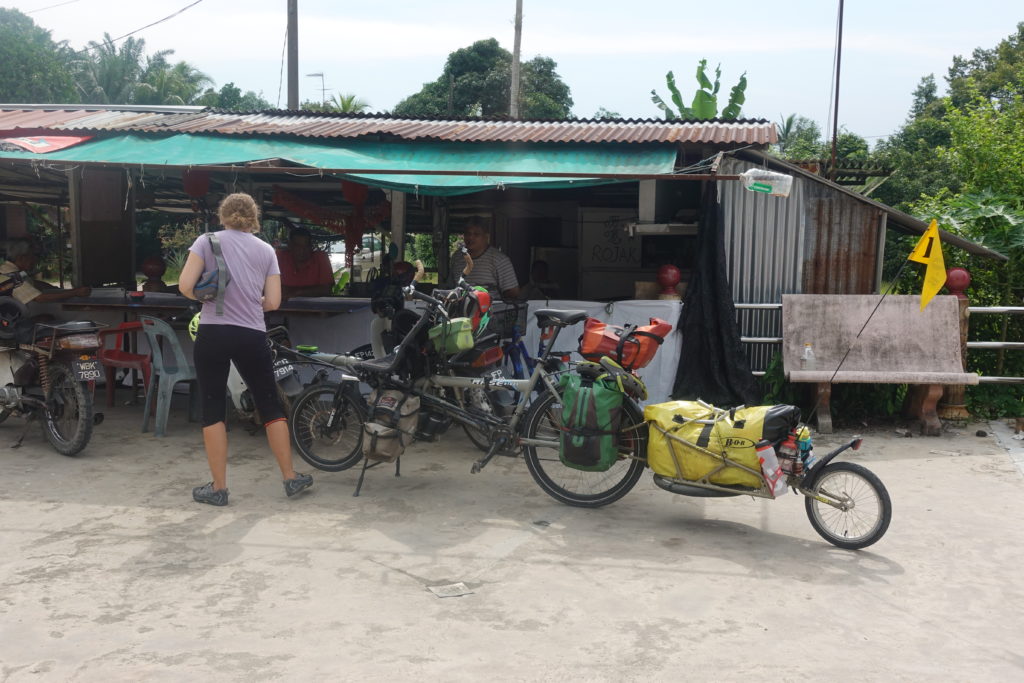
Here, we found a few people hiding in the shady Café, playing mahjong next to a Buddhist temple- indicators for snacks and coffee.
Cycling through Malaysia during Ramadan also made Cédric and I very aware of the country’s different cultures (particularly because we relied heavily on Malaysia’s diversity to prevent us from eating peanut butter sandwiches and ramen noodles for every meal). The Chinese and Indian populations are not recent immigrants, they have been in Malaysia for several generations and are Malaysian citizens. These groups retain a strong cultural identity and speak their ancestral dialect in addition to Malay (and for many, English). However, that doesn’t mean that these three groups are segregated from one another – we saw everyone come out for the Ramadan evening markets and patron the same restaurants. Overall, it seems like the Chinese community is the most entrepreneur and manages the larger businesses, whereas the Malays have a stronger political and cultural influence in the country. Indians are a smaller community and are not present in every town. We also noticed some other communities from much more recent migrants, from poorer Asian countries – notably Bangladeshis in the fruit and vegetable farms of the highlands (and apparently often cheap exploited undocumented labor…).
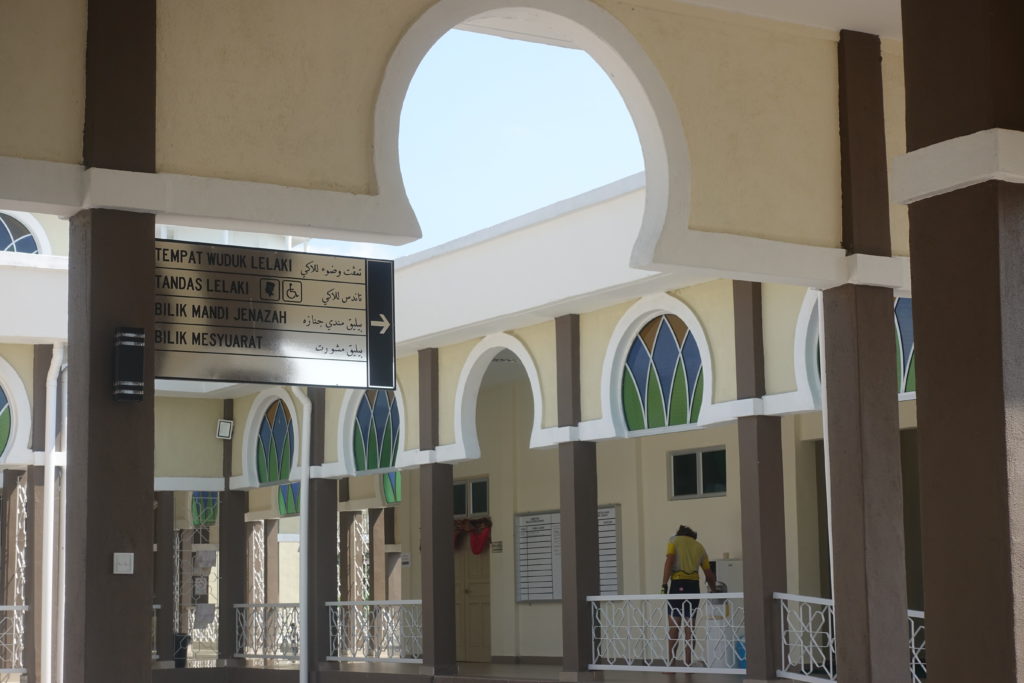
A mosque – great for shade, clean bathrooms, splashing cold water on the head and talking to people coming out of prayers.
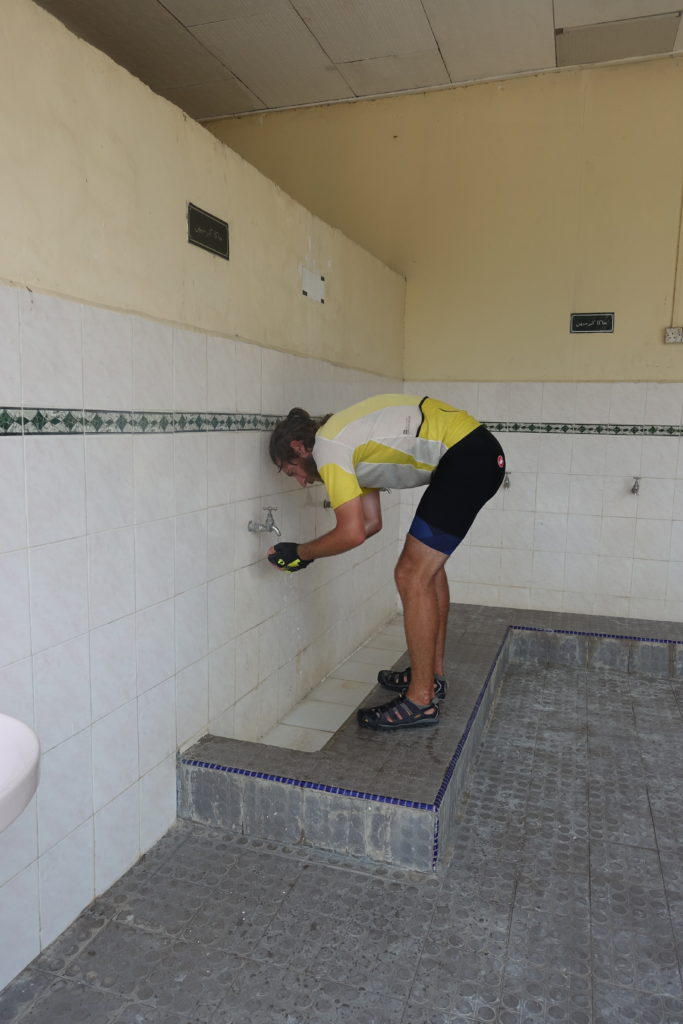
Another useful feature of mosques when it’s hot outside – the size of installations is not always particularly adequate for Cedric’s size in Asia
In addition to Malaysian restaurants, it appears many Malay-owned shops and businesses were closed during the 4 weeks of the Ramadan. Cédric and I could understand this, given how hot the weather was and people not being able to drink liquids during the day. We did find that some fasters weren’t as strict as they would like you to believe – while hanging around in the shade of a Buddhist temple one day, we met a policeman who wanted to drink his iced coffee and smoke a cigarette (also forbidden during the fast) without the community knowing. In a surrealist discussion, he told us that he was worried that other Muslims would take pictures of policemen not being very respectful of the rules… and shorty after told us that his paycheck of 5000 Ringgit per month (about 1500US$ or 1200€ – double the average income in Malaysia, and 7 times higher than farm workers we talked to a few days later) was not enough, and unless he would get a raise up to 10.000 Ringgit/month, he would have to keep on accepting bribes from infringing car drivers. We discovered with him then that the best place to hang out for a snack, a smoke or a drink is behind the local Chinese community temple – and that was also one of our regular favorite location to get some shady quiet spot to rest.
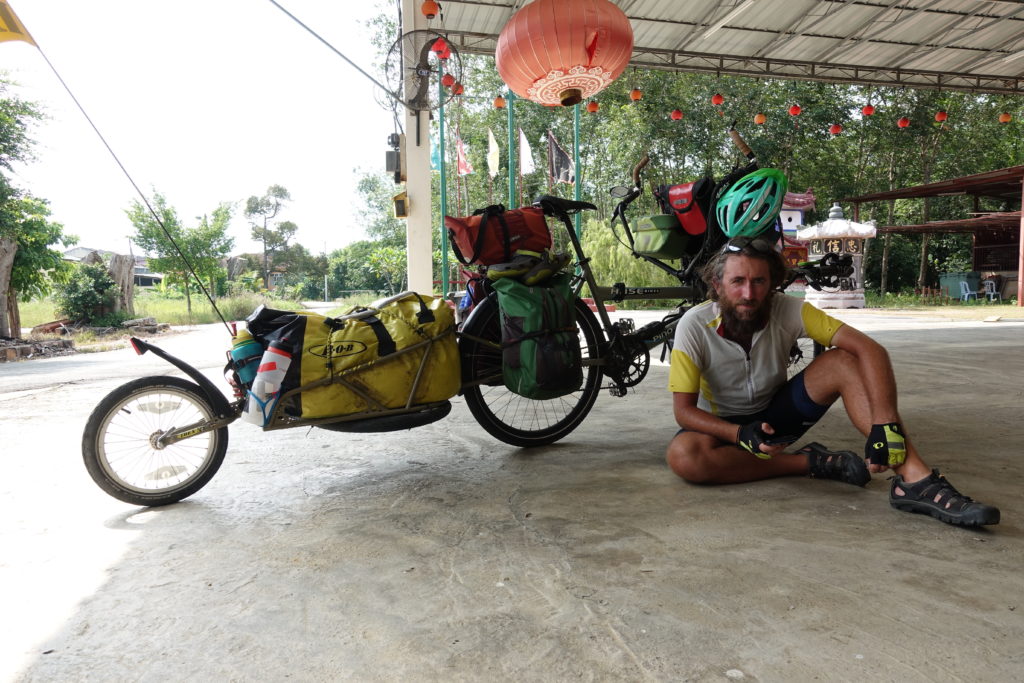
Hanging around a temple in Manchis (aka. the local slightly venal policemen’s favorite drinking spot during Ramadan)
Given the number of plastic bottles and plastic glasses on the road at the entrance of towns, we noticed that during the Ramadan getting a sip of cold water while driving is fine… as long as you throw every evidence out of your car before your relatives and friends could see you! The usual combo of religions (Hindu, Buddhist, and Muslim) and probity… some rules for the others, but always a good exception for your own case.
Although Cédric and I felt like our interactions with the Malays were somewhat limited during this time, we were able to take part in some Ramadan traditions. On our second day in Malaysia, we noticed that evening Ramadan bazaars were present in almost every town and city – which was the perfect opportunity to buy sweets and sugary drinks. They however only open in the evening, a few hours before sunset – great for dinner, not so much for the rest. Keeping cooked food for the next day also doesn’t seem like a wise idea, with a hot and humid weather being a perfect environment for bacteria…or for ants, absolutely the greatest creatures to always find a way to get into your food. While we were in Sungai Koyan walking past a gathering, Cédric and I were also invited to the Iftar, the daily breaking of the fast at sunset. We were both completely taken aback and humbled that this group of people would want us to celebrate with them.
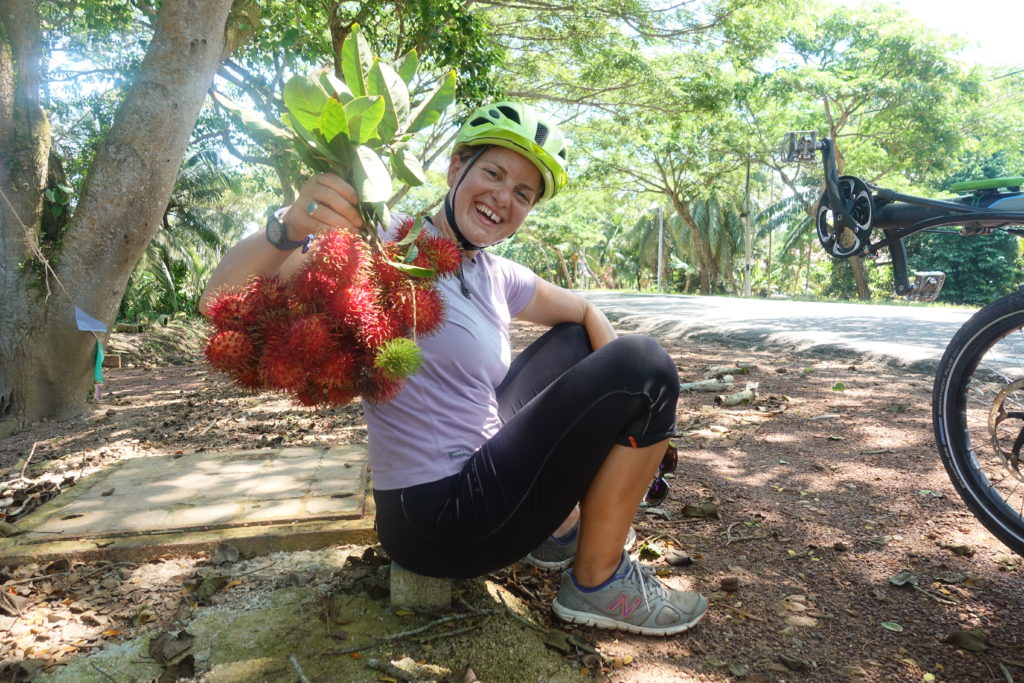
We were given these rambutans while taking a break on the side of the road – almost on a daily basis, the Malaysians talked to us, shared parts of their culture, and surprised us with treats.
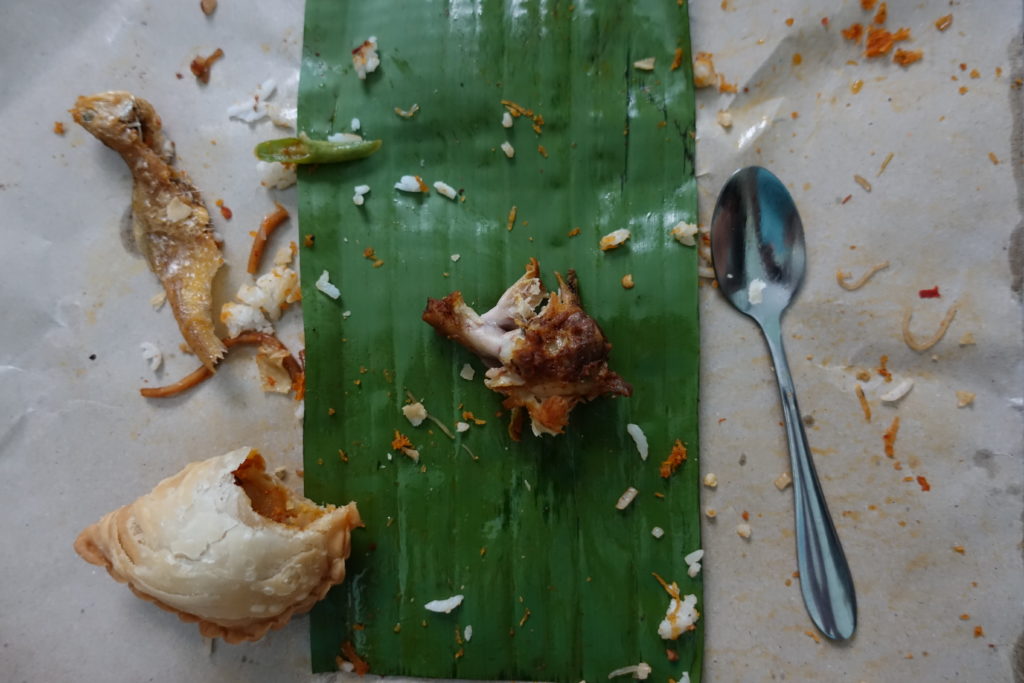
The remnants of a dinner given to us by our guesthouse host while she was still fasting – that became dinner number 1 out of 3 that evening – with everyone in Sungai Koyan inviting us!
]]>
